
To me, Animism starts in Southern Africa, then to West Europe, and becomes Totemism. Another split goes near the Russia and Siberia border becoming Shamanism, which heads into Central Europe meeting up with Totemism, which also had moved there, mixing the two which then heads to Lake Baikal in Siberia. From there this Shamanism-Totemism heads to Turkey where it becomes Paganism.
Pseudo This and Pseudo That
I can’t stand pseudo-science/archaeology/history and enjoy people debunking it. The truth is already cool and amazing, why lie? Not me. The truth is much harder to understand as opposed to just making things up. In fact, I can see how just making things up is much easier than working hard for many years to barely understand just an outline and this could be a reason why so many just lie.
Haplogroup L3
“Haplogroup L3 is a human mitochondrial DNA (mtDNA) haplogroup. The clade has played a pivotal role in the early dispersal of anatomically modern humans. It is strongly associated with the out-of-Africa migration of modern humans of about 70–50,000 years ago. It is inherited by all modern non-African populations, as well as by some populations in Africa. L3 descendants are M and N.” ref
“Haplogroup M is a human mitochondrial DNA (mtDNA) haplogroup. An enormous haplogroup spanning all the continents, the macro-haplogroup M, like its sibling the macro-haplogroup N, is a descendant of the haplogroup L3. All mtDNA haplogroups considered native outside of Africa are descendants of either haplogroup M or its sibling haplogroup N. Haplogroup M is relatively young, having a younger most recent common ancestor date than some subclades of haplogroup N such as haplogroup R.” ref
“There is a debate concerning the geographical origins of Haplogroup M and its sibling haplogroup N. Both lineages are thought to have been the main surviving lineages involved in the out of Africa migration (or migrations) because all indigenous lineages found outside Africa belong to haplogroup M or haplogroup N. Scientists are unsure whether the mutations that define haplogroups M and N occurred in Africa before the exit from Africa or in Asia after the exit from Africa. Determining the origins of haplogroup M is further complicated by an early back-migration (from Asia to Africa) of bearers of M1.” ref
“Its date of origin in absolute terms is only known with great uncertainty, as reconstruction has yielded different (but overlapping) ranges for the age of M in South Asia and East Asia. The same authors give an estimate for t of L3 as 71,000
−14,000 years ago, later (2011) narrowed to the somewhat younger 65,000 years ago. Thus, haplogroup M would have emerged around 10,000 or at most 20,000 years after L3, around or somewhat after the recent out-of-Africa migration event.” ref
“Haplogroup L3 arose close to 70,000 years ago, near the time of the recent out-of-Africa event. This dispersal originated in East Africa and expanded to West Asia, and further to South and Southeast Asia in the course of a few millennia, and some research suggests that L3 participated in this migration out of Africa. L3 is also common amongst African Americans and Afro-Brazilians. A 2007 estimate for the age of L3 suggested a range of 104–84,000 years ago. More recent analyses, including Soares et al. (2012) arrive at a more recent date, of roughly 70–60,000 years ago.” ref
“Soares et al. also suggest that L3 most likely expanded from East Africa into Eurasia sometime around 65–55,000 years ago as part of the recent out-of-Africa event, as well as from East Africa into Central Africa from 60 to 35,000 years ago. In 2016, Soares et al. again suggested that haplogroup L3 emerged in East Africa, leading to the Out-of-Africa migration, around 70–60,000 years ago.” ref

I think animism started 100,000 years ago, totemism 50,000-45,000 years ago, and shamanism 30,000-35,000 years ago.
Animism (simplified to me as a belief in a perceived spirit world) passably by at least 100,000 years ago “the primal stage of early religion” To me, Animistic Somethingism: You just feel/think there has to be something supernatural/spirit-world or feel/think things are supernatural/spirit-filled.
Totemism (simplified to me, as a belief that these perceived spirits could be managed or related with by created physical expressions) passably by at least 50,000 years ago “progressed stage of early religion” A totem is a representational spirit being, a sacred object, or symbol of a group of people, clan, or tribe.
Shamanism (simplified to me as a belief that some special person can commune with these perceived spirits on the behalf of others by way of rituals) passably by at least 30,000 years ago Shamanism is an otherworld connection belief thought to heal the sick, communicate with spirits/deities, and escort souls of the dead.
Paganism 12,000-4,000 years old
12,000-7,000 years old: related to (Pre-Capitalism)
7,000-5,000 years old: related to (Capitalism) (World War 0) Elite and their slaves!
5,000 years old: related to (Kings and the Rise of the State)
4,000 years old: related to (First Moralistic gods, then the Origin time of Monotheism)

Religions continuing in our modern world, full of science and facts, should be seen as little more than a set of irrational conspiracy theories of reality. Nothing more than a confused reality made up of unscientific echoes from man’s ancient past. Rational thinkers must ask themselves why continue to believe in religions’ stories. Religion myths which are nothing more than childlike stories and obsolete tales once used to explain how the world works, acting like magic was needed when it was always only nature. These childlike religious stories should not even be taken seriously, but sadly too often they are.
Often without realizing it, we accumulate beliefs that we allow to negatively influence our lives. In order to bring about awareness, we need to be willing to alter skewed beliefs. Rational thinkers must examine the facts instead of blindly following beliefs or faith. Below is a collection of researched information such as archaeology, history, linguistics, genetics, art, science, sociology, geography, psychology, philosophy, theology, biology, and zoology. It will make you question your beliefs with information, inquiries, and ideas to ponder and expand on. The two main goals are to expose the evolution of religion starting by around 100,000 years ago and to offer challenges to remove the rationale of faith. It is like an intervention for belief in myths that have plagued humankind for way too long. We often think we know what truth is nevertheless this can be but a vantage point away from losing credibility if we are not willing to follow valid and reliable reason and evidence.
The door of reason opens not once but many times. Come on a journey to free thought where the war is against ignorance and the victor is a rational mind. Understanding Religion Evolution: Pre-Animism (at least 300,000 years ago), * Animism (such as that seen in Africa: 100,000 years ago), *Totemism (Europe: 50,000 years ago), * Shamanism (beginning around 30,000 years ago), *Paganism (beginning around 12,000 years ago), * Progressed organized religion (around 5,000 years ago), * CURRENT “World” RELIGIONS (after 4,000 years ago), and * Early Atheistic Doubting (at least by around 2,600 Years Ago)
In a general way, it all starts with Animism (a theoretical belief in supernatural powers/spirits) and this is physically expressed in or with Totemism (a theoretical belief in a mythical relationship with powers/spirits through a totem item), which then enlists a full-time specific person to perform this worship and believed interaction as Shamanism (a theoretical belief in access and influence with spirits through rituals). In addition, there is the further employment of myths and gods added to all the above, which is Paganism and is often a lot more nature-based than most current top world religions, thus hinting to their close link to more ancient religious thinking from which it stems.
My hypothesis is expressed with an explanation of the building of a theoretical house (modern religions development). It seems ancient peoples had to survived amazing threats in a “dangerous universe by superstition perceived as good and evil”, and human “immorality or imperfection of the soul”, which was thought to affect the still living and led to ancestor worship. Presumably, this ancestor worship led to the belief in supernatural beings, which some of these were turned into the belief in gods. This feeble myth called gods were just a human conceived idea that was “made from nothing into something over and over, changing again and again, taking on more as they evolve, and all the while, they are thought to be special.” However, it is just supernatural animistic spirit-belief perceived as sacred.
Historically, around 5,000 years ago, in large city-state societies such as Egypt or Iraq culminated to make religion into something kind of new, a sociocultural-governmental-religious monarchy, where all or at least many of the people of such large city-state societies seem familiar with and committed to the existence of “religion” as the integrated life identity package of control dynamics with a fixed closed magical doctrine. However, this juggernaut integrated religion identity package of Dogmatic-Propaganda certainly did not exist or if developed to an extent, it was highly limited in most smaller prehistoric societies as they seem to lack most of the strong control dynamics with a fixed closed magical doctrine. These magical beliefs could be at times be added or removed and many people just want to see developed religious dynamics everywhere, even if it is not. Instead, all that is found is largely fragments until the domestication of religion.
Religions, as we think of them today, are a new fad, even if they go back to around 6,000 years in the timeline of human existence. This amounts to almost nothing when seen in the long slow evolution of religion that started at least around 70,000 years ago with one of the oldest ritual worship. This message of how religion and gods are intertwined with humans is clearly a man-made idea that was developed slowly as it was invented, reinvented, and implemented piece by piece, which discredits them all. This seems to be a simple point, which some are just not grasping how devastating this is to any claims of truth when we can see the lie clearly in the archeological sites.
“Religion is an Evolved Product”
Pre-Animism (at least 300,000 years ago)
Around a million years ago, I surmise that Pre-Animism, “animistic superstitionism”, began, Around 400,000 Years ago shows Sociocultural Evolution, and then led to the animistic somethingism or animistic supernaturalism, which is at least 300,000 years old and about 100,00 years ago, it evolves to a representation of general Animism, which is present in today’s religions. There is also Homo Naledi and an Intentional Cemetery “Pre-Animism” dating to around 250,000 years ago. And, Neanderthals “Primal Religion (Pre-Animism/Animism?)” Mystery Cave Rings 175,000 Years Ago. Neanderthals were the first humans to intentionally bury the dead, around 130,000 years ago at sites such as Krapina in Croatia.
Pre-animism ideas can be seen in rock art such as that expressed in portable anthropomorphic art, which may be related to some kind of ancestor veneration. This magical thinking may stem from a social or non-religious function of ancestor veneration, which cultivates kinship values such as filial piety, family loyalty, and continuity of the family lineage. Ancestor veneration occurs in societies with every degree of social, political, and technological complexity and it remains an important component of various religious practices in modern times.
Humans are not the only species, which bury their dead. The practice has been observed in chimpanzees, elephants, and possibly dogs. Intentional burial, particularly with grave goods, signify a “concern for the dead” and Neanderthals were the first human species to practice burial behavior and intentionally bury their dead, doing so in shallow graves along with stone tools and animal bones. Exemplary sites include Shanidar in Iraq, Kebara Cave in Israel and Krapina in Croatia. The earliest undisputed human burial dates back 100,000 years ago with remains stained with red ochre, which show ritual intentionality similar to the Neanderthals before them. ref, ref
Animism (such as that seen in Africa: 100,000 years ago)
Did Neanderthals teach us “Primal Religion (Pre-Animism/Animism?)” 120,000 Years Ago? Homo sapiens – is known to have reached the Levant between 120,000 and 90,000 years ago, but that exit from Africa evidently went extinct. 100,000 years ago, in Qafzeh, Israel, the oldest intentional burial had 15 African individuals covered in red ocher was from a group who visited and returned back to Africa. 100,000 to 74,000 years ago, at Border Cave in Africa, an intentional burial of an infant with red ochre and a shell ornament, which may have possible connections to the Africans buried in Qafzeh.
Animism is approximately a 100,000-year-old belief system and believe in spirit-filled life and/or afterlife. If you believe like this, regardless of your faith, you are a hidden animist.
The following is evidence of Animism: 100,000 years ago, in Qafzeh, Israel, the oldest intentional burial had 15 African individuals covered in red ocher was from a group who visited and returned back to Africa. 100,000 to 74,000 years ago, at Border Cave in Africa, an intentional burial of an infant with red ochre and a shell ornament, which may have possible connections to the Africans buried in Qafzeh, Israel. 120,000 years ago, did Neanderthals teach us Primal Religion (Pre-Animism/Animism) as they too used red ocher and burials? ref, ref
It seems to me, it may be the Neanderthals who may have transmitted a “Primal Religion (Animism)” or at least burial and thoughts of an afterlife. The Neanderthals seem to express what could be perceived as a Primal “type of” Religion, which could have come first and is supported in how 250,000 years ago, the Neanderthals used red ochre and 230,000 years ago shows evidence of Neanderthal burial with grave goods and possibly a belief in the afterlife. ref
Do you think it is crazy that the Neanderthals may have transmitted a “Primal Religion”? Consider this, it appears that 175,000 years ago, the Neanderthals built mysterious underground circles with broken off stalactites. This evidence suggests that the Neanderthals were the first humans to intentionally bury the dead, doing so in shallow graves along with stone tools and animal bones. Exemplary sites include Shanidar in Iraq, Kebara Cave in Israel and Krapina in Croatia. Other evidence may suggest the Neanderthals had it transmitted to them by Homo heidelbergensis, 350,000 years ago, by their earliest burial in a shaft pit grave in a cave that had a pink stone axe on the top of 27 Homo heidelbergensis individuals and 250,000 years ago, Homo naledi had an intentional cemetery in South Africa cave. ref, ref, ref, ref, ref
Totemism (Europe: 50,000 years ago)
Did Neanderthals Help Inspire Totemism? Because there is Art Dating to Around 65,000 Years Ago in Spain? Totemism as seen in Europe: 50,000 years ago, mainly the Aurignacian culture. Pre-Aurignacian “Châtelperronian” (Western Europe, mainly Spain and France, possible transitional/cultural diffusion between Neanderthals and Humans around 50,000-40,000 years ago). Archaic–Aurignacian/Proto-Aurignacian Humans (Europe around 46,000-35,000). And Aurignacian “classical/early to late” Humans (Europe and other areas around 38,000 – 26,000 years ago).
Totemism is approximately a 50,000-year-old belief system and believe in spirit-filled life and/or afterlife that can be attached to or be expressed in things or objects. If you believe like this, regardless of your faith, you are a hidden totemist.
Toetmism may be older as there is evidence of what looks like a Stone Snake in South Africa, which may be the “first human worship” dating to around 70,000 years ago. Many archaeologists propose that societies from 70,000 to 50,000 years ago such as that of the Neanderthals may also have practiced the earliest form of totemism or animal worship in addition to their presumably religious burial of the dead. Did Neanderthals help inspire Totemism? There is Neanderthals art dating to around 65,000 years ago in Spain. ref, ref
Shamanism (beginning around 30,000 years ago)
Shamanism (such as that seen in Siberia Gravettian culture: 30,000 years ago). Gravettian culture (34,000–24,000 years ago; Western Gravettian, mainly France, Spain, and Britain, as well as Eastern Gravettian in Central Europe and Russia. The eastern Gravettians, which include the Pavlovian culture). And, the Pavlovian culture (31,000 – 25,000 years ago such as in Austria and Poland). 31,000 – 20,000 years ago Oldest Shaman was Female, Buried with the Oldest Portrait Carving.
Shamanism is approximately a 30,000-year-old belief system and believe in spirit-filled life and/or afterlife that can be attached to or be expressed in things or objects and these objects can be used by special persons or in special rituals that can connect to spirit-filled life and/or afterlife. If you believe like this, regardless of your faith, you are a hidden shamanist.
Around 29,000 to 25,000 years ago in Dolní Vestonice, Czech Republic, the oldest human face representation is a carved ivory female head that was found nearby a female burial and belong to the Pavlovian culture, a variant of the Gravettian culture. The left side of the figure’s face was a distorted image and is believed to be a portrait of an elder female, who was around 40 years old. She was ritualistically placed beneath a pair of mammoth scapulae, one leaning against the other. Surprisingly, the left side of the skull was disfigured in the same manner as the aforementioned carved ivory figure, indicating that the figure was an intentional depiction of this specific individual. The bones and the earth surrounding the body contained traces of red ocher, a flint spearhead had been placed near the skull, and one hand held the body of a fox. This evidence suggests that this was the burial site of a shaman. This is the oldest site not only of ceramic figurines and artistic portraiture but also of evidence of early female shamans. Before 5,500 years ago, women were much more prominent in religion.
Archaeologists usually describe two regional variants: the western Gravettian, known namely from cave sites in France, Spain, and Britain, and the eastern Gravettian in Central Europe and Russia. The eastern Gravettians include the Pavlovian culture, which were specialized mammoth hunters and whose remains are usually found not in caves but in open air sites. The origins of the Gravettian people are not clear, they seem to appear simultaneously all over Europe. Though they carried distinct genetic signatures, the Gravettians and Aurignacians before them were descended from the same ancient founder population. According to genetic data, 37,000 years ago, all Europeans can be traced back to a single ‘founding population’ that made it through the last ice age. Furthermore, the so-called founding fathers were part of the Aurignacian culture, which was displaced by another group of early humans members of the Gravettian culture. Between 37,000 years ago and 14,000 years ago, different groups of Europeans were descended from a single founder population. To a greater extent than their Aurignacian predecessors, they are known for their Venus figurines. ref, ref, ref, ref, ref, ref, ref, ref, ref, ref, & ref
Paganism (beginning around 12,000 years ago)
Paganism (such as that seen in Turkey: 12,000 years ago). Gobekli Tepe: “first human-made temple” around 12,000 years ago. Sedentism and the Creation of goddesses around 12,000 years ago as well as male gods after 7,000 years ago. Pagan-Shaman burial in Israel 12,000 years ago and 12,000 – 10,000 years old Paganistic-Shamanistic Art in a Remote Cave in Egypt. Skull Cult around 11,500 to 8,400 Years Ago and Catal Huyuk “first religious designed city” around 10,000 years ago.
Paganism is approximately a 12,000-year-old belief system and believe in spirit-filled life and/or afterlife that can be attached to or be expressed in things or objects and these objects can be used by special persons or in special rituals that can connect to spirit-filled life and/or afterlife and who are guided/supported by a goddess/god, goddesses/gods, magical beings, or supreme spirits. If you believe like this, regardless of your faith, you are a hidden paganist.
Around 12,000 years ago, in Turkey, the first evidence of paganism is Gobekli Tepe: “first human-made temple” and around 9,500 years ago, in Turkey, the second evidence of paganism is Catal Huyuk “first religious designed city”. In addition, early paganism is connected to Proto-Indo-European language and religion. Proto-Indo-European religion can be reconstructed with confidence that the gods and goddesses, myths, festivals, and form of rituals with invocations, prayers, and songs of praise make up the spoken element of religion. Much of this activity is connected to the natural and agricultural year or at least those are the easiest elements to reconstruct because nature does not change and because farmers are the most conservative members of society and are best able to keep the old ways.
The reconstruction of goddesses/gods characteristics may be different than what we think of and only evolved later to the characteristics we know of today. One such characteristic is how a deity’s gender may not be fixed, since they are often deified forces of nature, which tend to not have genders. There are at least 40 deities and the Goddesses that have been reconstructed are: *Pria, *Pleto, *Devi, *Perkunos, *Aeusos, and *Yama.
The reconstruction of myths can be connected to Proto-Indo-European culture/language and by additional research, many of these myths have since been confirmed including some areas that were not accessible to the early writers such as Latvian folk songs and Hittite hieroglyphic tablets. There are at least 28 myths and one of the most widely recognized myths of the Indo-Europeans is the myth, “Yama is killed by his brother Manu” and “the world is made from his body”. Some of the forms of this myth in various Indo-European languages are about the Creation Myth of the Indo-Europeans.
The reconstruction of rituals can be connected to Proto-Indo-European culture/language and is estimated to have been spoken as a single language from around 6,500 years ago. One of the earliest ritual is the construction of kurgans or mound graves as a part of a death ritual. kurgans were inspired by common ritual-mythological ideas. Kurgans are complex structures with internal chambers. Within the burial chamber at the heart of the kurgan, elite individuals were buried with grave goods and sacrificial offerings, sometimes including horses and chariots.
The speakers of Pre-Proto-Indo-European lived in Turkey and it associates the distribution of historical Indo-European languages with the expansion around 9,000 years ago, with a proposed homeland of Proto-Indo-European proper in the Balkans around 7,000 years ago. The Proto-Indo-European Religion seemingly stretches at least back around 6,000 years ago or likely much further back and I believe Paganism is possibly an approximately 12,000-year-old belief system.
The earliest kurgans date to 6,000 years ago and are connected to the Proto-Indo-European in the Caucasus. In fact, around 7,000 years ago, there appears to be pre-kurgan in Siberia. Around 7,000 to 2,500 years ago and beyond, kurgans were built with ancient traditions still active in Southern Siberia and Central Asia, which display the continuity of the archaic forming methods. Kurgan cultures are divided archaeologically into different sub-cultures such as Timber Grave, Pit Grave, Scythian, Sarmatian, Hunnish, and Kuman–Kipchak. Kurgans have been found from the Altay Mountains to the Caucasus, Ukraine, Romania, and Bulgaria. Around 5,000 years ago, kurgans were used in the Ukrainian and Russian flat unforested grasslands and their use spread with migration into eastern, central, northern Europe, Turkey, and beyond. ref, ref, ref, ref, ref, ref, ref, ref, ref, ref, ref, ref, & ref
Progressed organized religion (around 5,000 years ago)
Progressed organized religion (such as that seen in Egypt: 5,000 years ago “The First Dynasty dates to 5,150 years ago”). This was a time of astonishing religion development and organization with a new state power to control. Around the time of 5,000 to 4,000 years ago, saw the growth of these riches, both intellectually and physically, became a source of contention on a political stage, and rulers sought the accumulation of more wealth and more power.
*The First Dynasty*
Date: 3,150 B.C.E. (5,150 years ago)
The Beginning Rise of the Unequal State Government Hierarchies, Religions and Cultures Merger
The Pharaoh in ancient Egypt was the political and religious leader holding the titles ‘Lord of the Two Lands’ Upper and Lower Egypt and ‘High Priest of Every Temple’. In 5,150 years ago the First Dynasty appeared in Egypt and this reign was thought to be in accordance with the will of the gods; but the office of the king itself was not associated with the divine until later.
Around 4,890 years ago during the Second Dynasty, the King was linked with the divine and reign with the will of the gods. Following this, rulers of the later dynasties were equated with the gods and with the duties and obligations due to those gods. As supreme ruler of the people, the pharaoh was considered a god on earth, the intermediary between the gods and the people, and when he died, he was thought to become Osiris, the god of the dead. As such, in his role of ‘High Priest of Every Temple’, it was the pharaoh’s duty to build great temples and monuments celebrating his own achievements and paying homage to the gods of the land. Among the earliest civilizations that exhibit the phenomenon of divinized kings are early Mesopotamia and ancient Egypt.
In 5,150 years ago the First Dynasty appeared in Egypt with the unification of Upper and Lower Egypt by the king Menes (now believed to be Narmer). Menes/Narmer is depicted on inscriptions wearing the two crowns of Egypt, signifying unification, and his reign was thought to be in accordance with the will of the gods; but the office of the king itself was not associated with the divine until later. During the Second Dynasty of Egypt 4,890-4,670 years ago King Raneb (also known as Nebra) linked his name with the divine and his reign with the will of the gods. Following Raneb, the rulers of the later dynasties were equated with the gods and with the duties and obligations due to those gods. As supreme ruler of the people, the pharaoh was considered a god on earth.
The honorific title of `pharaoh’ for a ruler did not appear until the period known as the New Kingdom 3,570-3,069 years ago. Monarchs of the dynasties before the title of `pharaoh’ from the New Kingdom were addressed as `your majesty’ by foreign dignitaries and members of the court and as `brother’ by foreign rulers; both practices would continue after the king of Egypt came to be known as a pharaoh. Ref Ref
CURRENT “World” RELIGIONS (after 4,000 years ago)
Hinduism around 3,700 to 3,500 years old. Judaism around 3,450 or 3,250 years old. (The first writing in the bible was “Paleo-Hebrew” dated to around 3,000 years ago). Jainism around 2,599 – 2,527 years old. Confucianism around 2,600 – 2,551 years old. Buddhism around 2,563/2,480 – 2,483/2,400 years old. Christianity around 2,000 years old. Shinto around 1,305 years old. Islam around 1407–1385 years old. Sikhism around 548–478 years old. Bahá’í around 200–125 years old.
Early Atheistic Doubting (at least by 2,600 years ago)
Around 2,600 Years Ago, there is a confirmation of atheistic doubting as well as atheistic thinking, mainly by Greek philosophers. However, doubting gods is likely as old as the invention of gods and should destroy the thinking that belief in god(s) is the “default belief”. The Greek word is apistos (a “not” and pistos “faithful,”), thus not faithful or faithless because one is unpersuaded and unconvinced by a god(s) claim. Short Definition: unbelieving, unbeliever, or unbelief.
Religions continuing in our modern world, full of science and facts, should be seen as little more than a set of irrational conspiracy theories of reality. Nothing more than a confused reality made up of unscientific echoes from man’s ancient past. Rational thinkers must ask themselves why continue to believe in religions’ stories. Religion myths which are nothing more than childlike stories and obsolete tales once used to explain how the world works, acting like magic was needed when it was always only nature. These childlike religious stories should not even be taken seriously, but sadly too often they are. Often without realizing it, we accumulate beliefs that we allow to negatively influence our lives. In order to bring about awareness, we need to be willing to alter skewed beliefs. Rational thinkers must examine the facts instead of blindly following beliefs or faith.
Below is a collection of researched information such as archaeology, anthropology, ethnography, history, linguistics, genetics, art, science, sociology, geography, psychology, philosophy, theology, biology, and zoology. It will make you question your beliefs with information, inquiries, and ideas to ponder and expand on. The two main goals are to expose the evolution of religion starting 100,000 years ago and to offer challenges to remove the rationale of faith. It is like an intervention for belief in myths that have plagued humankind for way too long. We often think we know what truth is nevertheless this can be but a vantage point away from losing credibility if we are not willing to follow valid and reliable reason and evidence. The door of reason opens not once but many times. Come on a journey to free thought where the war is against ignorance and the victor is a rational mind.
If you are a religious believer, may I remind you that faith in the acquisition of knowledge is not a valid method worth believing in. Because, what proof is “faith”, of anything religion claims by faith, as many people have different faith even in the same religion?
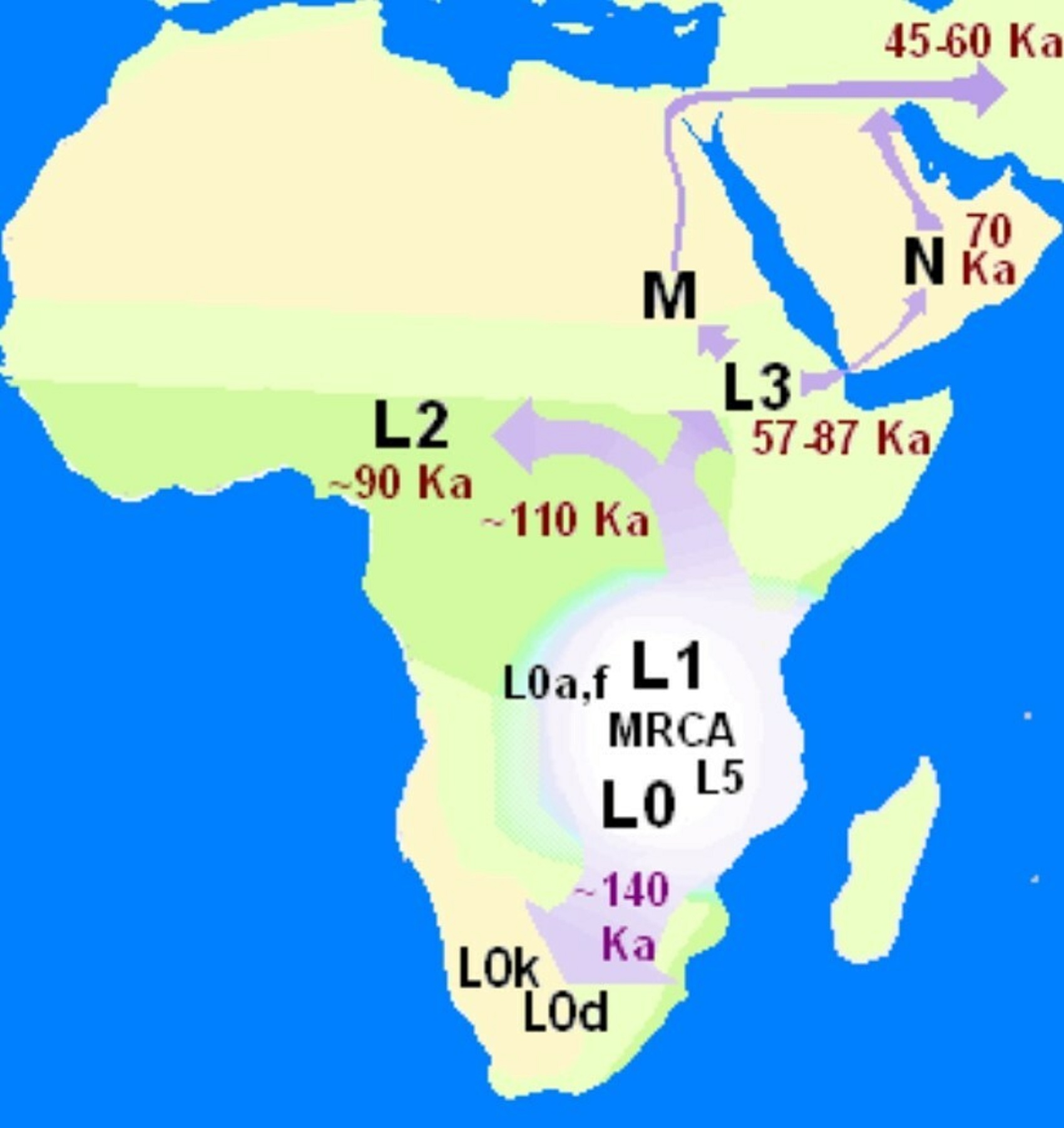

Pic ref
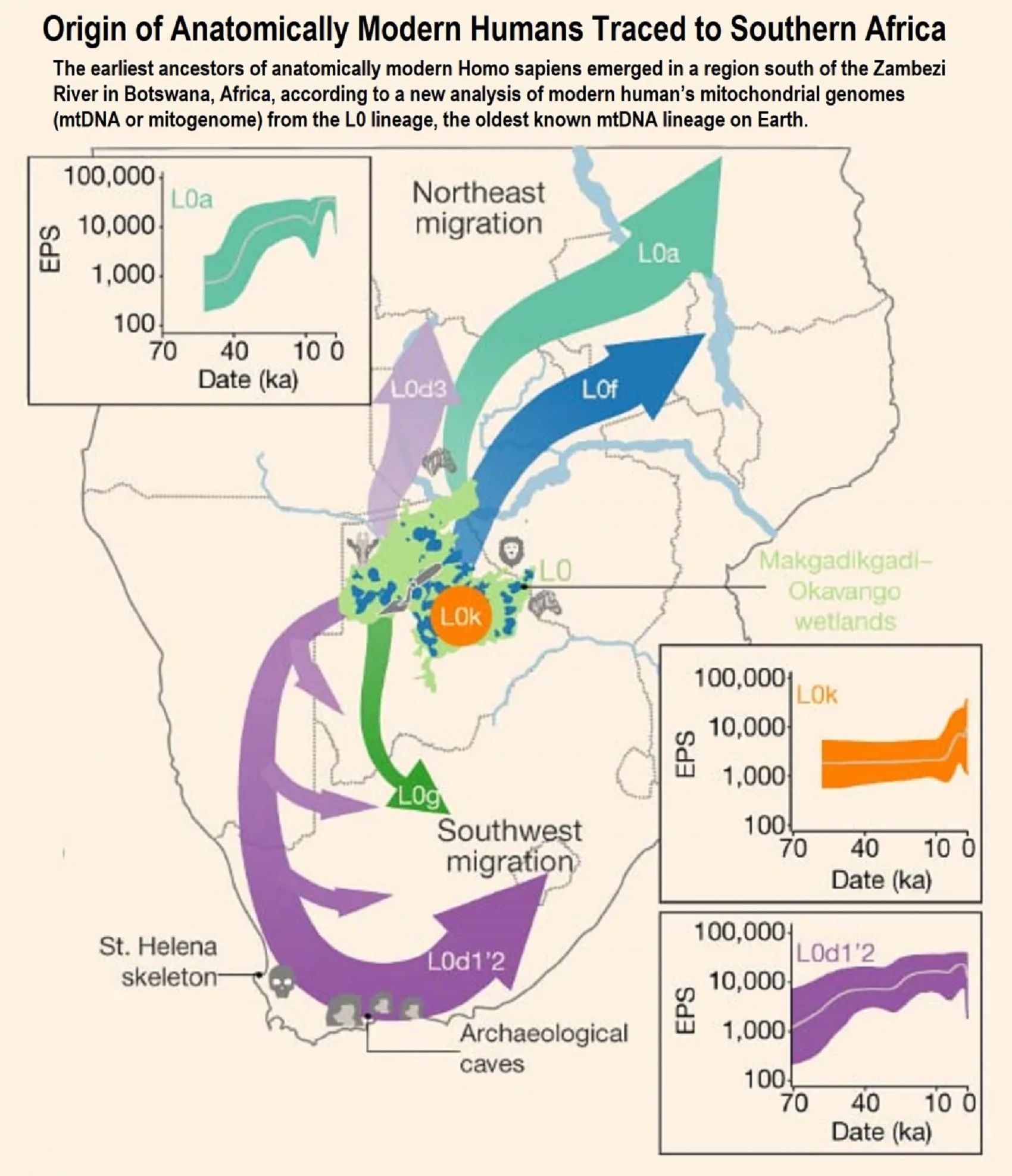
Pic ref
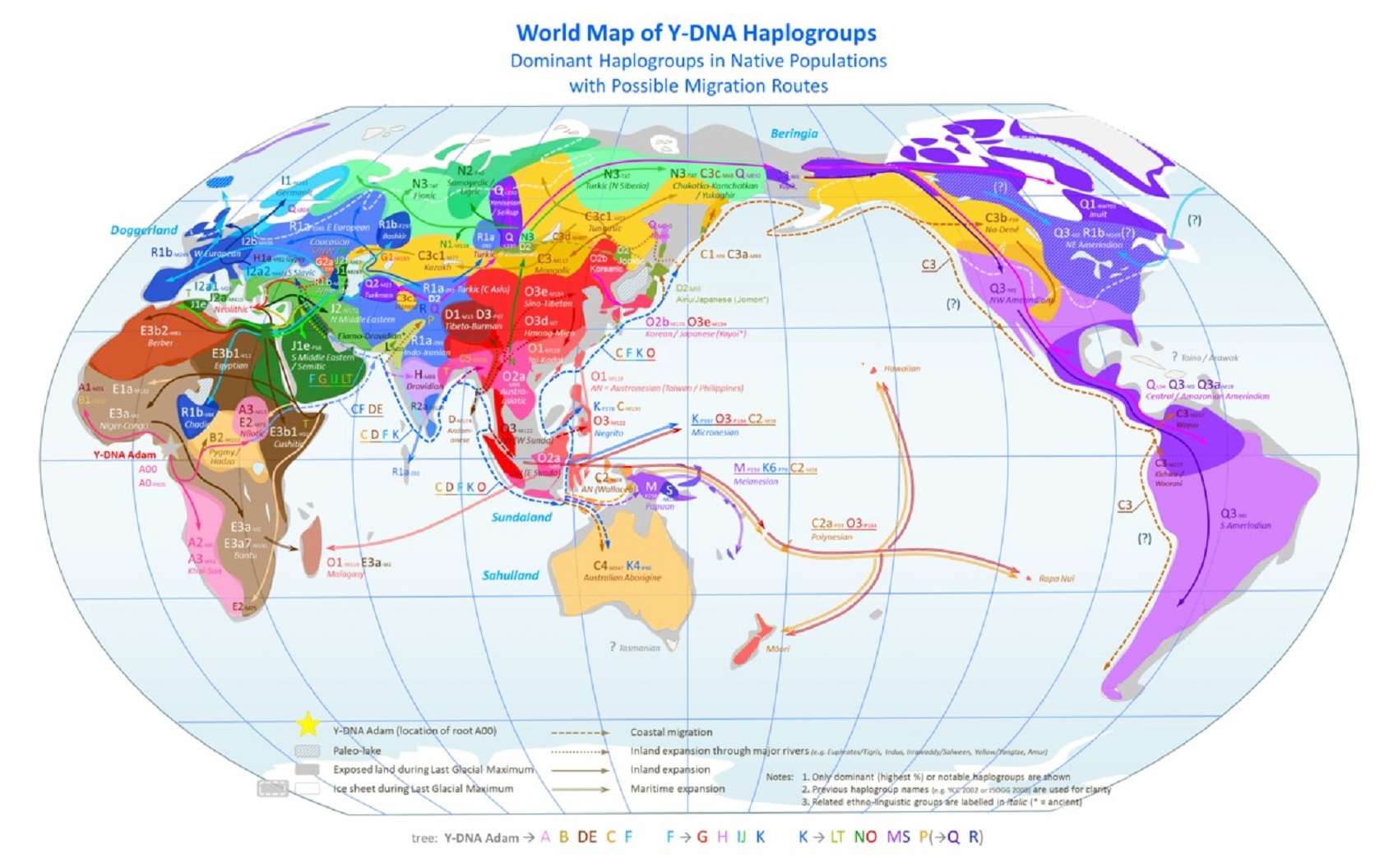
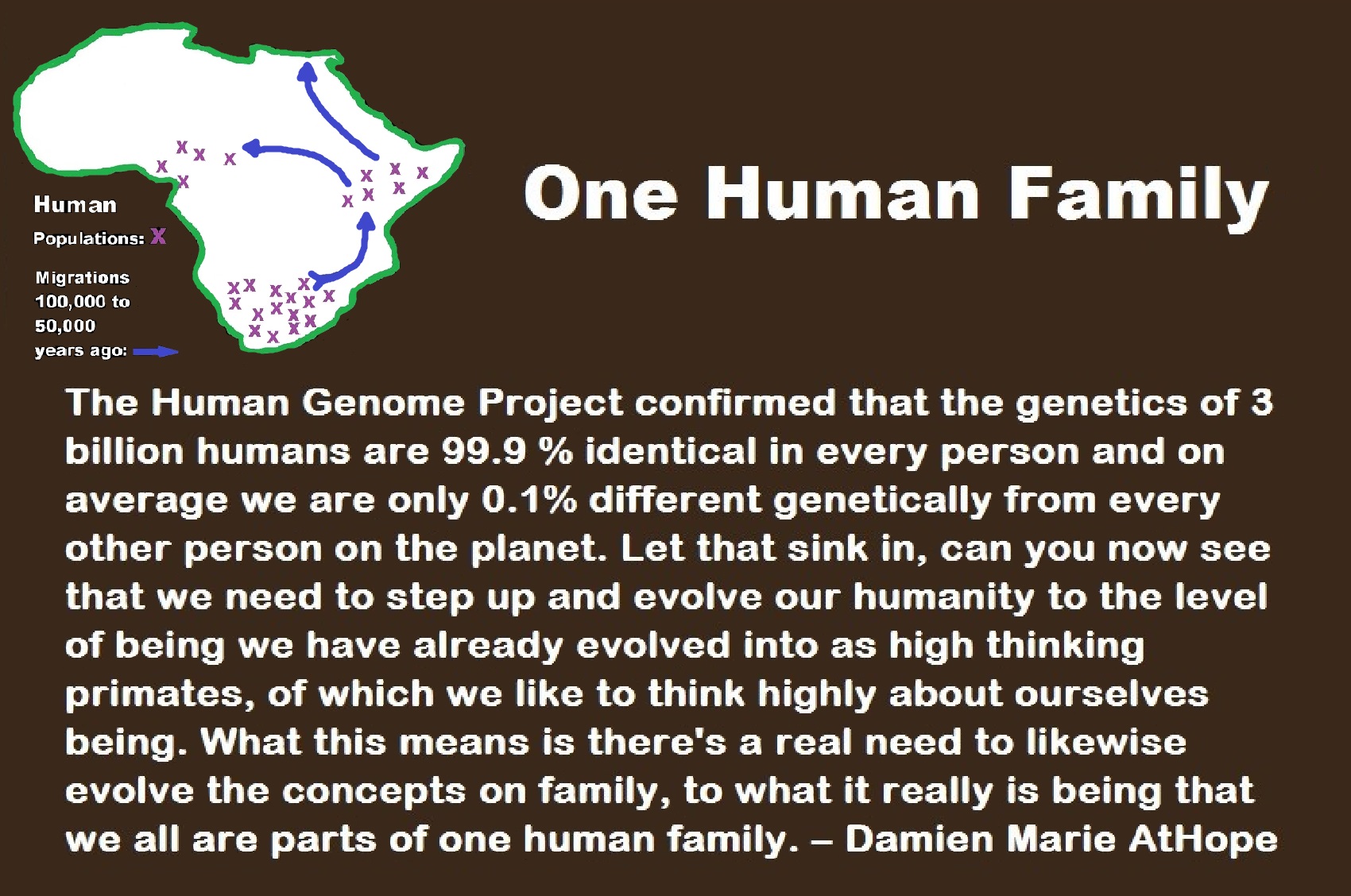
“When researchers completed the final analysis of the Human Genome Project in April 2003, they confirmed that the 3 billion base pairs of genetic letters in humans were 99.9 percent identical in every person. It also meant that individuals are, on average, 0.1 percent different genetically from every other person on the planet. And in that 0.1 percent lies the mystery of why some people are more susceptible to a particular illness or more likely to be healthy than their neighbor – or even another family member.” ref
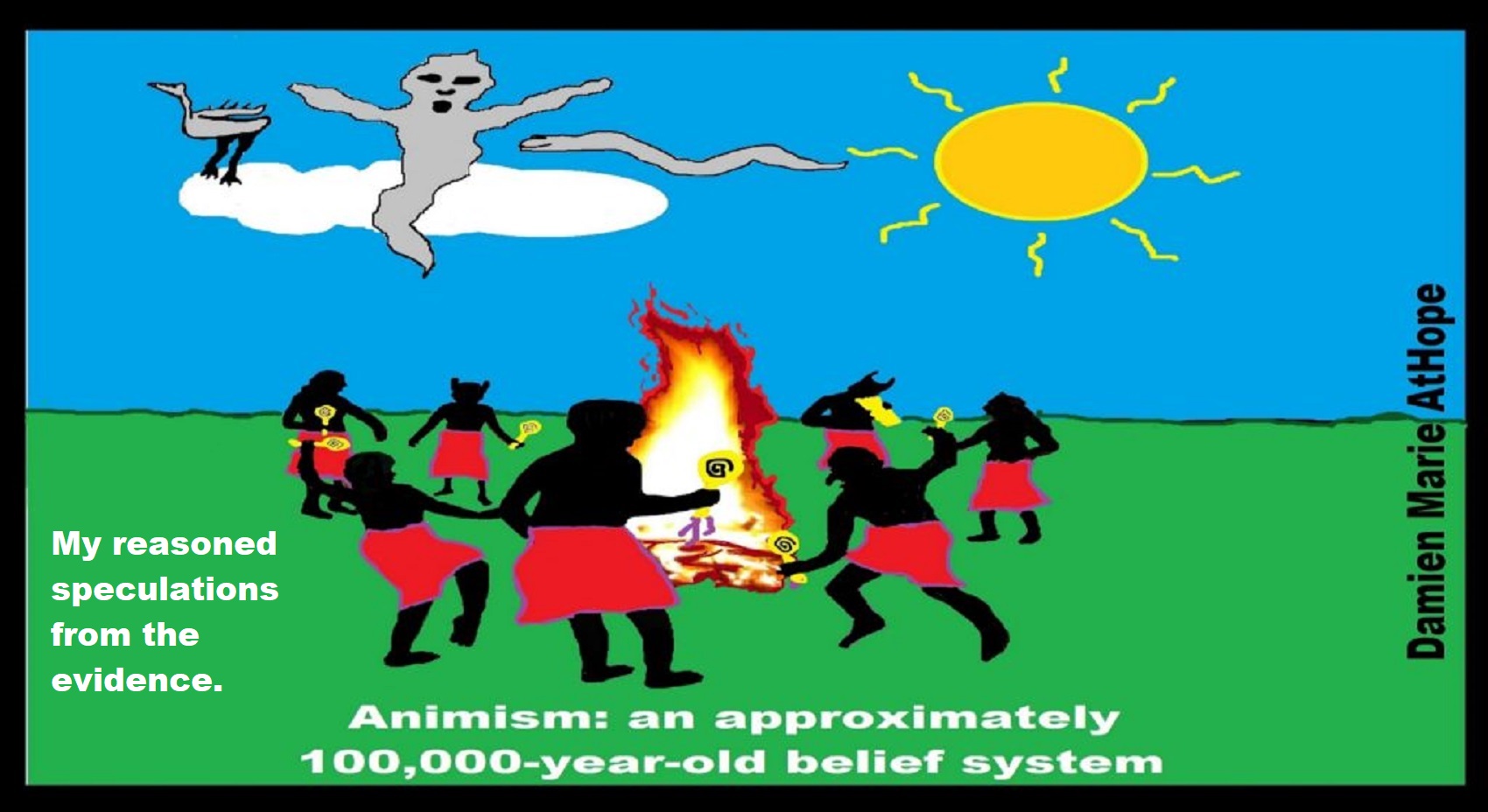
Animism (such as that seen in Africa: 100,000 years ago)
- Animism: an approximately 100,000-year-old belief system?
- Rock crystal stone tools 75,000 Years Ago – (Spain) made by Neanderthals
- Stone Snake of South Africa: “first human worship” 70,000 years ago
- Similarities and differences in Animism and Totemism
- Did Neanderthals Help Inspire Totemism? Because there is Art Dating to Around 65,000 Years Ago in Spain?
- History of Drug Use with Religion or Sacred Rituals possibly 58,000 years ago?
Animism is approximately a 100,000-year-old belief system and believe in spirit-filled life and/or afterlife. If you believe like this, regardless of your faith, you are a hidden animist.
The following is evidence of Animism: 100,000 years ago, in Qafzeh, Israel, the oldest intentional burial had 15 African individuals covered in red ocher was from a group who visited and returned back to Africa. 100,000 to 74,000 years ago, at Border Cave in Africa, an intentional burial of an infant with red ochre and a shell ornament, which may have possible connections to the Africans buried in Qafzeh, Israel. 120,000 years ago, did Neanderthals teach us Primal Religion (Pre-Animism/Animism) as they too used red ocher and burials? ref, ref
It seems to me, it may be the Neanderthals who may have transmitted a “Primal Religion (Animism)” or at least burial and thoughts of an afterlife. The Neanderthals seem to express what could be perceived as a Primal “type of” Religion, which could have come first and is supported in how 250,000 years ago, the Neanderthals used red ochre and 230,000 years ago shows evidence of Neanderthal burial with grave goods and possibly a belief in the afterlife. ref
Do you think it is crazy that the Neanderthals may have transmitted a “Primal Religion”? Consider this, it appears that 175,000 years ago, the Neanderthals built mysterious underground circles with broken off stalactites. This evidence suggests that the Neanderthals were the first humans to intentionally bury the dead, doing so in shallow graves along with stone tools and animal bones. Exemplary sites include Shanidar in Iraq, Kebara Cave in Israel and Krapina in Croatia. Other evidence may suggest the Neanderthals had it transmitted to them by Homo heidelbergensis, 350,000 years ago, by their earliest burial in a shaft pit grave in a cave that had a pink stone axe on the top of 27 Homo heidelbergensis individuals and 250,000 years ago, Homo naledi had an intentional cemetery in South Africa cave. ref, ref, ref, ref, ref
- “120,000–90,000 years ago: Abbassia Pluvial in North Africa—the Sahara desert region is wet and fertile.
- 120,000 to 75,000 years ago: Khoisanid back-migration from Southern Africa to East Africa.
- 82,000 years ago: small perforated seashell beads from Taforalt in Morocco are the earliest evidence of personal adornment found anywhere in the world.
- 75,000 years ago: Toba Volcano supereruption that almost made humanity extinct. Populations could have been lowered to about 3000-1000 people on the Earth.
- 70,000 years ago: earliest example of abstract art or symbolic art from Blombos Cave, South Africa—stones engraved with grid or cross-hatch patterns.
- 70,000 years ago: Recent African origin: separation of sub-Saharan Africans and non-Africans.” ref
Did Neanderthals Help Inspire Totemism?
Because there is Art Dating to Around 65,000 Years Ago in Spain?
“What About Neanderthals and Religion”
Scientists have found the first major evidence that Neanderthals made cave paintings, indicating they may have had an artistic sense similar to our own. A new study led by the University of Southampton and the Max Planck Institute for Evolutionary Anthropology shows that paintings in three caves in Spain were created more than 64,000 years ago – 20,000 years before modern humans arrived in Europe. This means that the Palaeolithic (Ice Age) cave art – including pictures of animals, dots, and geometric signs – must have been made by Neanderthals, a ‘sister’ species to Homo sapiens, and Europe’s sole human inhabitants at the time. It also indicates that they may have had a similar artistic sense, in terms of thinking symbolically, to modern humans. Published today in the journal Science, the study reveals how an international team of scientists used a state-of-the-art technique called uranium-thorium dating to fix the age of the paintings as more than 64,000 years. Until now, cave art has been attributed entirely to modern humans, as claims to a possible Neanderthal origin have been hampered by imprecise dating techniques. However, uranium-thorium dating provides much more reliable results than methods such as radiocarbon dating, which can give false age estimates. Results show that the paintings we dated are, by far, the oldest known cave art in the world, and were created at least 20,000 years before modern humans arrived in Europe from Africa so it is assumed – therefore they may have been painted by Neanderthals. All three caves contain red (ochre) or black paintings of groups of animals, dots, and geometric signs, as well as hand stencils, handprints, and engravings. According to the researchers, creating the art must have involved such sophisticated behavior as the choice of a location, planning of light source and mixing of pigments. There is evidence that Neanderthals in Europe used body ornamentation around 40,000 to 45,000 years ago, but many researchers have suggested this was inspired by modern humans who at the time had just arrived in Europe. Study co-author Paul Pettitt, of Durham University, commented: “Neanderthals created meaningful symbols in meaningful places. The art is not a one-off accident. ref
Neanderthals are our closest extinct relative, but for a long time, they had a reputation for being pretty backward. Early modern humans, for example, made cave paintings. But even though Neanderthals used pigments and decorated themselves with eagle claws and shells, there was no clear proof that they painted caves. One theory goes that Neanderthals developed their rudimentary culture only after early modern humans arrived in Europe some 40,000 to 50,000 years ago. The most recent painting is at least 64,800 years old, according to this technique, and the oldest is more than 66,000 years old. ref
The Neanderthal was the only proven Human of Europe at the time, but was his or her brain up to the job? Or did modern humans reach Europe tens of thousands of years earlier than thought? The ancient art forms are symbolic but not figurative, explain their finders. In Spain, a cave in Maltravieso features hand stencils more than 66,000 years old, Prof. Dirk Hoffmann of the Max Planck Institute for Evolutionary Anthropology and others report in their paper, published Thursday in Science. The La Pasiega Cave in Cantabria features a ladder form composed of red horizontal and vertical lines that were created more than 64,000 years ago, they say. Further supporting the Neanderthal-as-artist theory, a related paper published Thursday in Science Advances reports that dyed and decorated seashells found in a Spanish cave dated to more than 115,000 years ago. Perforated shells found in sediments in Cueva de los Aviones that date to between 115,000 and 120,000 years. There’s no argument that there were Neanderthals in Europe 64,000 years ago. Homo sapiens, on the other hand, was thought to have reached Europe only 45,000 to 40,000 years ago. There is no evidence for modern humans in Iberia before 41,000 years ago, and there is evidence for Neanderthal presence until about 36,000 years ago in southern Spain and Portugal. Neanderthals existed for twice the time modern people have, if not more, and were once the dominant hominin in Europe. While Neanderthals may have etched a crisscross and perhaps carved a flute, look what Homo sapiens achieved, Coolidge says. The Paleolithic record is replete with exquisite works, from cave paintings to carvings done tens of thousands of years ago – such as the Lion Man sculpture found in a German cave and made of mammoth ivory some 38,000 years ago. ref
Neanderthal ritual or religious practice at around 50,000 years old burial in Sima de las Palomas in Murcia, Southeast Spain of a female covered with rocks inturned with a cut off panther paw, suggesting that Neanderthals—much like today’s bear hunters—ceremoniously cut off panther paws and kept them as totemistic trophies. This 50,000-year-old Neanderthal burial ground actually includes the remains of at least three individuals intentionally buried, with each Neanderthal’s arms folded such that the hands were close to the head. Remains of other Neanderthals have been found in this position, suggesting that it held meaning. The remains of six to seven other Neanderthals, including one baby and two juveniles, have also been excavated at the site. The tallest individual appears to have been an adult who stood around 5 feet 1 inch tall. ref, ref
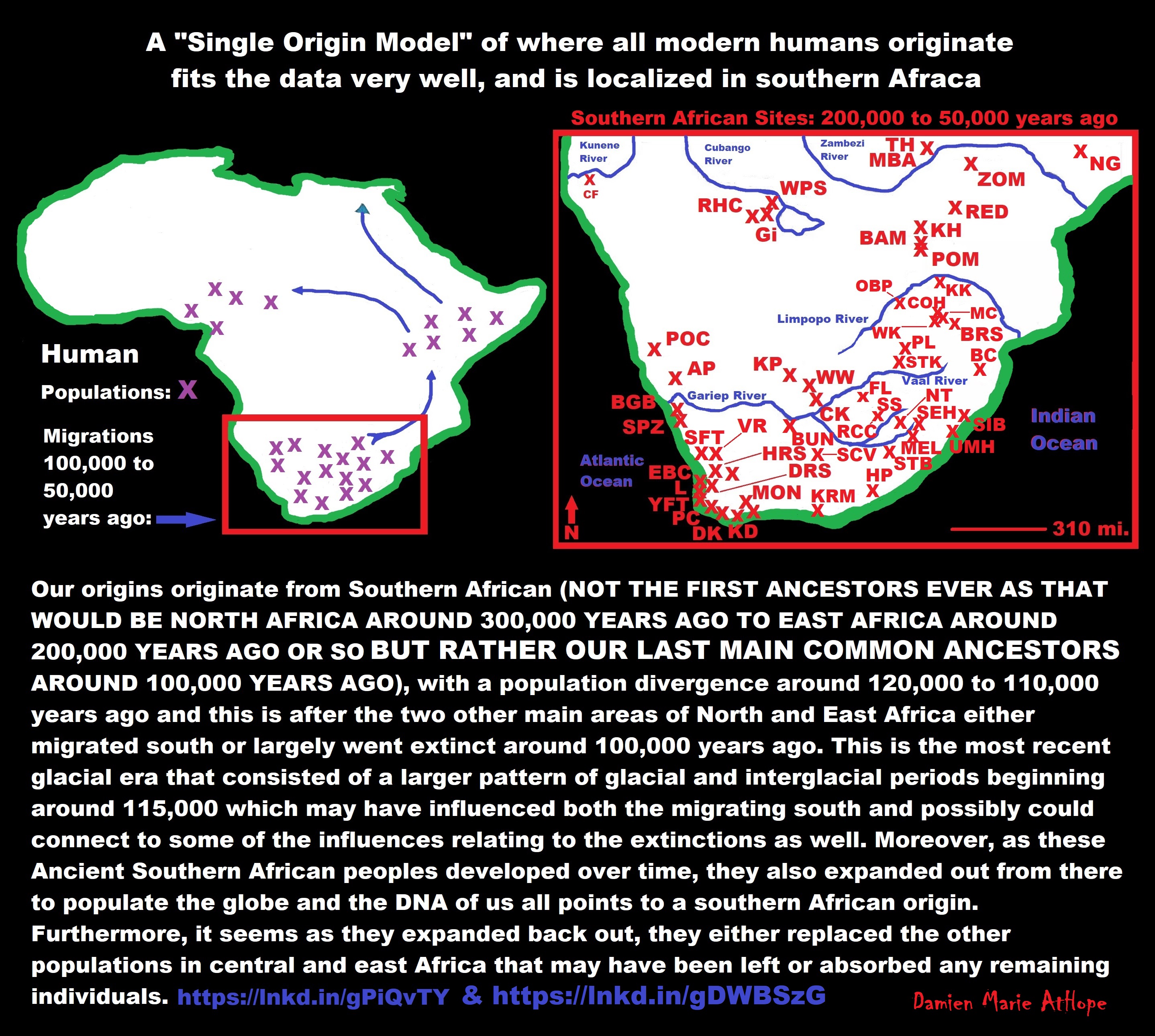
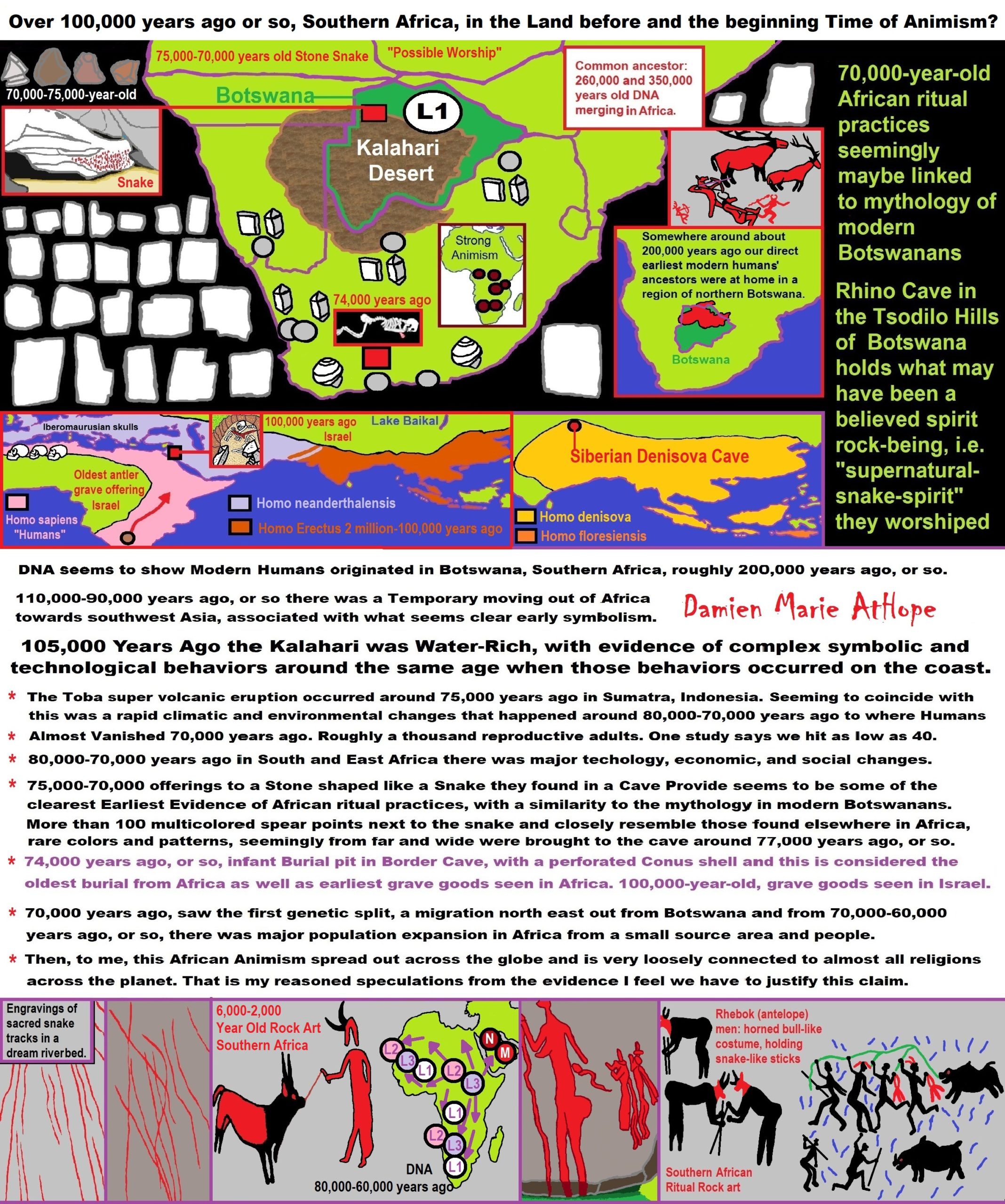
ref, ref, ref, ref, ref, ref, ref, ref, ref, ref, ref, ref, ref, ref, ref, ref, ref, ref, ref, ref, ref, ref, ref, ref, ref, ref, ref, ref, ref, ref, ref, ref, ref, ref, ref, ref, ref, ref, ref, ref, ref, ref, ref, ref, ref, ref, ref, ref, ref, ref, ref, ref
Animism: a belief among some indigenous people, young children, or all religious people!
Over 100,000 years ago or so, Southern Africa, in the Land before and the beginning Time of Animism: LINK
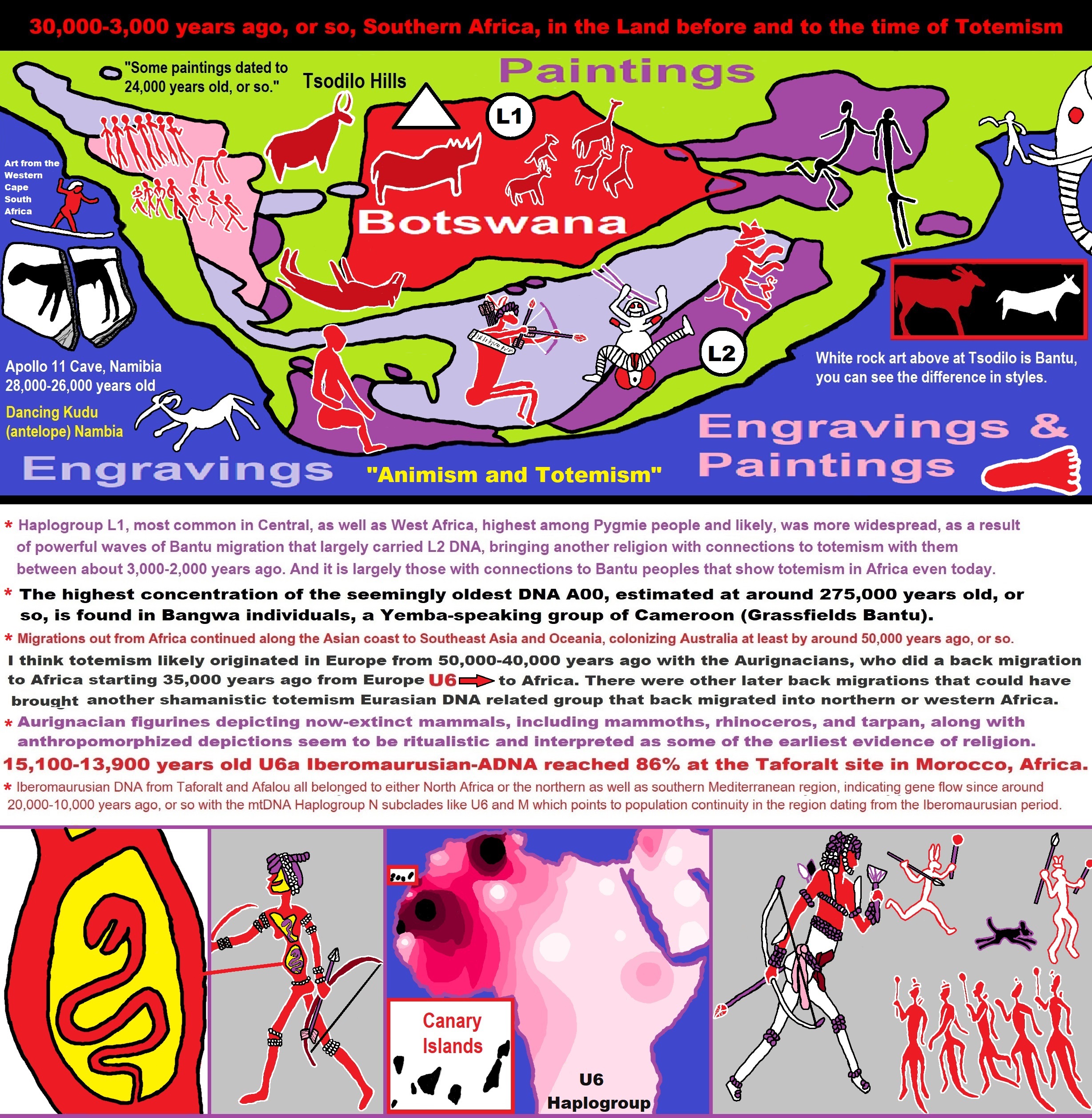
ref, ref, ref, ref, ref, ref, ref, ref, ref, ref, ref, ref, ref, ref, ref, ref, ref, ref, ref, ref, ref, ref, ref, ref, ref, ref, ref, ref, ref, ref, ref, ref, ref, ref, ref, ref, ref, ref, ref, ref, ref, ref, ref, ref, ref, ref, ref, ref, ref, ref, ref, ref, ref, ref, ref, ref, ref, ref, ref, ref,
Explaining the Earliest Religious Expression, that of Animism (beginning 100,000 to 70,000 years ago?) to Totemism (beginning 30,000 to 3,000 years ago?) in Southern Africa: LINK
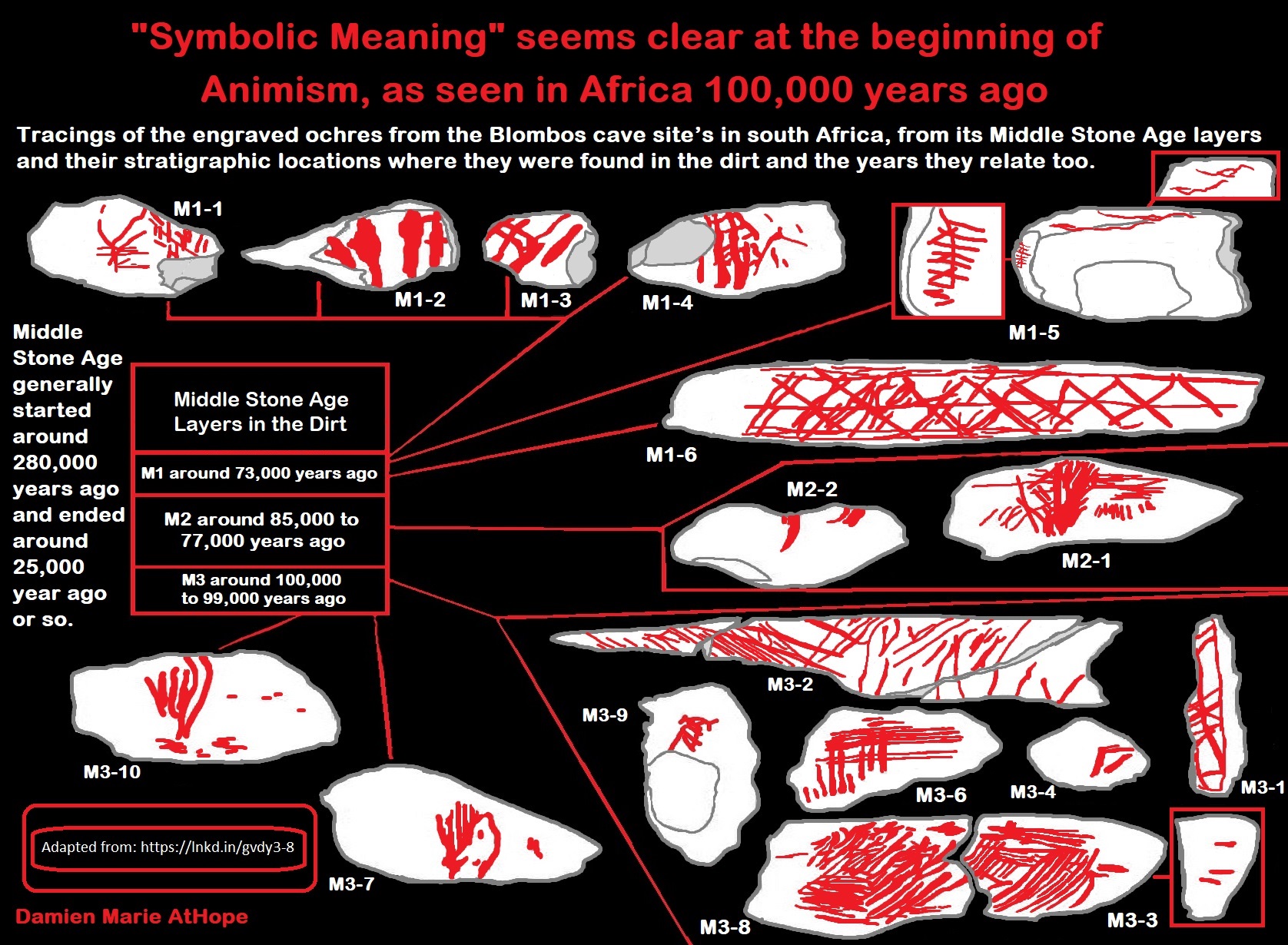
Adapted from: ref


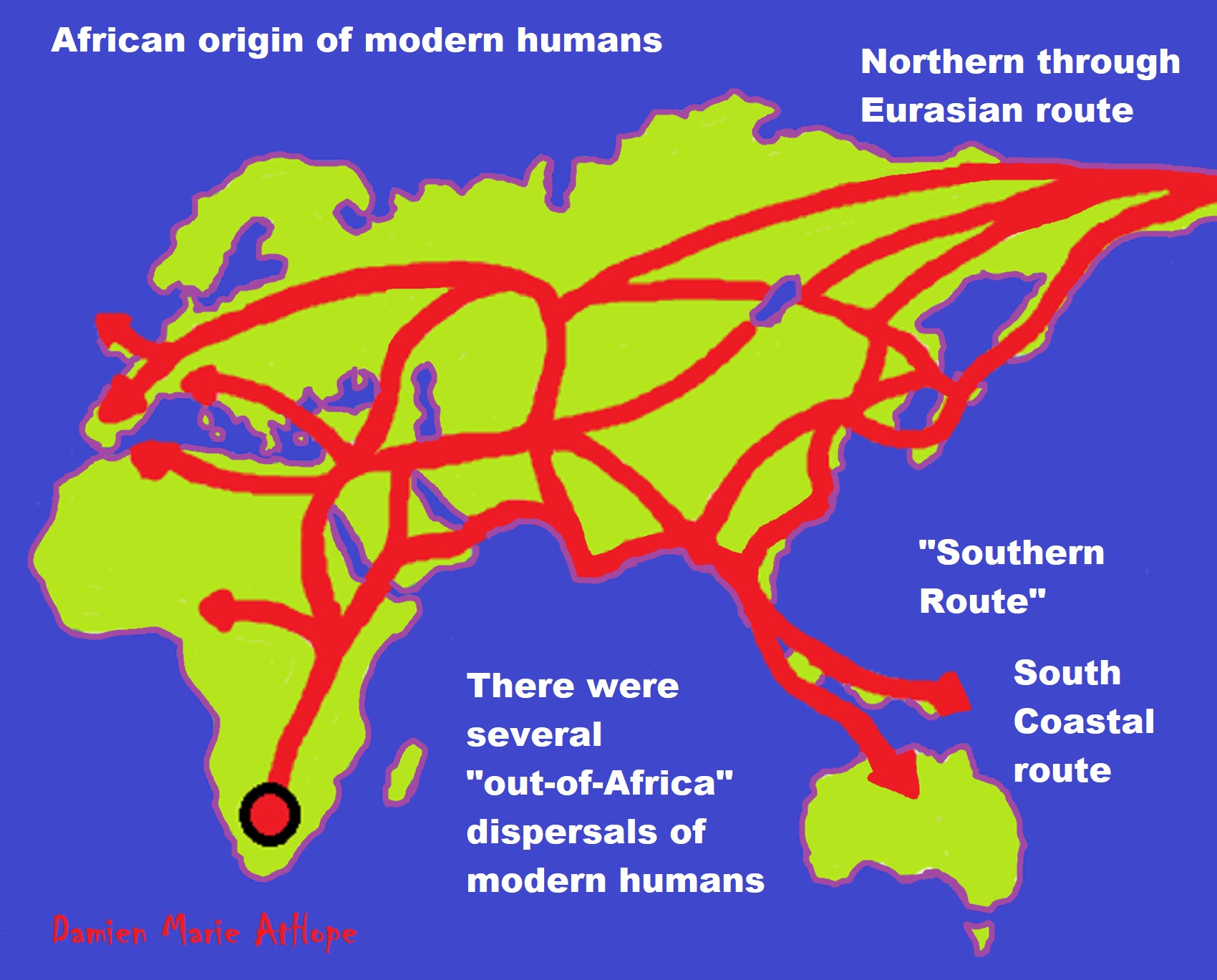
ref, ref, ref, ref, ref, ref, ref, ref
“There are two geographically plausible routes that have been proposed for humans to emerge from Africa: through the current Egypt and Sinai (Northern Route), or through Ethiopia, the Bab el Mandeb strait, and the Arabian Peninsula (Southern Route).” ref
“Although there is a general consensus on the African origin of early modern humans, there is disagreement about how and when they dispersed to Eurasia. This paper reviews genetic and Middle Stone Age/Middle Paleolithic archaeological literature from northeast Africa, Arabia, and the Levant to assess the timing and geographic backgrounds of Upper Pleistocene human colonization of Eurasia. At the center of the discussion lies the question of whether eastern Africa alone was the source of Upper Pleistocene human dispersals into Eurasia or were there other loci of human expansions outside of Africa? The reviewed literature hints at two modes of early modern human colonization of Eurasia in the Upper Pleistocene: (i) from multiple Homo sapiens source populations that had entered Arabia, South Asia, and the Levant prior to and soon after the onset of the Last Interglacial (MIS-5), (ii) from a rapid dispersal out of East Africa via the Southern Route (across the Red Sea basin), dating to ~74,000-60,000 years ago.” ref
“Within Africa, Homo sapiens dispersed around the time of its speciation, roughly 300,000 years ago. The so-called “recent dispersal” of modern humans took place about 70–50,000 years ago. It is this migration wave that led to the lasting spread of modern humans throughout the world. The coastal migration between roughly 70,000 and 50,000 years ago is associated with mitochondrial haplogroups M and N, both derivative of L3. Europe was populated by an early offshoot that settled the Near East and Europe less than 55,000 years ago. Modern humans spread across Europe about 40,000 years ago, possibly as early as 43,000 years ago, rapidly replacing the Neanderthal population.” ref, ref

ref, ref, ref, ref, ref, ref, ref, ref, ref, ref, ref, ref
“There were at least several “out-of-Africa” dispersals of modern humans, possibly beginning as early as 270,000 years ago, including 215,000 years ago to at least Greece, and certainly via northern Africa and the Arabian Peninsula about 130,000 to 115,000 years ago. These early waves appear to have mostly died out or retreated by 80,000 years ago.” ref
“The most significant “recent” wave out of Africa took place about 70,000–50,000 years ago, via the so-called “Southern Route“, spreading rapidly along the coast of Asia and reaching Australia by around 65,000–50,000 years ago, (though some researchers question the earlier Australian dates and place the arrival of humans there at 50,000 years ago at earliest, while others have suggested that these first settlers of Australia may represent an older wave before the more significant out of Africa migration and thus not necessarily be ancestral to the region’s later inhabitants) while Europe was populated by an early offshoot which settled the Near East and Europe less than 55,000 years ago.” ref
- “An Eastward Dispersal from Northeast Africa to Arabia 150,000–130,000 years ago based on the finds at Jebel Faya dated to 127,000 years ago (discovered in 2011). Possibly related to this wave are the finds from Zhirendong cave, Southern China, dated to more than 100,000 years ago. Other evidence of modern human presence in China has been dated to 80,000 years ago.” ref
- “The most significant out of Africa dispersal took place around 50–70,000 years ago via the so-called Southern Route, either before or after the Toba event, which happened between 69,000 and 77,000 years ago. This dispersal followed the southern coastline of Asia, and reached Australia around 65,000-50,000 years ago, or according to some research, by 50,000 years ago at earliest. Western Asia was “re-occupied” by a different derivation from this wave around 50,000 years ago, and Europe was populated from Western Asia beginning around 43,000 years ago.” ref
- “Wells (2003) describes an additional wave of migration after the southern coastal route, namely a northern migration into Europe at circa 45,000 years ago. However, this possibility is ruled out by Macaulay et al. (2005) and Posth et al. (2016), who argue for a single coastal dispersal, with an early offshoot into Europe.” ref
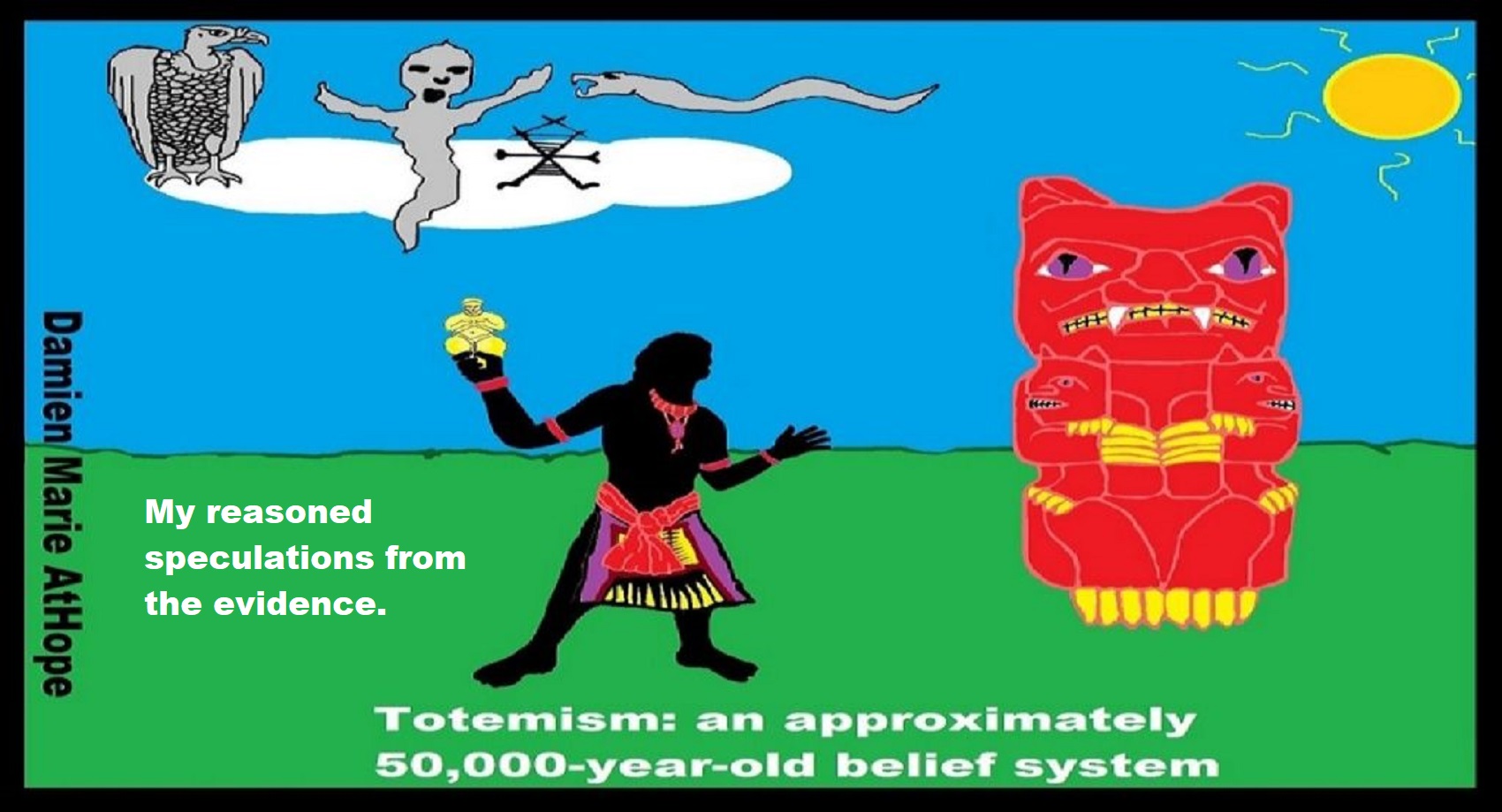
Totemism as seen in Europe: 50,000 years ago, mainly the Aurignacian culture
- Pre-Aurignacian “Châtelperronian” (Western Europe, mainly Spain and France, possible transitional/cultural diffusion between Neanderthals and humans around 50,000-40,000 years ago)
- Archaic–Aurignacian/Proto-Aurignacian (Europe around 46,000-35,000)
- Aurignacian “classical/early to late” (Europe and other areas around 38,000 – 26,000 years ago)
- Totemism: an approximately 50,000-year-old belief system?
- Australia & Aboriginal Religion at least around 50,000 years old
- Modern Humans start around 50,000 years ago Helped by Feminisation
- Out of Africa: “the evolution of religion seems tied to the movement of people”
- Totemism and Shamanism Dispersal Theory Expressed around 50,000 to 30,000 years ago
- Possible Religion Motivations in the First Cave Art at around 43,000 years ago?
- 40,000 years old Aurignacian Lion Figurine Early Totemism?
- 40,000-35,000 years ago “first seeming use of a Totem” ancestor, animal, and possible pre-goddess worship?
- Prehistoric Egypt 40,000 years ago to The First Dynasty 5,150 years ago
- 38,000 Years Old Engraving of an Aurochs with Seeming Totemism Expression?
“The most significant “recent” Out of Africa wave took place about 70,000 years ago, via the so-called “Southern Route”, spreading rapidly along the coast of Asia and reaching Australia by around 65,000–50,000 years ago. While Europe was populated by an early offshoot which settled the Near East and Europe less than 55,000 years ago.” ref
There is prehistoric art possibly relating to Aurgnacien, it is similar to other Aurgnacien cultural items. Such as the “lion-human”, Löwenmensch figurine from Hohlenstein-Stadel, Germany but also in its decorating like marking on the arms in Aurgnacian times (43,000 – 28,000 years ago). This statue comes from Geißenklösterle, also in Germany, which contains traces of prehistoric art from between 43,000 to 30,000. This Ivory Art Statue is dated to around 32,500 to 38,000 years ago. There are 86 notches on the tablet, a number that has two special meanings, subtracted from a year equals the average number of days of pregnancy and the number of days that one of Orion’s two prominent stars, Betelguese, is visible. To ancient man, this might have linked human fertility with the spirits (stars) in the sky. ref, ref, ref, ref
All populations before around 40,000 years ago where way more inbred and then after that is has a great decrease, to which I hypothesize could be genetic evidence of the emergence of INCEST-PROHIBITION hints at the taboo in Totemism. ref
“The Horror of Incest” concerns incest taboos adopted by societies believing in totemism.
Totemism is a belief system scattered world-wide mainly by hunting and gathering peoples, which seems to diminish when agricultural becomes predominant. Totemism seems expressed all over the North American especially the west cost indigenous peoples, in Peru, in Guiana, what was the African Gold Coast, in India, the South Seas islands, Australia, Siberia, Egypt and Semitic regions. It is thought that the current true totemism is found only among Australian Aborigines, North, and South American indigenous peoples, in New Guinea, and parts of Africa and India. But it is Australia, America, and Africa that are the three main areas where totemism has been found in its most highly developed and widespread forms. ref
Totemism is approximately a 50,000-year-old belief system and believe in spirit-filled life and/or afterlife that can be attached to or be expressed in things or objects. If you believe like this, regardless of your faith, you are a hidden totemist.
Toetmism may be older as there is evidence of what looks like a Stone Snake in South Africa, which may be the “first human worship” dating to around 70,000 years ago. Many archaeologists propose that societies from 70,000 to 50,000 years ago such as that of the Neanderthals may also have practiced the earliest form of totemism or animal worship in addition to their presumably religious burial of the dead. Did Neanderthals help inspire Totemism? There is Neanderthals art dating to around 65,000 years ago in Spain. ref, ref
Based on archaeological evidence from caves around 300,000 to 50,000 years ago, suggests that a widespread Neanderthal bear-cult existed. Animal cults from 50,000 to 10,000 years ago, such as the bear cult may have had their origins in these hypothetical 300,000 to 50,000 years ago animal cults. 50,000 to 10,000 years ago, animal worship intertwined with hunting rites. For instance, archaeological evidence from art and bear remains reveals that the bear cult apparently had involved a type of sacrificial bear ceremonialism, in which a bear was shot with arrows, then was finished off by a shot in the lungs, and ritualistically buried near a clay bear statue covered with bear fur with the skull of the bear buried separately.
100,000 to 50,000 years ago, there is an increased use of red ochre at several sites in Africa. Red ochre is thought to have played an important role in rituals. 42,000 years ago, there is a ritual burial of a man covered in red ochre at Lake Mungo in Australia. Around 40,000 years ago in Europe, an abundance of fossil evidence includes elaborate burials of the dead with Venus female figurines and cave art also involving red ochre.
Around 45,000 to 30,000 years ago, the Aurignacian culture created figurines that have been found depicting faunal representations of the time period associated with now-extinct mammals, including mammoths, rhinoceros, and Tarpan, along with anthropomorphized depictions that may be interpreted as some of the earliest evidence of religion. Many 35,000-year-old animal figurines such as mammoths and horses were discovered in the Vogelherd Cave in Germany. The production of ivory beads for body ornamentation was also important to the Aurignacian.
The oldest cave art is found in the Cave of El Castillo in Spain, in early Aurignacian dated at around 40,000 years, the time when it is believed that homo sapiens migrated to Europe from Africa. The next oldest cave art is found in the Chauvet Cave in France, dating to around 37,000 to 33,500 years ago (Aurignacian period: Totemism) and the second from 31,000 to 28,000 years ago (Gravettian period: Shamanism) with most of the black drawings dating to the earlier period. What is interesting is the Neanderthals favor the color black as well that may connect to their transferring some of their ideas to modern humans.
Chauvet Cave appears to have been used by humans during two distinct periods: the Aurignacian and the Gravettian. Most of the artwork dates to the earlier Aurignacian period (30,000 to 32,000 years ago) and the later Gravettian occupation, which occurred 25,000 to 27,000 years ago. The art features a larger variety of wild animals such as lions, panthers, bears, and hyenas. There are no examples of complete human figures in these cave art. The cave art is believed to represent religious thought by modern humans. ref, ref, ref, ref, ref, ref, ref, ref, ref, ref, ref, ref, ref, ref, & ref
- “67,000 to 40,000 years ago: Neanderthal admixture to Eurasians
- 50,000 years ago: the earliest sewing needle found. Made and used by Denisovans.
- 50,000–30,000 years ago: Mousterian Pluvial in North Africa. The Sahara desert region is wet and fertile. Later Stone Age begins in Africa.
- 45,000–43,000 years ago: European early modern humans.
- 45,000–40,000 years ago: Châtelperronian culture in France.
- 42,000 years ago: Paleolithic flutes in Germany.
- 42,000 years ago: earliest evidence of advanced deep sea fishing technology at the Jerimalai cave site in East Timor—demonstrates high-level maritime skills and by implication the technology needed to make ocean crossings to reach Australia and other islands, as they were catching and consuming large numbers of big deep sea fish such as tuna.
- 41,000 years ago: Denisova hominin lives in the Altai Mountains.
- 40,000 years ago: Aurignacian culture begins in Europe.
- 40,000 years ago: oldest known figurative art the zoomorphic Löwenmensch figurine.
- 40,000–30,000 years ago: human settlement (Aboriginal Australians) in Sydney, Perth, and Melbourne.
- 40,000–20,000 years ago: oldest known ritual cremation, the Mungo Lady, in Lake Mungo, Australia.
- 35,000 years ago: one of the oldest known figurative art of a human figure as opposed to a zoomorphic figure (Venus of Hohle Fels).” ref
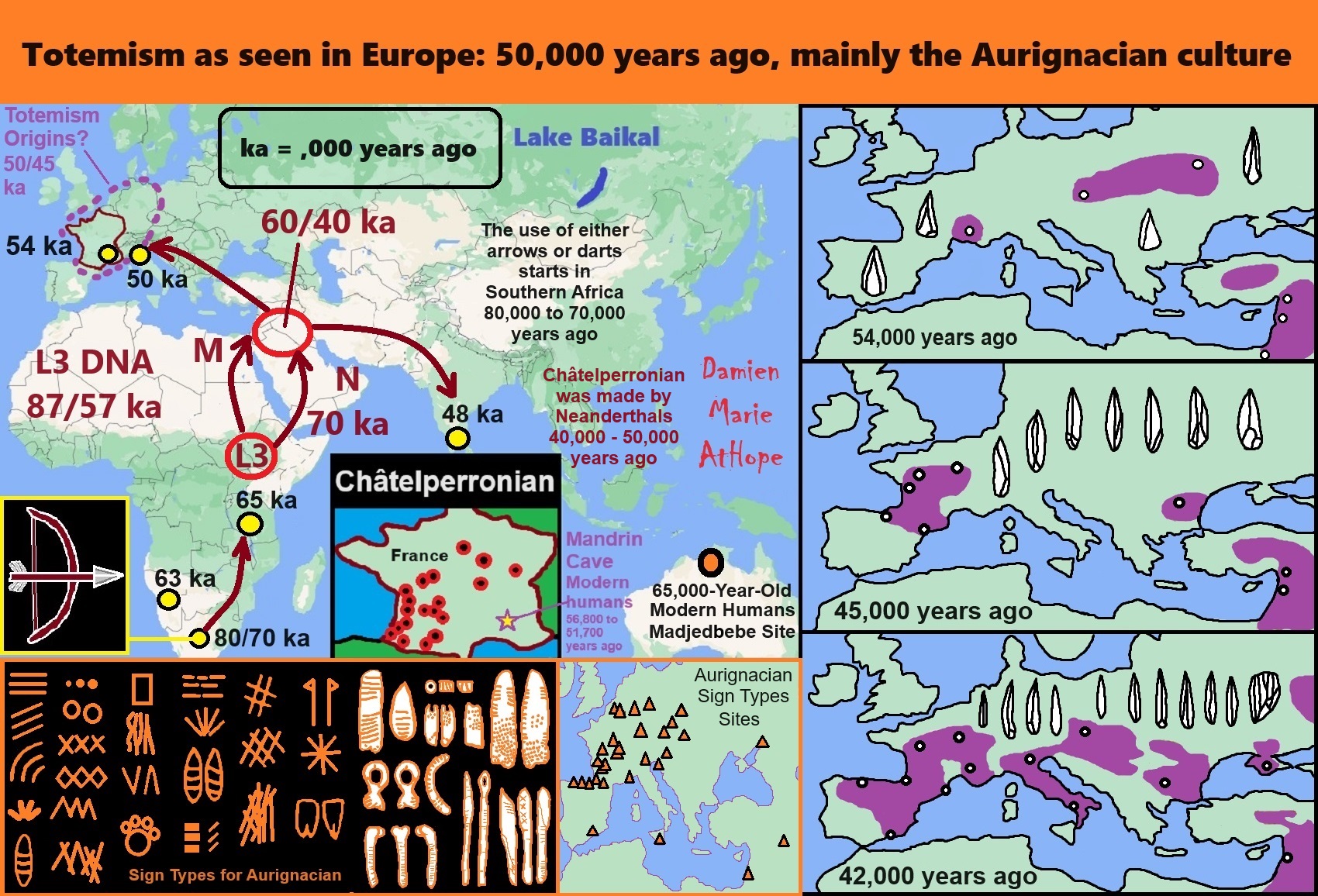
ref, ref, ref, ref, ref, ref, ref, ref, ref, ref, ref, ref, ref, ref, ref, ref, ref, ref, ref, ref, ref, ref, ref
This is my thoughts/speculations on the origins of Totemism
Totemism as seen in Europe: 50,000 years ago, mainly the Aurignacian culture
- Pre-Aurignacian “Châtelperronian” (Western Europe, mainly Spain and France, possible transitional/cultural diffusion between Neanderthals and humans around 50,000-40,000 years ago)
- Archaic–Aurignacian/Proto-Aurignacian (Europe around 46,000-35,000)
- Aurignacian “classical/early to late” (Europe and other areas around 38,000 – 26,000 years ago)
“In the realm of culture, the archeological evidence also supports a Neandertal contribution to Europe’s earliest modern human societies, which feature personal ornaments completely unknown before immigration and are characteristic of such Neandertal-associated archeological entities as the Chatelperronian and the Uluzzian.” – (PDF) Neandertals and Moderns Mixed, and It Matters: Link
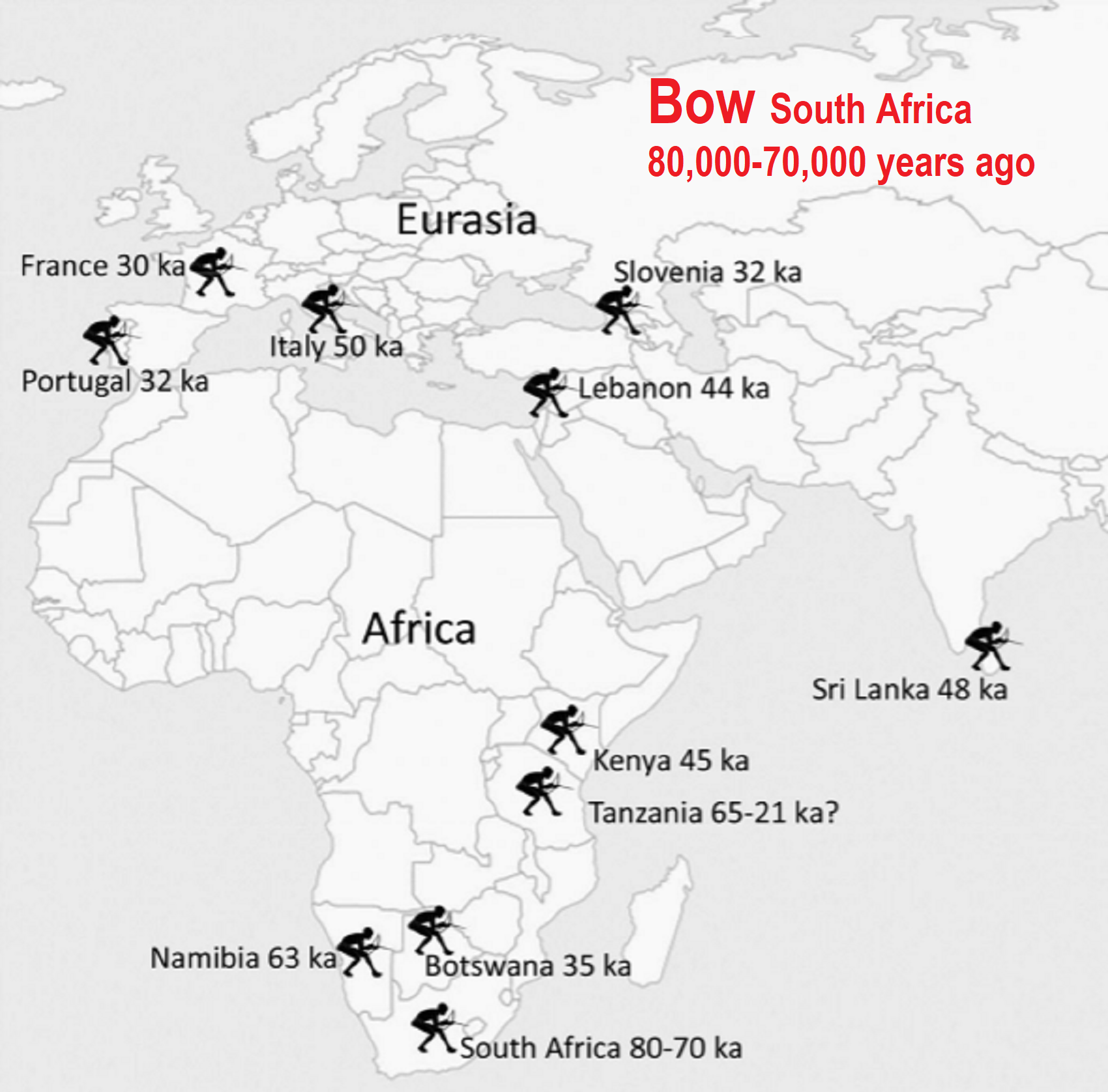
Did Pleistocene Africans use the spearthrower‐and‐dart?
“Well, evidence grows apace for ever-more ancient bow-and-arrow use. List of age estimates, locations, and current evidence bundles for the use of either arrows or darts by/before 30,000 years ago, the list may not be exhaustive, but we suggest that it broadly summarizes current knowledge (MSA = middle stone age).” ref


40,000 to 50,000 years ago, the Emergence of Norm Violations
Around 50,000 to 40,000 years ago there seems to be the emergence of norm violations relating to what I think is totemistic cultural influenced behavior, on what research suggests is moral disgust. This early moralistic totemism or “taboo” beliefs, which, to me, relates to genetic evidence of possible moral disgust with genetics showing that after 40,000 years ago there is an extreme lowering of incest behaviors also coinciding with the emergence of more complex cave art, figurines, and personal adornments around 50,000 to 40,000 years ago. All this and more offers some confirming evidence of my thoughts on totemism’s emergence around 50,000 years ago in western Europe, seen in the Pre-Aurignacian Neanderthal “Châtelperronian” and/or by the Early Aurignacian or Proto-Aurignacian times.
In the video “Robert Sapolsky: The Biology of Humans at Our Best and Worst” (17 or so minutes in) states the emergence of norm violations of moral disgust occurred around 40,000 to 50,000 years ago which is about the time that genetics shows after 40,000 years ago there was an extreme lowering of insect behaviors coinciding with the emergence of more complex cave art, figurines, and personal adornments all confirming my thoughts on totemism emerging after 50,000 years ago in Europe by the Early Aurignacian or Proto-Aurignacian stage. And in the video “DNA Mammoths, Neanderthals, and Your Ancestors,” it also quickly including the evidence for early people following incest taboos, are clearly evident after 40,000 years ago by genetics. Which, to me, likely connects to the motivations adopted by societies believing in Totemism. ref, ref
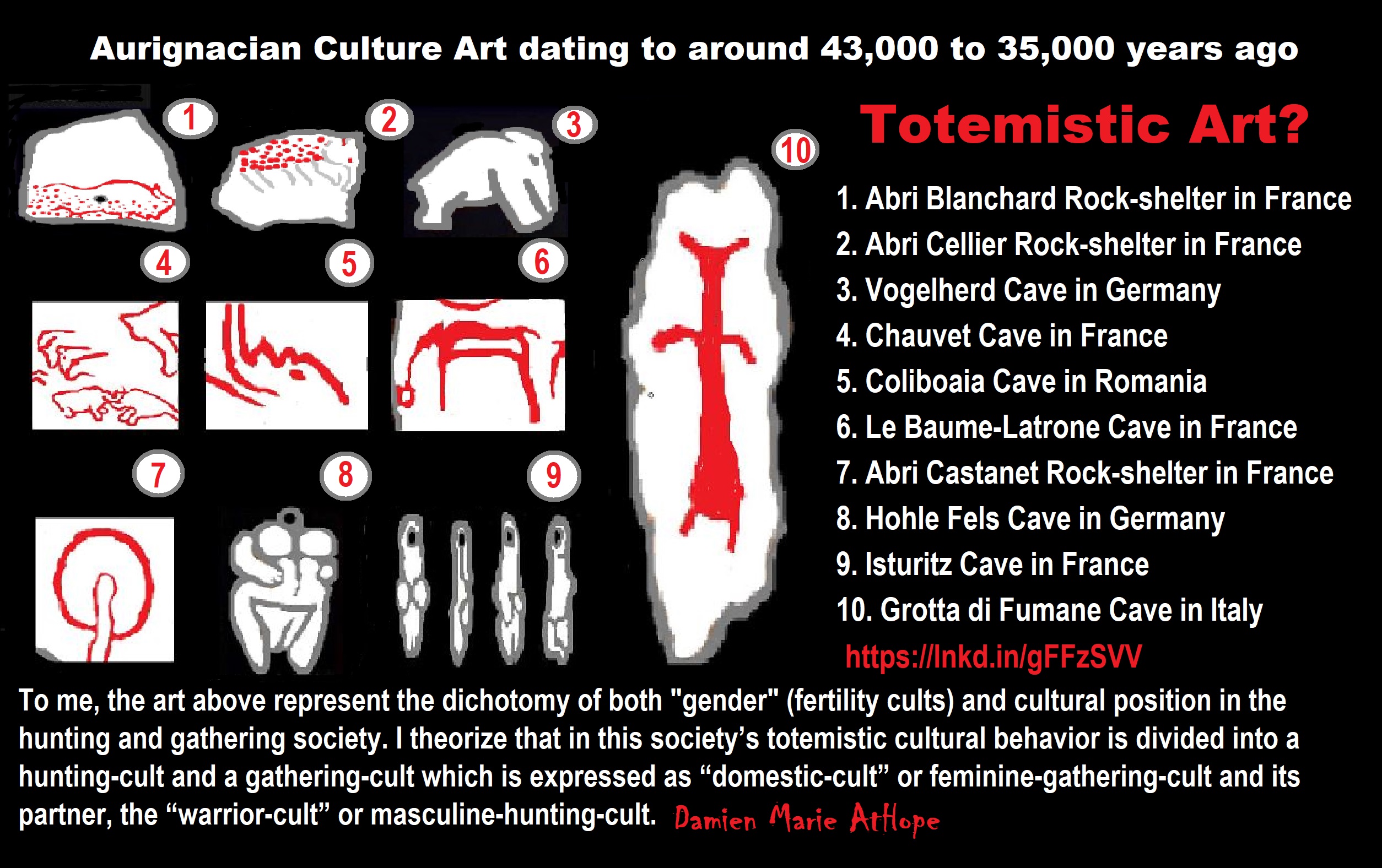

“The Adorant from the Geißenklösterle cave is a 35,000-to-40,000-year-old section of mammoth ivory with a depiction of a human figure, found in the Geißenklösterle cave in the Swabian Jura near Blaubeuren, Germany. The front face has a human figure of uncertain sex in relief, with raised arms and outstretched legs, but no hands. The posture is usually interpreted as an expression of worship, which is why in German the figure is called an “adorant”, a word meaning “worshipper”. It has been claimed that a belt and sword can be seen, although these are probably natural features of the ivory. On the plate’s reverse are rows of small notches. The piece is 38 mm (1.50 in) tall, 14 mm (0.55 in) wide, and 4.5 mm (0.18 in) thick. Traces of manganese and ochre can be found on it by microscope analysis. It is somewhat like the Lion-Human of Hohlenstein-Stadel ivory statue also found in Germany.” ref
“The Löwenmensch figurine, also called the Lion-Human of Hohlenstein-Stadel, is a prehistoric ivory sculpture discovered in Hohlenstein-Stadel, a German cave. The German name, Löwenmensch, meaning “lion-person” or “lion-human”, is used most frequently because it was discovered and is exhibited in Germany. Determined by carbon dating of the layer in which it was found to be between 35,000 and 40,000 years old, it is one of the oldest-known examples of an artistic representation and the oldest confirmed statue ever discovered. Its age associates it with the archaeological Aurignacian culture of the Upper Paleolithic. An example of zoomorphic art, the Lion-Human was carved out of mammoth ivory, using a flint stone knife. Seven parallel, transverse, carved gouges are on the left arm.” ref
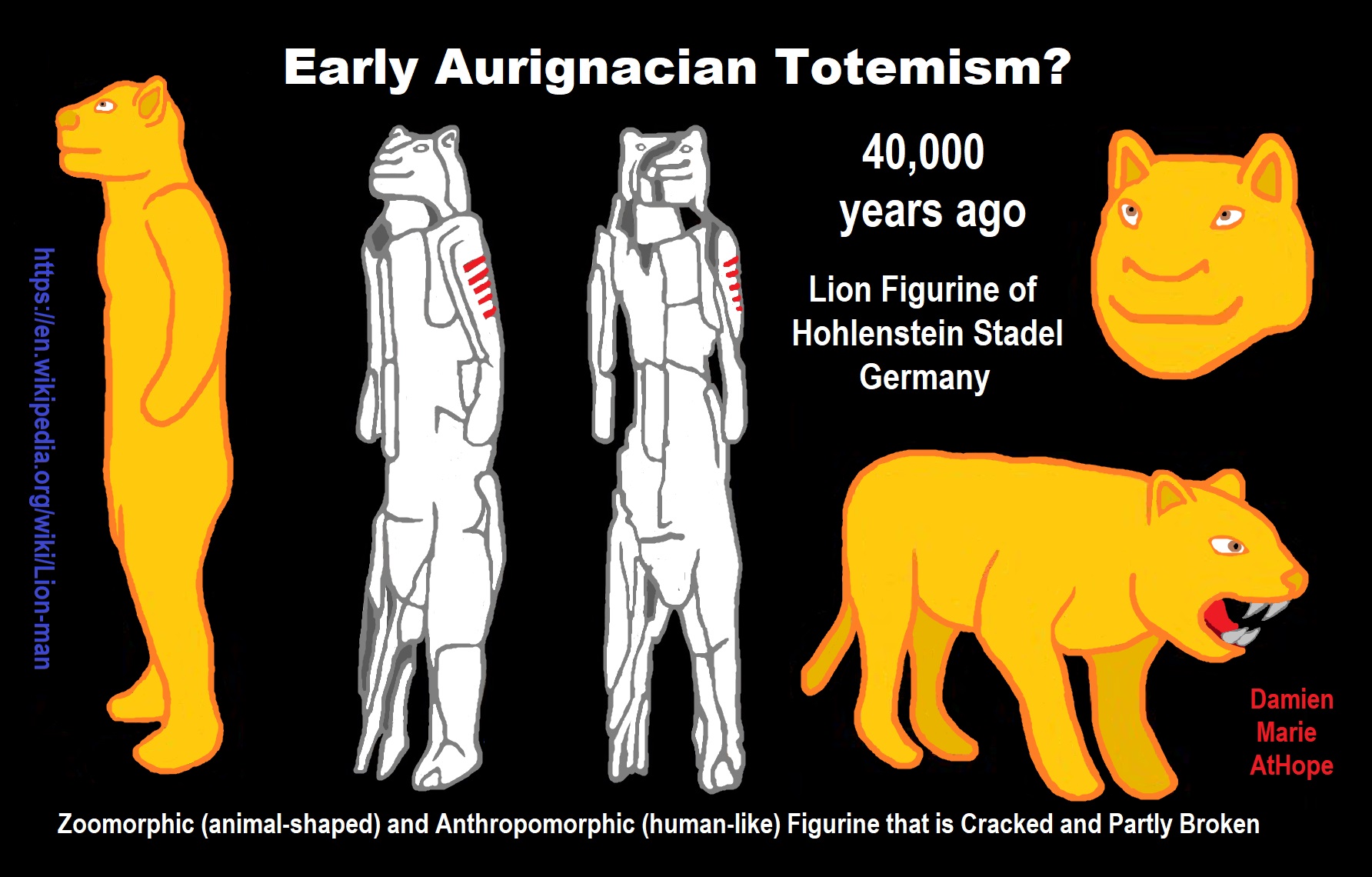

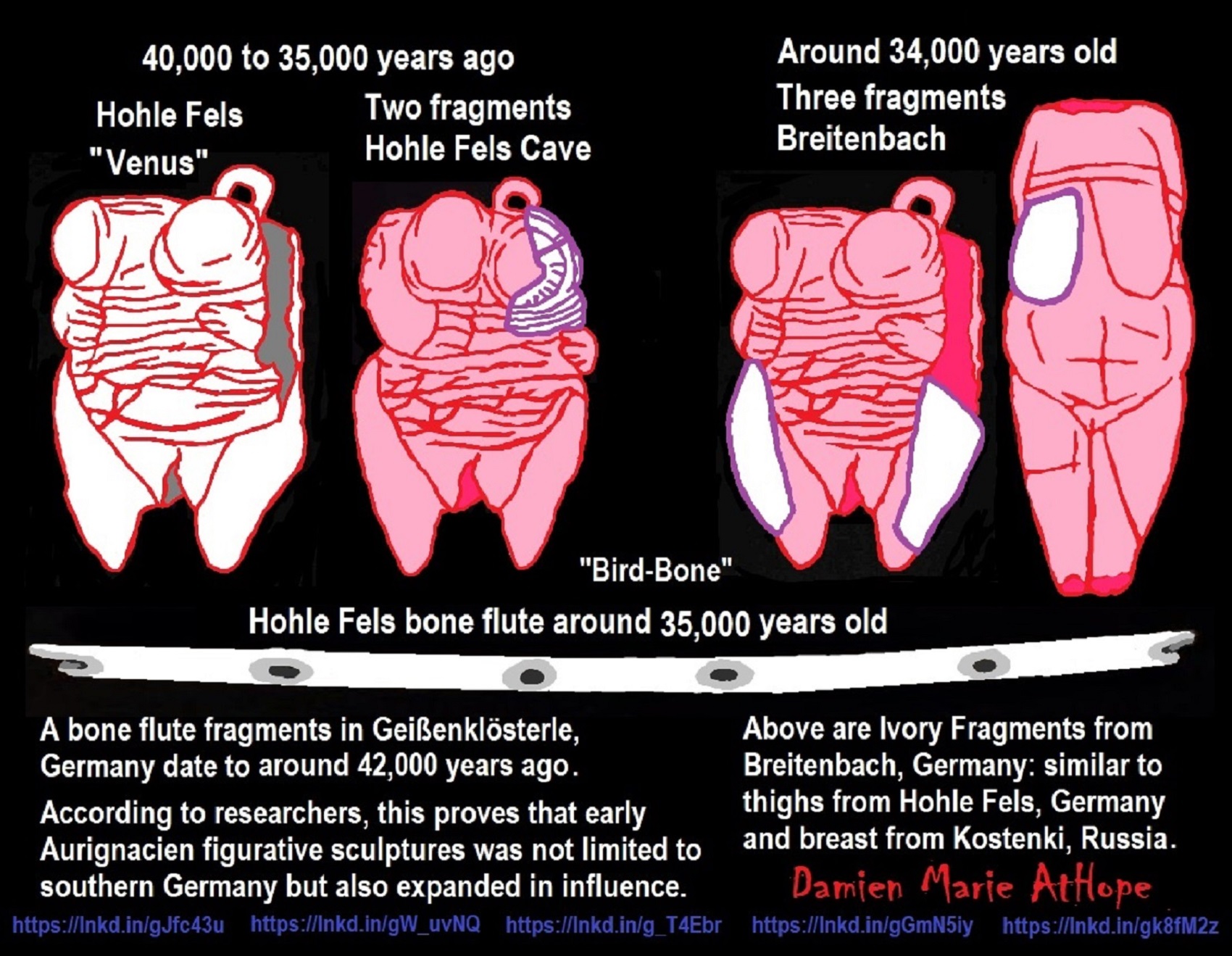
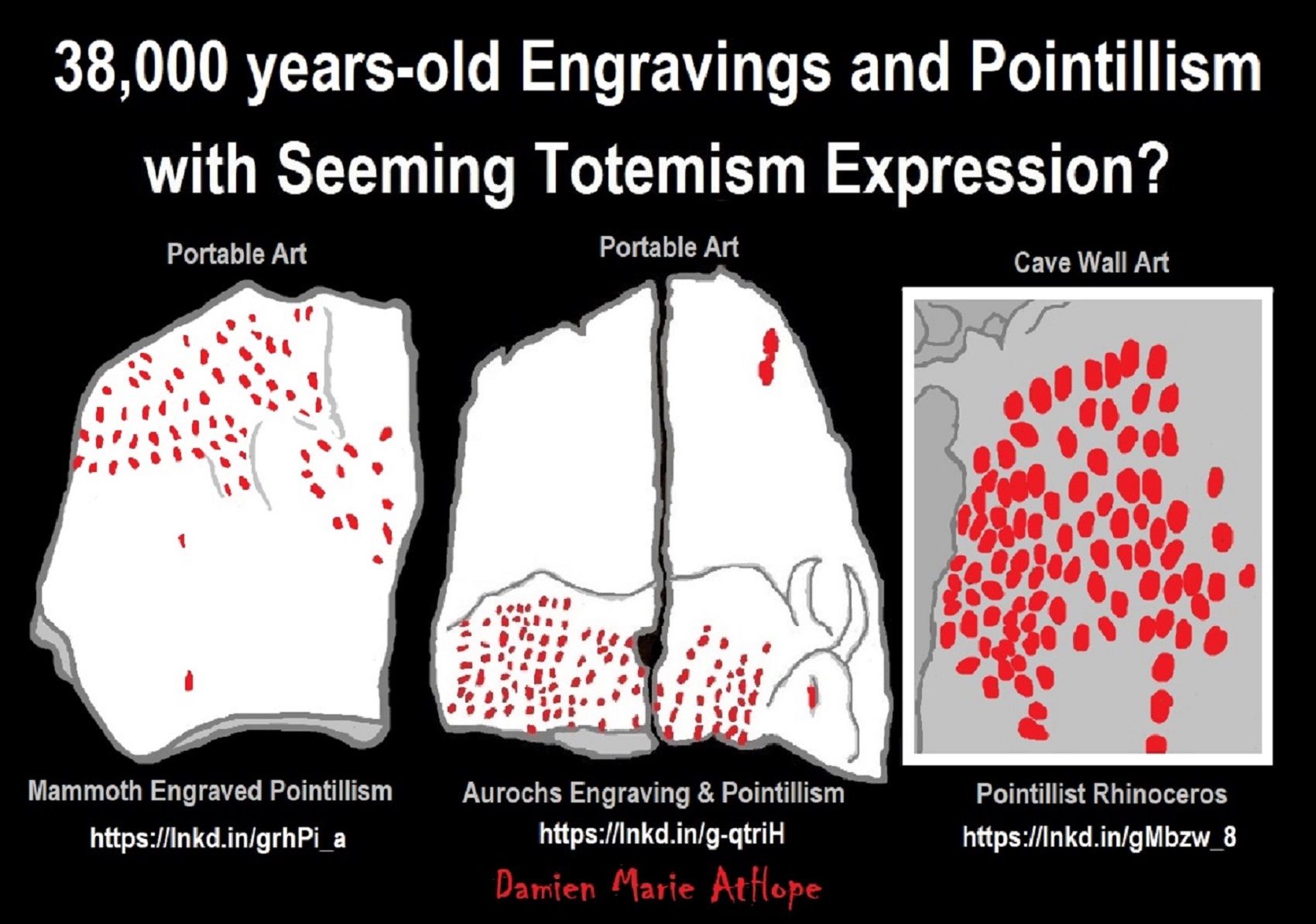
Ritual Pointillism, to me, references stars/ancestor worship in Aurignacian culture totemism, which I think relates to the Neanderthal Châtelperronian culture totemism. There was 16 engraved and otherwise modified limestone blocks, created 38,000 years ago, pointillist techniques: small dots to create the illusion of a larger image. ref

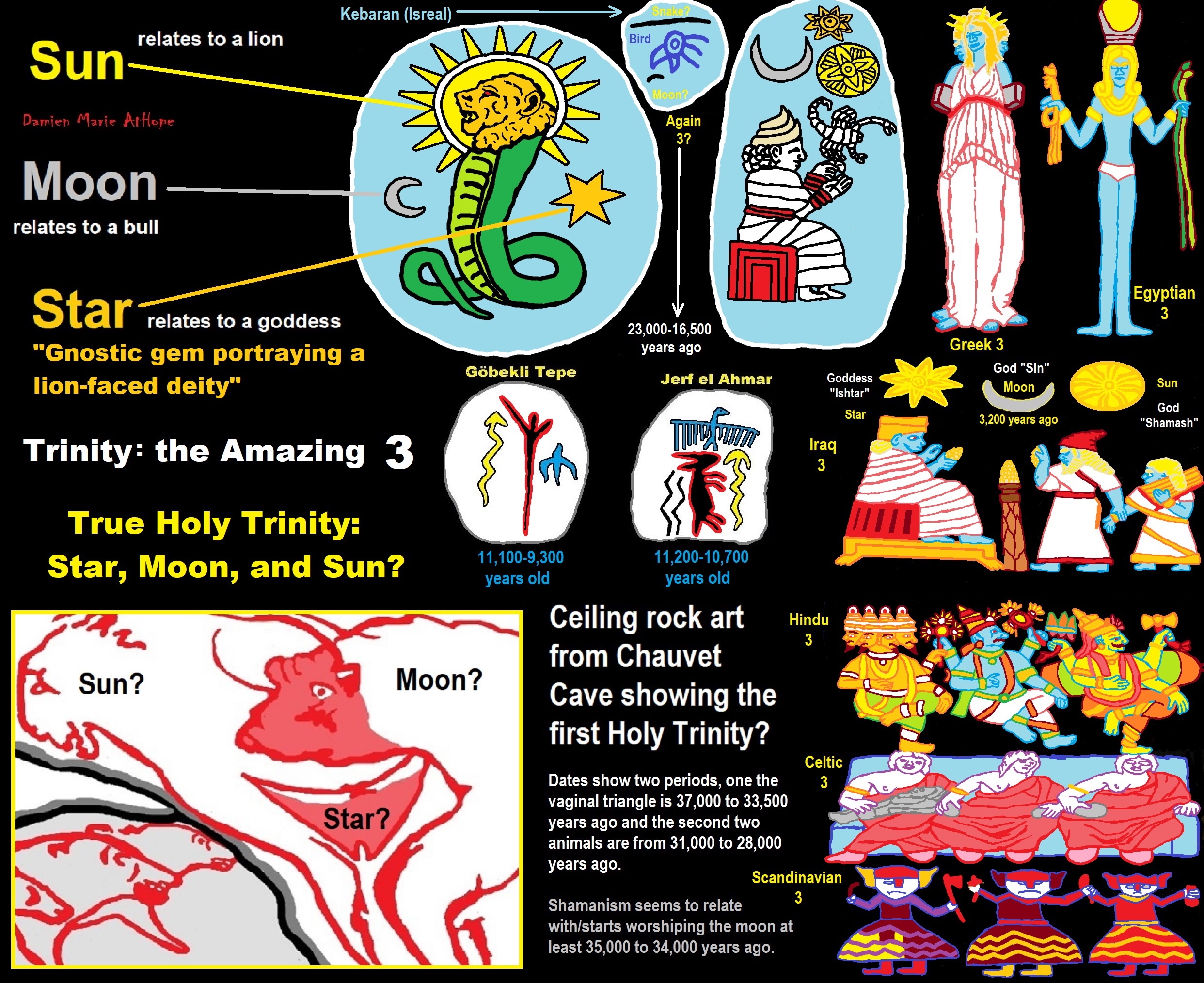
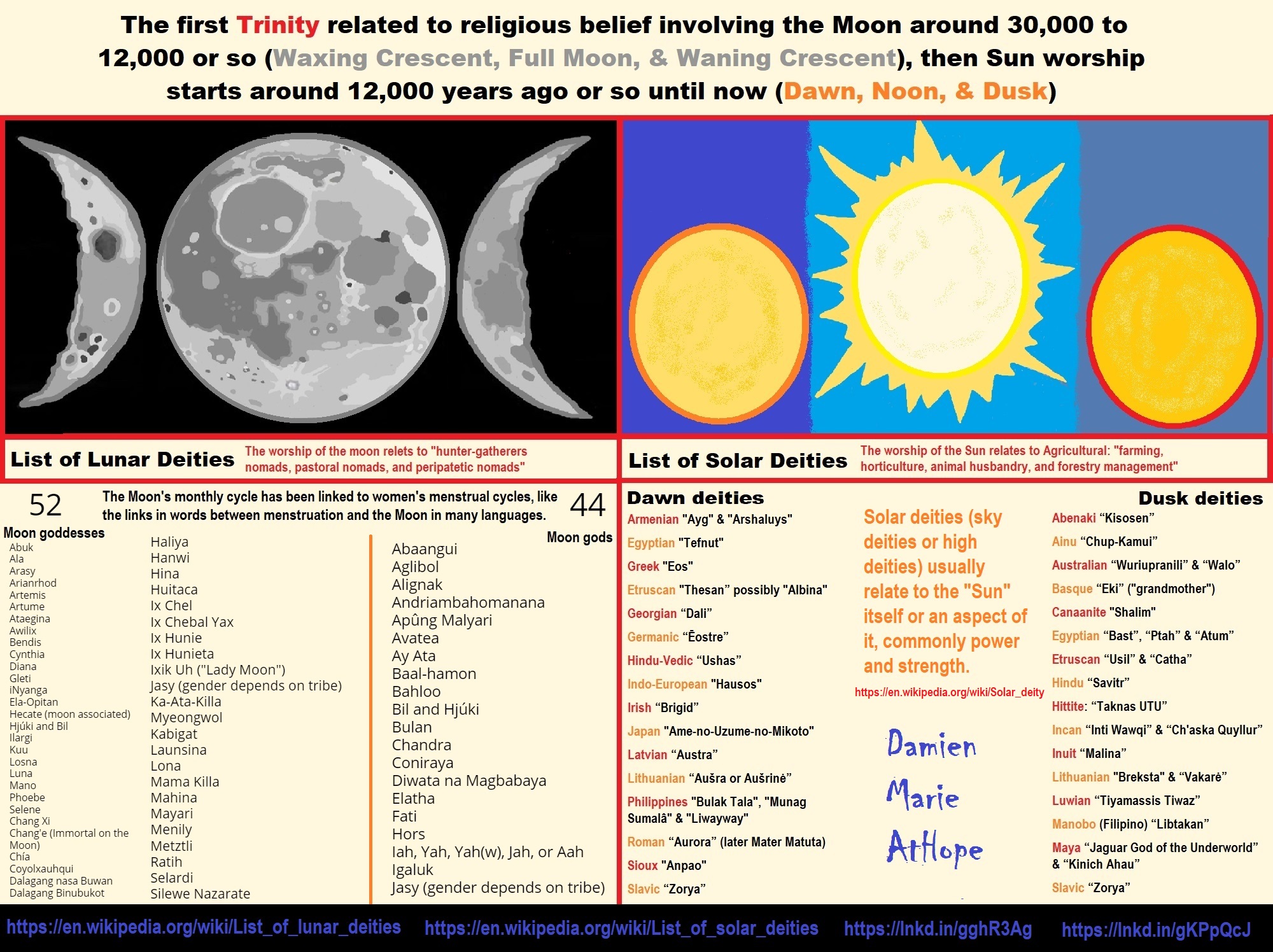

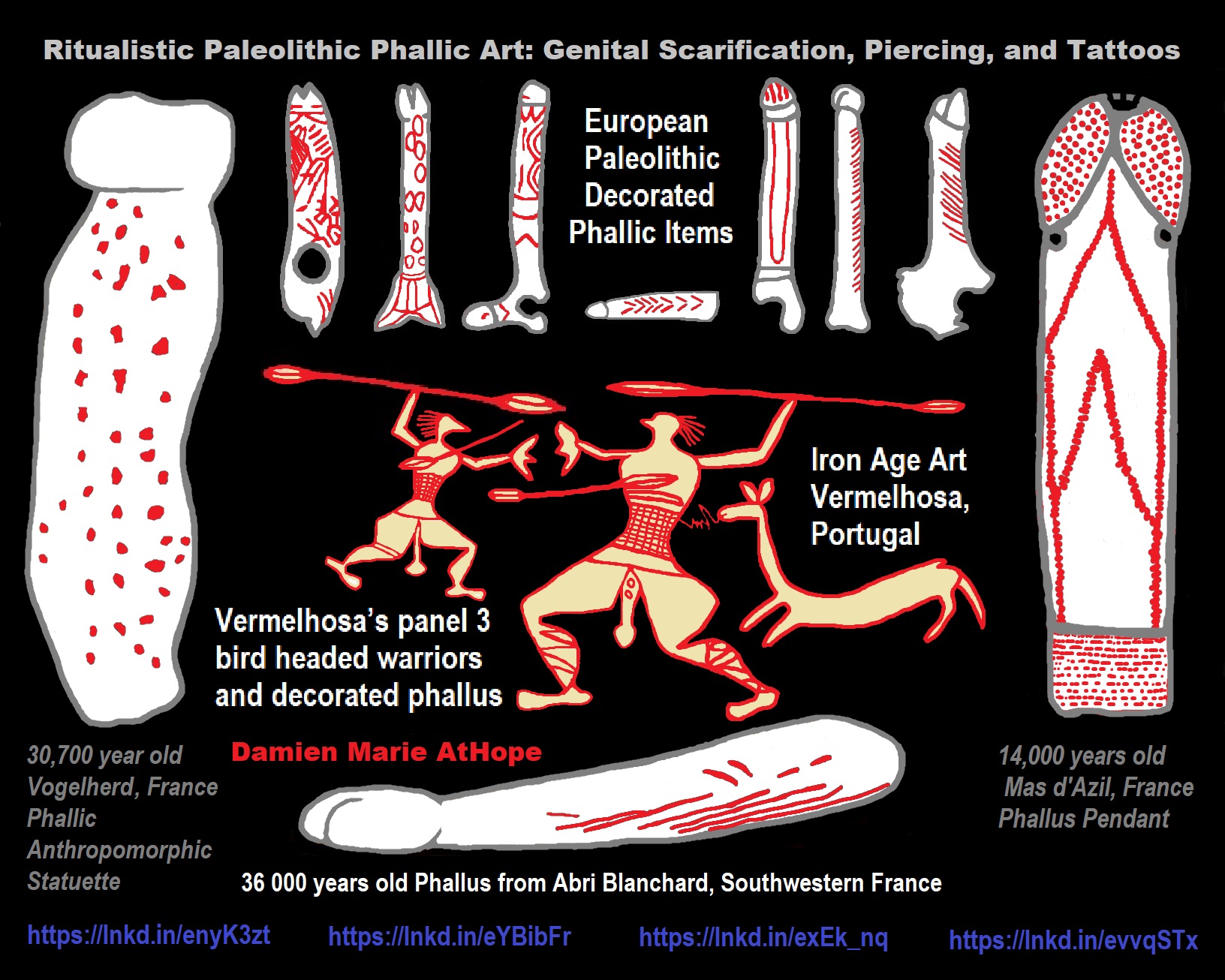

34,000 years ago Lunar Calendar Cave art around the Time Shift From Totemism to Early Shamanism?
“The Oldest Lunar Calendars and Earliest Constellations have been identified in cave art found in France and Germany. The astronomer-priests of these late Upper Paleolithic Cultures understood mathematical sets, and the interplay between the moon annual cycle, ecliptic, solstice and seasonal changes on earth. The archaeological record’s earliest data that speaks to human awareness of the stars and ‘heavens’ dates to the Aurignacian Culture of Europe, around 34,000 years ago. Between 1964 and the early 1990s, Alexander Marshack published breakthrough research that documented the mathematical and astronomical knowledge in the Late Upper Paleolithic Cultures of Europe. Marshack deciphered sets of marks carved into animal bones, and occasionally on the walls of caves, as records of the lunar cycle. These marks are sets of crescents or lines. Artisans carefully controlled line thickness so that a correlation with lunar phases would be as easy as possible to perceive. Sets of marks were often laid out in a serpentine pattern that suggests a snake deity or streams and rivers. Many of these lunar calendars were made on small pieces of stone, bone or antler so that they could be easily carried. These small, portable, lightweight lunar calendars were easily carried on extended journeys such as long hunting trips and seasonal migrations.” ref
“Hunting the largest animals was arduous, and might require hunters to follow herds of horses, bison, mammoth or ibex for many weeks. (Other big animals such as the auroch, cave bear and cave lion were well known but rarely hunted for food because they had a special status in the mythic realm. The Auroch is very important to the search for earliest constellations.) The phases of the moon depicted in these sets of marks are inexact. Precision was impossible unless all nights were perfectly clear which is an unrealistic expectation. The arithmetic counting skill implied by these small lunar calendars is obvious. The recognition that there are phases of the moon and seasons of the year that can be counted – that should be counted because they are important – is profound. “All animal activities are time factored, simply because time passes, the future is forever arriving. The reality of time factoring is objective physics and does not depend upon human awareness or consciousness. Until Marshack’s work, many archeologists believed the sets of marks he chose to study were nothing but the aimless doodles of bored toolmakers. What Marshack uncovered is the intuitive discovery of mathematical sets and the application of those sets to the construction of a calendar.” Bone is the preferred medium because it allows for easy transport and a long calendar lifetime. Mankind’s earliest astronomy brought the clan into the multi-dimensional universe of the gods. Objects used in the most potent rituals had the highest contextual, cultural value and were treated with great reverence.” ref
“Regarding the Aurignacian, between 43,000 and 35,000 years ago, the archaeological record from habitations is relatively poor in the Ardèche (Abri des Pécheurs, Grotte du Figuier) while appearing more abundant in the Languedoc (La Salpétrière, La Balauzière, Esquicho-Grapaou, La Laouza etc.). The same applies to the sites of the early phases of the Gravettian. During climatic fluctuations, and unlike the deep caves such as Chauvet, the porch and shelter fills seem to have better recorded the cold episodes than the humid phases. To date, 20 decorated caves are indexed in the gorges of the Ardèche and nearby; in other words as far as the valley of the Gardon (Baume-Latrone). This group includes several important caves (Ebbou, Oulen, Émilie etc.) which are not precisely dated and were judged to be of secondary importance until the discovery of the Chauvet Cave.” ref
“A 10,000-year-old engraved stone could be a lunar calendar. The rare pebble — found high up in the mountains near Rome, Italy, the hammer-stone was found on top of Monte Alta in the Alban Hills. It’s believed that our early ancestors would’ve used the stone to keep track of the moon’s cycles. Notches were engraved “as if they were being used to count, calculate or store the record of some kind of information. And these notches — which total either 27 or 28 — suggest the stone’s engraver used the pebble to track lunar cycles.” ref
“Archaeologists excavating in Scotland found a series of huge pits were dug by Mesolithic people to track the cycle of the Moon. They found a series of twelve huge, specially shaped pits designed to mimic the various phases of the Moon. The holes aligned perfectly on the midwinter solstice to help the hunter-gathers of Mesolithic Britain keep precise track of the passage of the seasons and the lunar cycle. The holes were dug in the shapes of various phases of the moon. “Waxing, waning, crescents, and gibbous, they’re all there and arranged in a 50-meter-long (164-foot) arc. The one representing the full moon is large and circular, approximately two meters (roughly seven feet) across, and placed right in the center. And this arc is arranged perfectly with a notch in the landscape where the sun would have risen on the day of the midwinter solstice about 10,000 years ago. Placing their calendar in the landscape the way they did would have let the people who built it to recalibrate the lunar months every winter to bring their lunar calendar in line with the solar year. This means that any effort to keep track of the seasons using the moon alone will slowly drift ever further from true. An observer needs to know when to add or subtract an extra month to make good the time or hit the reset button and start counting again.” ref
“A moon-shaped calendar was found in Smederevska Palanka, Serbia that dates back 8,000 years, and is made from a wild boar’s tusk engraved with markings to denote a lunar cycle. Farmers may have used the device to plan when to plant crops. It is made from the tusk of a wild boar and is marked with engravings thought to denote a lunar cycle of 28 days, as well as the four phases of the moon.” ref
“A lunisolar calendar was found at Warren Field in Scotland and has been dated to c. 8000 BCE, during the Mesolithic period. Some scholars argue for lunar calendars still earlier—Rappenglück in the marks on a c. 17,000-year-old cave painting at Lascaux and Marshack in the marks on a c. 27,000-year-old bone baton—but their findings remain controversial. Scholars have argued that ancient hunters conducted regular astronomical observations of the Moon back in the Upper Palaeolithic. Samuel L. Macey dates the earliest uses of the Moon as a time-measuring device back to 28,000–30,000 years ago.” ref
“A lunar calendar is a calendar based on the monthly cycles of the Moon‘s phases (synodic months, lunations), in contrast to solar calendars, whose annual cycles are based only directly on the solar year. The most commonly used calendar, the Gregorian calendar, is a solar calendar system that originally evolved out of a lunar calendar system. A purely lunar calendar is also distinguished from a lunisolar calendar, whose lunar months are brought into alignment with the solar year through some process of intercalation. The details of when months begin varies from calendar to calendar, with some using new, full, or crescent moons and others employing detailed calculations.” ref
“Since each lunation is approximately 29+1⁄2 days, it is common for the months of a lunar calendar to alternate between 29 and 30 days. Since the period of 12 such lunations, a lunar year, is 354 days, 8 hours, 48 minutes, 34 seconds (354.36707 days), purely lunar calendars are 11 to 12 days shorter than the solar year. In purely lunar calendars, which do not make use of intercalation, like the Islamic calendar, the lunar months cycle through all the seasons of a solar year over the course of a 33–34 lunar-year cycle.” ref
“Although the Gregorian calendar is in common and legal use in most countries, traditional lunar and lunisolar calendars continue to be used throughout the world to determine religious festivals and national holidays. Such holidays include Rosh Hashanah (Hebrew calendar); Easter (the Computus); the Chinese, Korean, Vietnamese, and Mongolian New Year (Chinese, Korean, Vietnamese, and Mongolian calendars, respectively); the Nepali New Year (Nepali calendar); the Mid-Autumn Festival and Chuseok (Chinese and Korean calendars); Loi Krathong (Thai calendar); Sunuwar calendar; Vesak/Buddha’s Birthday (Buddhist calendar); Diwali (Hindu calendars); Ramadan, Eid al-Fitr and Eid al-Adha (Islamic calendar).” ref
“The Japanese Calendar formerly used both the lunar and lunisolar calendar before it was replaced by the Gregorian Calendar during the Meiji government in 1872. Holidays such as the Japanese New Year were simply transposed on top as opposed to being calculated like other countries that use the lunisolar and Gregorian calendars together, for example, the Japanese New Year now falls on January 1, creating a month delay as opposed to other East Asian Countries. See customary issues in modern Japan.” ref
“Most calendars referred to as “lunar” calendars are in fact lunisolar calendars. Their months are based on observations of the lunar cycle, with intercalation being used to bring them into general agreement with the solar year. The solar “civic calendar” that was used in ancient Egypt showed traces of its origin in the earlier lunar calendar, which continued to be used alongside it for religious and agricultural purposes. Present-day lunisolar calendars include the Chinese, Vietnamese, Hindu, and Thai calendars.” ref
“Synodic months are 29 or 30 days in length, making a lunar year of 12 months about 11 to 12 days shorter than a solar year. Some lunar calendars do not use intercalation, for example, the lunar Hijri calendar used by most Muslims. For those that do, such as the Hebrew calendar, and Buddhist Calendars in Myanmar, the most common form of intercalation is to add an additional month every second or third year. Some lunisolar calendars are also calibrated by annual natural events which are affected by lunar cycles as well as the solar cycle. An example of this is the lunar calendar of the Banks Islands, which includes three months in which the edible palolo worms mass on the beaches. These events occur at the last quarter of the lunar month, as the reproductive cycle of the palolos is synchronized with the moon.” ref
“Lunar and lunisolar calendars differ as to which day is the first day of the month. In some lunisolar calendars, such as the Chinese calendar, the first day of a month is the day when an astronomical new moon occurs in a particular time zone. In others, such as some Hindu calendars, each month begins on the day after the full moon. Others are based on the first sighting of the lunar crescent, such as the lunar Hijri calendar (and, historically, the Hebrew calendar).” ref
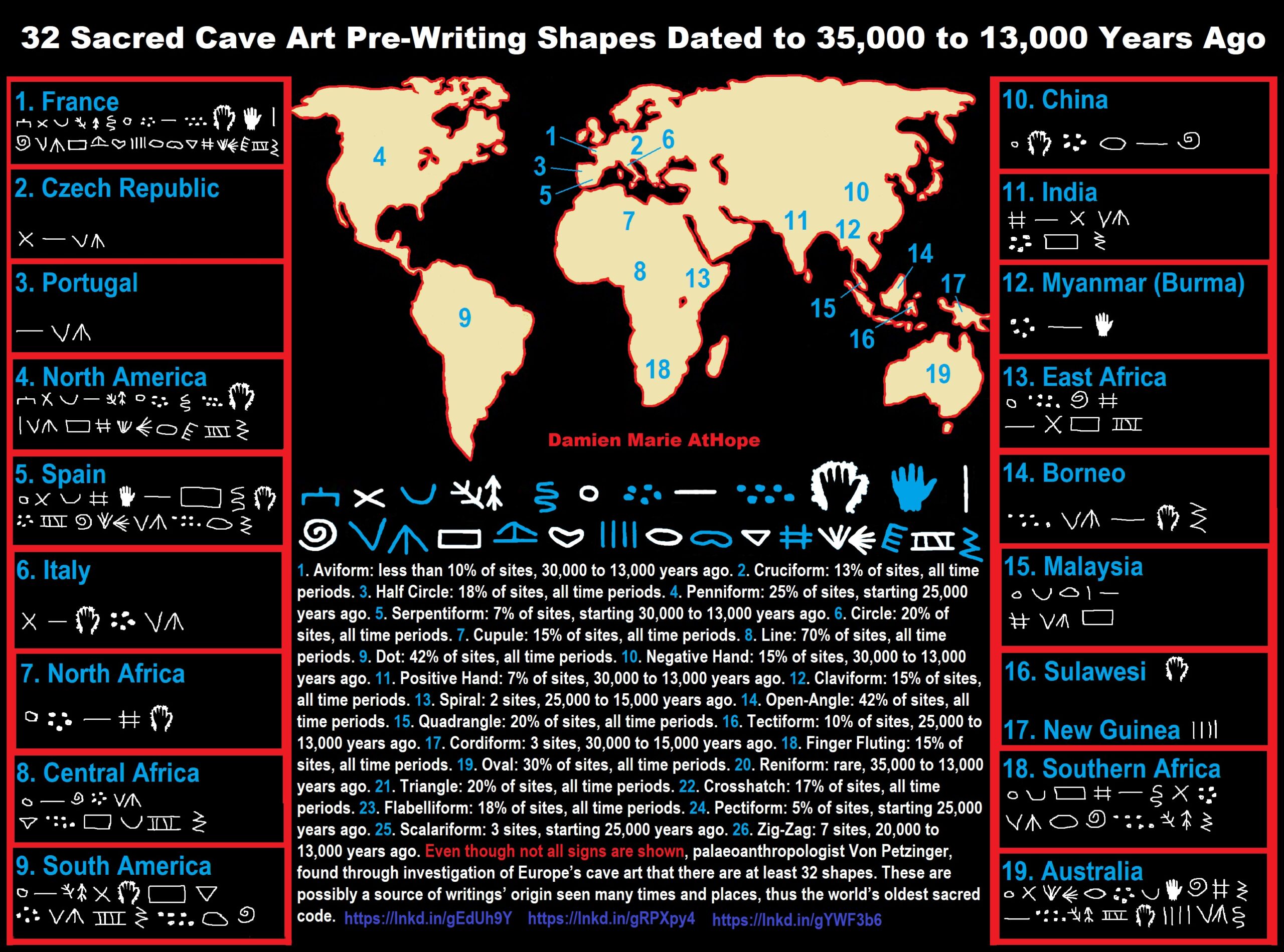
Why are these 32 symbols found in caves all over Europe
32 Sacred Cave Art Pre-Writing Shapes Dated to 35,000 to 13,000 Years Ago
- 1. Aviform: less than 10% of sites, 30,000 to 13,000 years ago.
- 2. Cruciform: 13% of sites, all time periods.
- 3. Half Circle: 18% of sites, all time periods.
- 4. Penniform: 25% of sites, starting 25,000 years ago.
- 5. Serpentiform: 7% of sites, starting 30,000 to 13,000 years ago.
- 6. Circle: 20% of sites, all time periods.
- 7. Cupule: 15% of sites, all time periods.
- 8. Line: 70% of sites, all time periods.
- 9. Dot: 42% of sites, all time periods.
- 10. Negative Hand: 15% of sites, 30,000 to 13,000 years ago.
- 11. Positive Hand: 7% of sites, 30,000 to 13,000 years ago.
- 12. Claviform: 15% of sites, all time periods.
- 13. Spiral: 2 sites, 25,000 to 15,000 years ago.
- 14. Open-Angle: 42% of sites, all time periods.
- 15. Quadrangle: 20% of sites, all time periods.
- 16. Tectiform: 10% of sites, 25,000 to 13,000 years ago.
- 17. Cordiform: 3 sites, 30,000 to 15,000 years ago.
- 18. Finger Fluting: 15% of sites, all time periods.
- 19. Oval: 30% of sites, all time periods.
- 20. Reniform: rare, 35,000 to 13,000 years ago.
- 21. Triangle: 20% of sites, all time periods.
- 22. Crosshatch: 17% of sites, all time periods.
- 23. Flabelliform: 18% of sites, all time periods.
- 24. Pectiform: 5% of sites, starting 25,000 years ago.
- 25. Scalariform: 3 sites, starting 25,000 years ago.
- 26. Zig-Zag: 7 sites, 20,000 to 13,000 years ago.
Even though not all signs are shown, palaeoanthropologist Von Petzinger, found through investigation of Europe’s cave art that there are at least 32 shapes. These are possibly a source of writings’ origin seen many times and places, thus the world’s oldest sacred code. A paleoanthropologist and rock art researcher explains that even though to many written language is the hallmark of human civilization, this construct in behavior didn’t just suddenly appear one day. Thousands of years before the first fully developed writing systems, our ancestors scrawled geometric signs across the walls of the caves they sheltered in. She has studied and codified these ancient markings in caves across Europe, suggesting that graphic communication, and the ability to preserve and transmit messages beyond a single moment in time, may be much older than we think. ref, ref, ref, ref


ref, ref, ref, ref, ref, ref, ref, ref, ref, ref, ref, ref, ref, ref
- Kebaran culture 23,022-16,522 Years Ago, 2. Kortik Tepe 12,422-11,722 Years Ago, 3. Jerf el-Ahmar 11,222 -10,722 Years Ago, 4. Gobekli Tepe 11,152-9,392 Years Ago, 5. Tell Al-‘abrUbaid and Uruk Periods, 6. Nevali Cori 10,422 -10,122 Years Ago, 7. Catal Hoyuk 9,522-7,722 Years Ago
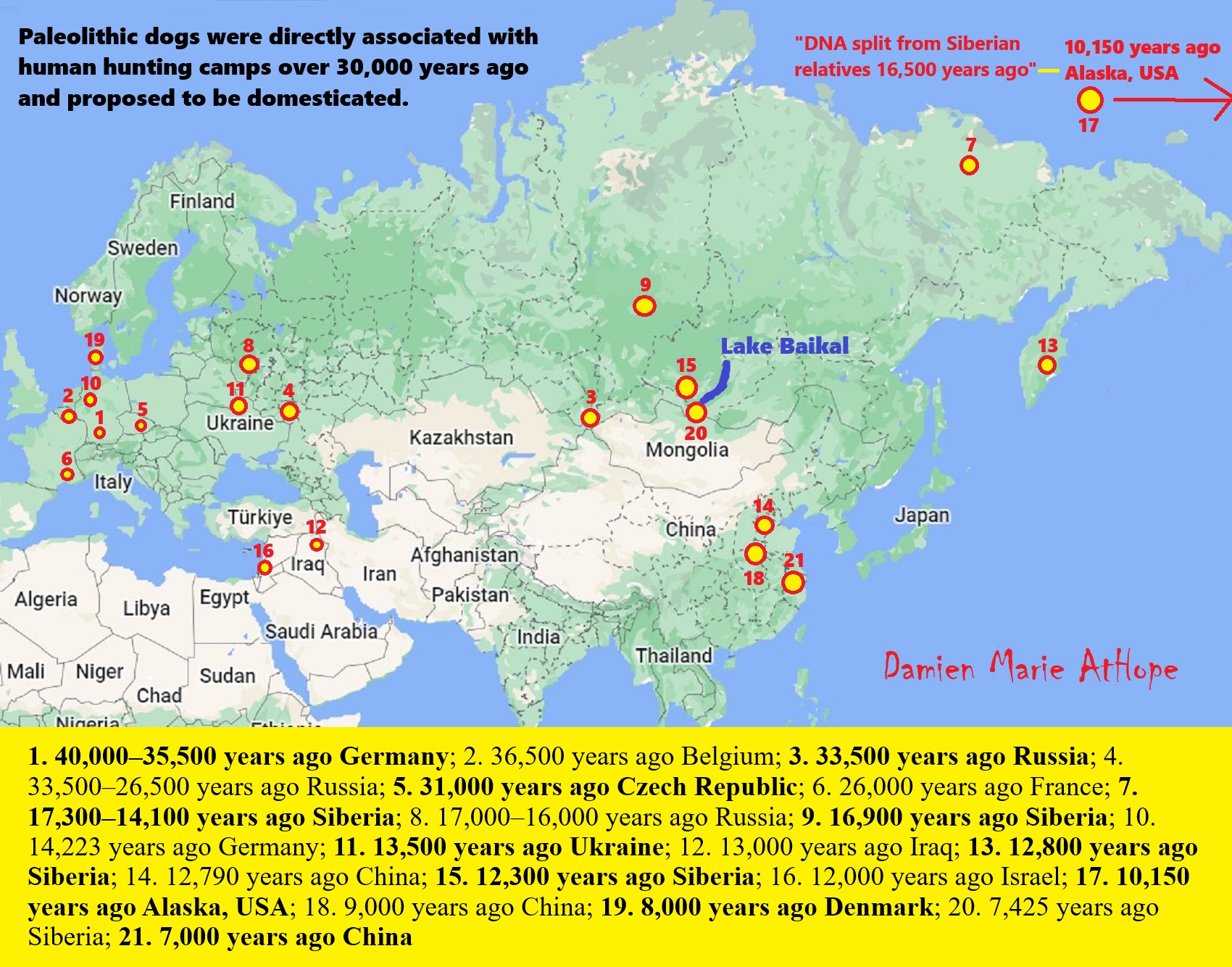
“The Paleolithic dog was a Late Pleistocene canine. They were directly associated with human hunting camps in Europe over 30,000 years ago and it is proposed that these were domesticated. They are further proposed to be either a proto-dog and the ancestor of the domestic dog or an extinct, morphologically and genetically divergent wolf population. There are a number of recently discovered specimens which are proposed as being Paleolithic dogs, however, their taxonomy is debated. These have been found in either Europe or Siberia and date 40,000–17,000 years ago. They include Hohle Fels in Germany, Goyet Caves in Belgium, Predmosti in the Czech Republic, and four sites in Russia: Razboinichya Cave in the Altai Republic, Kostyonki-8, Ulakhan Sular in the Sakha Republic, and Eliseevichi 1 on the Russian plain.” ref
- 40,000–35,500 years ago Hohle Fels, Schelklingen,Germany
2. 36,500 years ago Goyet Caves,Samson River Valley, Belgium
3. 33,500 years ago Razboinichya Cave, Altai Mountains, (Russia/Siberia)
4. 33,500–26,500 years ago Kostyonki-Borshchyovo archaeological complex, (Kostenki site) Voronezh, Russia
5. 31,000 years ago Predmostí, Moravia, Czech Republic
6. 26,000 years ago Chauvet Cave, Vallon-Pont-d’Arc, Ardèche region, France
7. 17,300–14,100 years ago Dyuktai Cave, northern Yakutia, Siberia
8. 17,000–16,000 years ago Eliseevichi-I site, Bryansk Region, Russian Plain, Russia
9. 16,900 years ago Afontova Gora-1, Yenisei River, southern Siberia
10. 14,223 years ago Bonn–Oberkassel, Germany
11. 13,500 years ago Mezine, Chernigov region, Ukraine
12. 13,000 years ago Palegawra, (Zarzian culture) Iraq
13. 12,800 years ago Ushki I, Kamchatka, eastern Siberia
14. 12,790 years ago Nanzhuangtou, China
15. 12,300 years ago Ust’-Khaita site, Baikal region, Siberia
16. 12,000 years ago Ain Mallaha (Eynan) and HaYonim terrace, Israel
17. 10,150 years ago Lawyer’s Cave, Alaska, USA
18. 9,000 years ago Jiahu site, China
19. 8,000 years ago Svaerdborg site, Denmark
20. 7,425 years ago Lake Baikal region, Siberia
21. 7,000 years ago Tianluoshan archaeological site, Zhejiang province, China ref
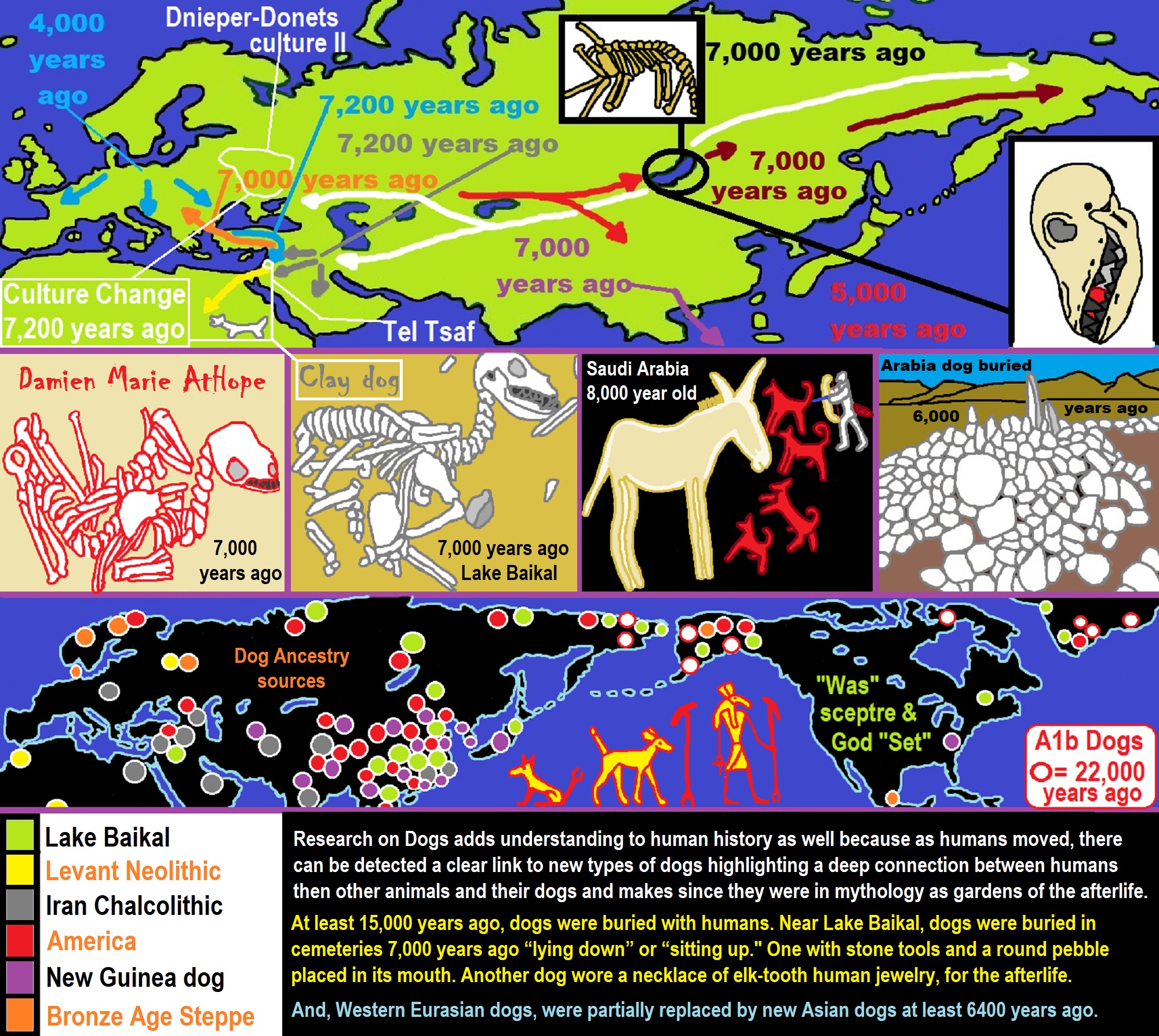


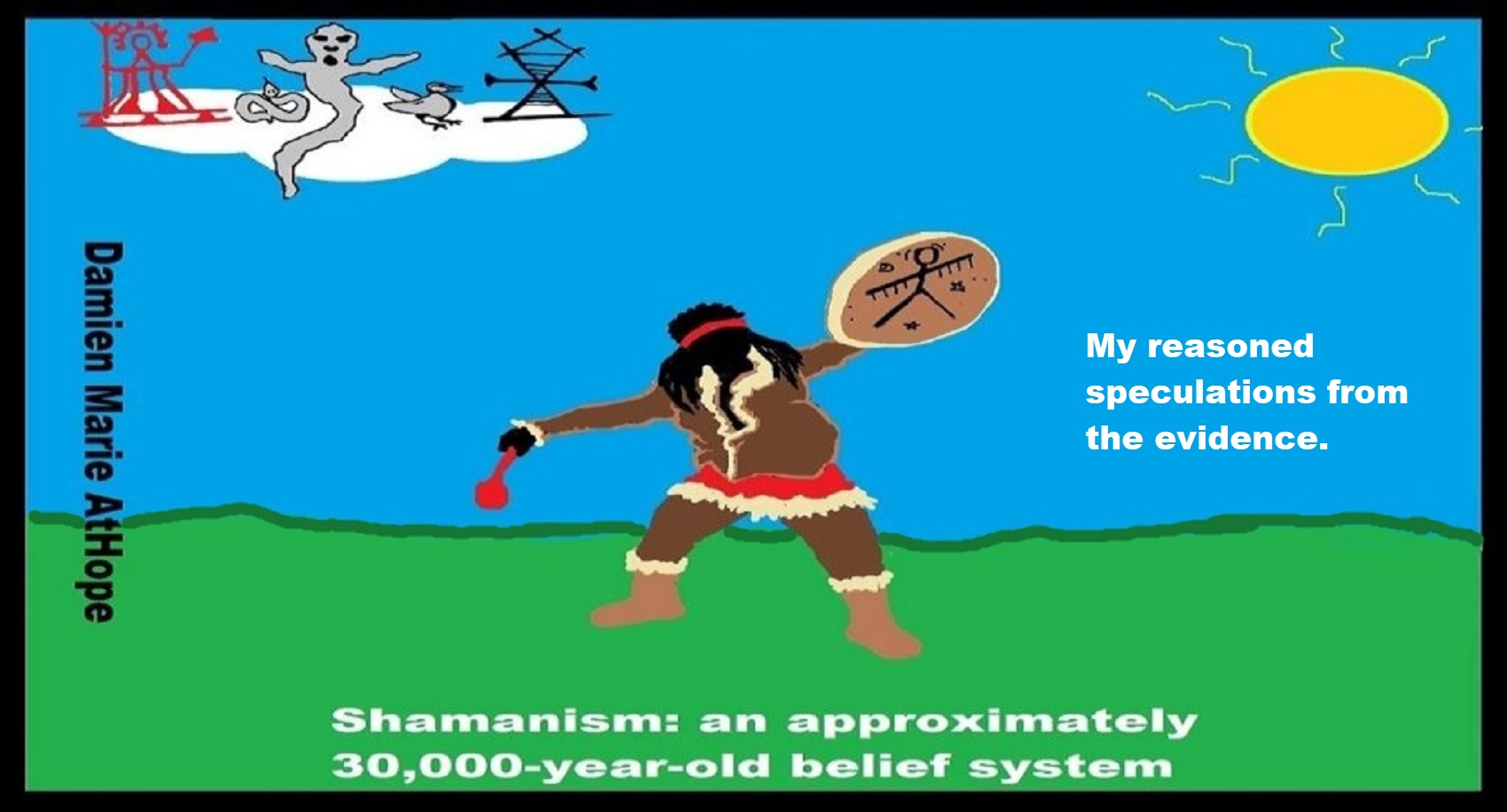
Shamanism (such as that seen in Siberia Gravettian culture: 30,000 years ago)
- Gravettian culture (34,000–24,000 years ago; Western Gravettian, mainly France, Spain, and Britain, as well as Eastern Gravettian in Central Europe and Russia. The eastern Gravettians, which include the Pavlovian culture)
- Pavlovian culture (31,000 – 25,000 years ago such as in Austria and Poland)
- Prehistoric Child Burials Begin Around 34,000 Years Ago
- Early Shamanism around 34,000 to 20,000 years ago: Sungar (Russia) and Dolni Vestonice (Czech Republic)
- 31,000 – 20,000 years ago Oldest Shaman was Female, Buried with the Oldest Portrait Carving
- Shamanism: an approximately 30,000-year-old belief system
- ‘Sky Burial’ theory and its possible origins at least 12,000 years ago to likely 30,000 years ago or older.
- The Peopling of the Americas Pre-Paleoindians/Paleoamericans around 30,000 to 12,000 years ago
- Similarity in Shamanism?
- Black, White, and Yellow Shamanism?
- Possible Clan Leader/Special “MALE” Ancestor Totem Poles At Least 13,500 years ago?
- Fertile Crescent 12,500 – 9,500 Years Ago: fertility and death cult belief system?
- 12,400 – 11,700 Years Ago – Kortik Tepe (Turkey) Pre/early-Agriculture Cultic Ritualism
- Horned female shamans and Pre-satanism Devil/horned-god Worship? at least 10,000 years ago.
- Shamanistic rock art 8,000 and 10,000 years ago from central Aboriginal Siberians and Aboriginal drums in the Americas.
Shamanism is approximately a 30,000-year-old belief system and believe in spirit-filled life and/or afterlife that can be attached to or be expressed in things or objects and these objects can be used by special persons or in special rituals that can connect to spirit-filled life and/or afterlife. If you believe like this, regardless of your faith, you are a hidden shamanist.
Around 29,000 to 25,000 years ago in Dolní Vestonice, Czech Republic, the oldest human face representation is a carved ivory female head that was found nearby a female burial and belong to the Pavlovian culture, a variant of the Gravettian culture. The left side of the figure’s face was a distorted image and is believed to be a portrait of an elder female, who was around 40 years old. She was ritualistically placed beneath a pair of mammoth scapulae, one leaning against the other. Surprisingly, the left side of the skull was disfigured in the same manner as the aforementioned carved ivory figure, indicating that the figure was an intentional depiction of this specific individual. The bones and the earth surrounding the body contained traces of red ocher, a flint spearhead had been placed near the skull, and one hand held the body of a fox. This evidence suggests that this was the burial site of a shaman. This is the oldest site not only of ceramic figurines and artistic portraiture but also of evidence of early female shamans. Before 5,500 years ago, women were much more prominent in religion.
Archaeologists usually describe two regional variants: the western Gravettian, known namely from cave sites in France, Spain, and Britain, and the eastern Gravettian in Central Europe and Russia. The eastern Gravettians include the Pavlovian culture, which were specialized mammoth hunters and whose remains are usually found not in caves but in open air sites. The origins of the Gravettian people are not clear, they seem to appear simultaneously all over Europe. Though they carried distinct genetic signatures, the Gravettians and Aurignacians before them were descended from the same ancient founder population. According to genetic data, 37,000 years ago, all Europeans can be traced back to a single ‘founding population’ that made it through the last ice age. Furthermore, the so-called founding fathers were part of the Aurignacian culture, which was displaced by another group of early humans members of the Gravettian culture. Between 37,000 years ago and 14,000 years ago, different groups of Europeans were descended from a single founder population. To a greater extent than their Aurignacian predecessors, they are known for their Venus figurines. ref, ref, ref, ref, ref, ref, ref, ref, ref, ref, & ref
- “33,000 years ago: oldest known domesticated dog skulls show they existed in both Europe and Siberia by this time.
- 31,000–16,000 years ago: Last Glacial Maximum (peak at 26,500 years ago).
- 30,000 years ago: rock paintings tradition begins in Bhimbetka rock shelters in India, which presented as a collection is the densest known concentration of rock art. In an area about 10 km2, there are about 800 rock shelters of which 500 contain paintings.
- 29,000 years ago: The earliest ovens found.
- 28,500 years ago: New Guinea is populated by colonists from Asia or Australia.
- 28,000 years ago: the oldest known twisted rope.
- 28,000–24,000 years ago: some of the oldest known pottery—used to make figurines rather than cooking or storage vessels (Venus of Dolní Věstonice).
- 28,000–20,000 years ago: Gravettian period in Europe. Harpoons and saws invented.
- 26,000 years ago: people around the world use fibers to make baby carriers, clothes, bags, baskets, and nets.
- 25,000 years ago: a hamlet consisting of huts built of rocks and of mammoth bones is founded in what is now Dolní Věstonice in Moravia in the Czech Republic. This is the oldest human permanent settlement that has yet been found by archaeologists.
- 21,000 years ago: artifacts suggests early human activity occurred in Canberra, the capital city of Australia.
- 20,000 years ago: Kebaran culture in the Levant.
- 20,000 years ago: oldest pottery storage/cooking vessels from China.
- 20,000-10,000 years ago: Khoisanid expansion to Central Africa.
- 16,000-14,000 years ago: Minatogawa Man (Proto-Mongoloid phenotype) in Okinawa, Japan
- 16,000–13,000 years ago: the first colonization of North America.
- 16,000-11,000 years ago: Caucasian Hunter-Gatherer (Caucasoid phenotype) expansion to Europe.
- 16,000 years ago: Wisent sculpted in clay deep inside the cave now known as Le Tuc d’Audoubert in the French Pyrenees near what is now the border of Spain.
- 15,000–14,700 years ago: Earliest supposed date for the domestication of the pig.
- 14,800 years ago: The Humid Period begins in North Africa. The region that would later become the Sahara is wet and fertile, and the aquifers are full.
- 14,500-11,500: Red Deer Cave people in China, possible late survival of archaic or archaic-modern hybrid humans.
- 14,000-12,000 years ago: Oldest evidence for prehistoric warfare (Jebel Sahaba massacre, Natufian culture).
- 13,000–10,000 years ago: Late Glacial Maximum, end of the Last glacial period, climate warms, glaciers recede.
- 13,000 years ago: A major water outbreak occurs on Lake Agassiz, which at the time could have been the size of the current Black Sea and the largest lake on Earth. Much of the lake is drained in the Arctic Ocean through the Mackenzie River.
- 13,000–11,000 years ago: Earliest dates suggested for the domestication of the sheep.
- Approximately 13,000 years ago, the Younger Dryas ice age.” ref
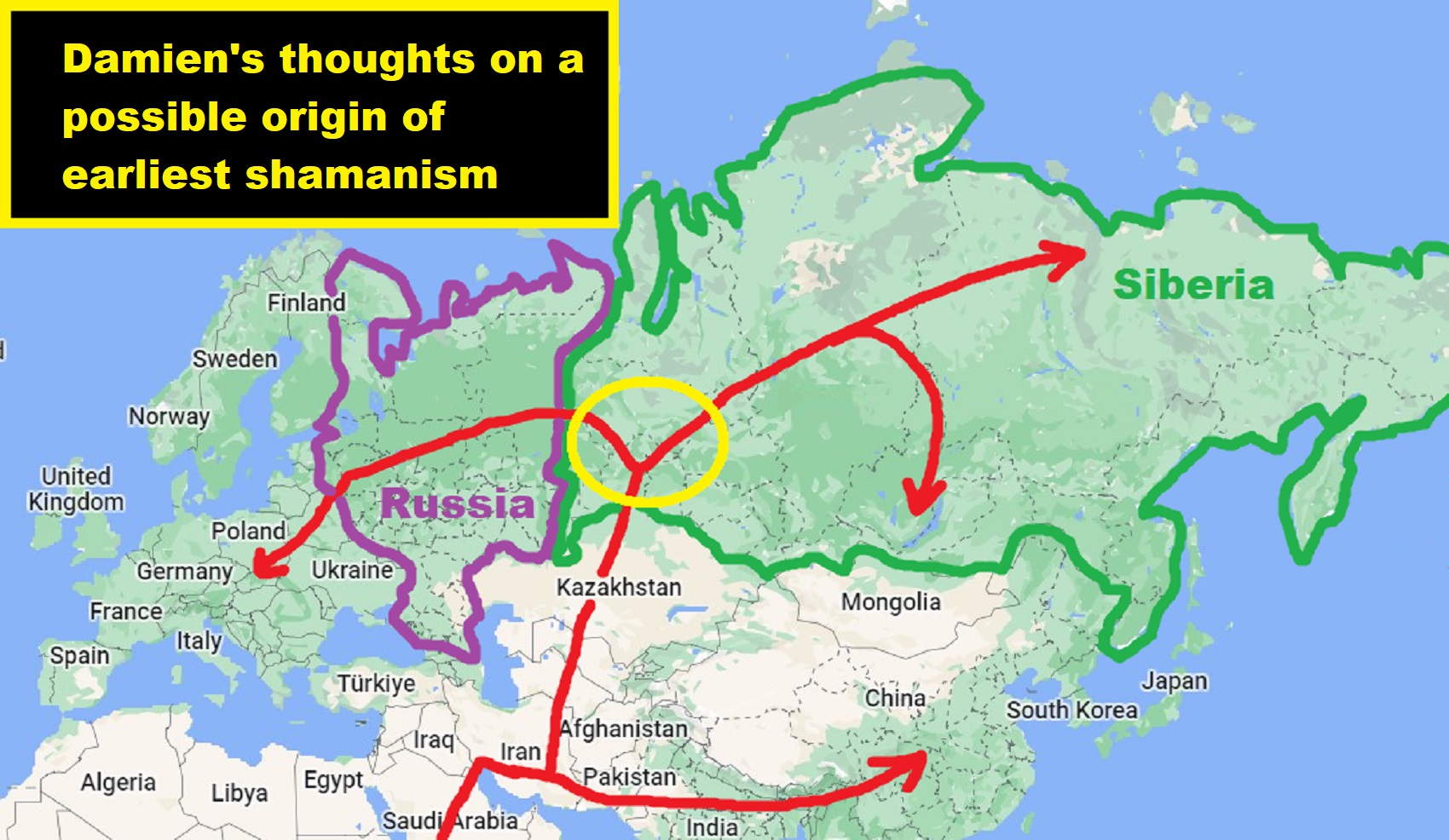
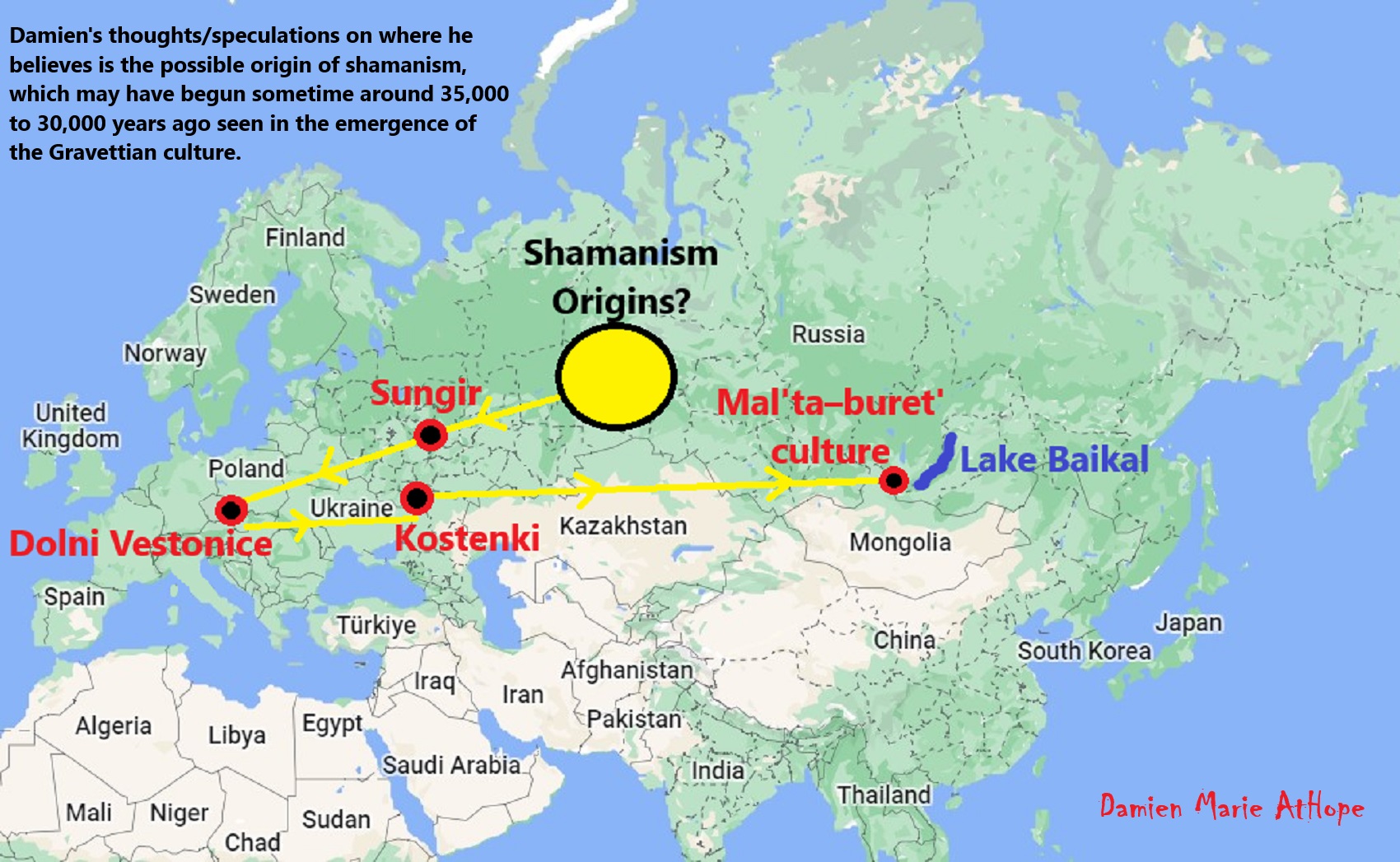
Here are Damien’s thoughts/speculations on where he believes is the possible origin of shamanism, which may have begun sometime around 35,000 to 30,000 years ago seen in the emergence of the Gravettian culture, just to outline his thinking, on what thousands of years later led to evolved Asian shamanism, in general, and thus WU shamanism as well. In both Europe-related “shamanism-possible burials” and in Gravettian mitochondrial DNA is a seeming connection to Haplogroup U. And the first believed Shaman proposed burial belonged to Eastern Gravettians/Pavlovian culture at Dolní Věstonice in southern Moravia in the Czech Republic, which is the oldest permanent human settlement that has ever been found. It is at Dolní Věstonice where approximately 27,000-25,000 years ago a seeming female shaman was buried and also there was an ivory totem portrait figure, seemingly of her.
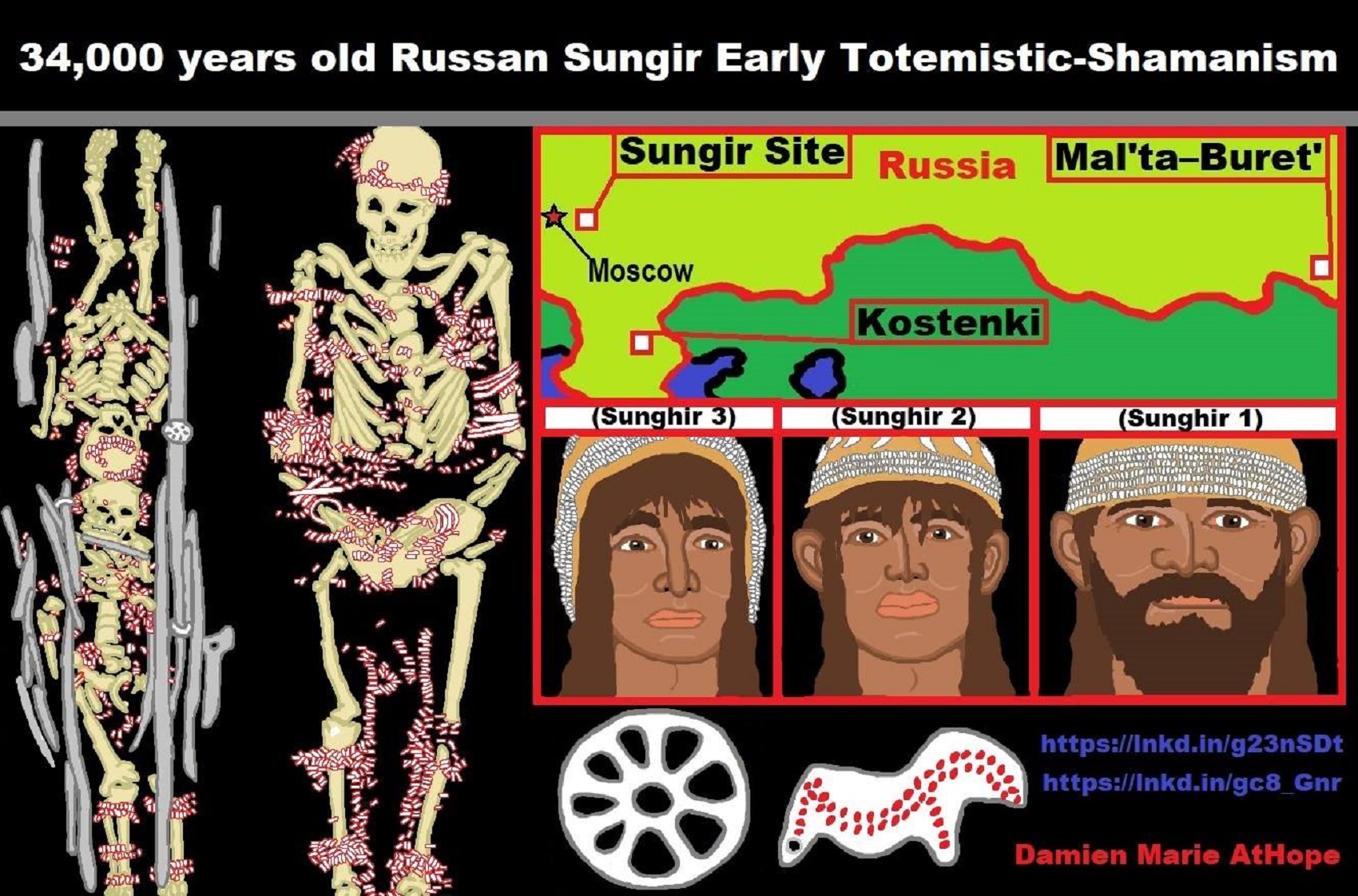
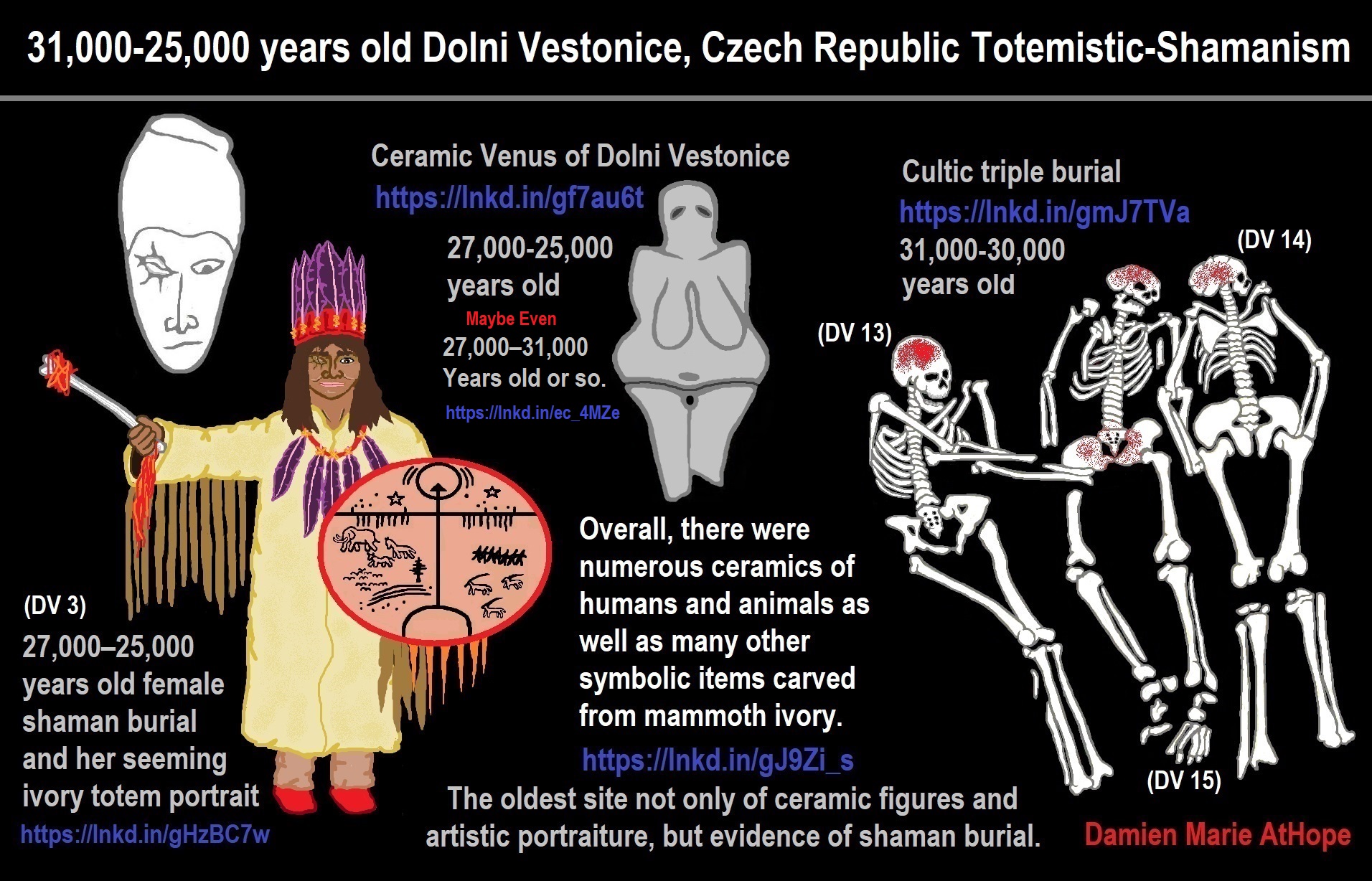
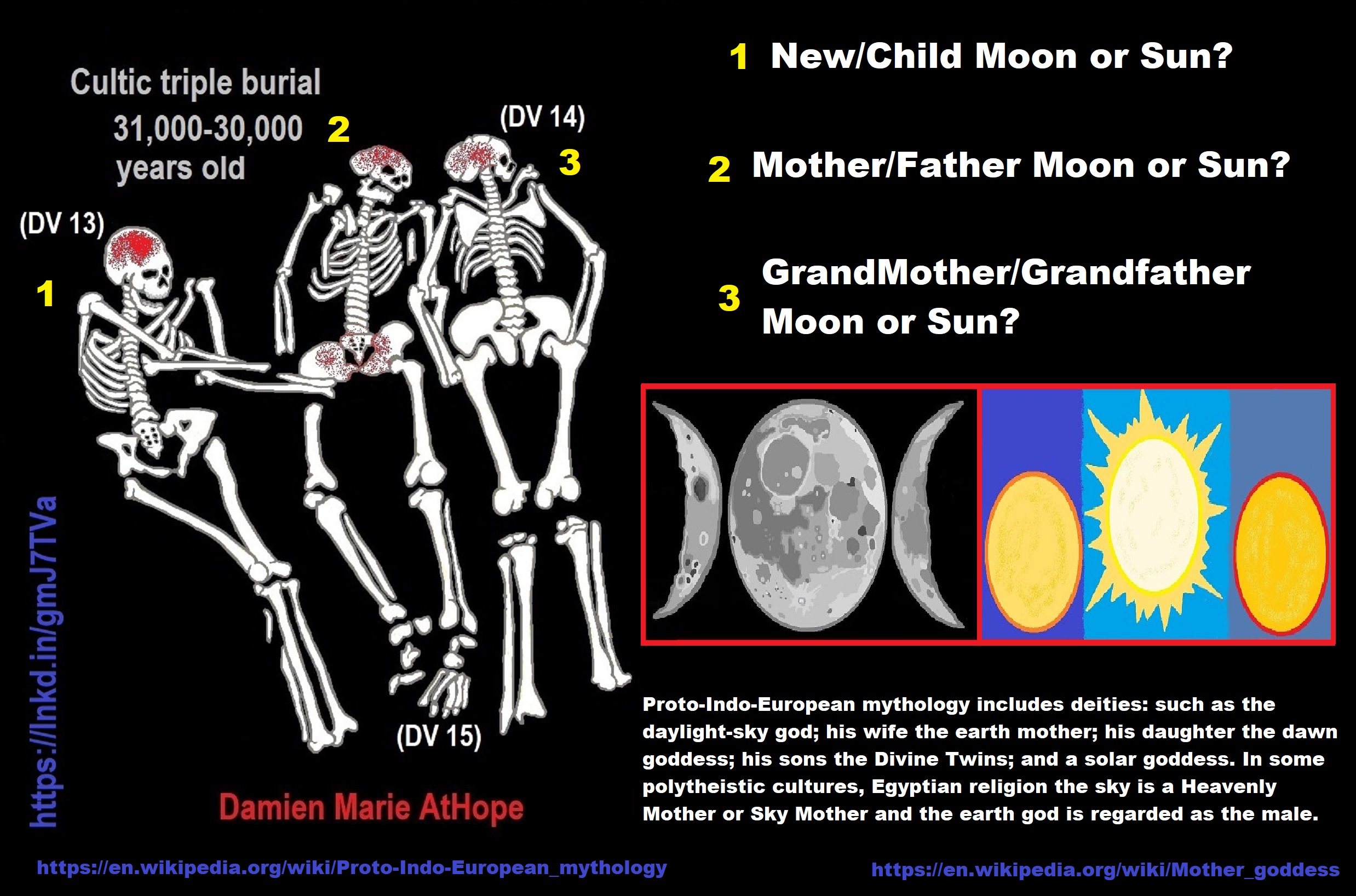


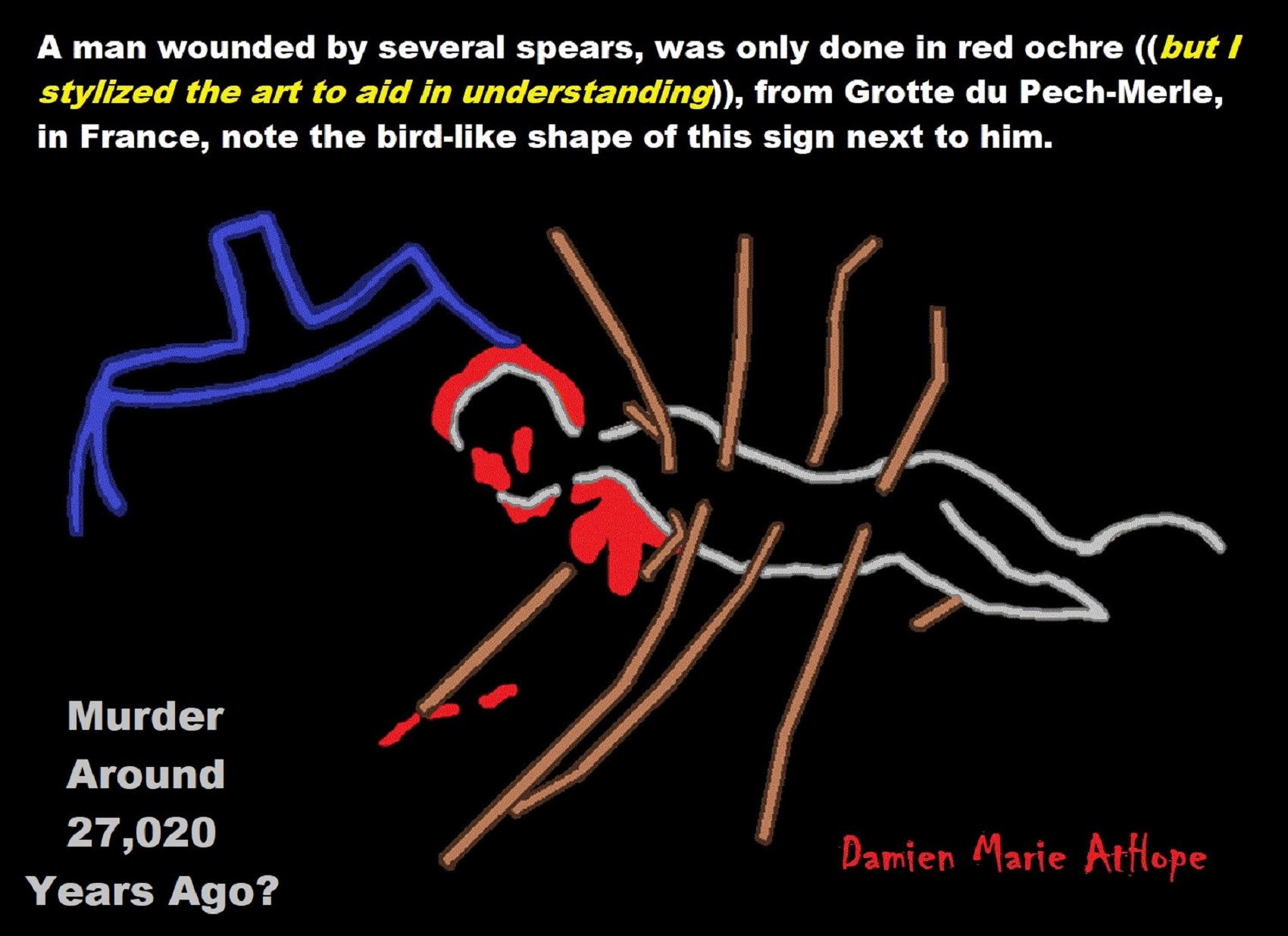

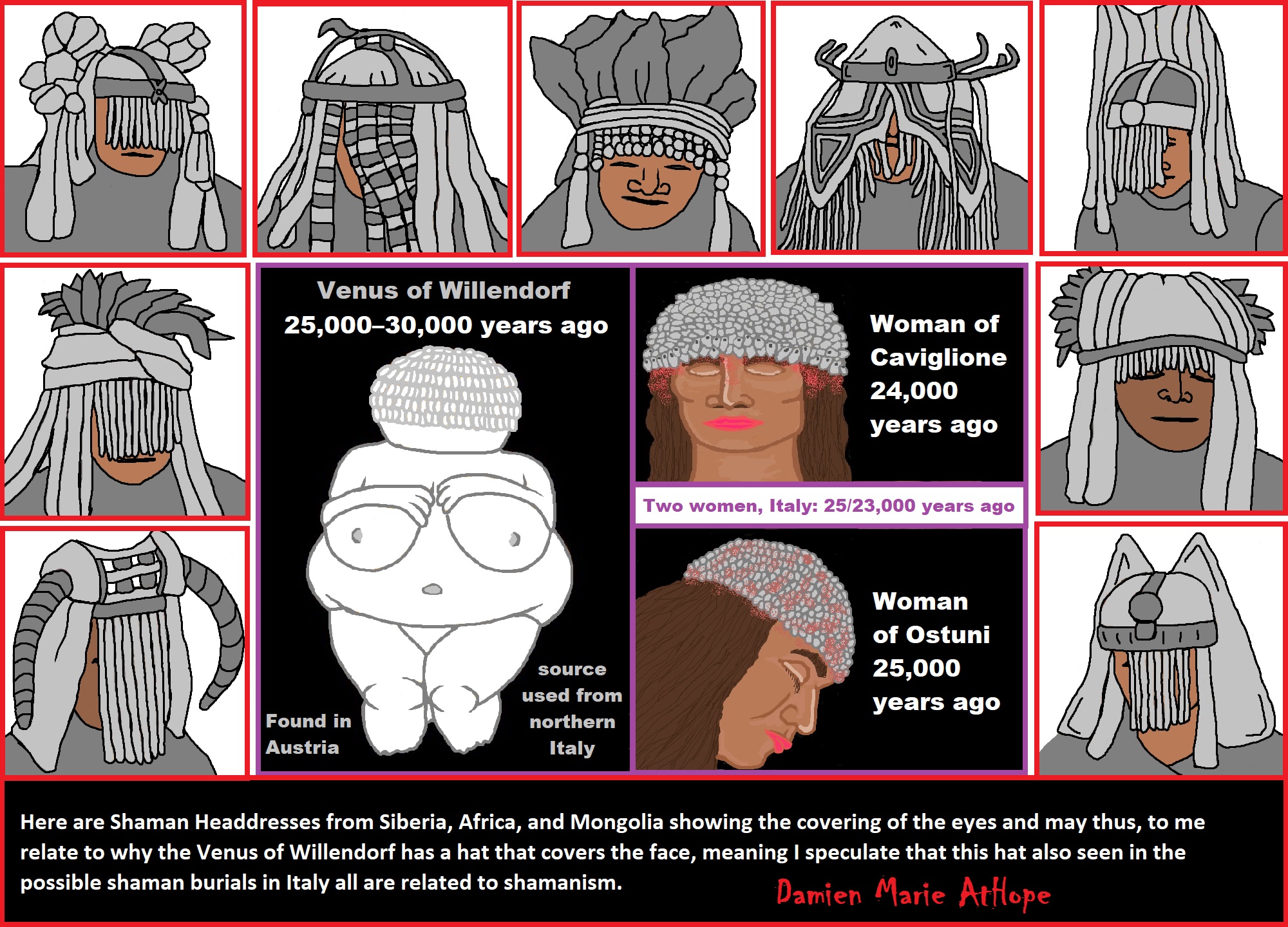
ref, ref, ref, ref, ref, ref, ref, ref, ref, ref, ref, ref, ref, ref, ref
Here are Shaman Headdresses from Siberia, Africa, and Mongolia showing the covering of the eyes and may thus, to me relate to why the Venus of Willendorf has a hat that covers the face, meaning I speculate that this hat, also seen in the possible shaman burials in Italy all are related to shamanism.
“Venus figurines have been unearthed in Europe, Siberia, and much of Eurasia.
Most date from the Gravettian period but start in the Aurignacian era, and lasts to the Magdalenian time.” ref
Venus of Willendorf: Shamanism Headdresses that Cover the Eyes?
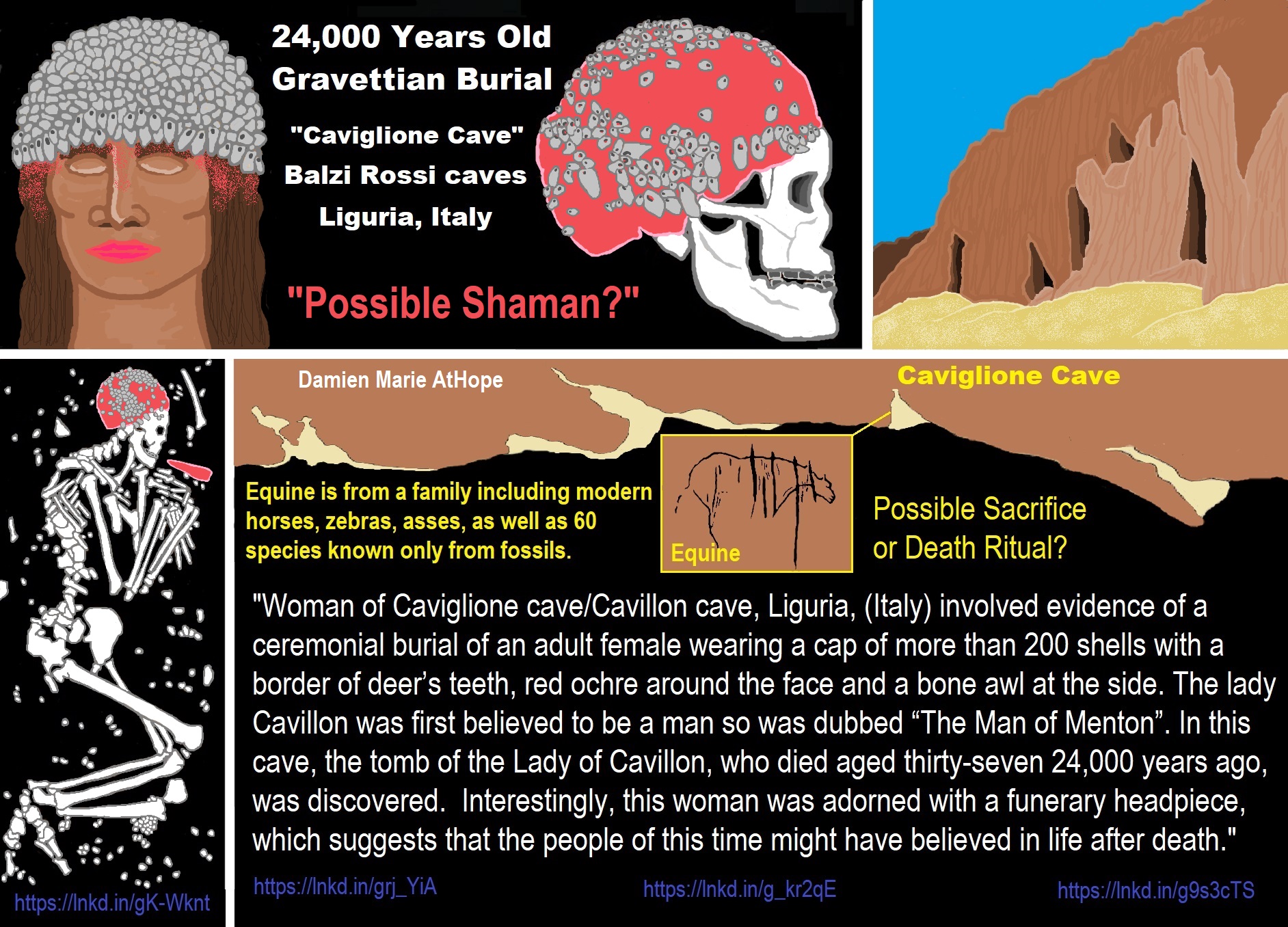

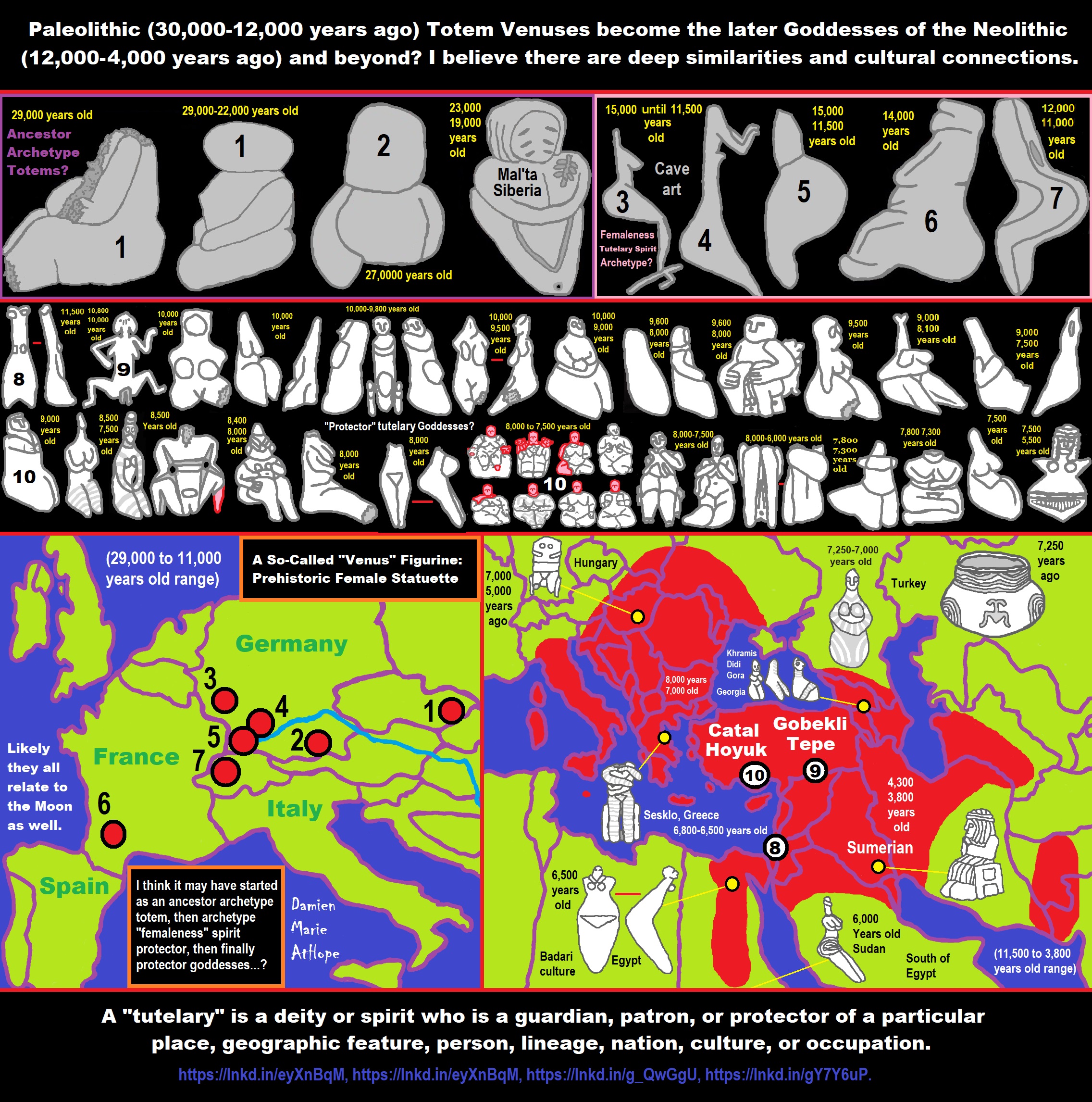
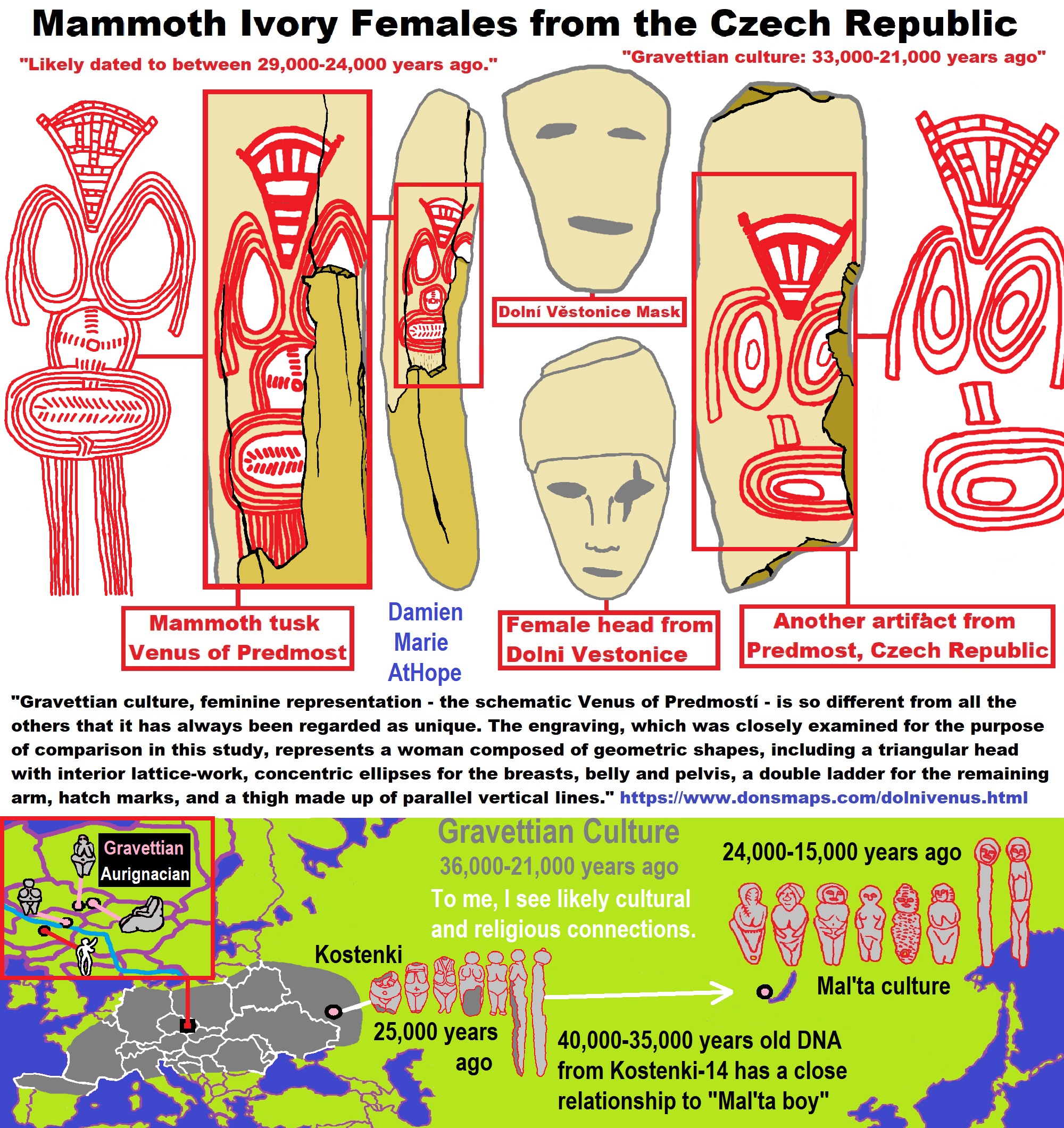
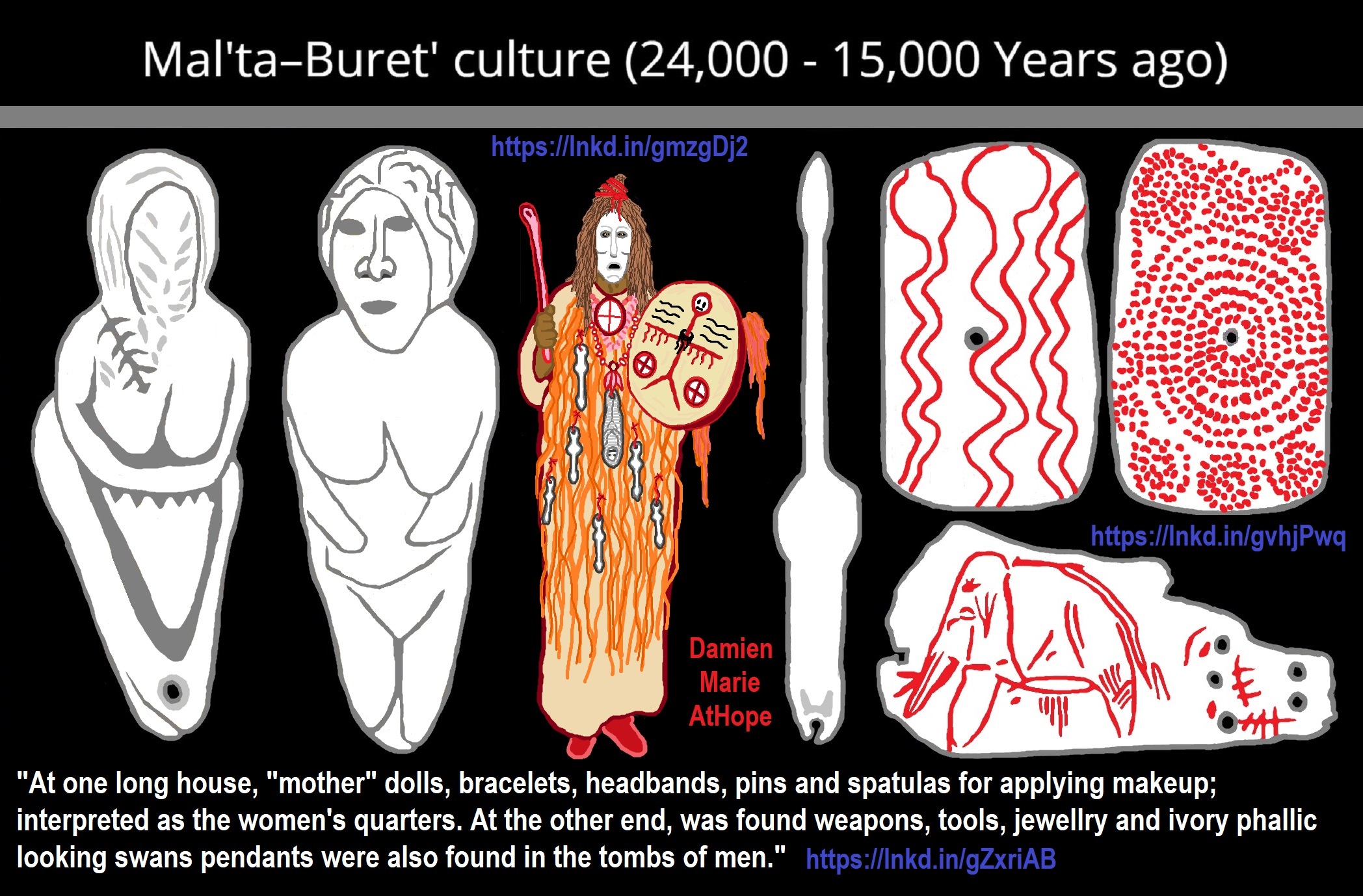

ref, ref, ref, ref, ref, ref, ref, ref, ref, ref, ref, ref, ref, ref, ref, ref, ref, ref, ref
Here are my thoughts/speculations on where I believe is the possible origin of shamanism, which may have begun sometime around 35,000 to 30,000 years ago seen in the emergence of the Gravettian culture, just to outline his thinking, on what thousands of years later led to evolved Asian shamanism, in general, and thus WU shamanism as well. In both Europe-related “shamanism-possible burials” and in Gravettian mitochondrial DNA is a seeming connection to Haplogroup U. And the first believed Shaman proposed burial belonged to Eastern Gravettians/Pavlovian culture at Dolní Věstonice in southern Moravia in the Czech Republic, which is the oldest permanent human settlement that has ever been found. It is at Dolní Věstonice where approximately 27,000-25,000 years ago a seeming female shaman was buried and also there was an ivory totem portrait figure, seemingly of her.
And my thoughts on how cultural/ritual aspects were influenced in the area of Göbekli Tepe. I think it relates to a few different cultures starting in the area before the Neolithic. Two different groups of Siberians first from northwest Siberia with U6 haplogroup 40,000 to 30,000 or so. Then R Haplogroup (mainly haplogroup R1b but also some possible R1a both related to the Ancient North Eurasians). This second group added its “R1b” DNA of around 50% to the two cultures Natufian and Trialetian. To me, it is likely both of these cultures helped create Göbekli Tepe. Then I think the female art or graffiti seen at Göbekli Tepe to me possibly relates to the Epigravettians that made it into Turkey and have similar art in North Italy. I speculate that possibly the Totem pole figurines seen first at Kostenki, next went to Mal’ta in Siberia as seen in their figurines that also seem “Totem-pole-like”, and then with the migrations of R1a it may have inspired the Shigir idol in Russia and the migrations of R1b may have inspired Göbekli Tepe.

Ancient North Eurasian (ANE)
Ancient Beringian/Ancestral Native American (AB/ANA)
Eastern Hunter-Gatherer (EHG)
Western Hunter-Gatherers (WHG)
Western Steppe Herders (WSH)
Scandinavian Hunter-Gatherer (SHG)
Early European Farmers (EEF)
Jōmon people (Ainu people OF Hokkaido Island)
Neolithic Iranian farmers (Iran_N) (Iran Neolithic)
Haplogroup R possible time of origin about 27,000 years in Central Asia, South Asia, or Siberia:
- Mal’ta–Buret’ culture (24,000-15,000 years ago)
- Afontova Gora culture (21,000-12,000 years ago)
- Trialetian culture (16,000–8000 years ago)
- Samara culture (7,000-6,500 years ago)
- Khvalynsk culture (7,000-6,500 years ago)
- Afanasievo culture (5,300-4,500 years ago)
- Yamna/Yamnaya Culture (5,300-4,500 years ago)
- Andronovo culture (4,000–2,900 years ago) ref

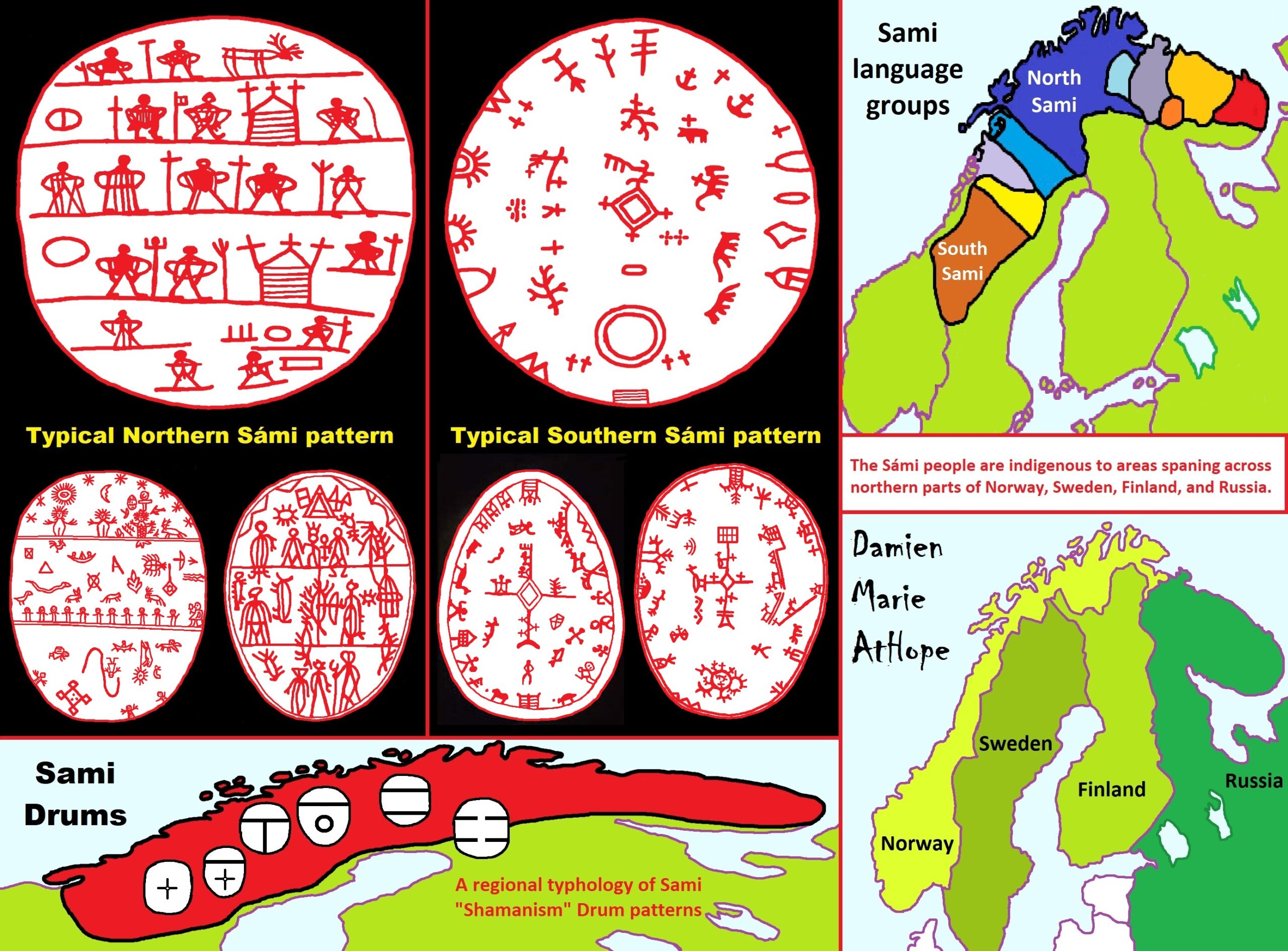
ref, ref, ref, ref, ref, ref, ref, ref, ref
“The drum of Anders Paulsen (top left) and the Bindal drum (top right) represent variations in Sami drums, their shape, decoration and history. Paulsen’s drum was confiscated in Vadsø in 1691, while the Bindal drum was bought by a museum official in 1925; Vadsø and Bindal being in opposite corners of the Sami world. Paulsens’s drum has a typical Northern Sámi pattern, with several separate levels representing the different layers of spiritual worlds. The Bindal drum has a typical Southern Sami decoration: a rhombus-shaped sun symbol in the center, with other symbols around the sun, representing people, animals, landscape and deities.” ref
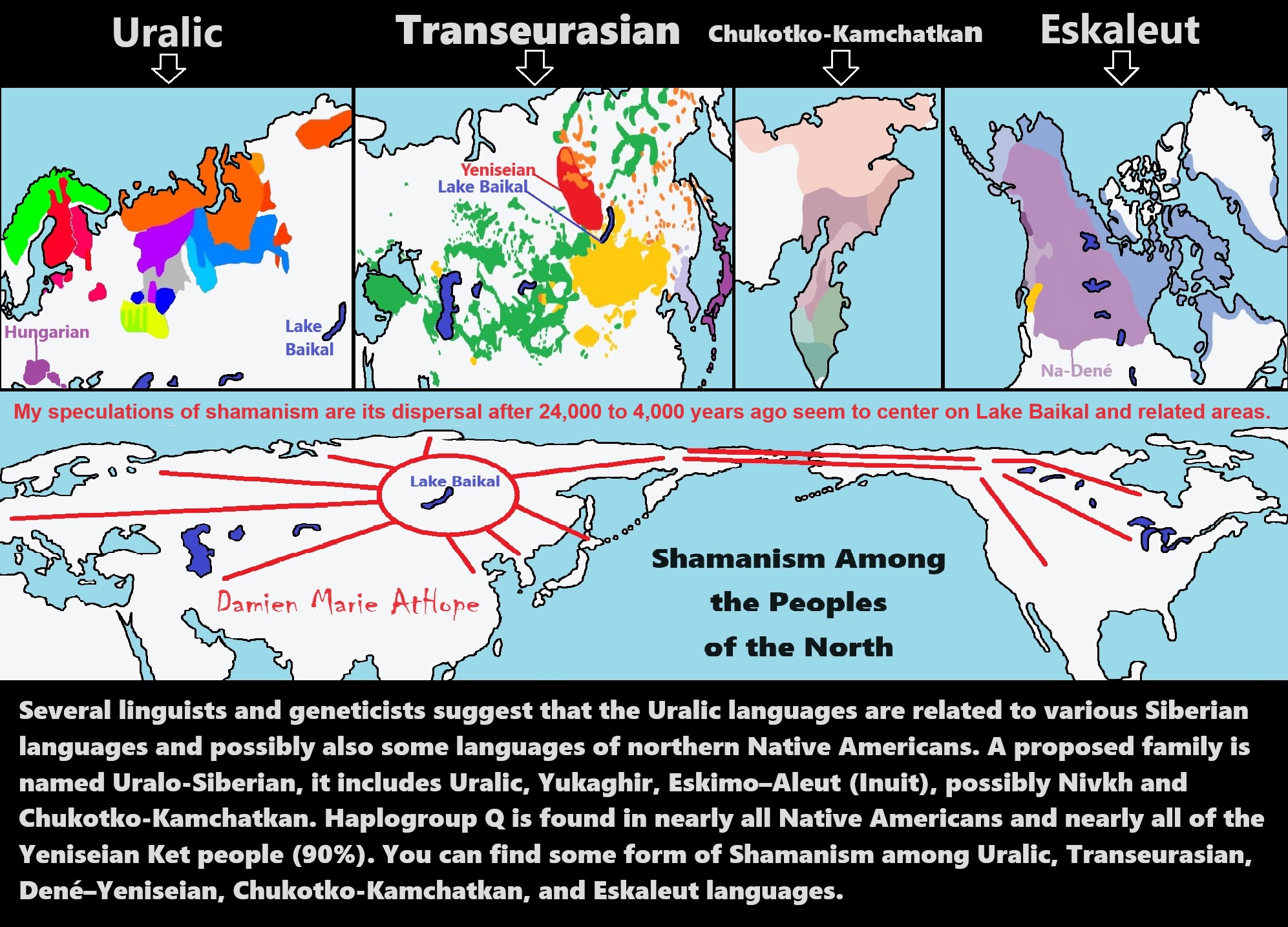
ref, ref, ref, ref, ref, ref, ref, ref, ref
“Several linguists and geneticists suggest that the Uralic languages are related to various Siberian languages and possibly also some languages of northern Native Americans. A proposed family is named Uralo-Siberian, it includes Uralic, Yukaghir, Eskimo–Aleut (Inuit), possibly Nivkh, and Chukotko-Kamchatkan. Haplogroup Q is found in nearly all Native Americans and nearly all of the Yeniseian Ket people (90%).” ref, ref
You can find some form of Shamanism, among Uralic, Transeurasian, Dené–Yeniseian, Chukotko-Kamchatkan, and Eskaleut languages.
My speculations of shamanism are its dispersals, after 24,000 to 4,000 years ago, seem to center on Lake Baikal and related areas. To me, the hotspot of Shamanism goes from west of Lake Baikal in the “Altai Mountains” also encompassing “Lake Baikal” and includes the “Amur Region/Watershed” east of Lake Baikal as the main location Shamanism seems to have radiated out from.
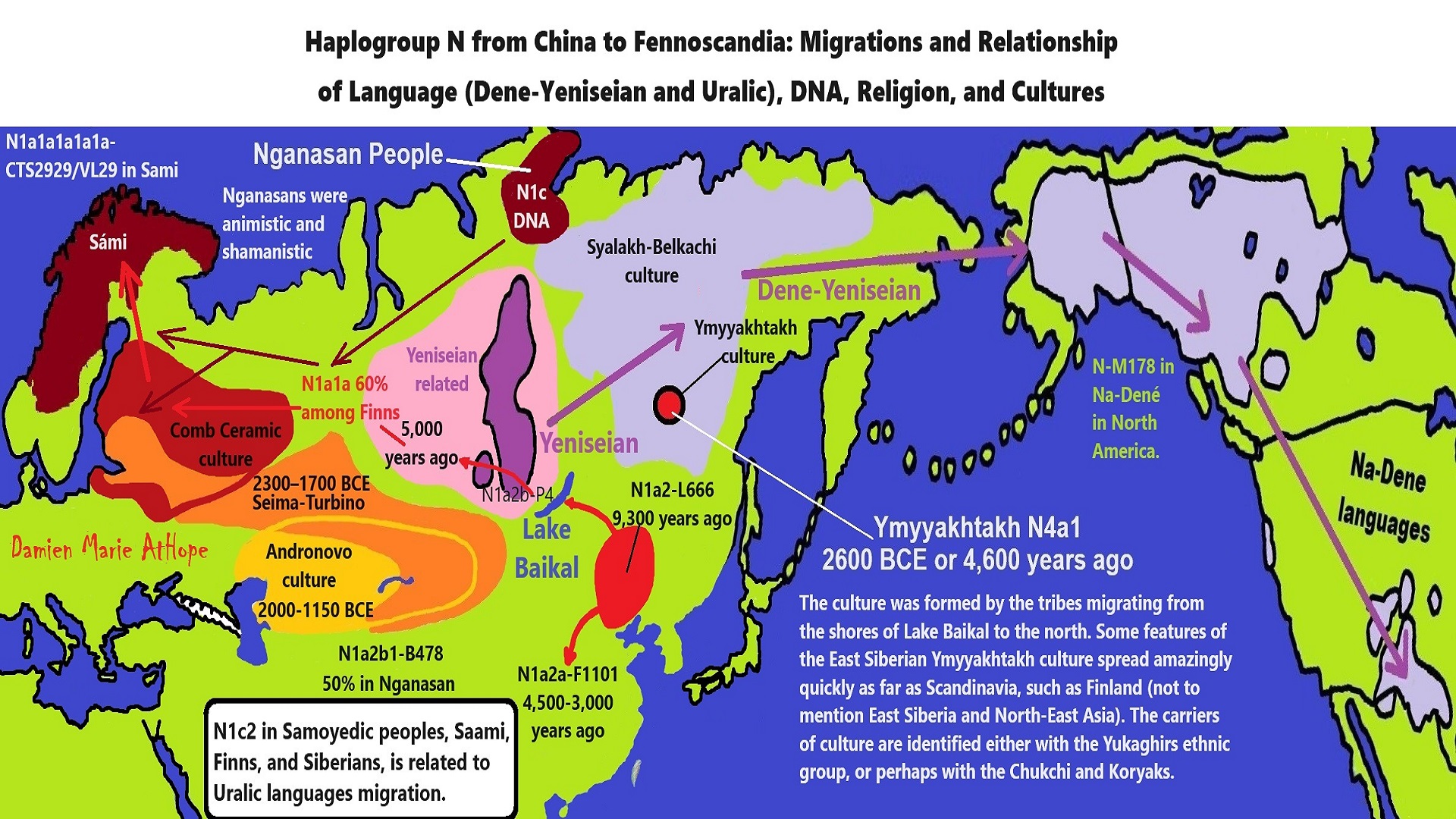
ref, ref, ref, ref, ref, ref, ref, ref, ref, ref, ref, ref, ref, ref, ref, ref
Postglacial genomes from foragers across Northern Eurasia reveal prehistoric
mobility associated with the spread of the Uralic and Yeniseian languages
Abstract
“The North Eurasian forest and forest-steppe zones have sustained millennia of sociocultural connections among northern peoples. We present genome-wide ancient DNA data for 181 individuals from this region spanning the Mesolithic, Neolithic, and Bronze Age. We find that Early to Mid-Holocene hunter-gatherer populations from across the southern forest and forest-steppes of Northern Eurasia can be characterized by a continuous gradient of ancestry that remained stable for millennia, ranging from fully West Eurasian in the Baltic region to fully East Asian in the Transbaikal region. In contrast, cotemporaneous groups in far Northeast Siberia were genetically distinct, retaining high levels of continuity from a population that was the primary source of ancestry for Native Americans. By the mid-Holocene, admixture between this early Northeastern Siberian population and groups from Inland East Asia and the Amur River Basin produced two distinctive populations in eastern Siberia that played an important role in the genetic formation of later people. Ancestry from the first population, Cis-Baikal Late Neolithic-Bronze Age (Cisbaikal_LNBA), is found substantially only among Yeniseian-speaking groups and those known to have admixed with them. Ancestry from the second, Yakutian Late Neolithic-Bronze Age (Yakutia_LNBA), is strongly associated with present-day Uralic speakers. We show how Yakutia_LNBA ancestry spread from an east Siberian origin ~4.5kya, along with subclades of Y-chromosome haplogroup N occurring at high frequencies among present-day Uralic speakers, into Western and Central Siberia in communities associated with Seima-Turbino metallurgy: a suite of advanced bronze casting techniques that spread explosively across an enormous region of Northern Eurasia ~4.0kya. However, the ancestry of the 16 Seima-Turbino-period individuals–the first reported from sites with this metallurgy–was otherwise extraordinarily diverse, with partial descent from Indo-Iranian-speaking pastoralists and multiple hunter-gatherer populations from widely separated regions of Eurasia. Our results provide support for theories suggesting that early Uralic speakers at the beginning of their westward dispersal where involved in the expansion of Seima-Turbino metallurgical traditions, and suggests that both cultural transmission and migration were important in the spread of Seima-Turbino material culture.” ref
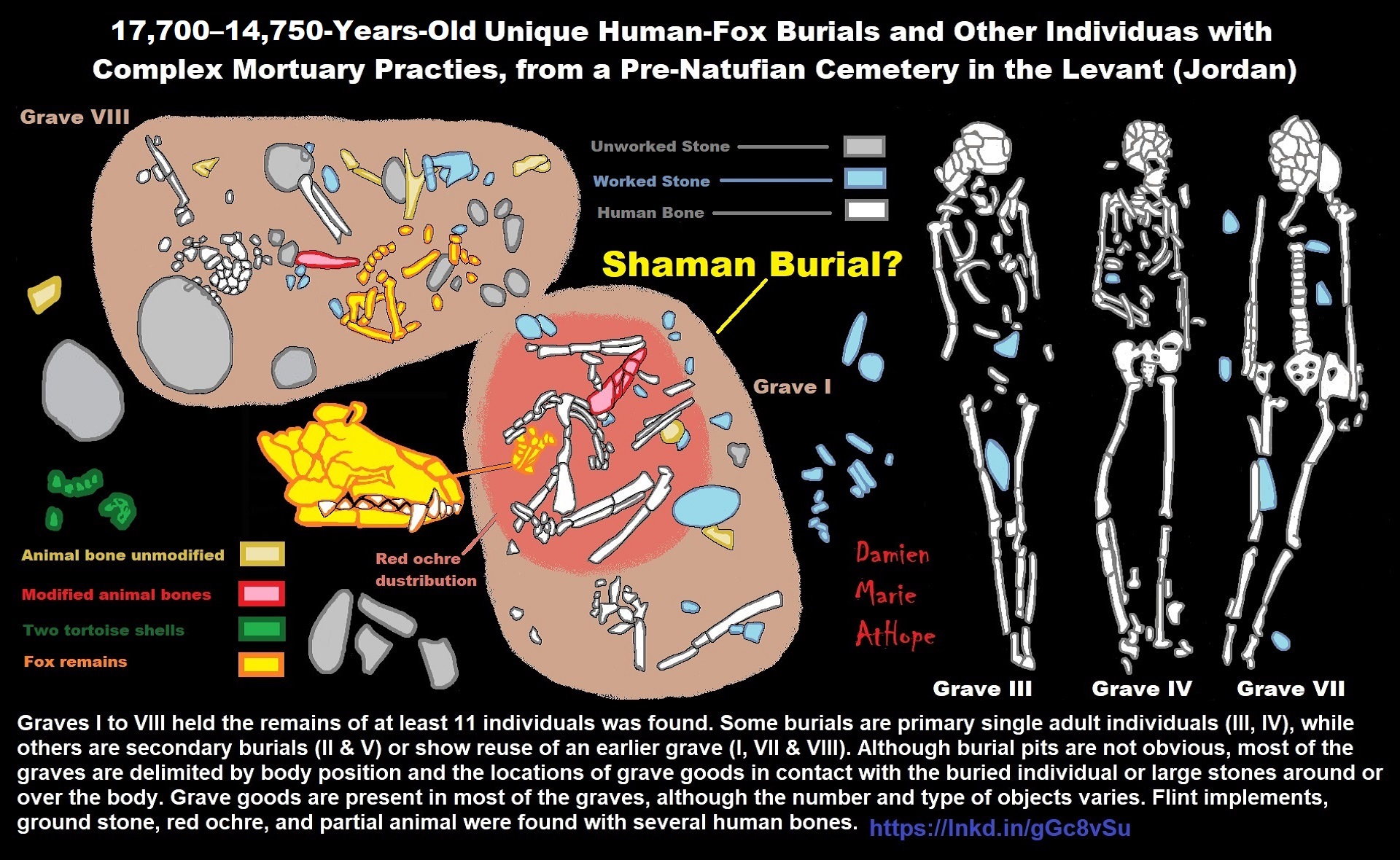
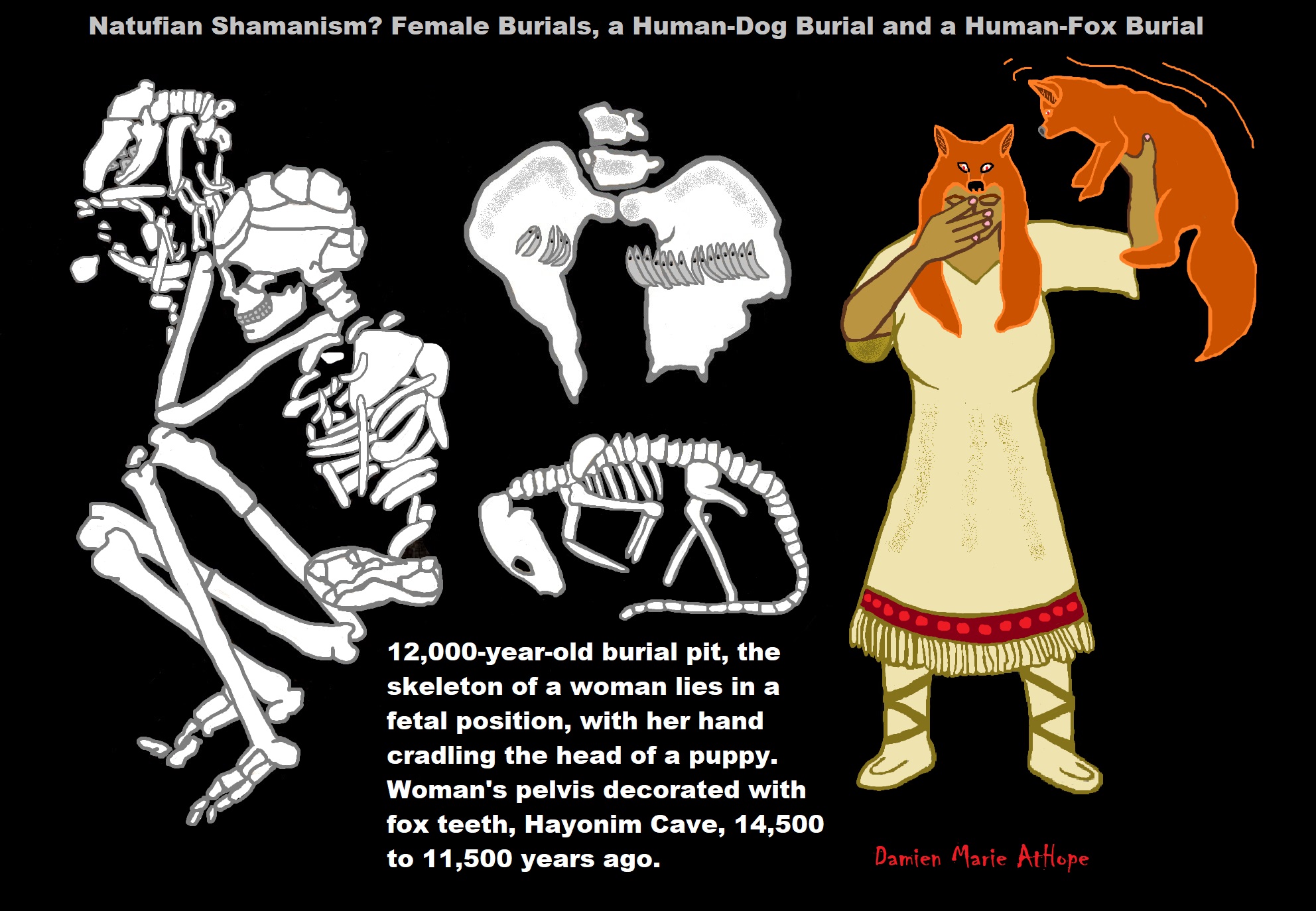

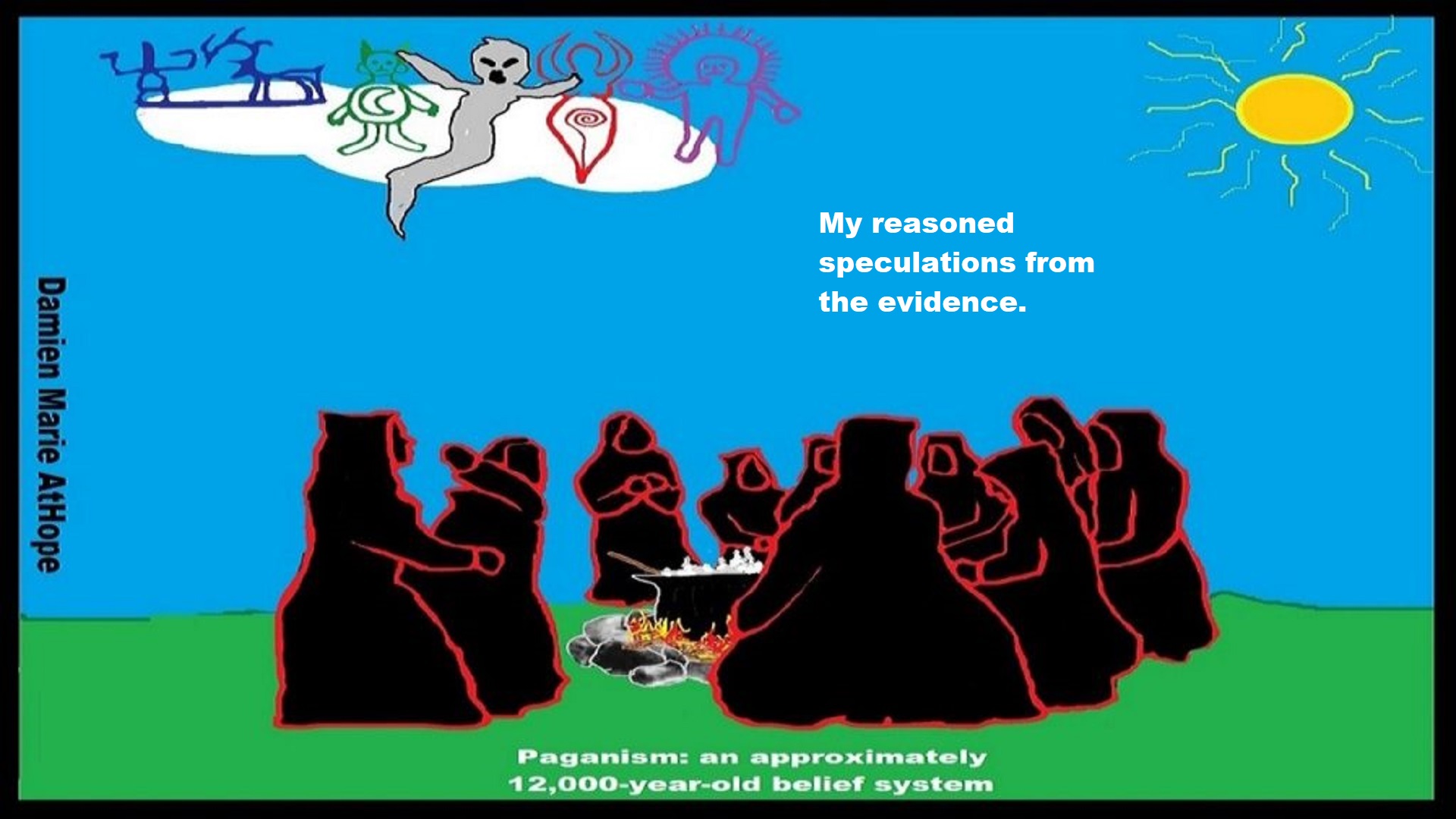
Paganism (such as that seen in Turkey: 12,000 years ago)
Haplogroup G2a (Y-chromosomal DNA) and the Seeming Development of Early Agriculture – “Haplogroup G descends from macro-haplogroup F, which is thought to represent the second major migration of Homo sapiens out of Africa, at least 60,000 years ago. Haplogroup G has 303 mutations confirming a severe bottleneck before splitting into haplogroups G1 and G2. G1might have originated around modern Iran around 26,000 years ago. G2 would have developed around the same time in West Asia and haplogroup G2 appear to have been closely linked to the development of early agriculture in the Fertile Crescent part, around 11,500 years before present. G2a branch expanded to Anatolia, the Caucasus, and Europe, while G2b diffused from Iran across the Fertile Crescent and east to Pakistan.
There has so far been ancient Y-DNA analysis from Early Neolithic Anatolia, Iran, Israel, Jordan as well as most Neolithic cultures in Europe (Thessalian Neolithic in Greece, Starčevo culture in Hungary/Croatia, LBK culture in Germany, Remedello in Italy, and Cardium Pottery in south-west France and Spain) and all sites yielded a majority of G2a individuals, except those from the Levant. This strongly suggests that farming was disseminated by members of haplogroup G at least from Anatolia/Iran then moved to Europe. 44 ancient Near Eastern samples, including Neolithic farmers from Jordan and western Iran, and found one G2b sample dating from the Pre-Pottery Neolithic (9,250 years ago) and a G2a1 from the Early Pottery Neolithic (7,700 years ago), both from Iran. The highest genetic diversity within haplogroup G is found in the northern part of the Fertile Crescent, between the Levant and the Caucasus, which is a good indicator of its region of origin.
Çatalhöyük in south-central Anatolia/Turkey was founded by farmers who also brought domesticated goats and sheep. Also around 8,500 years ago, G2a Neolithic farmers arrived in northwest Anatolia and Thessaly in central Greece, as attested by the ancient genomes around the time that it seems cattle domestication was introduced to Çatalhöyük and other sites in Central Anatolia, presumably by trading with their eastern neighbors. Ancient skeletons from the Starčevo–Kőrös–Criș culture (8,000-6,500 years ago) in Hungary and Croatia, and the Linear Pottery culture (7,500-6,500 years ago) in Hungary and Germany, all confirmed that G2a (both G2a2a and G2a2b) remained the principal paternal lineage even after farmers intermingled with indigenous populations as they advanced. G2a farmers from the Thessalian Neolithic quickly expanded across the Balkans and the Danubian basin, reaching Serbia, Hungary, and Romania by 7,800 years ago, Germany by 7,500 years ago, and Belgium and northern France by 7,200 years ago. By 7,800 years ago, farmers making cardial pottery arrived at the Marmara coast in northwest Anatolia with ovicaprids and pigs.
These people crossed the Aegean by boat and colonized the Italian peninsula, the Illyrian coast, southern France and Iberia, where they established the Cardium Pottery culture (5000-1500 BCE). Once again, ancient DNA yielded a majority of G2a samples in the Cardium Pottery culture, with G2a frequencies above 80% (against 50% in Central and Southeast Europe). Nevertheless, substantial minorities of other haplogroups have been found on different Neolithic sites next to a G2a majority, including C1a2, H2, I*, I2a1, I2c, and J2a in Anatolia, C1a2, E-M78, H2, I*, I1, I2a, I2a1, J2 and T1a in Southeast and Central Europe (Starčevo, Sopot, LBK), as well as E-V13, H2, I2a1, I2a2a1 and R1b-V88 in western Europe (Cardium Pottery, Megalithic). H2 and T1a were found in the Pre-Pottery Neolithic Levant and are undeniably linked to the early development of agriculture alongside G2a. That being said, C1a2 was also found in Mesolithic Spain and, as it is an extremely old lineage associated with the first Paleolithic Europeans, it could have been found all over Europe and Anatolia before the Neolithic. E1b1b was also found in the Pre-Pottery Neolithic Levant, but the subclades may not be E-M78 or E-V13 (more likely E1b1b1* or E-M123).
R1b-V88 surely spread from the Near East too, although through a different route, with cattle herders via North Africa, then crossing over to Iberia. The rest probably represent assimilated hunter-gatherers descended from Mesolithic western Anatolian (I*, I2c, J2) and Europeans (E-V13, I*, I1, I2a, I2a1, I2a2). It is interesting to note that many of these lineages, such as C1a2, H2 and I* are virtually extinct anywhere nowadays, and several others are now very rare in Europe (I2c, R1b-V88).” ref
Haplogroup J (mtDNA) and the Seeming Spread of Early Agriculture – “Samples have been identified from various Neolithic sites, including Linear Pottery culture (LBK) in Central Europe, the Cardium Pottery culture in southern France, Megalithic cultures in northern Spain, and the Funnelbeaker culture in Germany and Sweden. All Neolithic samples tested to date belonged to J1*, J1c or J2b1a. One question that follows is: did J1c and J2b1a lineages actually come from the Near East during the Neolithic, or whether they were already in the Balkans and just expanded from there? Both being rare in the Near East today, the second hypothesis might seem more convincing at first. However, the age of J2b1a has been estimated at 11,000 years before present, while the Neolithic started over 12,000 years ago in the Near East. In other words, it could have arrived from the Near East as J2b1* and developed into J2b1a only after reaching Europe, which would explain why this particular subclade is almost exclusively European while all other subclades of J2b1 are mostly Middle Eastern or the eastern Mediterranean. J2b1a would, therefore, have come as a maternal lineage of early agriculturalists alongside the paternal lineage G2a (and perhaps also E1b1b and T1a). J1c, however, is too old (15,000 years) for that scenario.
If it had been part of the Neolithic expansion from the Fertile Crescent, many J1c subclades would be primarily West Asian today, which isn’t the case. The only J1c individuals outside Europe belong to deep clades that clearly originated in Europe or in Anatolia. DNA of Early Neolithic farmers from western Anatolia and from the Starcevo culture in Hungary and Croatia, and found that J1c was present in both cultures, alongside other typical European Neolithic lineages like H5, K1a, N1a, T2, and X2. Of 44 ancient Near Eastern samples, including Neolithic farmers from Jordan and western Iran, and well as Chalcolithic and Bronze Age samples from Armenia and the Levant, but did not find any J1c, apart from a single sample in Neolithic Iran.
This suggests that J1c lineages were probably not found among the very first farmers of the Fertile Crescent but were rather assimilated in neighboring populations further north, notably in Anatolia and Iran, but probably also in the Balkans, which were connected to Anatolia by a land bridge during the glacial and immediate post-glacial periods. Haplogroup J has been found in Bronze Age samples from the Yamna culture (J2b), Corded Ware culture (J1c and J2b1a), the Catacomb culture (J1b1a1), the Unetice culture (J1b1a1), and the Urnfield culture (J1b1), all in Central Europe. The Corded Ware culture is associated with the expansion of Y-haplogroup R1a from the northern Russian steppe, and in light of the continuity with Neolithic samples from Central Europe it can be assumed that J1c and J2b1a maternal lineages were not brought by the newcomers, but absorbed by the male invaders. On the other hand, J1b has never been found in Europe before the Bronze Age and was very probably brought by the Indo-Europeans carrying R1b paternal lineages. Both the Unetice and the Urnfield cultures are thought to have been founded mainly by R1b men.” ref
- Gobekli Tepe: “first human-made temple” around 12,000 years ago.
- Sedentism and the Creation of goddesses around 12,000 years ago as well as male gods after 7,000 years ago.
- First Patriarchy: Split of Women’s Status around 12,000 years ago & First Hierarchy: fall of Women’s Status around 5,000 years ago.
- Natufians: an Ancient People at the Origins of Agriculture and Sedentary Life
- J DNA and the Spread of Agricultural Religion (paganism)
- Paganism: an approximately 12,000-year-old belief system
- Shaman burial in Israel 12,000 years ago and the Shamanism Phenomena
- Need to Mythicized: gods and goddesses
- “36cu0190” a Historic and Prehistoric site in Pennsylvania
- 12,000 – 10,000 years old Shamanistic Art in a Remote Cave in Egypt
- 12,000 – 7,000 Years Ago – Paleo-Indian Culture (The Americas)
- 12,000 – 2,000 Years Ago – Indigenous-Scandinavians (Nordic)
- Norse did not wear helmets with horns?
- Pre-Pottery Neolithic Skull Cult around 11,500 to 8,400 Years Ago?
- Catal Huyuk “first religious designed city”around 10,000 years ago
- 9,000-8500 year old Female shaman Bad Dürrenberg Germany
- Kurgan 6,000 years ago/dolmens 7,000 years ago: funeral, ritual, and other?
- Connected “dolmen phenomenon” of above-ground stone burial structures?
- Stars: Ancestors, Spirit Animals, and Deities (at least back to around 6,000 years ago)
- Evolution Of Science at least by 5,500 years ago
- 5,500 Years old birth of the State, the rise of Hierarchy, and the fall of Women’s status
- “Jiroft culture” 5,100 – 4,200 years ago and the History of Iran
Paganism is approximately a 12,000-year-old belief system and believe in spirit-filled life and/or afterlife that can be attached to or be expressed in things or objects and these objects can be used by special persons or in special rituals that can connect to spirit-filled life and/or afterlife and who are guided/supported by a goddess/god, goddesses/gods, magical beings, or supreme spirits. If you believe like this, regardless of your faith, you are a hidden paganist.
Around 12,000 years ago, in Turkey, the first evidence of paganism is Gobekli Tepe: “first human-made temple” and around 9,500 years ago, in Turkey, the second evidence of paganism is Catal Huyuk “first religious designed city”. In addition, early paganism is connected to Proto-Indo-European language and religion. Proto-Indo-European religion can be reconstructed with confidence that the gods and goddesses, myths, festivals, and form of rituals with invocations, prayers, and songs of praise make up the spoken element of religion. Much of this activity is connected to the natural and agricultural year or at least those are the easiest elements to reconstruct because nature does not change and because farmers are the most conservative members of society and are best able to keep the old ways.
The reconstruction of goddesses/gods characteristics may be different than what we think of and only evolved later to the characteristics we know of today. One such characteristic is how a deity’s gender may not be fixed, since they are often deified forces of nature, which tend to not have genders. There are at least 40 deities and the Goddesses that have been reconstructed are: *Pria, *Pleto, *Devi, *Perkunos, *Aeusos, and *Yama.
The reconstruction of myths can be connected to Proto-Indo-European culture/language and by additional research, many of these myths have since been confirmed including some areas that were not accessible to the early writers such as Latvian folk songs and Hittite hieroglyphic tablets. There are at least 28 myths and one of the most widely recognized myths of the Indo-Europeans is the myth, “Yama is killed by his brother Manu” and “the world is made from his body”. Some of the forms of this myth in various Indo-European languages are about the Creation Myth of the Indo-Europeans.
The reconstruction of rituals can be connected to Proto-Indo-European culture/language and is estimated to have been spoken as a single language from around 6,500 years ago. One of the earliest ritual is the construction of kurgans or mound graves as a part of a death ritual. kurgans were inspired by common ritual-mythological ideas. Kurgans are complex structures with internal chambers. Within the burial chamber at the heart of the kurgan, elite individuals were buried with grave goods and sacrificial offerings, sometimes including horses and chariots.
The speakers of Pre-Proto-Indo-European lived in Turkey and it associates the distribution of historical Indo-European languages with the expansion around 9,000 years ago, with a proposed homeland of Proto-Indo-European proper in the Balkans around 7,000 years ago. The Proto-Indo-European Religion seemingly stretches at least back around 6,000 years ago or likely much further back and I believe Paganism is possibly an approximately 12,000-year-old belief system.
At a mound is called Gadachrili Gora, and the Stone Age farmers who lived here 8,000 years ago were grape lovers: Their rough pottery is decorated with bunches of the fruit, and analysis of pollen from the site suggests the wooded hillsides nearby were once decked with grapevines. Combined with the grape decorations on the outside of the jars, ample grape pollen in the site’s fine soil, and radiocarbon dates from 7,800 to 8,000 years ago, the chemical analysis indicates the people at Gadachrili Gora were the world’s earliest winemakers. ref
Starting from 9,500 years ago, a new population began to settle the Balkans and the Danube valley. Evidence shows that the Neolithic newcomers mixed with the indigenous population in Lepenski Vir. Arriving from Asia Minor/Anatolia (modern-day Turkey), the immigrants had a completely different physical appearance and lifestyle. With them, they brought a knowledge of agriculture, first grain crops, and husbandry: sheep, cattle, and goats. Based on the research, Starović concluded that the blending of the population occurred almost immediately, during the first immigrant generation, which was unique as in the other parts of Europe two such different communities would live next to each other at first. He believes that this melting pot was a keystone of human development in Europe. It produced the boom of the Lepenski Vir culture, establishing the “original Balkan Neolithic, the most original occurrence in the entire prehistory in Europe, which founded all we know today – the concepts of village, square, family – which then spread over and overwhelmed the continent”. ref
The culture of Lepenski Vir is around 8,5 millennia old and is located on the right bank of the Danube in the Djerdap gorge (The Iron gates of the Danube) near the town of Donji Milanovac. It was the center of one of the most complex prehistoric cultures. Rich cultural layer reveals the traces of the highly developed culture that had complex social relations and as such was the first in Europe to organize its settlement according to a plan. Trapezoid-base houses with a primitive wooden construction which were organized in the shape of a horseshoe. The buildings surrounded an open space – the first known square, with the central building, probably some kind of a temple or a shrine. Fireplace surrounded by fishlike stone figurines took central place in every house. Stone idols found in Lepenski Vir represent the oldest monumental stone sculptures found in Europe. At first, they only had a head with a strange expression, while in later stages these figurines had anthropomorphic shapes. Besides these figurines, numerous tools and arms made of stone, bone, and antler, pottery and jewelry made of shells and pebbles were found here. Based on these pieces of evidence we can conclude that these first inhabitants of the Danube banks lived at the time of the so-called Neolithic revolution when the first communities started working the land and tamed some animals. The culture of Lepenski Vir developed in the period from 8,500 to 7,500 years ago. ref, ref
The main site consists of several archeological phases starting with Proto-Lepenski Vir, then Lepenski Vir Ia-e, Lepenski Vir II and Lepenski Vir III, whose occupation spanned from 1,500 to 2,000 years, from the Mesolithic to the Neolithic period, when it was succeeded by the Neolithic Vinča culture and Starčevo culture, both upstream the Danube, 135 km (84 mi) and 139 km (86 mi) from Lepenski Vir, respectively. The Vinca culture a Neolithic archaeological culture in Serbia and smaller parts of Romania (particularly Transylvania), dated to the period 7,700–8,500 or 7,300–6,700/6,500 years ago.
The Vinča culture occupied a region of Southeastern Europe (i.e. the Balkans) corresponding mainly to modern-day Serbia (with Kosovo), but also parts of Romania, Bulgaria, Bosnia, Montenegro, Republic of Macedonia, and Greece. This region had already been settled by farming societies of the First Temperate Neolithic, but during the Vinča period sustained population growth led to an unprecedented level of settlement size and density along with the population of areas that were bypassed by earlier settlers. it was thought, on the basis of typological similarities, that Vinča and other Neolithic cultures belonging to the ‘Dark Burnished Ware’ complex were the product of migrations from Anatolia to the Balkans but the Dark Burnished Ware complex appeared at least a millennium before Troy I, the putative starting point of the westward migration. An alternative hypothesis where the Vinča culture developed locally from the preceding Starčevo culture.
Named for its type site, Vinča-Belo Brdo, a large tell settlement. These settlements maintained a high degree of cultural uniformity through the long-distance exchange of ritual items but were probably not politically unified. Various styles of zoomorphic and anthropomorphic figurines are hallmarks of the culture, as are the Vinča symbols, which some conjecture to be the earliest form of proto-writing. Although not conventionally considered part of the Chalcolithic or “Copper Age”, the Vinča culture provides the earliest known example of copper metallurgy. A number of satellite villages belonging to the same culture and time period were discovered in the surrounding area. These additional sites include Hajdučka Vodenica, Padina, Vlasac, Ikaona, Kladovska Skela, and others. Found artifacts include tools made from stone and bones, the remains of houses, and numerous sacral objects including unique stone sculptures.
It is assumed that the people of Lepenski Vir culture represent the descendants of the early European population of the Brno–Předmostí (Czech Republic) hunter-gatherer culture from the end of the last ice age. Archeological evidence of human habitation of the surrounding caves dates back to around 20,000 BC. The first settlement on the low plateau dates back to 11,500–9,200 BC. The late Lepenski Vir (8,300–8,000 years ago) architectural development was the development of the Trapezoidal buildings and monumental sculpture.[1] The Lepenski Vir site consists of one large settlement with around ten satellite villages. Numerous piscine sculptures and peculiar architecture have been found at the site. And the sculptures of this size so early in human history and original architectural solutions, define Lepenski Vir as the specific and very early phase in the development of the prehistoric culture in Europe. ref, ref
An 8,000-YEAR-OLD VEILED MOTHER GODDESS NEAR BULGARIA’S VIDIN ‘PUSHES BACK’ NEOLITHIC REVOLUTION IN EUROPE. The head of the Neolithic Mother Goddess, the earliest deity of Europe’s first sedentary farmers was found along with and other artifacts and structures in the settlement in Mayor Uzunovo, Vidin District, close to the Danube River, in Northwest Bulgaria. Also, in Bulgaria is found one of the oldest funerals in the Balkans – an early Neolithic funeral of a person at the age of 12-13, which dates back to around 8,300-8,150 years ago. The Neolithic settlement at Dzhulyunitsa existed between 8,300 and 7,700 years ago. Bulgaria farming inhabitants of 8,000 years ago deliberately burned individual homes down, perhaps as some sort of sacrifice. It’s likely they followed a religion concerned with fertility and there are graves dating to the end of the sixth millennium BC, with one skeleton buried in a fetal position. Some of the earliest European evidence for farming is found here as the new crops and domestic animals spread from the Near East through modern-day Turkey.
The finds from the Ohoden excavations indicate that the Balkan Peninsula was the center of a prehistoric civilization which spread to the rest of Europe and we can ponder what they spread the settlement, also had a religious shrine of the sun cult. Early Neolithic pits with traces of fire were next to a northern pit, and an 8,000-year-old stone structure set at a right angle and featuring an arch has been discovered. This is one of the earliest stone structures in the Balkans. The shrine is believed to have been a fertility and sun temple as its floor was paved with U-shaped stones directed to the east; it contained dozens of clay and stone disc symbolizing the sun disc, respectively the sun cult, in early agrarian societies. At the Ohoden site with the sanctuary containing a prehistoric altar decorated with huge trophy elk horns placed 2 meters away from a ritual burial of a man. ref, ref, ref, ref, ref, ref
The earliest kurgans date to 6,000 years ago and are connected to the Proto-Indo-European in the Caucasus. In fact, around 7,000 years ago, there appears to be pre-kurgan in Siberia. Around 7,000 to 2,500 years ago and beyond, kurgans were built with ancient traditions still active in Southern Siberia and Central Asia, which display the continuity of the archaic forming methods. Kurgan cultures are divided archaeologically into different sub-cultures such as Timber Grave, Pit Grave, Scythian, Sarmatian, Hunnish, and Kuman–Kipchak. Kurgans have been found from the Altay Mountains to the Caucasus, Ukraine, Romania, and Bulgaria. Around 5,000 years ago, kurgans were used in the Ukrainian and Russian flat unforested grasslands and their use spread with migration into eastern, central, northern Europe, Turkey, and beyond. ref, ref, ref, ref, ref, ref, ref, ref, ref, ref, ref, ref, & ref
Y-DNA G2a, F* and J2 are what we would expect from a source in Anatolia or the Caucasus Mountains or the highlands of Iran, not the Levant or Arabia or even the lowlands of Mesopotamia (although J2 would surely be found in Mesopotamia in significant proportions). The first European farmers probably emerged from the highlands that form the Southern boundaries of Europe and West Asia, rather than from what we would conventionally think of as the “Near East” proper. And rather than being European hunter-gatherers who were assimilated into the first wave of Neolithic farmers in the Balkans, that the Pelasgians (the indigenous inhabitants of the Aegean Sea region and their cultures) may have been the first wave Neolithic farmers in the Balkans (who probably arrived around 9,000-6,000 years ago). ref
The arrival of the Neolithic culture comes from Anatolia between 9.000 and 5.000 years ago, mtDNA data from Early Neolithic farmers of the Starčevo Criş culture in Romania (Cârcea, Gura Baciului, and Negrileşti sites), confirm their genetic relationship with those of the LBK culture (Linienbandkeramik Kultur) in Central Europe, and they show little genetic continuity with modern European populations. On the other hand, populations of the Middle-Late Neolithic (Boian, Zau and Gumelniţa cultures), supposedly the second wave of Neolithic migration from Anatolia, had a much stronger effect on the genetic heritage of the European populations. In contrast, we find a smaller contribution of Late Bronze Age migrations to the genetic composition of Europeans. Based research findings, it has been proposed that permeation of mtDNA lineages from the second wave of Middle-Late Neolithic migration from North-West Anatolia into the Balkan Peninsula and Central Europe represent an important contribution to the genetic shift between Early and Late Neolithic populations in Europe, and consequently to the genetic make-up of modern European populations.
The study of the genomes of a 7,000-year-old farmer from Germany and eight ~8,000-year-old hunter-gatherers from Luxembourg and Sweden have shown that most present-day Europeans derive from at least three highly differentiated populations. Besides, authors have proposed that early European farmers had a ~44% ancestry from a ‘basal Eurasian’ population.
Archaeological data show that the Neolithic expansion from Anatolia was not a single event but was represented by several waves of migrants. In this respect, the Proto-Sesklo culture in Greece, from which directly Starčevo-Criş in the northern Balkans and indirectly LBK in Central Europe originate represents only the first great wave of Neolithisation of Europe. A later great wave of migration from North-West Anatolia led to important cultures of South-Eastern Europe such as Vinča and Boian cultures.
aDNA studies of hunter-gatherers revealed a high genetic homogeneity in the pre-Neolithic groups throughout Europe, whether from Scandinavia, Central Europe or the Iberian Peninsula. The analysis of aDNA from Early European farmer groups of the Linear Pottery Culture (LPC, also known as Linienbandkeramik Kultur or LBK) in Central Europe suggested a genetic discontinuity in Central Europe and favored instead of a process of Neolithic transition through a of population diffusion into and across the area, based on a high frequency of the N1a haplogroup (about 15%) in the LBK farmers, absent in hunter-gatherers in this same region and almost nonexistent (0.2%) in the present-day European populations. Moreover, these first farmers shared an affinity with the modern-day populations from the Near East and Anatolia, supporting a major genetic input from this area during the advent of farming in Europe. Studies of other Neolithic sites in the North of France, Hungary and the Northeast of Iberian Peninsula also supported this view. However, an ancient mtDNA study of a Neolithic site in the Mediterranean region of Europe, namely in the Iberian Peninsula (Spain and Portugal), led to the proposal of a dual model for explaining the Neolithic dispersion process in Europe: DD in Mediterranean area and CD in Central Europe. ref
- “12,000 years ago: Jericho has evidence of settlement dating back to 10,000 BC. Jericho was a popular camping ground for Natufian hunter-gatherer groups, who left a scattering of crescent microlith tools behind them.
- 12,000 years ago: Earliest dates suggested for the domestication of the goat.
- 11,600 years ago: Start of the current Holocene epoch.
- 11,000 -12,00/13,000 years ago (9,000 BC): Earliest date recorded for construction of temenoi ceremonial structures at Göbekli Tepe in southern Turkey, as possibly the oldest surviving proto-religious site on Earth.
- 11,000 years ago: Emergence of Jericho, which is now one of the oldest continuously inhabited cities in the world. Giant short-faced bears and giant ground sloths go extinct. Equidae goes extinct in North America.
- 10,500 years ago: Earliest supposed date for the domestication of cattle.
- 10,000 years ago: The Quaternary extinction event, which has been ongoing since the mid-Pleistocene, concludes. Many of the ice age megafauna go extinct, including the megatherium, woolly rhinoceros, Irish elk, cave bear, cave lion, and the last of the sabre-toothed cats. The mammoth goes extinct in Eurasia and North America, but is preserved in small island populations until ~1650 BC.
- 11,000 – 9,000 years ago: Byblos appears to have been settled during the PPNB period, approximately 8800 to 7000 BC. Neolithic remains of some buildings can be observed at the site.
- 10,000 – 8,000 years ago: The post-glacial sea level rise decelerates, slowing the submersion of landmasses that had taken place over the previous 10,000 years.
- 10,000 – 9,000 years ago: In northern Mesopotamia, now northern Iraq, cultivation of barley and wheat begins. At first they are used for beer, gruel, and soup, eventually for bread. In early agriculture at this time, the planting stick is used, but it is replaced by a primitive plow in subsequent centuries. Around this time, a round stone tower, now preserved to about 8.5 meters high and 8.5 meters in diameter is built in Jericho.
- 9,500–5,900 years ago: Neolithic Subpluvial in North Africa. The Sahara desert region supports a savanna-like environment. Lake Chad is larger than the current Caspian Sea. An African culture develops across the current Sahel region.
- 9,500 years ago: Çatalhöyük urban settlement founded in Anatolia. Earliest supposed date for the domestication of the cat.
- 9,200 years ago: First human settlement in Amman, Jordan; ‘Ain Ghazal Neolithic settlement was built spanning over an area of 15 hectares.
- 9,000 years ago: Jiahu culture began in China.
- 9,000 years ago: large first fish fermentation in southern Sweden.
- 8,200–8,000 years ago: 8.2 kiloyear event: a sudden decrease of global temperatures, likely caused by the final collapse of the Laurentide Ice Sheet, which leads to drier conditions in East Africa and Mesopotamia.
- 8,000-5,000 years ago: development of proto-writing in China, Southeast Europe (Vinca symbols) and West Asia (proto-literate cuneiform).
- 8,000 years ago: Evidence of habitation at the current site of Aleppo dates to about c. 8,000 years ago, although excavations at Tell Qaramel, 25 kilometers north of the city show the area was inhabited about 13,000 years ago, Carbon-14 dating at Tell Ramad, on the outskirts of Damascus, suggests that the site may have been occupied since the second half of the seventh millennium BC, possibly around 6300 BC. However, evidence of settlement in the wider Barada basin dating back to 9000 BC exists.
- 7,500 years ago: Copper smelting in evidence in Pločnik and other locations.
- 7,200–6,000 years ago: 5200–4000 BC:Għar Dalam phase on Malta. First farming settlements on the island.
- 6,100–5,800 years ago: Żebbuġ phase. Malta.
- 6,070–6,000 years ago: Trypillian build in Nebelivka (Ukraine) settlement which reached 15,000—18,000 inhabitants.
- 6,500 years ago: The oldest known gold hoard deposited at Varna Necropolis, Bulgaria.
- 6,000 years ago: Civilizations develop in the Mesopotamia/Fertile Crescent region (around the location of modern-day Iraq). Earliest supposed dates for the domestication of the horse and for the domestication of the chicken, invention of the potter’s wheel.
- 5,900 years ago: 5.9 kiloyear event: a rapid and intense aridification event, which likely started the current Sahara Desert dry phase and a population increase in the Nile Valley due to migrations from nearby regions. It is also believed this event contributed to the end of the Ubaid period in Mesopotamia.
- 5,800 years ago: The Post Track and Sweet Track causeways are constructed in the Somerset Levels.
- 5,800 years ago: Trypillian build in Talianki (Ukraine) settlement which reached 15,600—21,000 inhabitants.
- 5,800–5,600 years ago: Mġarr phase A short transitional period in Malta’s prehistory. It is characterized by pottery consisting of mainly curved lines.
- 5,700 years ago: starts mass graves at Tell Brak in Syria.
- 5,700 years ago: Trypillian build in Maidanets (Ukraine) settlement which reached 12,000—46,000 inhabitants and built 3-story building.
- 5,700 years ago: Minoan culture begins on Crete.
- 5,600–5,200 years ago: Ġgantija phase on Malta. Characterized by a change in the way the prehistoric inhabitants of Malta lived.
- 5,500 years ago: Uruk period in Sumer. The first evidence of mummification in Egypt.
- 5,500 years ago: the oldest known depiction of a wheeled vehicle (Bronocice pot, Funnelbeaker culture)
- 5,300 years ago: Bronze Age begins in the Near East, Newgrange is built in Ireland. Hakra Phase of the Indus Valley Civilisation begins in the Indian subcontinent.
- 5,300–5,000 years ago: Saflieni phase in Maltese prehistory.” ref
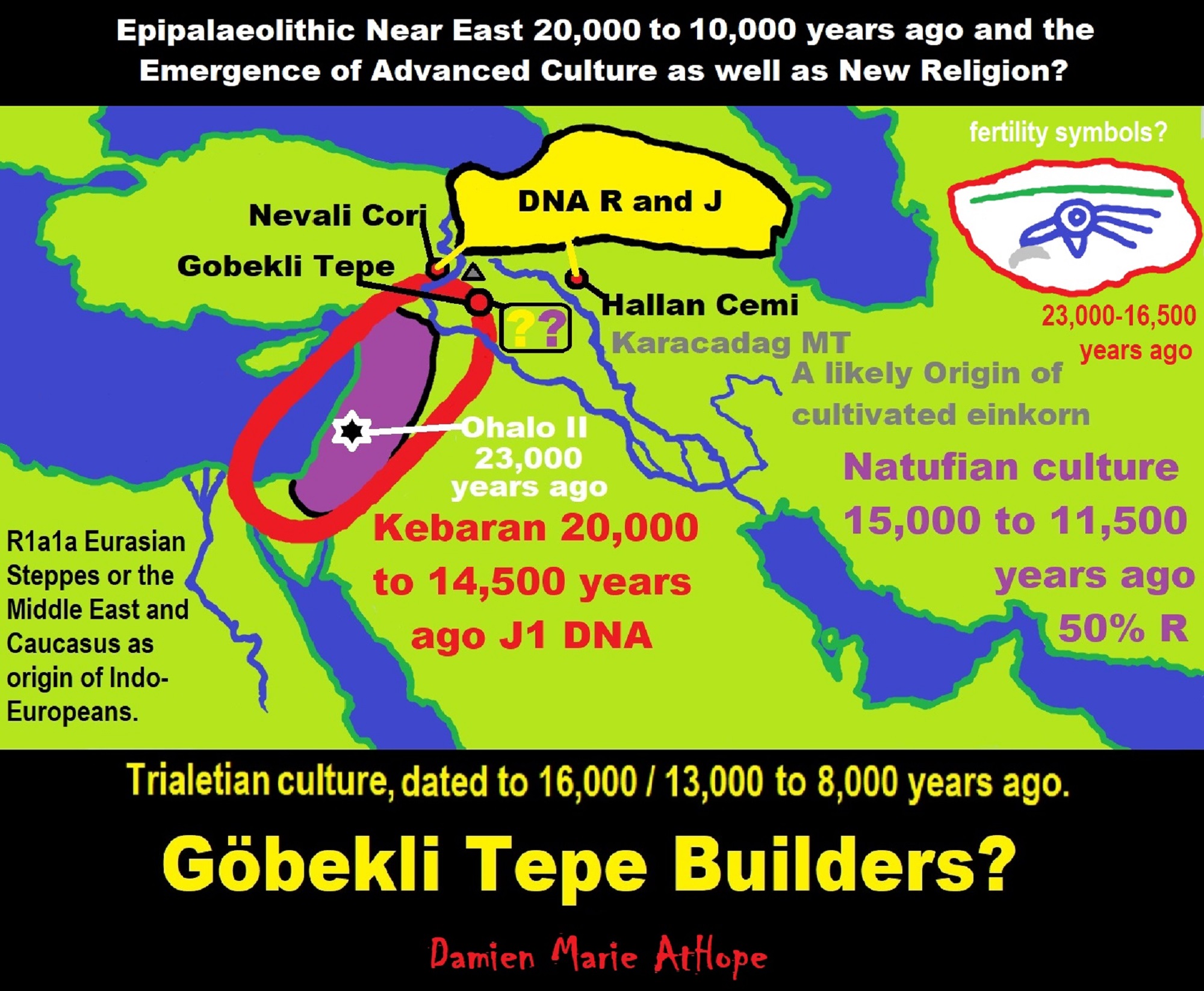
ref, ref, ref, ref, ref, ref, ref
Trialetian culture (16,000–8000 years ago) the Caucasus, Iran, and Turkey, likely involved in Göbekli Tepe. Migration 1?
Haplogroup R possible time of origin about 27,000 years in Central Asia, South Asia, or Siberia:
- Mal’ta–Buret’ culture (24,000-15,000 years ago)
- Afontova Gora culture (21,000-12,000 years ago)
- Trialetian culture (16,000–8000 years ago)
- Samara culture (7,000-6,500 years ago)
- Khvalynsk culture (7,000-6,500 years ago)
- Afanasievo culture (5,300-4,500 years ago)
- Yamna/Yamnaya Culture (5,300-4,500 years ago)
- Andronovo culture (4,000–2,900 years ago) ref
Trialetian sites
Caucasus and Transcaucasia:
- Edzani (Georgia)
- Chokh (Azerbaijan), layers E-C200
- Kotias Klde, layer B” ref
Eastern Anatolia:
- Hallan Çemi (from ca. 8.6-8.5k BC to 7.6-7.5k BCE)
- Nevali Çori shows some Trialetian admixture in a PPNB context” ref
Trialetian influences can also be found in:
- Cafer Höyük
- Boy Tepe” ref
Southeast of the Caspian Sea:
- Hotu (Iran)
- Ali Tepe (Iran) (from cal. 10,500 to 8,870 BCE)
- Belt Cave (Iran), layers 28-11 (the last remains date from ca. 6,000 BCE)
- Dam-Dam-Cheshme II (Turkmenistan), layers7,000-3,000 BCE)” ref

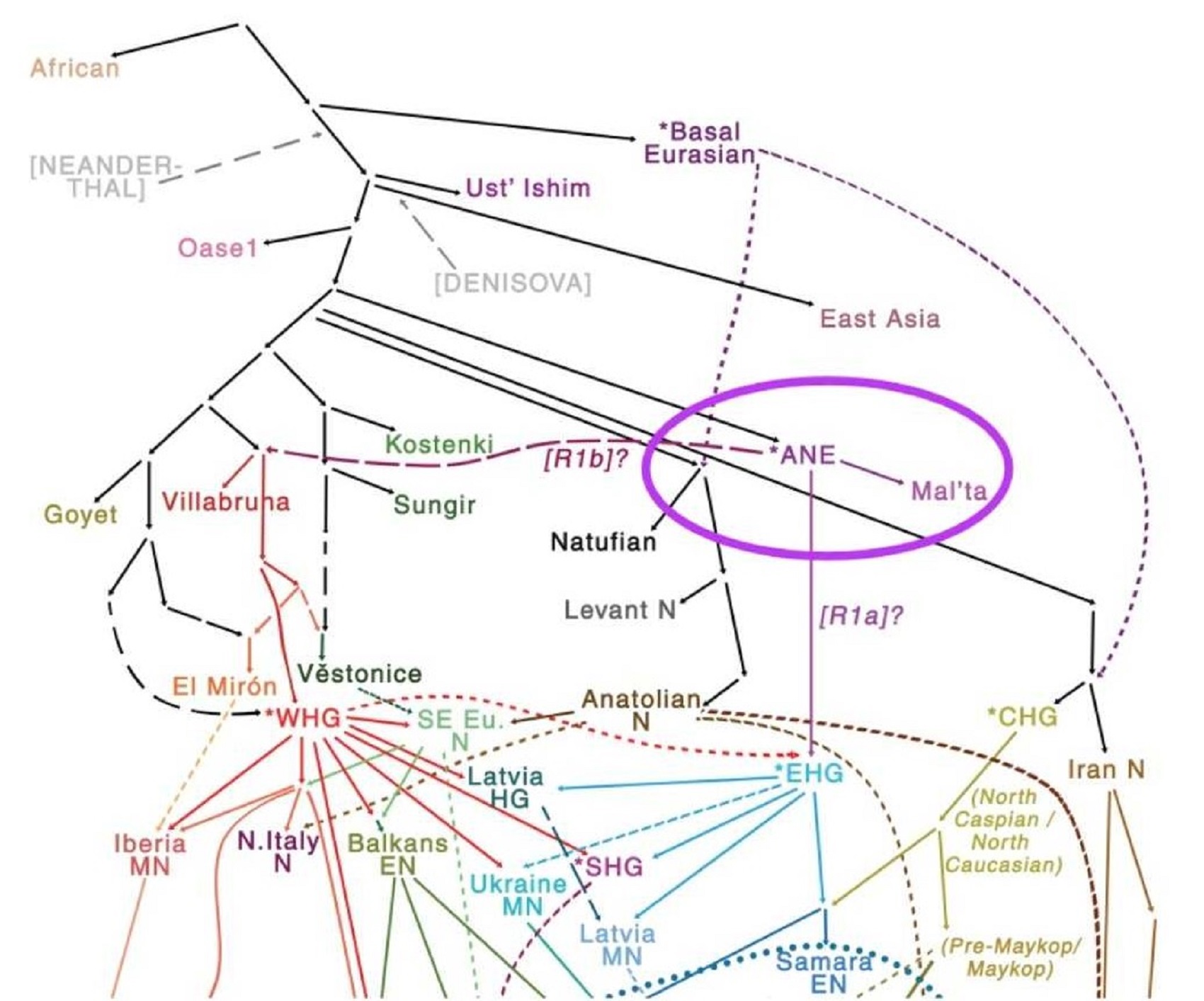
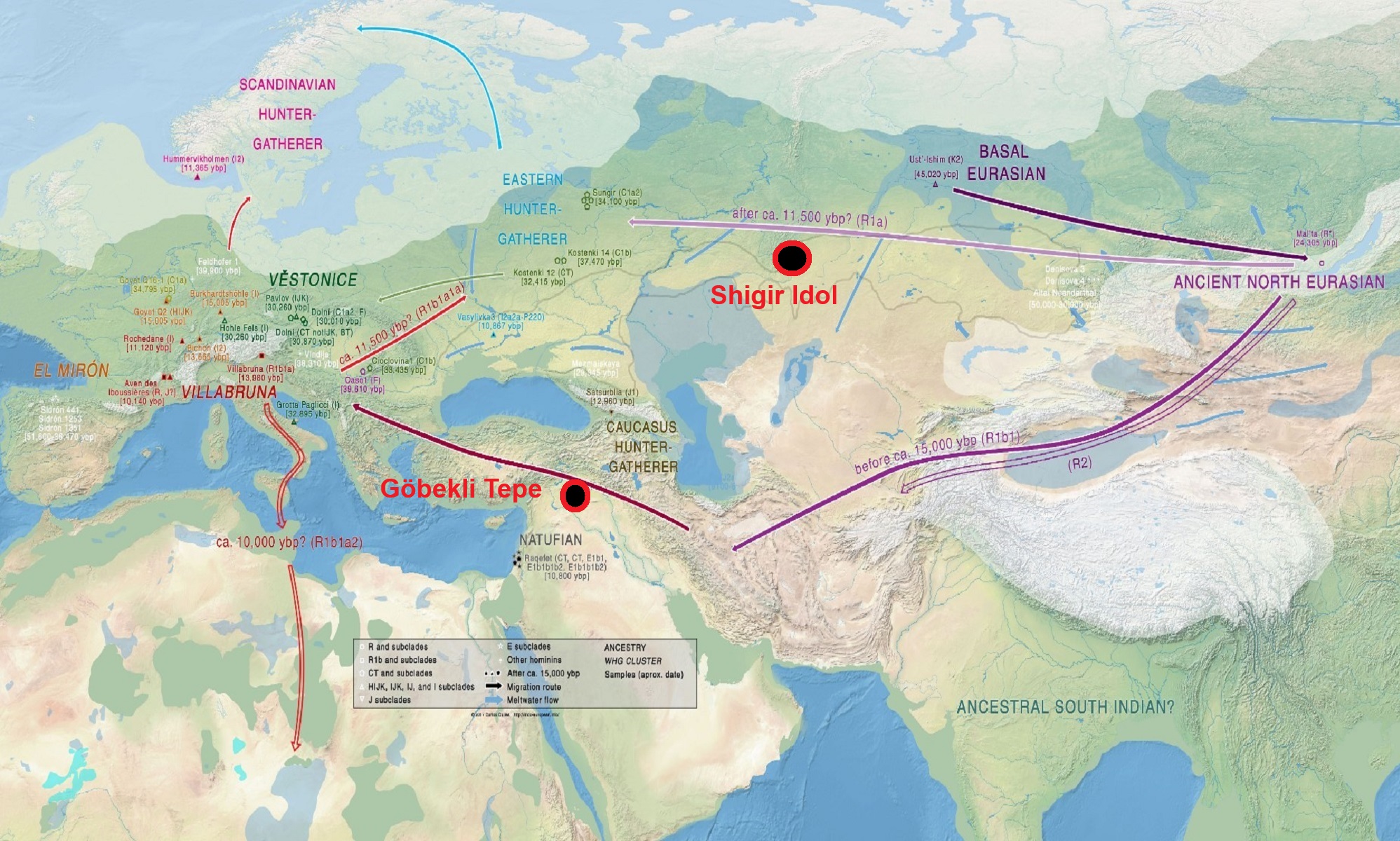
“Migration from Siberia behind the formation of Göbeklitepe: Expert states. People who migrated from Siberia formed the Göbeklitepe, and those in Göbeklitepe migrated in five other ways to spread to the world, said experts about the 12,000-year-old Neolithic archaeological site in the southwestern province of Şanlıurfa.“ The upper paleolithic migrations between Siberia and the Near East is a process that has been confirmed by material culture documents,” he said.” ref
“Semih Güneri, a retired professor from Caucasia and Central Asia Archaeology Research Center of Dokuz Eylül University, and his colleague, Professor Ekaterine Lipnina, presented the Siberia-Göbeklitepe hypothesis they have developed in recent years at the congress held in Istanbul between June 11 and 13. There was a migration that started from Siberia 30,000 years ago and spread to all of Asia and then to Eastern and Northern Europe, Güneri said at the international congress.” ref
“The relationship of Göbeklitepe high culture with the carriers of Siberian microblade stone tool technology is no longer a secret,” he said while emphasizing that the most important branch of the migrations extended to the Near East. “The results of the genetic analyzes of Iraq’s Zagros region confirm the traces of the Siberian/North Asian indigenous people, who arrived at Zagros via the Central Asian mountainous corridor and met with the Göbeklitepe culture via Northern Iraq,” he added.” ref
“Emphasizing that the stone tool technology was transported approximately 7,000 kilometers from east to west, he said, “It is not clear whether this technology is transmitted directly to long distances by people speaking the Turkish language at the earliest, or it travels this long-distance through using way stations.” According to the archaeological documents, it is known that the Siberian people had reached the Zagros region, he said. “There seems to be a relationship between Siberian hunter-gatherers and native Zagros hunter-gatherers,” Güneri said, adding that the results of genetic studies show that Siberian people reached as far as the Zagros.” ref
“There were three waves of migration of Turkish tribes from the Southern Siberia to Europe,” said Osman Karatay, a professor from Ege University. He added that most of the groups in the third wave, which took place between 2600-2400 BCE, assimilated and entered the Germanic tribes and that there was a genetic kinship between their tribes and the Turks. The professor also pointed out that there are indications that there is a technology and tool transfer from Siberia to the Göbeklitepe region and that it is not known whether people came, and if any, whether they were Turkish.” ref
“Around 12,000 years ago, there would be no ‘Turks’ as we know it today. However, there may have been tribes that we could call our ‘common ancestors,’” he added. “Talking about 30,000 years ago, it is impossible to identify and classify nations in today’s terms,” said Murat Öztürk, associate professor from İnönü University. He also said that it is not possible to determine who came to where during the migrations that were accepted to have been made thousands of years ago from Siberia. On the other hand, Mehmet Özdoğan, an academic from Istanbul University, has an idea of where “the people of Göbeklitepe migrated to.” ref
“According to Özdoğan, “the people of Göbeklitepe turned into farmers, and they could not stand the pressure of the overwhelming clergy and started to migrate to five ways.” “Migrations take place primarily in groups. One of the five routes extends to the Caucasus, another from Iran to Central Asia, the Mediterranean coast to Spain, Thrace and [the northwestern province of] Kırklareli to Europe and England, and one route is to Istanbul via [Istanbul’s neighboring province of] Sakarya and stops,” Özdoğan said. In a very short time after the migration of farmers in Göbeklitepe, 300 settlements were established only around northern Greece, Bulgaria, and Thrace. “Those who remained in Göbeklitepe pulled the trigger of Mesopotamian civilization in the following periods, and those who migrated to Mesopotamia started irrigated agriculture before the Sumerians,” he said.” ref
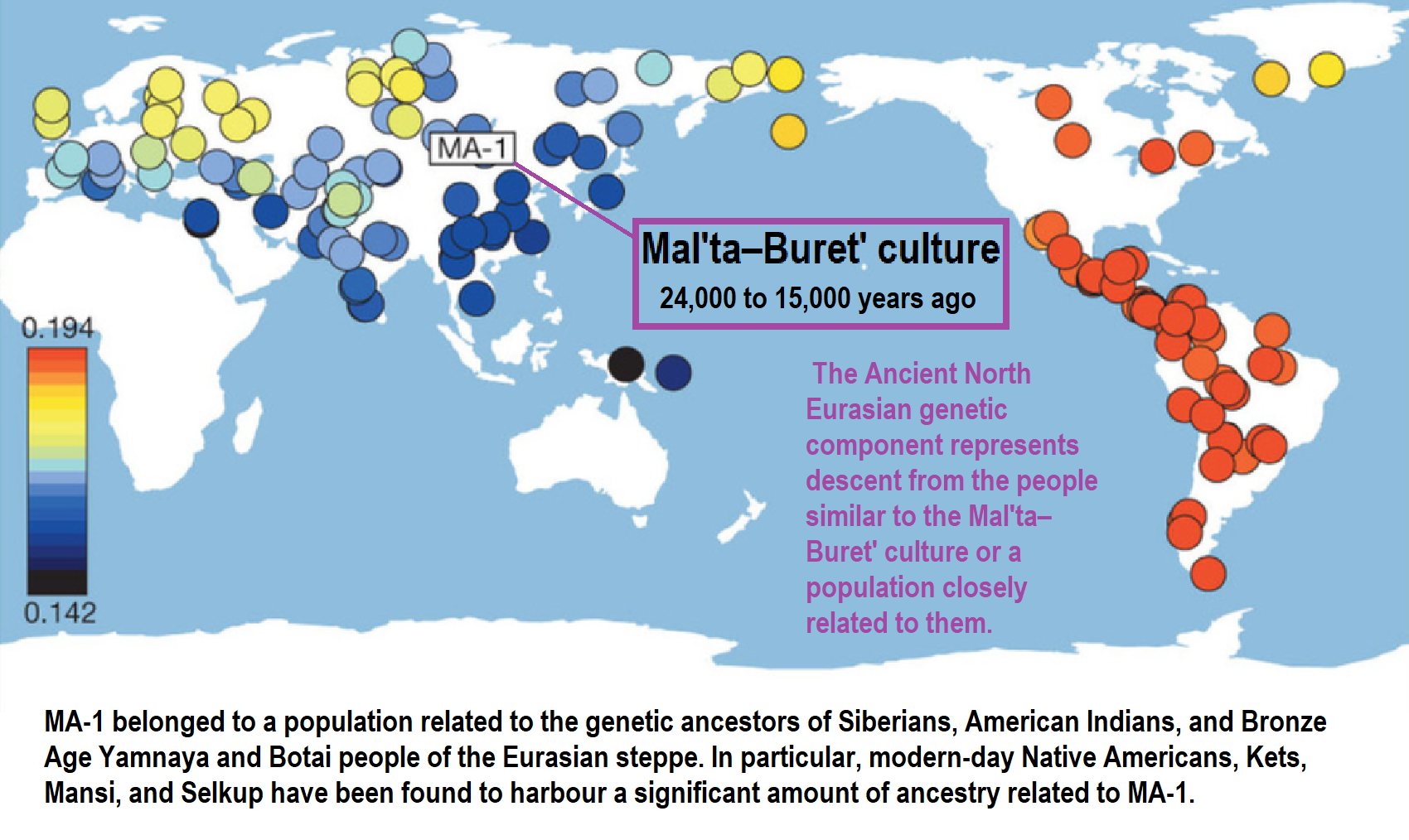
“MA-1 genetic affinities of Mal’ta–Buret’ culture.” ref
Mal’ta–Buret’ culture of Siberia near Lake Baikal
“The Mal’ta–Buret’ culture is an archaeological culture of c. 24,000 to 15,000 years ago in the Upper Paleolithic on the upper Angara River in the area west of Lake Baikal in the Irkutsk Oblast, Siberia, Russian Federation. The type sites are named for the villages of Mal’ta, Usolsky District, and Buret’, Bokhansky District (both in Irkutsk Oblast). And a buried boy whose remains were found near Mal’ta is usually known by the abbreviation MA-1, remains have been dated to 24,000 years ago. According to research published since 2013, MA-1 belonged to a population related to the genetic ancestors of Siberians, American Indians, and Bronze Age Yamnaya and Botai people of the Eurasian steppe. In particular, modern-day Native Americans, Kets, Mansi, and Selkup have been found to harbor a significant amount of ancestry related to MA-1.” ref
“MA-1 is the only known example of basal Y-DNA R* (R-M207*) – that is, the only member of haplogroup R* that did not belong to haplogroups R1, R2, or secondary subclades of these. The mitochondrial DNA of MA-1 belonged to an unresolved subclade of haplogroup U. The term Ancient North Eurasian (ANE) has been given in genetic literature to an ancestral component that represents descent from the people similar to the Mal’ta–Buret’ culture or a population closely related to them. A people similar to MA1 and Afontova Gora were important genetic contributors to Native Americans, Siberians, Northeastern Europeans, Caucasians, Central Asians, with smaller contributions to Middle Easterners and some East Asians. Lazaridis et al. (2016) notes “a cline of ANE ancestry across the east-west extent of Eurasia.” MA1 is also related to two older Upper Paleolithic Siberian individuals found at the Yana Rhinoceros Horn Site called Ancient North Siberians (ANS).” ref
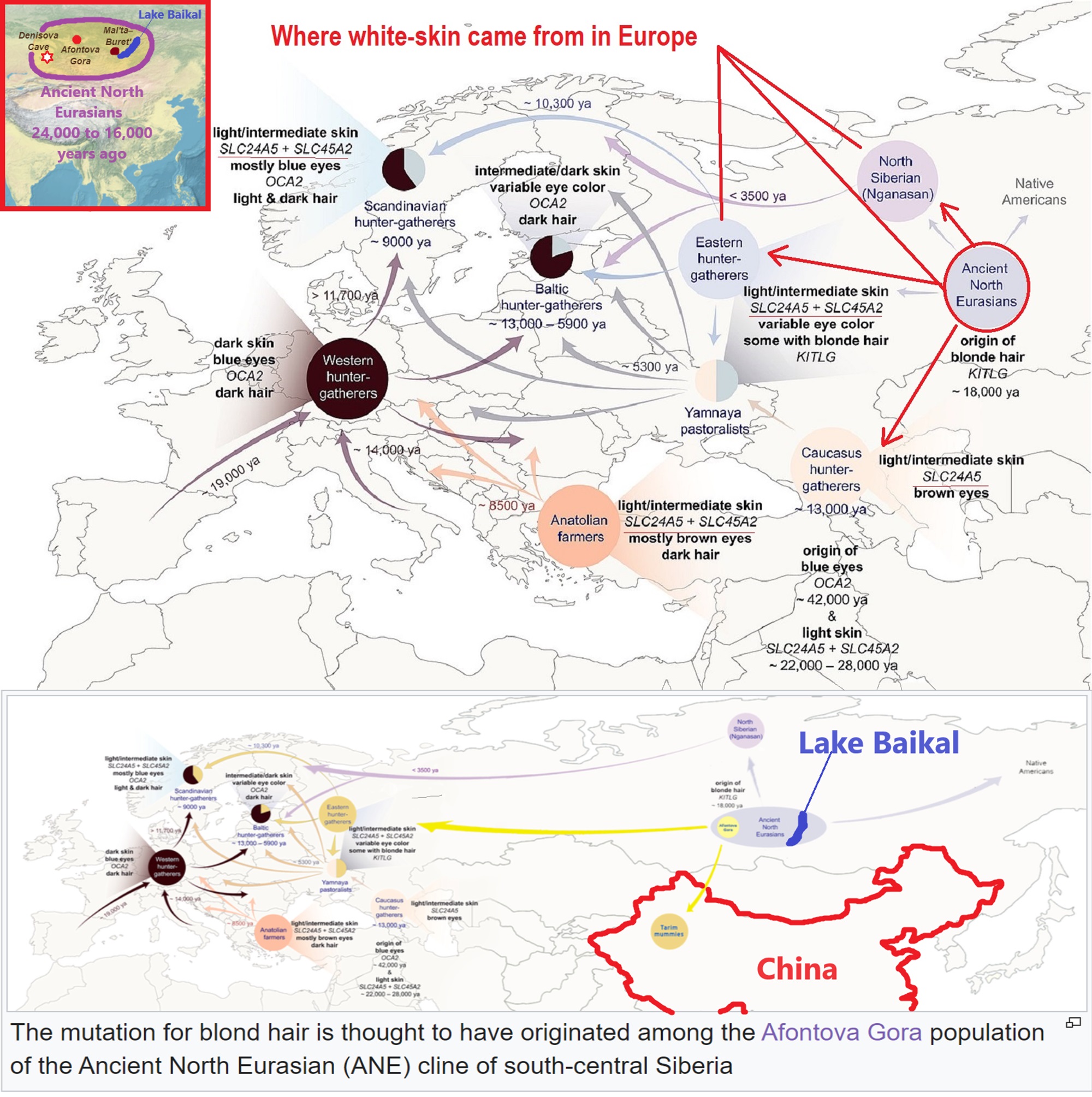
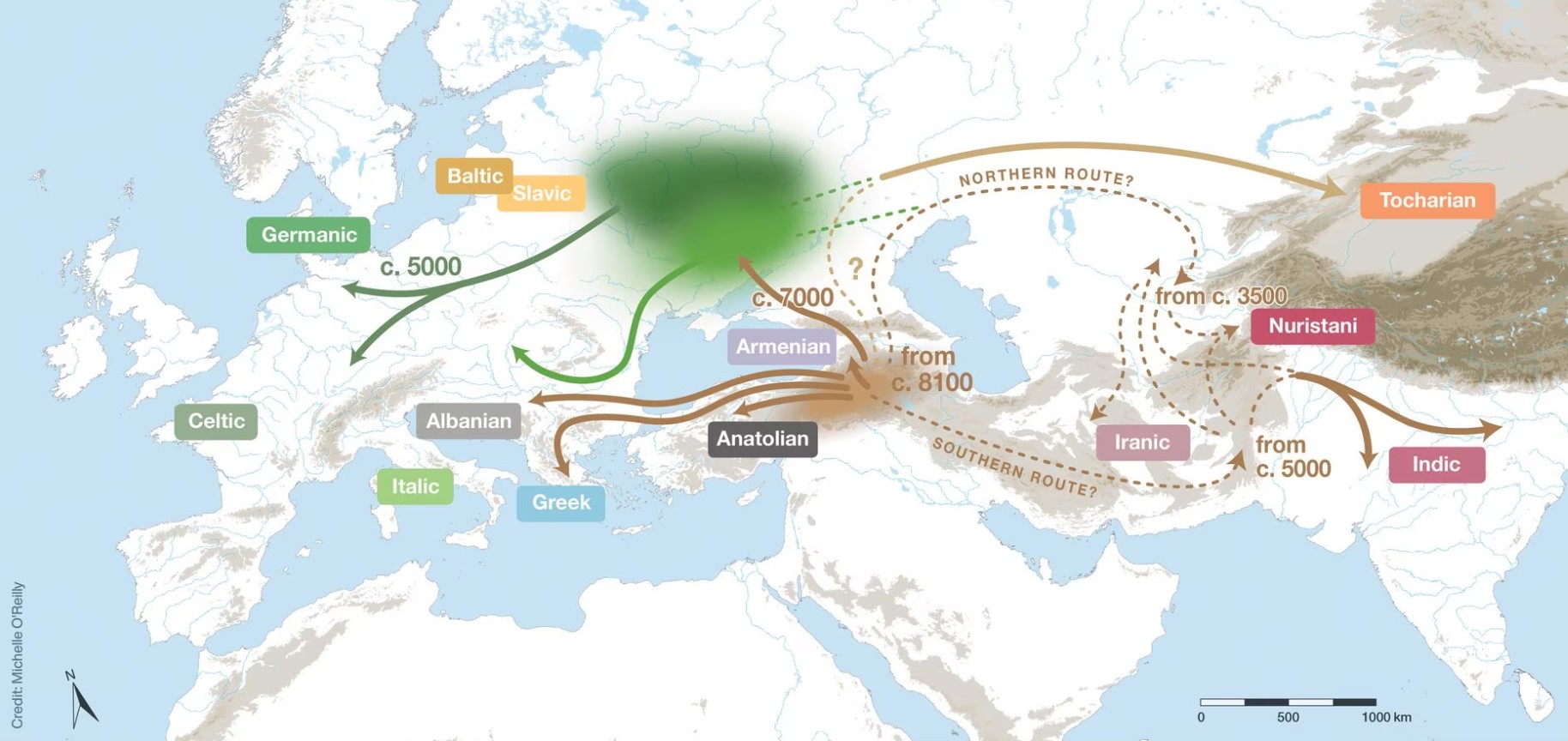
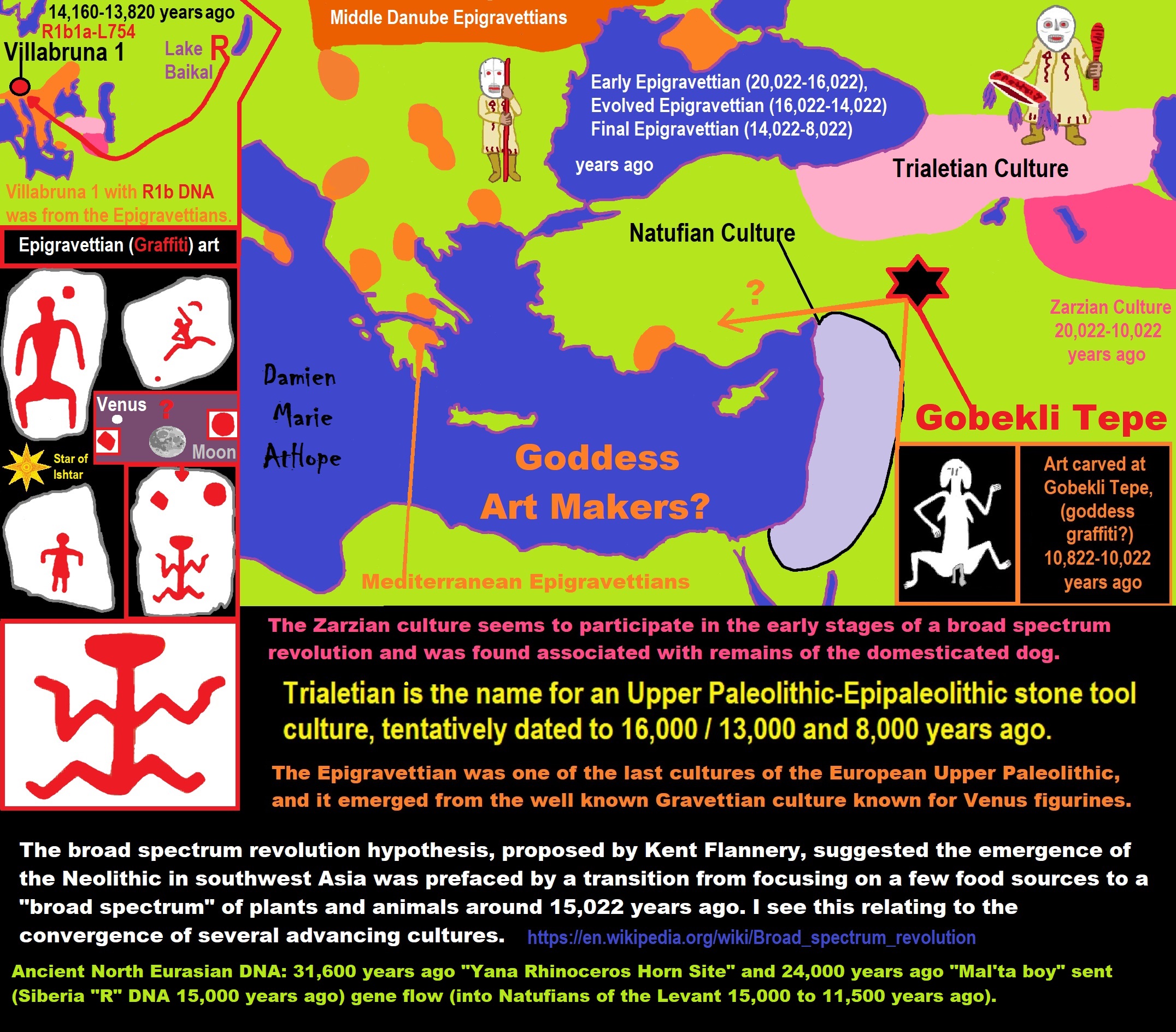
ref, ref, ref, ref, ref, ref, ref, ref, ref, ref, ref, ref, ref, ref, ref
Trialetian peoples which I think we’re more male-centric and involved in the creation of Göbekli Tepe, from its start around Pre-Pottery Neolithic A (12,000 – 10,800 years ago) began with their influence and this is seen in animal deities many clearly male and the figures also being expressively male themed as well at first, and only around Pre-Pottery Neolithic B (10,800 – 8,500 years ago) or so it seems with what I am guessing is new Epigravettian peoples with a more female-centric style (reminiscent but less than the Gravettians known for Venus figurines) influence from migration into the region, to gain new themes that add a female element both with A totem pole seeming to express birth or something similar and graffiti of a woman either ready for sex or giving birth or both. and Other bare figures seem to show a similar body position reminiscent of the graffiti of a woman.
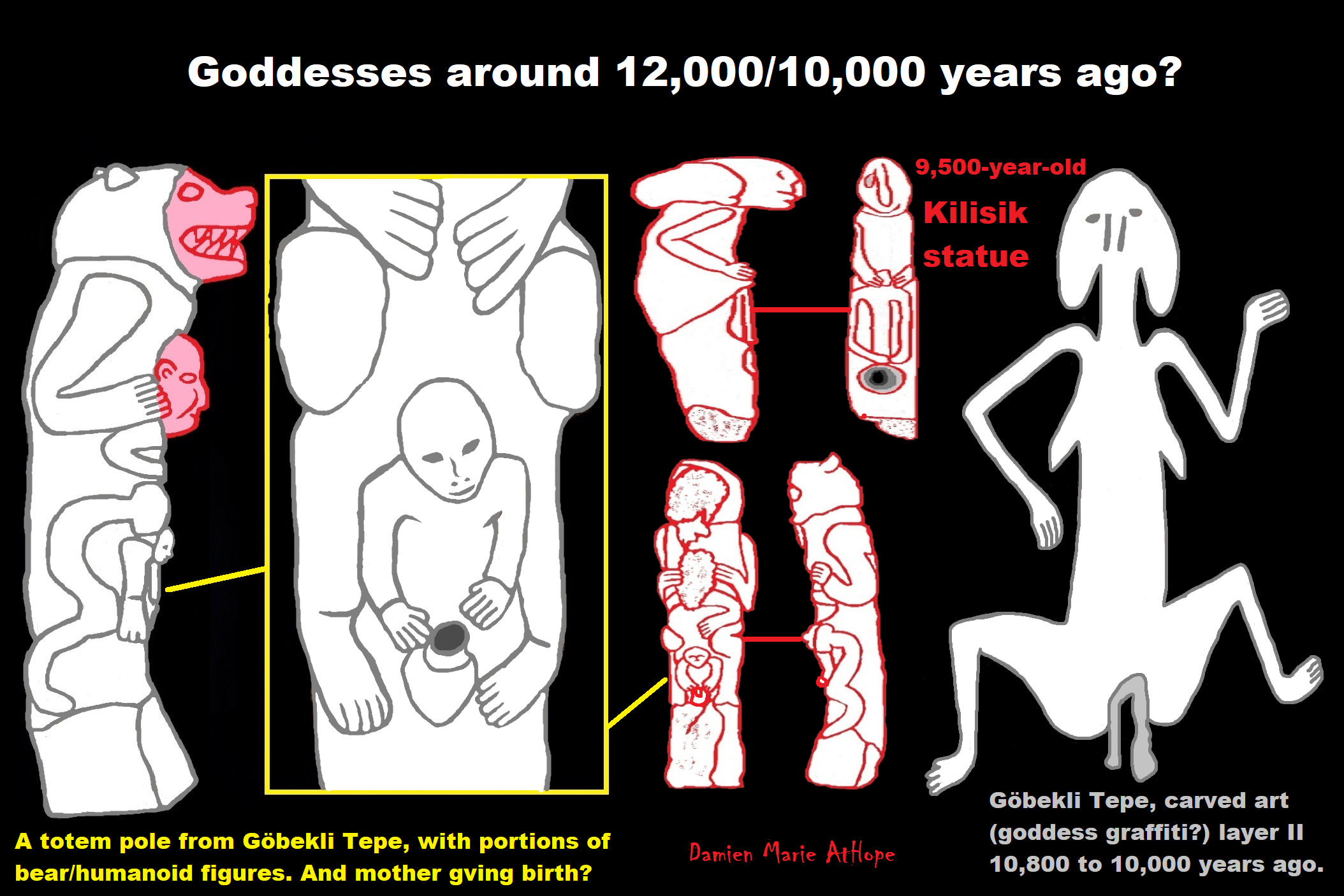

ref, ref, ref, ref, ref, ref, ref, ref, ref, ref
Lajja Gauri Style
- Lajja Gauri. China, Majiayao. 3,200-2,000 BCE or around 5,220 to 4,020 years ago. ref
- Lajja Gauri. India, Kashmir. ref
- Lajja Gauri. Egypt. ref
- Lajjā Gaurī a lotus-headed Hindu goddess. ref
- Lajja Gauri. Nepal. ref
- Lajjā Gaurī lotus-headed goddess. India. ref
Sheela na gig Style
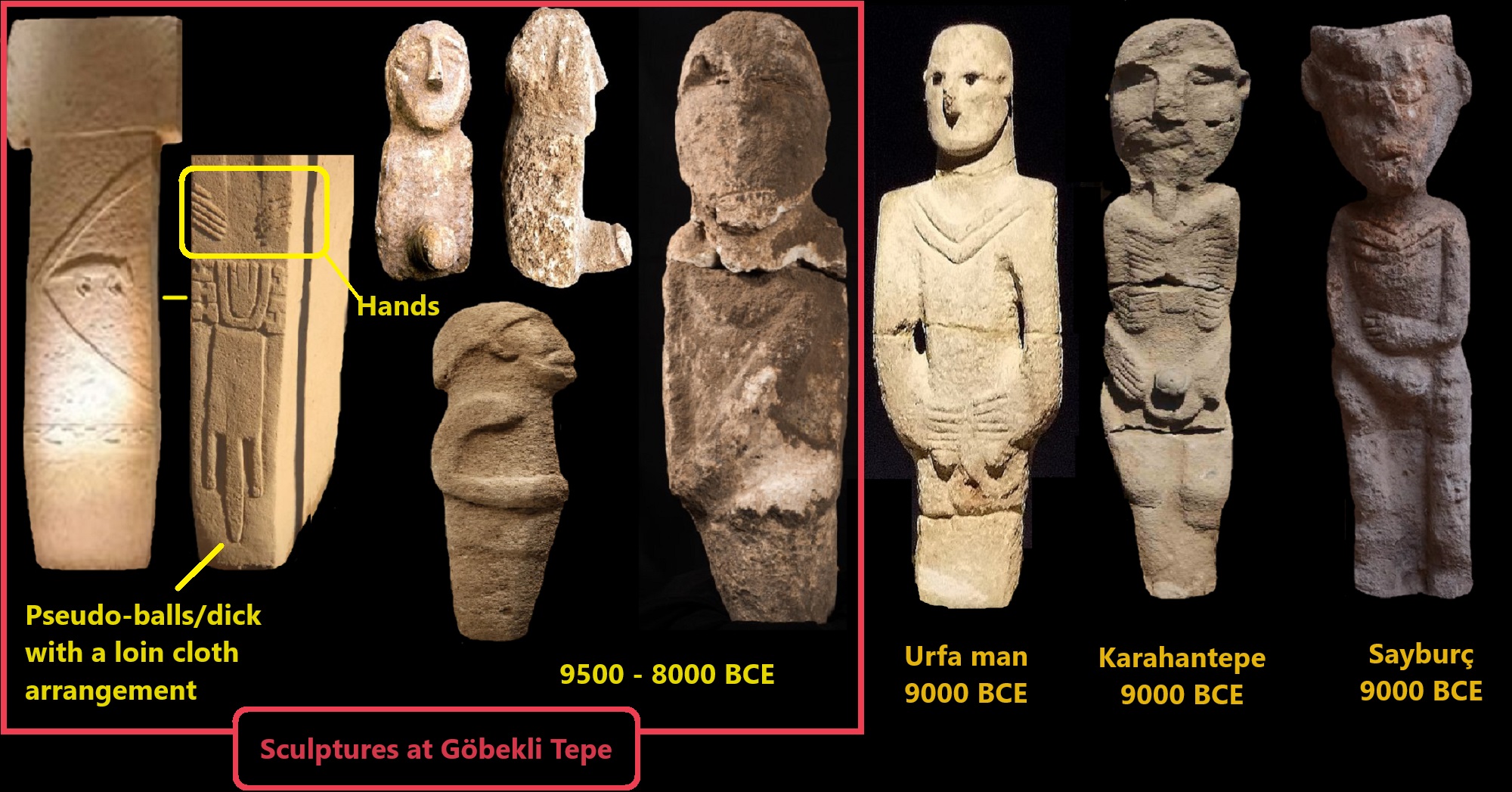
ref, ref, ref, ref, ref, ref, ref
Similarities were Similarities discovered at Göbeklitepe and Karahantepe, as well as others.
With Gobecli Tepe starts to me the male clan leader cult that later turns into the warrior cult and later kings and all this in the new hierarchies that emerged with agriculture and the ability to hoard wealth. “slavery became widespread only with agriculture 11,000 years ago.” ref
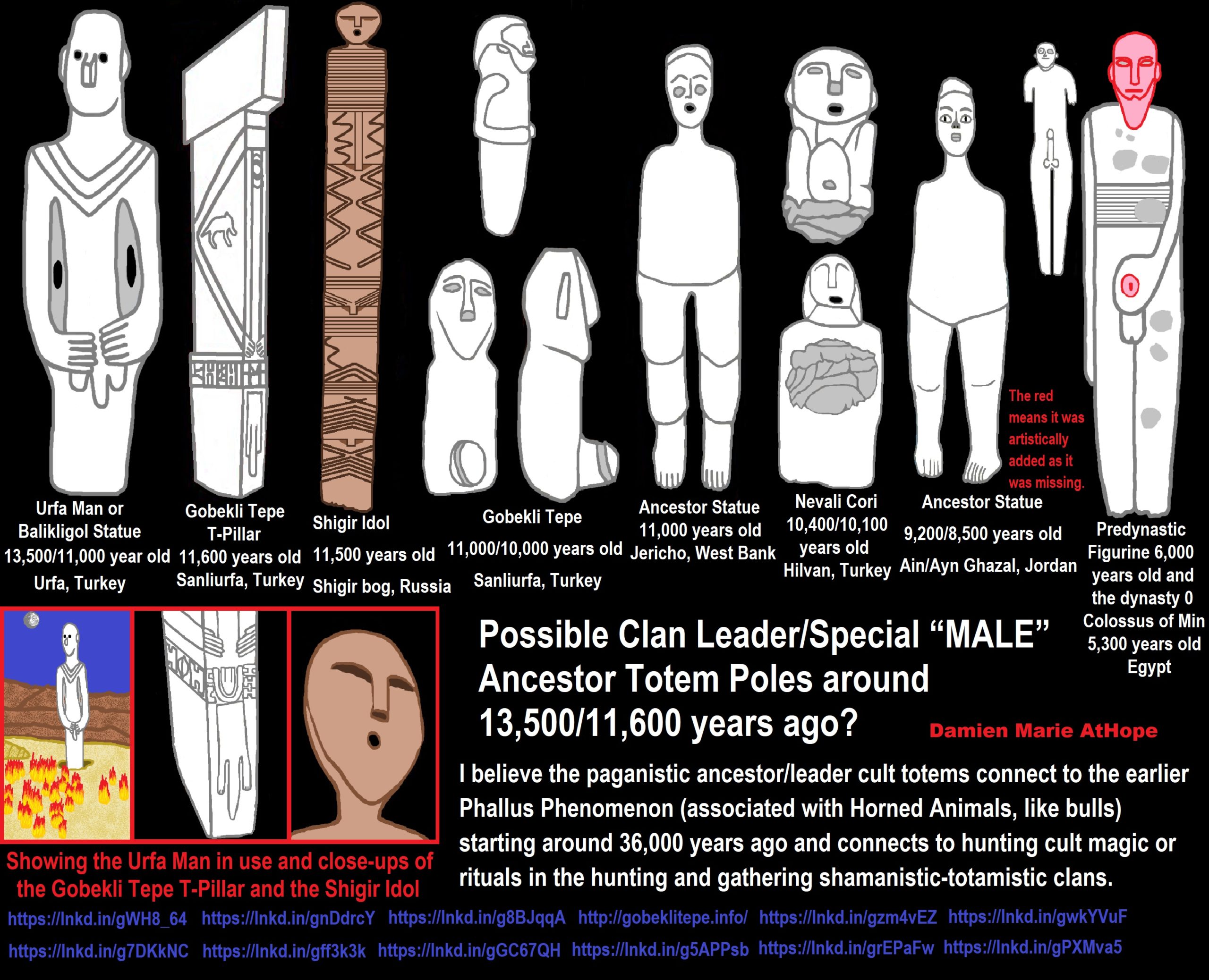
ref, ref, ref, ref, ref, ref, ref, ref, ref, ref, ref, ref, ref
I believe the paganistic ancestor/leader cult totems connect to the earlier Phallus Phenomenon (associated with Horned Animals, like bulls) starting around 36,000 years ago and connects to hunting cult magic or rituals in the hunting and gathering shamanistic-totamistic clans.
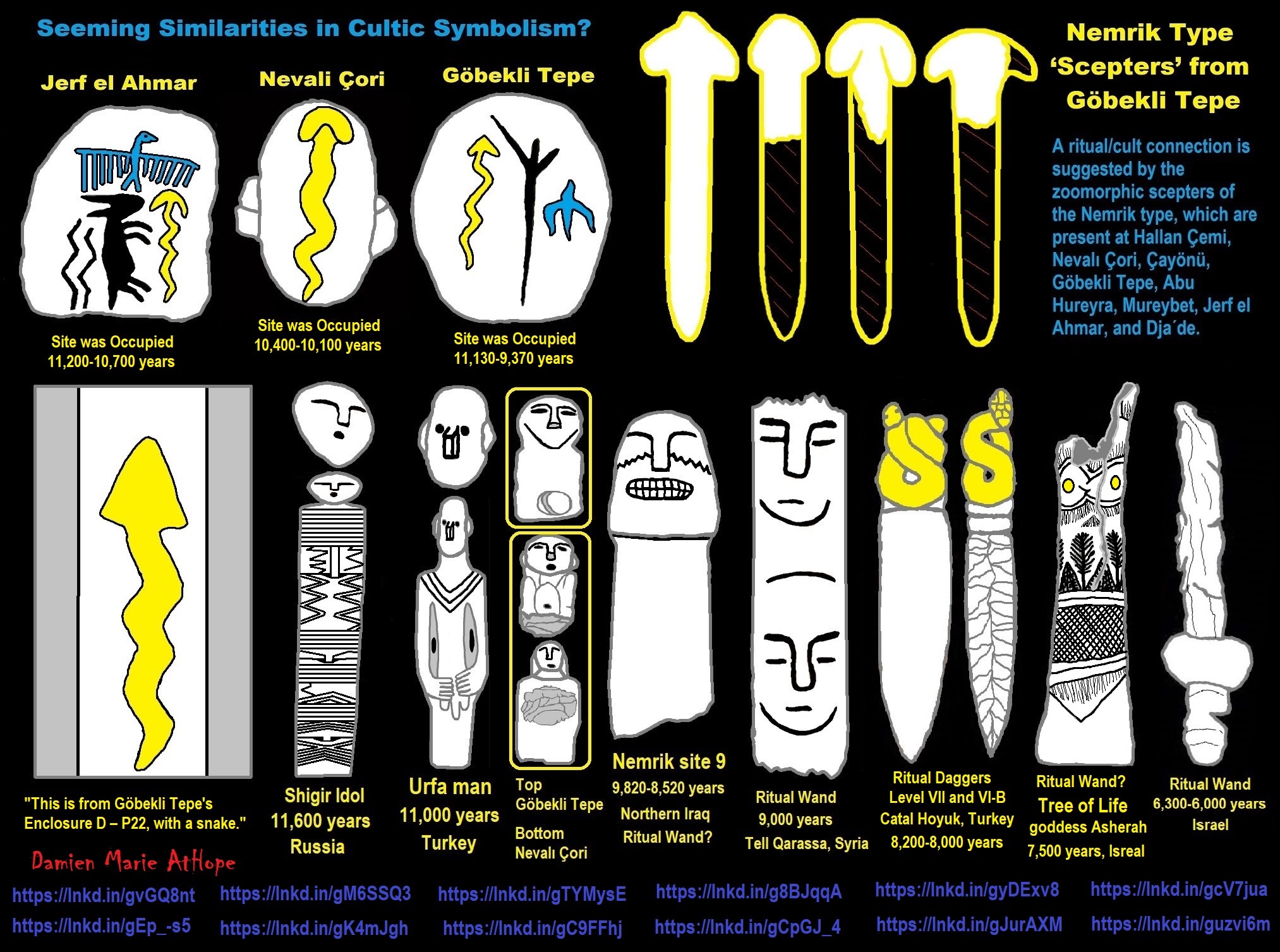
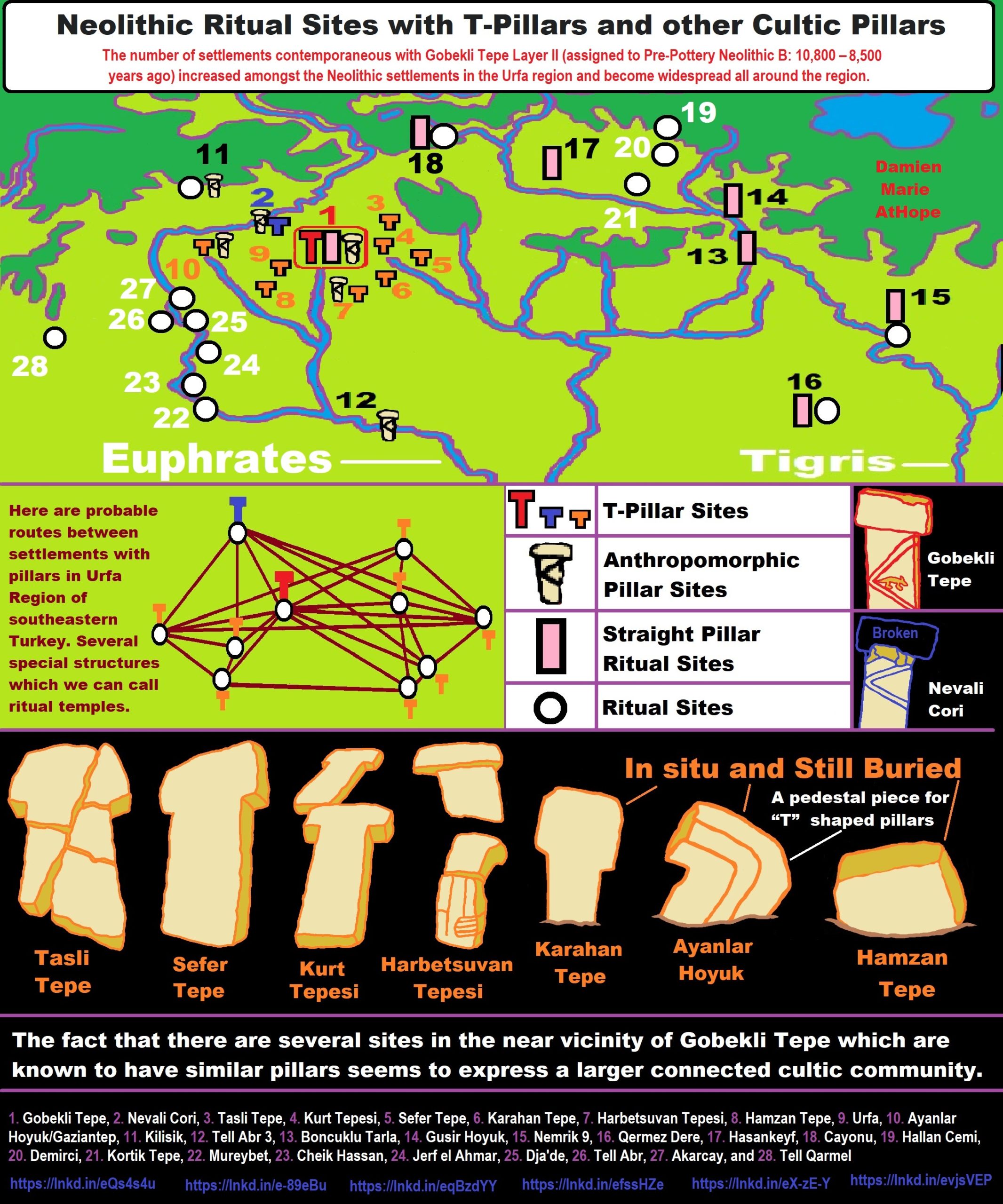
The number of settlements contemporaneous with Gobekli Tepe Layer II (assigned to Pre-Pottery Neolithic B: 10,800 – 8,500 years ago) increased amongst the Neolithic settlements in the Urfa region and become widespread all around the region.
- Gobekli Tepe, 2. Nevali Cori, 3. Tasli Tepe, 4. Kurt Tepesi, 5. Sefer Tepe, 6. Karahan Tepe, 7. Harbetsuvan Tepesi, 8. Hamzan Tepe, 9. Urfa, 10. Ayanlar Hoyuk/Gaziantep, 11. Kilisik, 12. Tell Abr 3, 13. Boncuklu Tarla, 14. Gusir Hoyuk, 15. Nemrik 9, 16. Qermez Dere, 17. Hasankeyf, 18. Cayonu, 19. Hallan Cemi, 20. Demirci, 21. Kortik Tepe, 22. Mureybet, 23. Cheik Hassan, 24. Jerf el Ahmar, 25. Dja’de, 26. Tell Abr, 27. Akarcay, and 28. Tell Qarmel
Göbekli Tepe is not alone, in fact, it is part of a religious/cultural connected ritual culture in the general region. There are several other similar sites with similar T-pillars to Göbekli Tepe or other types of stone pillar providing a seeming connected cult belief or religious culture of pillars seen in the PPNA-PPNB in the northern portion of the Near East.
“The locations of the sites that contain “T” shaped pillars are the main topic that needs more understanding to grasp the larger sociocultural-religious cultural complex in the same general region. Another matter under discussion is to comprehend the differences between the small-scale settlements that contain cult centers and “T” shaped pillars and the larger ones found at Gobekli Tepe layer III. The fact that settlements with “T” shaped pillars contain both the remains of circular domestic buildings and the pillars such as seen at Cayonu and Nevali Cori, which are also known to contain cult and domestic buildings. It is contemplated that such settlements are contemporary with Gobekli Tepe layer II and the cult building known from Nevali Cori based on the similarities and differences of the “T” shaped pillars. In the light of the finds unearthed from the settlements in Şanliurfa region that contain “T” shaped pillars, such settlements should be dated to the end of Late Pre-Pottery Neolithic A (LPPNA) and the Early Pre-Pottery Neolithic B (EPPNB).” ref

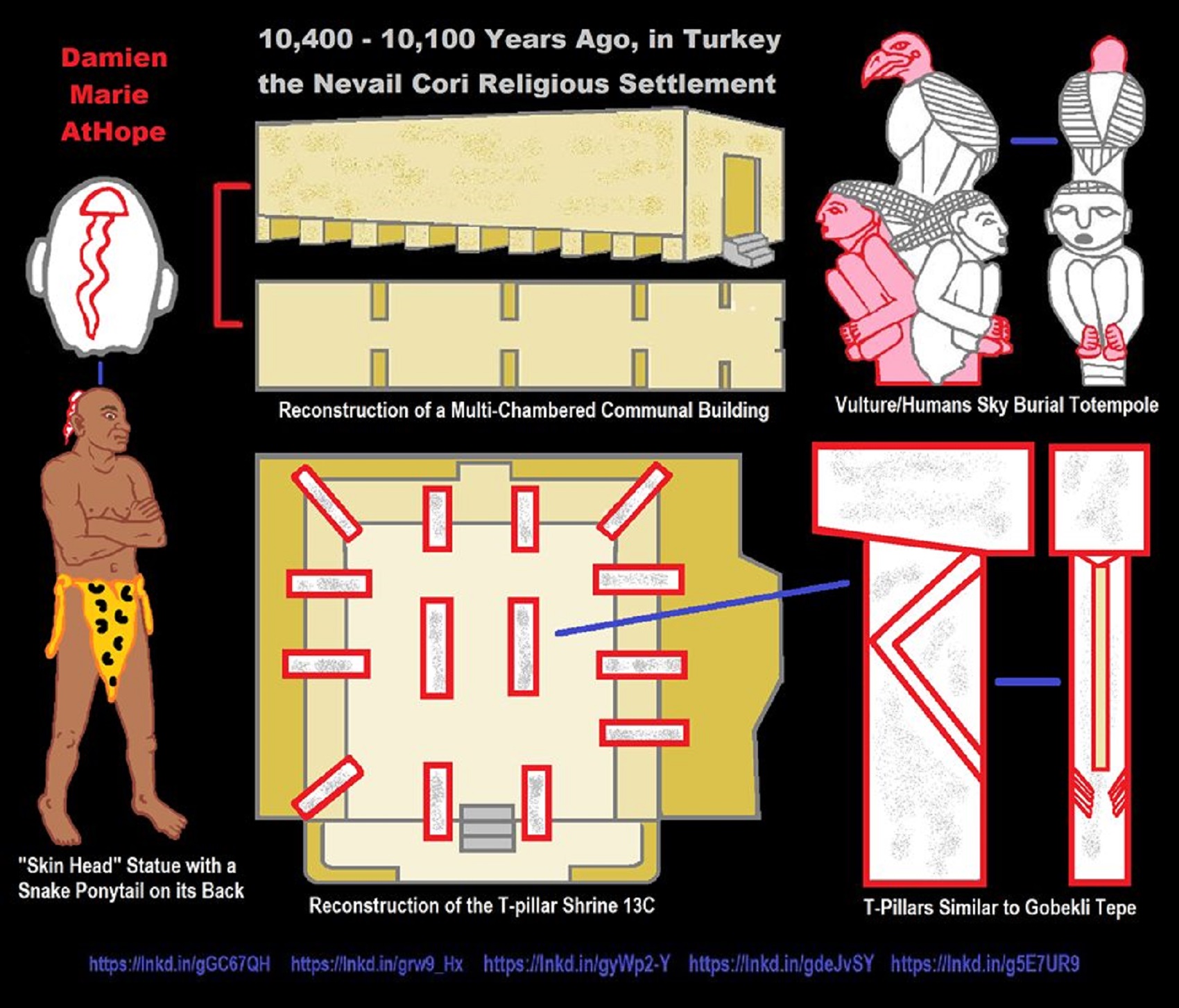
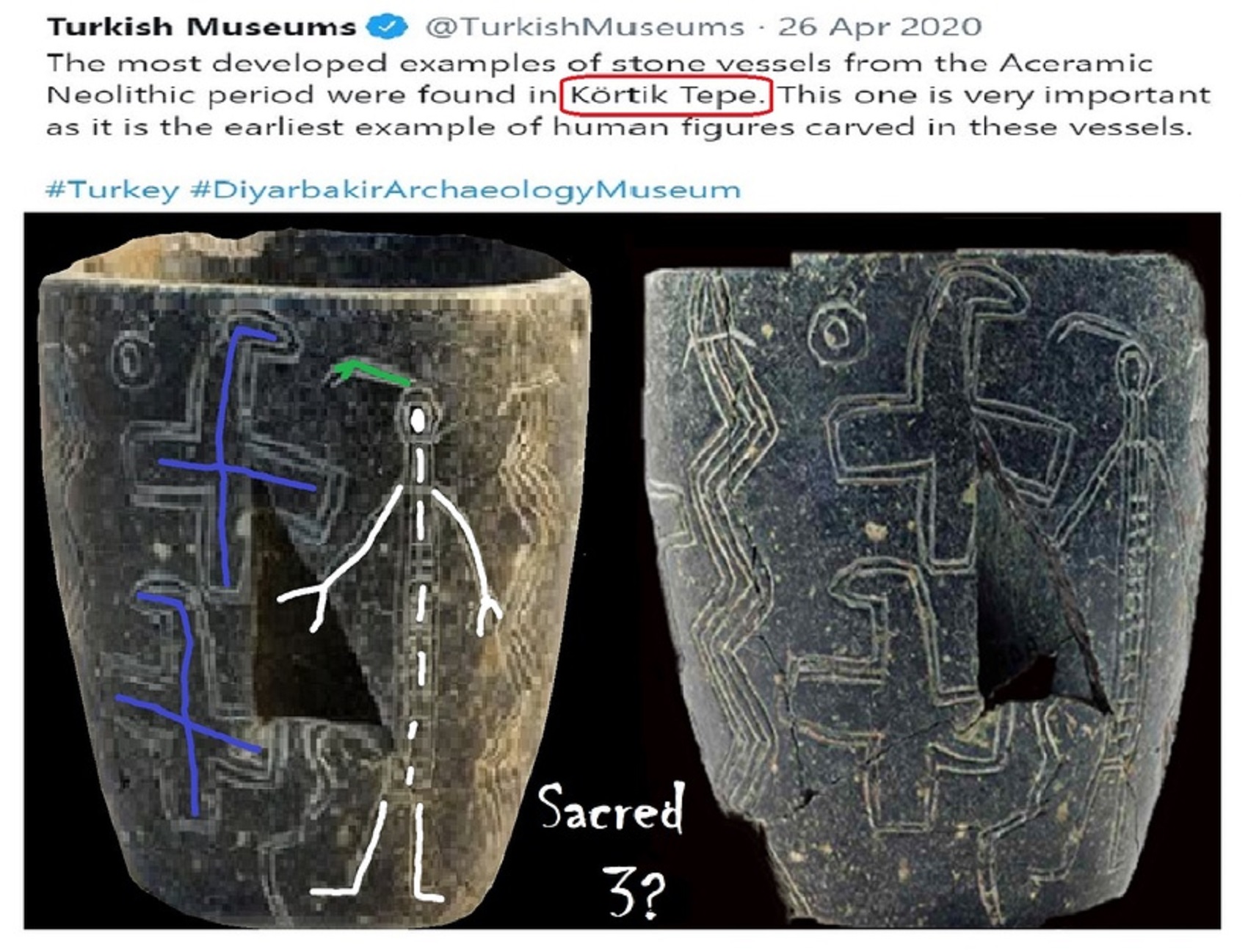
@TurkishMuseums, also shared on @MattSibson ref
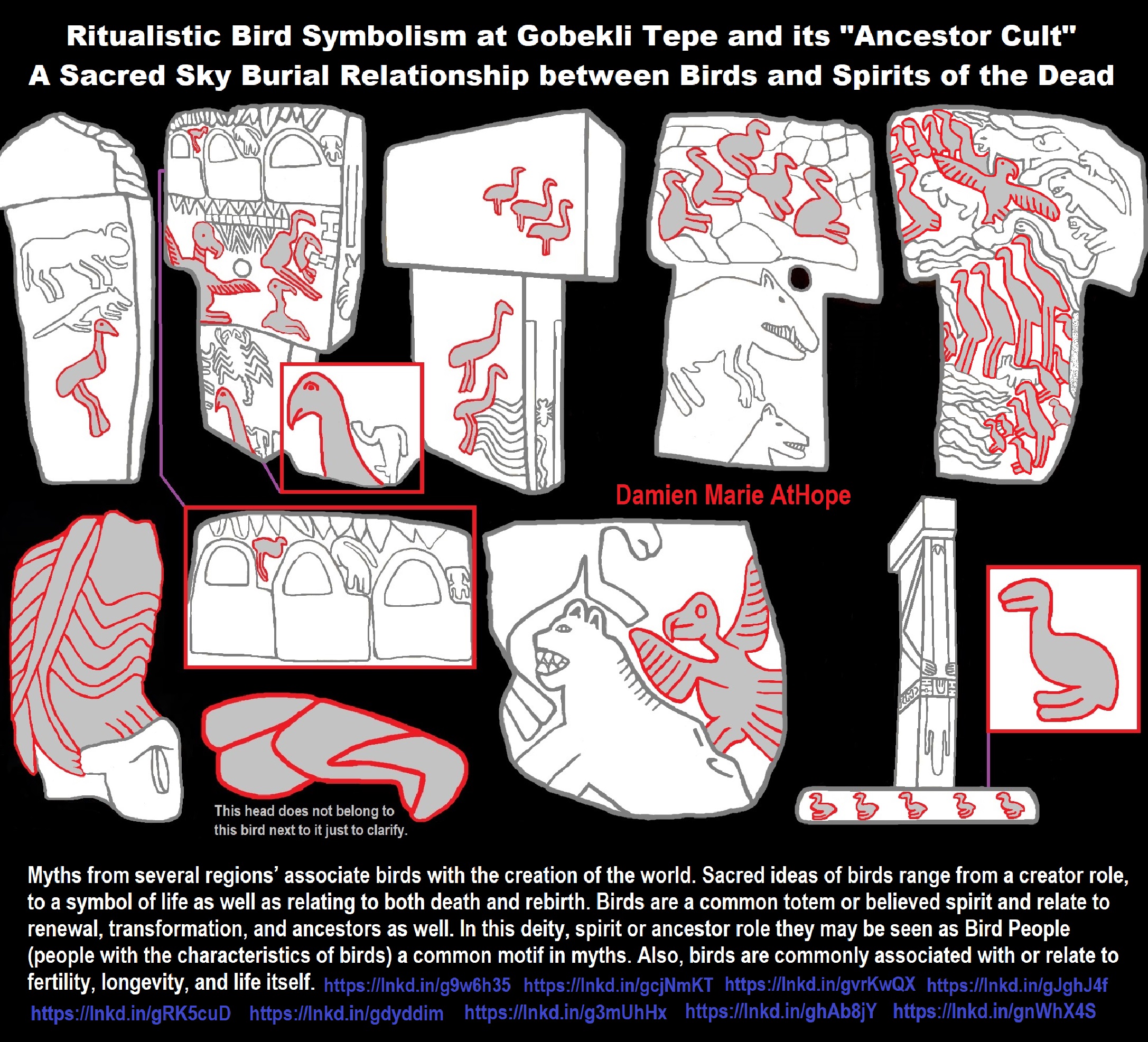
ref, ref, ref, ref, ref, ref, ref, ref, ref, ref, ref, ref, ref, ref, ref, ref, ref
Gobekli Tepe: “first human made temple” around 12,000 years ago
Ritualistic Bird Symbolism at Gobekli Tepe and its “Ancestor Cult” a Sacred Sky Burial Relationship between Birds and Spirits of the Dead
Myths from several regions’ associate birds with the creation of the world. Sacred ideas of birds range from a creator role, to a symbol of life as well as relating to both death and rebirth. Birds are a common totem or believed spirit and relate to renewal, transformation, and ancestors as well. In this deity, spirit or ancestor role they may be seen as Bird People (people with the characteristics of birds) a common motif in myths. Also, birds are commonly associated with or relate to fertility, longevity, and life itself.
Skulls From 11,500-year Ancestor Cult Found in Oldest Temple in the World
“Carved skulls indicate that Gobekli Tepe, known for enigmatic monumental pillars carved with animals and shapes, was ancestor worship site.” ref
“Ancestor Cult: a ritualistic system of veneration, honor, and propitiation of the spirits of dead ancestors for the purpose of avoiding evil consequences and securing good fortune.” ref
“Ancestor worship: the custom of venerating deceased ancestors who are considered still a part of the family and whose spirits are believed to have the power to intervene in the affairs of the living.” ref
“Veneration of the dead, including one’s ancestors, is based on love and respect for the deceased. In some cultures, it is related to beliefs that the dead have a continued existence, and may possess the ability to influence the fortune of the living. Some groups venerate their direct, familial ancestors. Certain sects and religions, in particular the Roman Catholic Church, venerate saints as intercessors with God, as well as pray for departed souls in Purgatory. In Europe, Asia, Oceania, African and Afro-diasporic cultures, the goal of ancestor veneration is to ensure the ancestors’ continued well-being and positive disposition towards the living, and sometimes to ask for special favors or assistance. The social or non-religious function of ancestor veneration is to cultivate kinship values, such as filial piety, family loyalty, and continuity of the family lineage. Ancestor veneration occurs in societies with every degree of social, political, and technological complexity, and it remains an important component of various religious practices in modern times.” ref
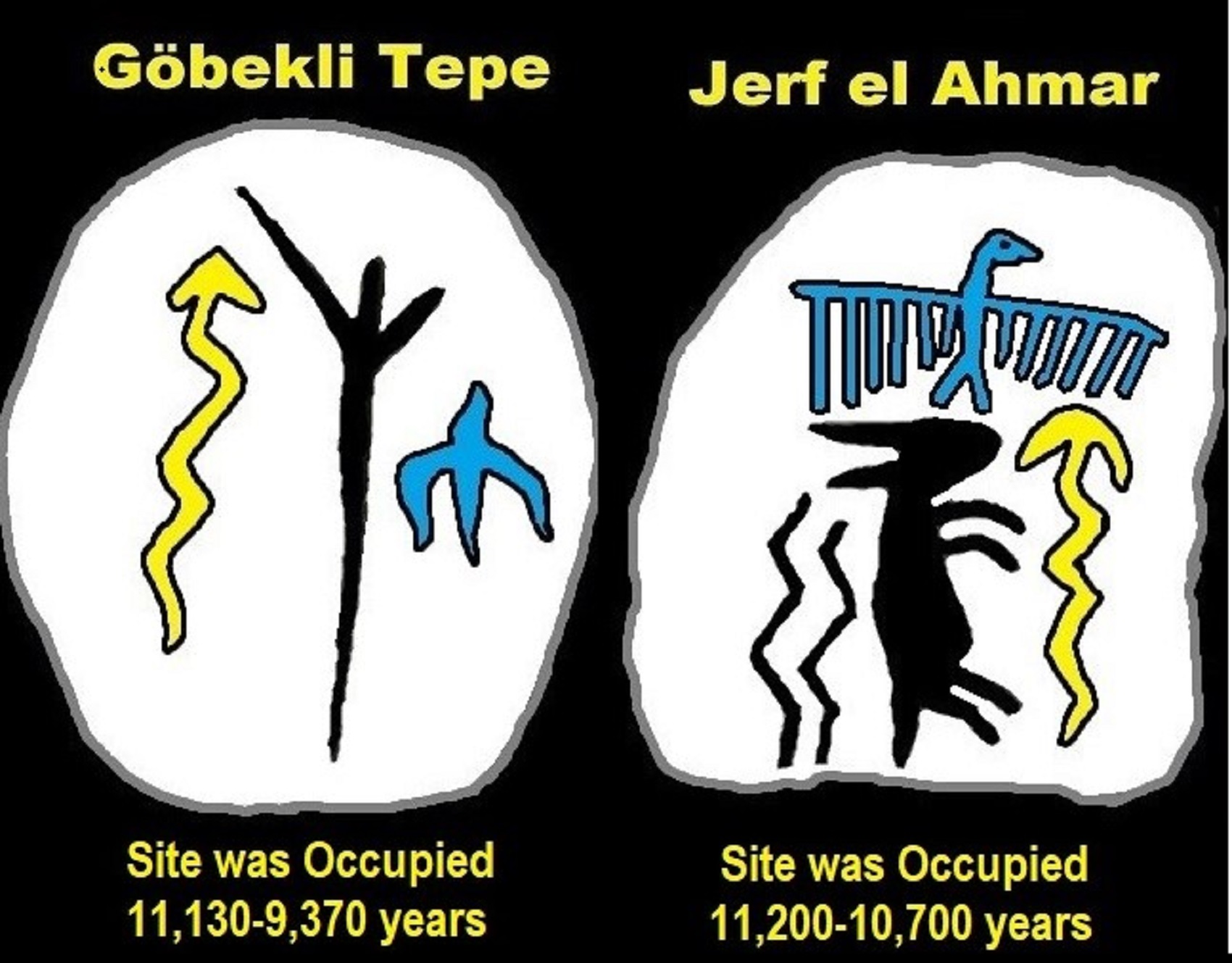
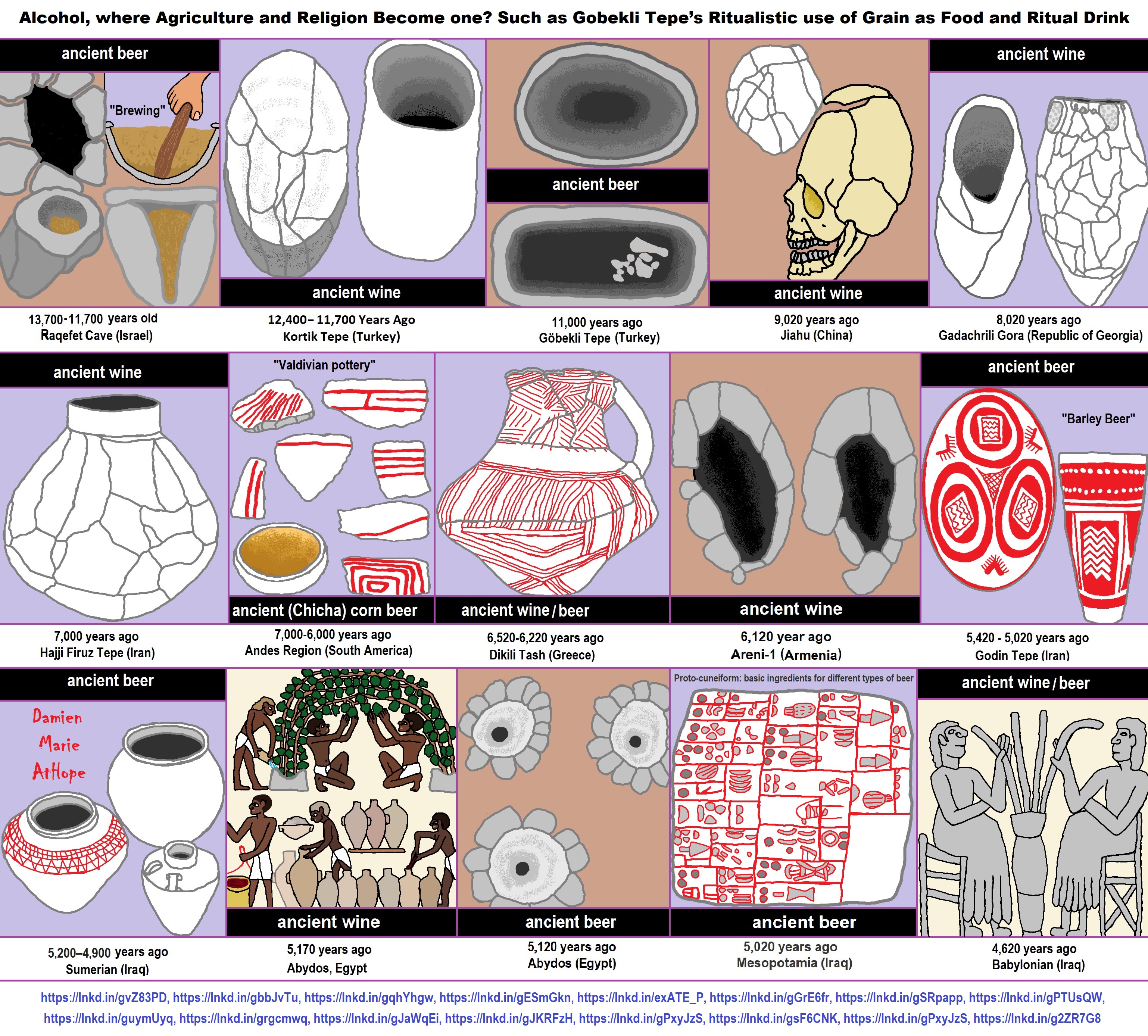
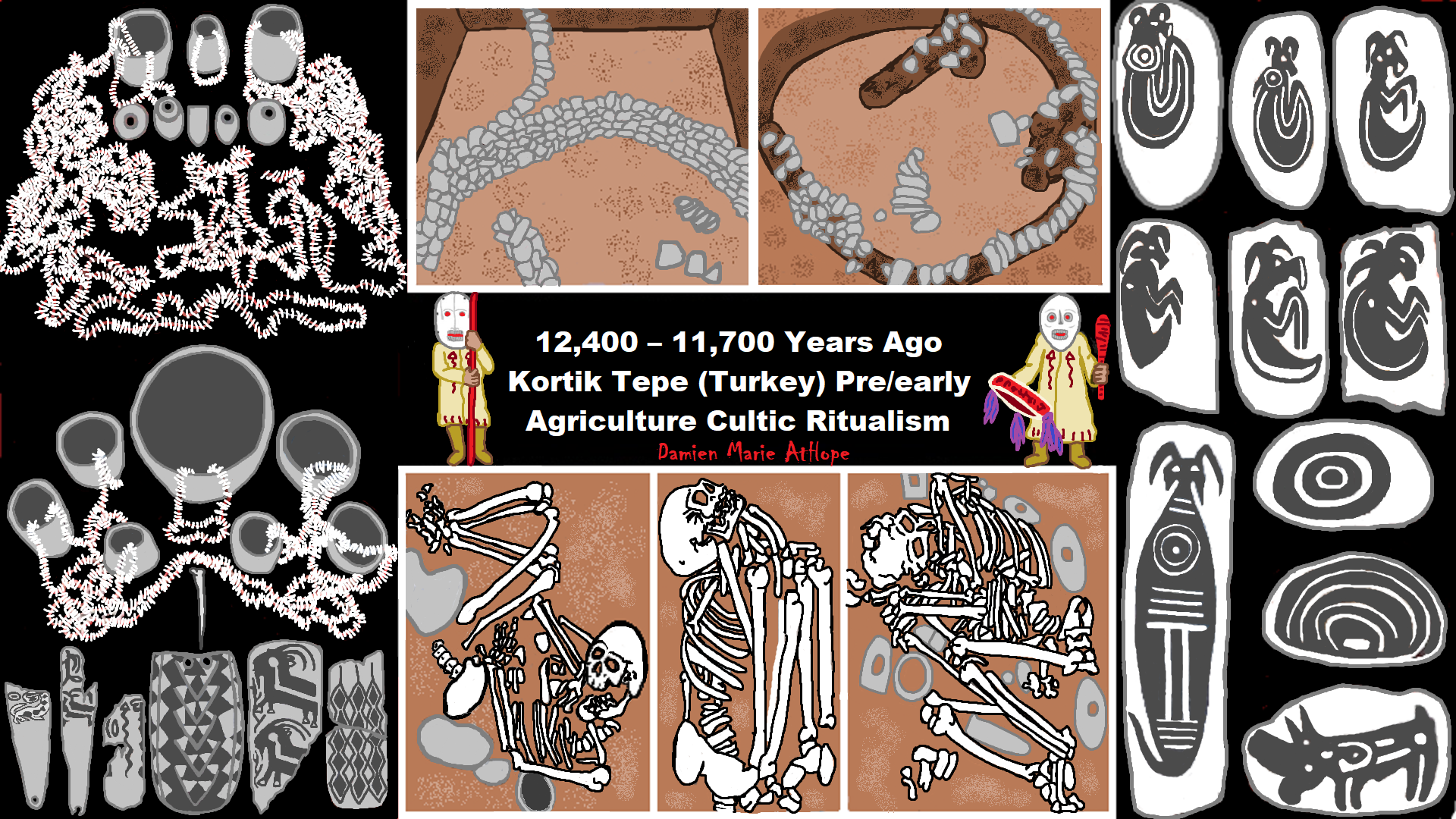

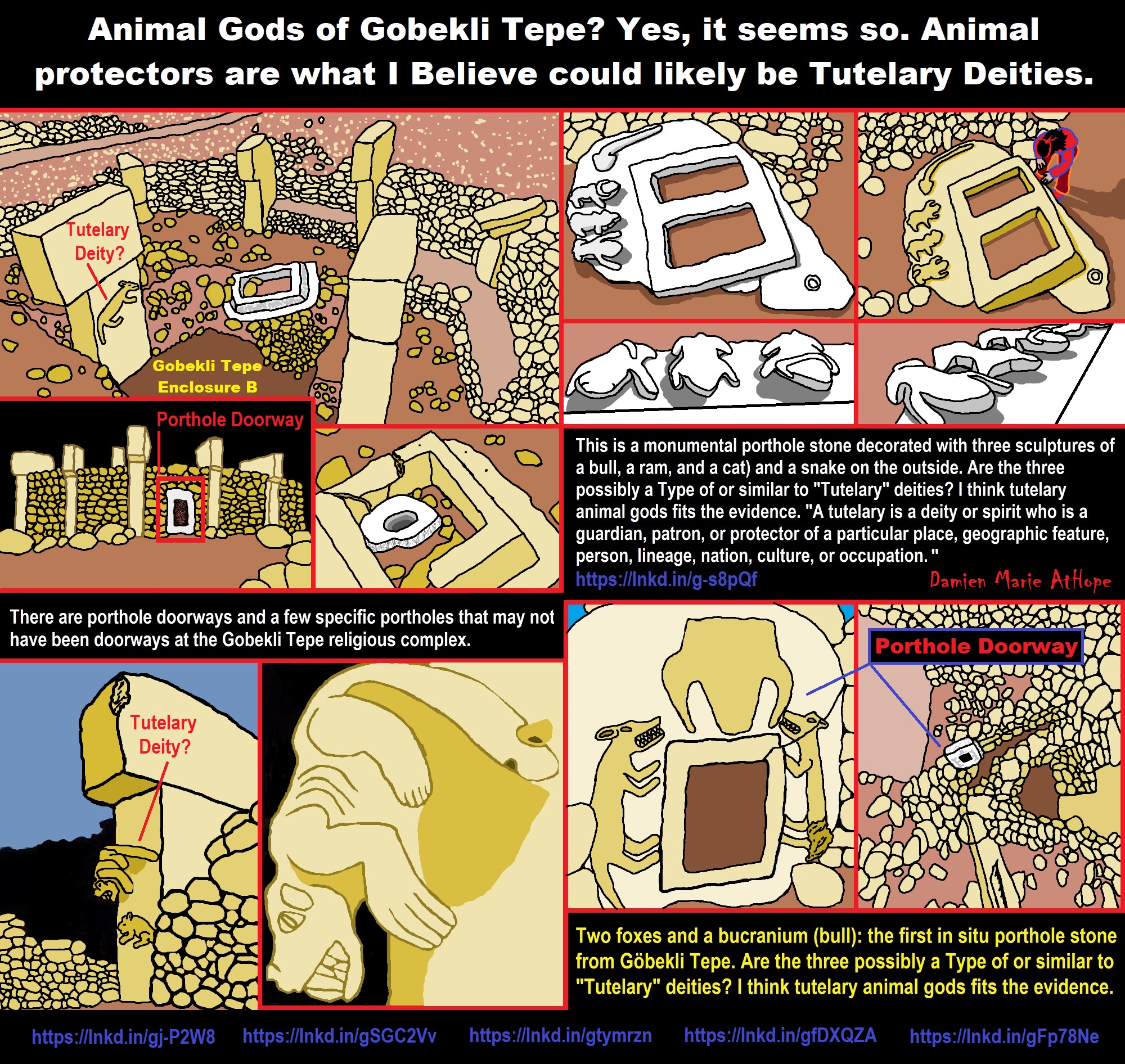
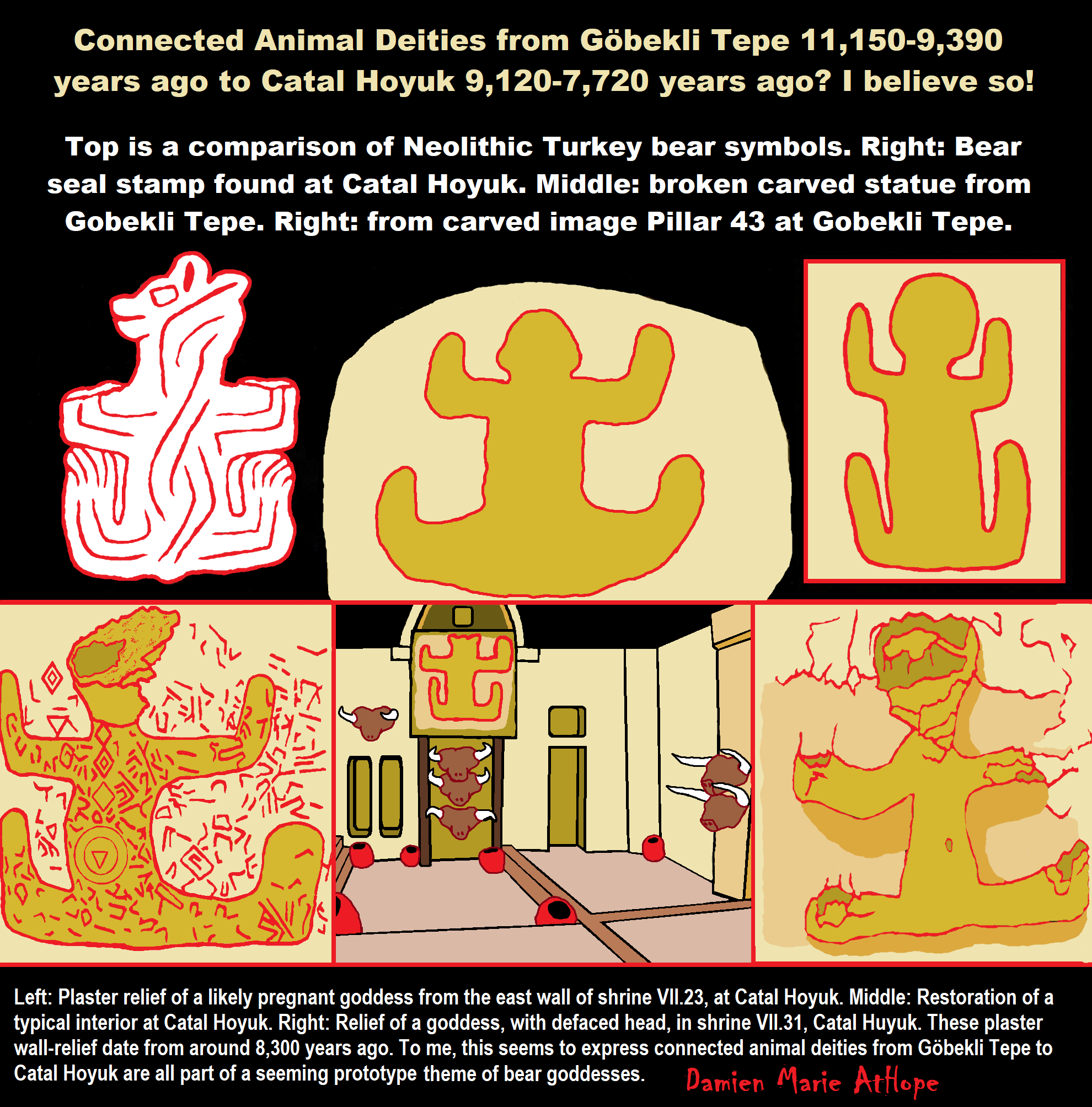
ref, ref, ref, ref, ref, ref, ref
Bear worship
“Bear worship (also known as the bear cult or arctolatry) is the religious practice of the worshipping of bears found in many North Eurasian ethnic religions such as among the Sami, Nivkh, Ainu, Basques, Germanic peoples, Slavs, and Finns. There are also a number of deities from Celtic Gaul and Britain associated with the bear, and the Dacians, Thracians, and Getians were noted to worship bears and annually celebrate the bear dance festival. The bear is featured on many totems throughout northern cultures that carve them. Bears were the most worshipped animals of Ancient Slavs. During pagan times, it was associated with the god Volos, the patron of domestic animals. Eastern Slavic folklore describes the bear as a totem personifying a male: father, husband, or a fiancé. Legends about turnskin bears appeared, it was believed that humans could be turned into bears for misbehavior.” ref
“Bears in Korean mythology, According to legend, Ungnyeo (literally “bear woman”) was a bear who turned into a woman, and gave birth to Dangun, the founder of the first Korean kingdom, Gojoseon. Bears were revered as motherly figures and as symbolic of patience. In Finnish paganism, the bear was considered a taboo animal and the word for “bear” (oksi) was a taboo word. Euphemisms such as mesikämmen “honey-hand” were used instead. Bear hunting and killing a bear was followed by a party called peijaiset with ceremony intended to show that the bear would be a “honored guest” instead of a slaughtered animal, and that its death was “accidental”, in order to not to anger the bear’s spirit. The skull of the bear was hung onto a tree, which was venerated as a totem.” ref
The bear festival is a religious festival celebrated by the indigenous Nivkh in Russia’s far east. A Nivkh shaman (ch’am) would preside over the Bear Festival, celebrated in the winter between January and February depending on the clan. Bears were captured and raised in a corral for several years by local women, treating the bear like a child. The bear is considered a sacred earthly manifestation of Nivkh ancestors and the gods in bear form. During the Festival, the bear is dressed in a specially made ceremonial costume and offered a banquet to take back to the realm of gods to show benevolence upon the clans. After the banquet, the bear is killed and eaten in an elaborate religious ceremony. The festival was arranged by relatives to honor the death of a kinsman. The bear’s spirit returns to the gods of the mountain ‘happy’ and rewards the Nivkh with bountiful forests. Generally, the Bear Festival was an inter-clan ceremony where a clan of wife-takers restored ties with a clan of wife-givers upon the broken link of the kinsman’s death. The Bear Festival was suppressed in the Soviet period; since then the festival has had a modest revival, albeit as a cultural rather than a religious ceremony.” ref
The Ainu people, who live on select islands in the Japanese archipelago, call the bear “kamuy” in their language, which translates to mean “god” similar to Kami. While many other animals are considered to be gods in the Ainu culture, the bear is the head of the gods. For the Ainu, when the gods visit the world of man, they don fur and claws and take on the physical appearance of an animal. Usually, however, when the term “kamuy” is used, it essentially means a bear. The Ainu people willingly and thankfully ate the bear as they believed that the disguise (the flesh and fur) of any god was a gift to the home that the god chose to visit. While on Earth – the world of man – the Ainu believed that the gods appeared in the form of animals. The gods had the capability of taking human form, but they only took this form in their home, the country of the gods, which is outside the world of man. To return a god back to his country, the people would sacrifice and eat the animal sending the god’s spirit away with civility. This ritual is called Omante and usually involves a deer or adult bear.” ref
“Kami (Japanese: are the deities, divinities, spirits, phenomena, or “holy powers”), that are venerated in the religion of Shinto. They can be elements of the landscape, forces of nature, or beings and the qualities that these beings express; they can also be the spirits of venerated dead people. Many kami are considered the ancient ancestors of entire clans (some ancestors became kami upon their death if they were able to embody the values and virtues of kami in life).” ref
“Omante occurred when the people sacrificed an adult bear, but when they caught a bear cub they performed a different ritual which is called Iomante, in the Ainu language, or Kumamatsuri in Japanese. Kumamatsuri translates to “bear festival” and Iomante means “sending off”. The event of Kumamatsuri began with the capture of a young bear cub. As if he was a child given by the gods, the cub was fed human food from a carved wooden platter and was treated better than Ainu children for they thought of him as a god. If the cub was too young and lacked the teeth to properly chew food, a nursing mother will let him suckle from her own breast. When the cub reaches 2–3 years of age, the cub is taken to the altar and then sacrificed. Usually, Kumamatsuri occurs in midwinter when the bear meat is the best from the added fat. The villagers will shoot it with both normal and ceremonial arrows, make offerings, dance, and pour wine on top of the cub corpse. The words of sending off for the bear god are then recited. This festival lasts for three days and three nights to properly return the bear god to his home.” ref
Bear Goddesses and Gods Across Ancient Cultures
“Gods and goddesses of the ancient world held a connection with certain animals. This is because our ancestors’ beliefs were animistic – they believed everything on earth had consciousness. Wildlife was sacred in ancient times. The bear is one of the most powerful and most feared of the animal kingdom. Dating back thousands of years, the people of Europe left their marks on cave walls—some of these drawings were of bears. Moreover, shamans have revered the bear for its power, but also for its motherhood qualities and healing abilities. Bear medicine is strong medicine. It’s no wonder ancient gods and goddesses were connected to the bear. Learn of the bear goddesses and a bear god here.” ref
The Greek Bear Goddesses
“The typical illustration of Artemis, Greek Goddess of the Hunt, depicts her with either a hunting dog or stag. However, one of Artemis’ most sacred animals was the bear. Artemis had domain over the forest and all wildlife within it. The bear was the largest and most powerful animal, and so Artemis found it to be a special animal. Any time a bear was killed by the Greeks, Artemis would lay a plague on the people as punishment. Artemis’ cult spread over Greece. In Brauron, young girls played she-bears in honor of Artemis and as a preparation for motherhood. They wore bear masks and acted wildly in worship of her. Artemis’ name is theorized to have meant bear-sanctuary. If we break it down—art is close to ark which means bear, and temis is close to temnis which means sanctuary. We will see in the next section how another Goddess’ name reflects this etymology.” ref
“Another close association between Artemis and bears is in the tale of one of Artemis’ followers named Callisto. Callisto was a nymph (demi-god nature spirit), and as followers of Artemis, women were charged to stay chaste and pure from men. Callisto was lured into having relations with Zeus, who impregnated her. When Artemis found out, she changed Callisto into a bear. Other versions say Athena was angered when Zeus impregnated the nymph and so she turned Callisto into a bear. The constellations Ursa Major and Ursa Minor (known to the Greeks as Arktos—bear) are said to be the soul remnants of Callisto and her son, and were placed in the sky by Zeus himself.” ref
Celtic Bear Goddess
“We don’t know a lot about Artio, the Bear Goddess of the ancient Celtic-Gauls, but we know she was intimately connected to bears. The few pieces of evidence we have of her cult’s existence were found in Switzerland and southern Germany. A bronze statue depicting Artio feeding a giant bear surfaced in Bern, Switzerland. Scholars say Artio feeds the bear with a bowl of fruit in her lap. But could it be the other way around? It seems to me the goddess is being confronted by the bear and she is not backing down. There was once a great tale about this encounter, I am sure; however, over time the lore of Artio has been lost. The inscription on the Bern statue translates to “for the goddess Artio”. As with Artemis’ name, there is a clear link to the bear in Artio’s name. Art translates to bear in Gaulish. Could Artio, the Bear Goddess of the Gauls, be the same goddess as the Greeks’ bear goddess Artemis?” ref
Hungarian Bear Goddess
“Much of what we know of the Hungarian Bear Goddess Ildiko has been lost in time, or perhaps is just not readily accessible by my research methods. However, according to the Encyclopedia of Spirits by Judika Iles, Ildiko was a goddess of the forest and wildlife. One of her most sacred animals was the bear. Ildiko was like Artemis – she was the goddess of the hunt but also a protector of forest animals. This is because of the need for balance—she guides the hunters but also protects animals in need of preservation or honor. Ildiko is a common name in Hungary with a Germanic origin meaning “warrior”. We can see how a warrior goddess would also be keen of bears—power, wisdom, and ferocity.” ref
Finnish Bear Goddess
“Above all, Mielikki is a healing goddess of Finland. She is associated with the woods and with wildlife, just as Artemis and Ildiko, but her main attribute is her healing abilities. She heals the animals when they are sick or wounded. This corresponds directly with the medicine of the bear. Shamans know bears to be healers, and so Mielikki is like the bear in this way. Mielikki is one of the bear goddesses who had a part in the creation of the bear. The story goes that Mielikki left earth and traveled into space, past the moon, in search of the materials with which to make the perfect animal. She returned and stitched together the materials from the heavens to make the bear. The bear is Mielikki’s favorite animal, above all. The tale of Mielikki going into space to find the materials to make the bear correlates nicely with the tales of the other Bear Goddesses Artemis, Callisto, and Zeus putting Callisto into the sky to make the Ursa Major and Minor constellations. There is an asteroid and a mountain on the planet Venus named for Mielikki.” ref
Slavs and the bear worship
“Bear was one of the most worshipped animals among the ancient Slavic tribes. It was connected to the god Volos, who was the protector of animals and wilderness. In Slavic folklore, the bear is usually depicted as a male, either as a father, husband or groom.” ref
Norse or Germanic pagans Odin: The All-Father and Bear God
“Odin is a popular god among Norse and Germanic pagans and his cult has spread to nearly every part of the modern world. He is known as the All-Father, the One-Eyed, and the terrifying one. He is a wise, yet powerful god and knows how to win a battle. Because of this, warriors and magicians of ancient times sought Odin for his knowledge and ferocity. When depicted, he is usually illustrated as an old man with white hair and beard, cloaked, and carrying a staff. One of his eyes is missing, a sacrifice Odin made to tap into the wisdom of the well of Urðr. Odin is almost always flanked by two of his totem animals—ravens and wolves. However, some claim Odin may also be guarded by two great bears. I’ve yet to find solid evidence of this claim; however, this could be in part because of Odin’s association with the berserkers (shaman warriors) who often wore the pelts of bears. Either way, a god of war, wisdom, healing, and trickery such as Odin would be well received as a friend of the bear.” ref


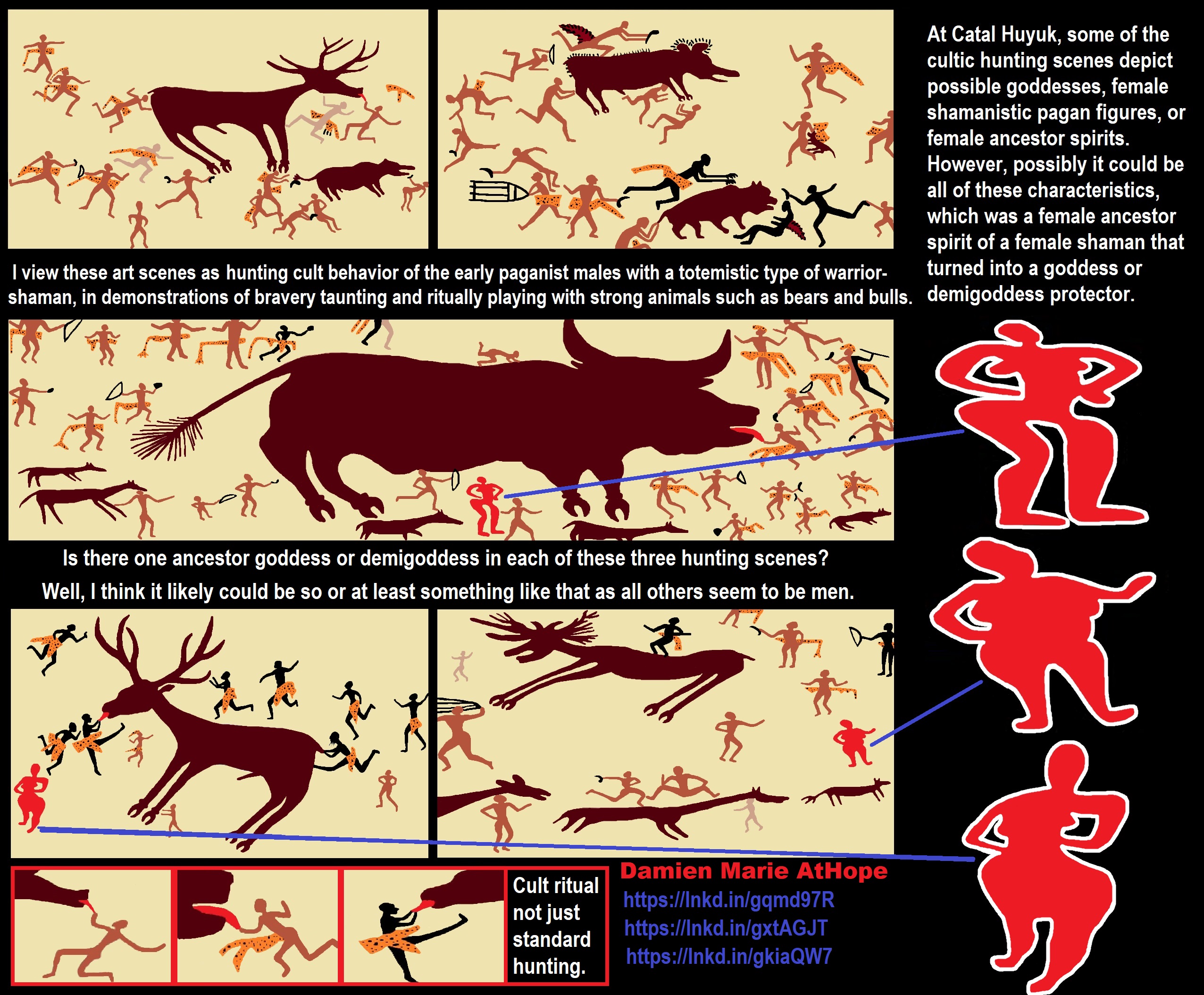
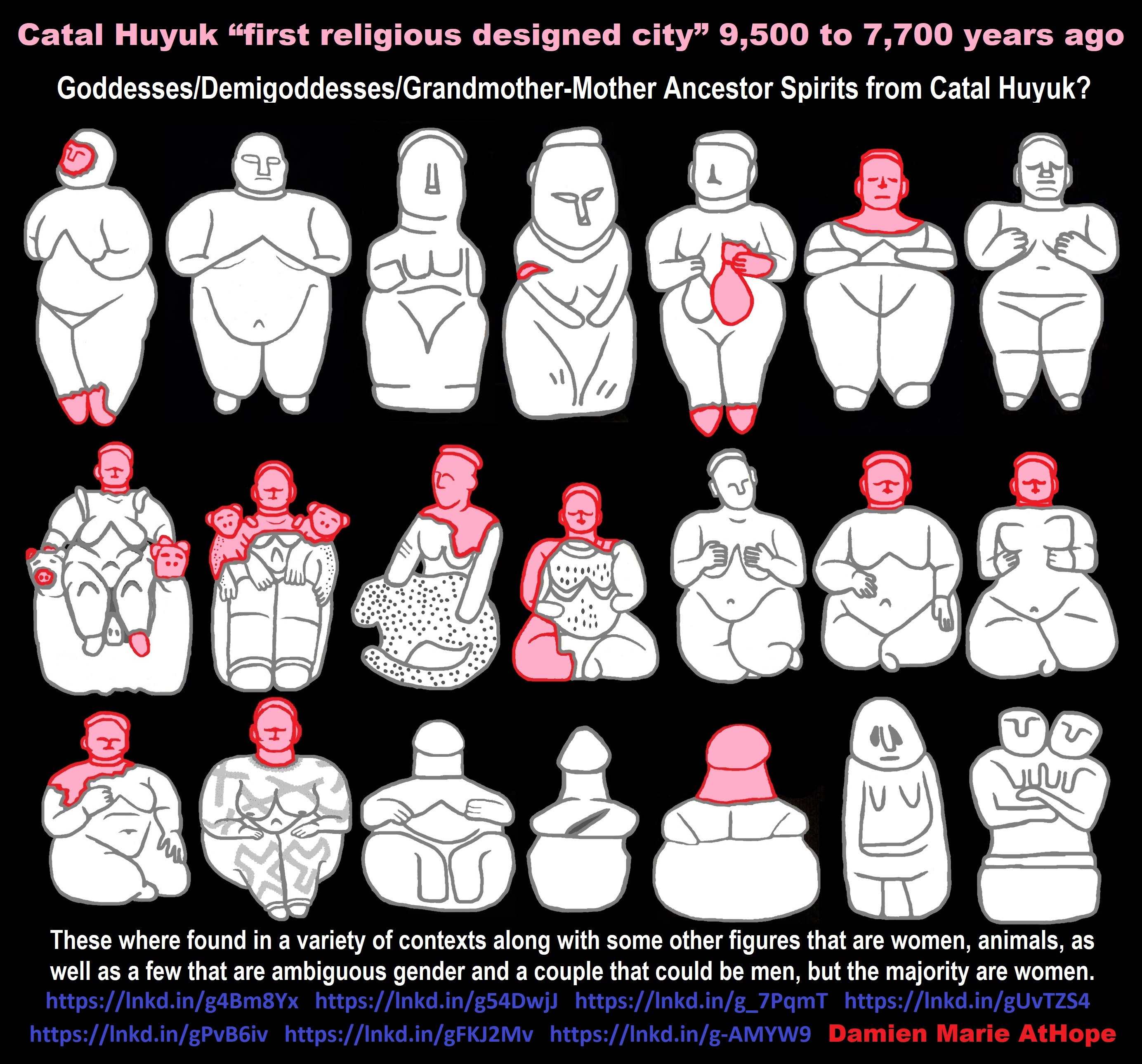


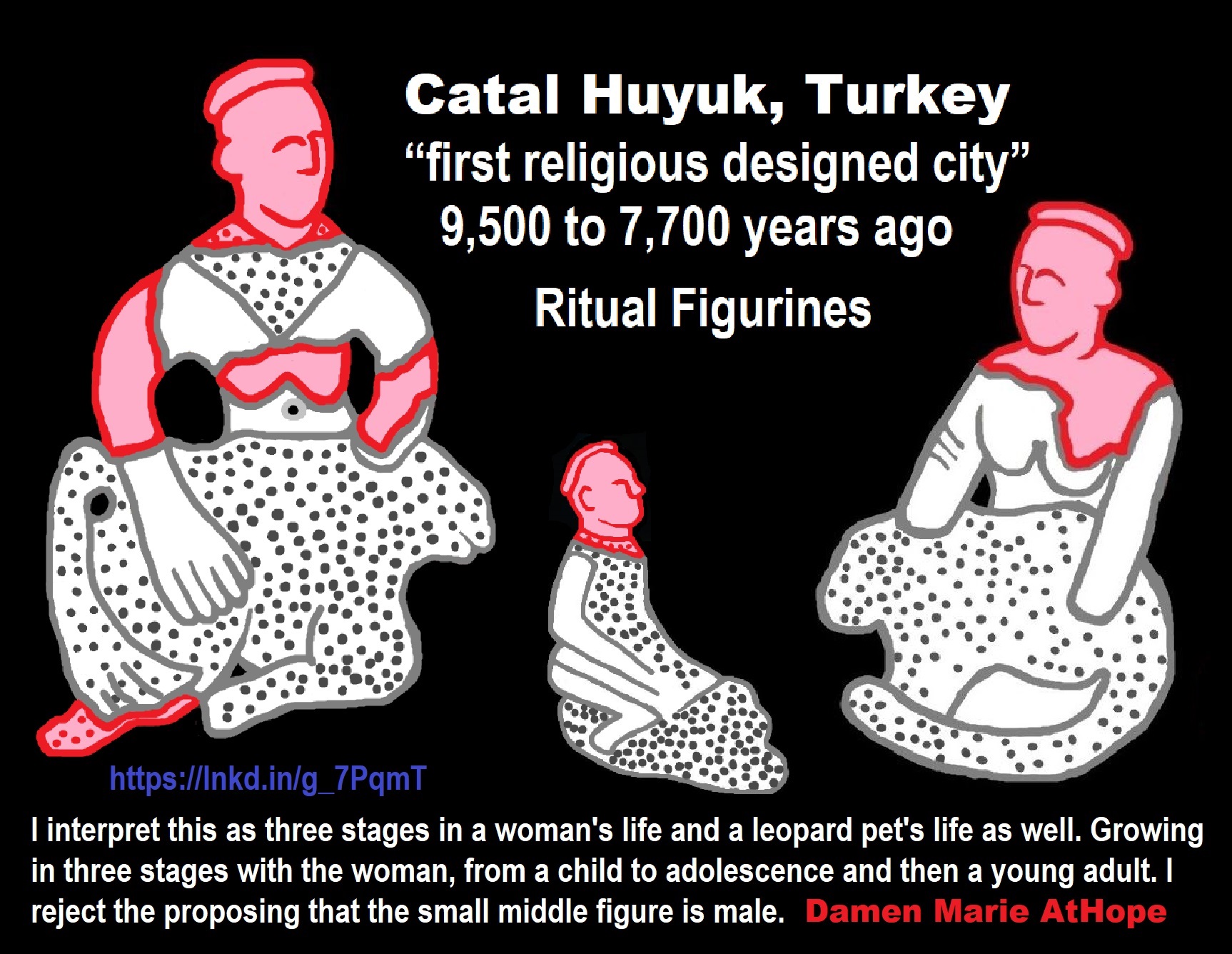

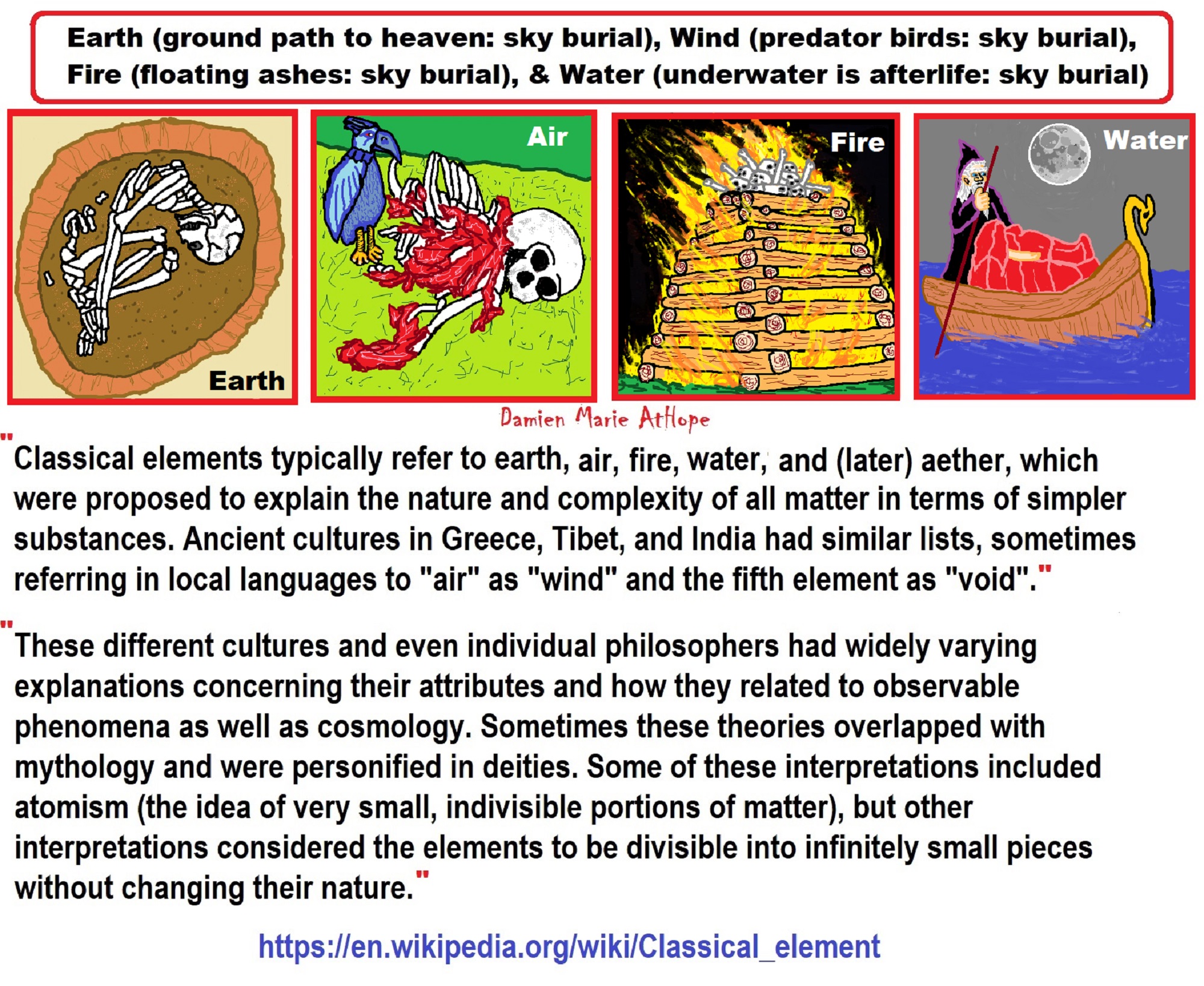

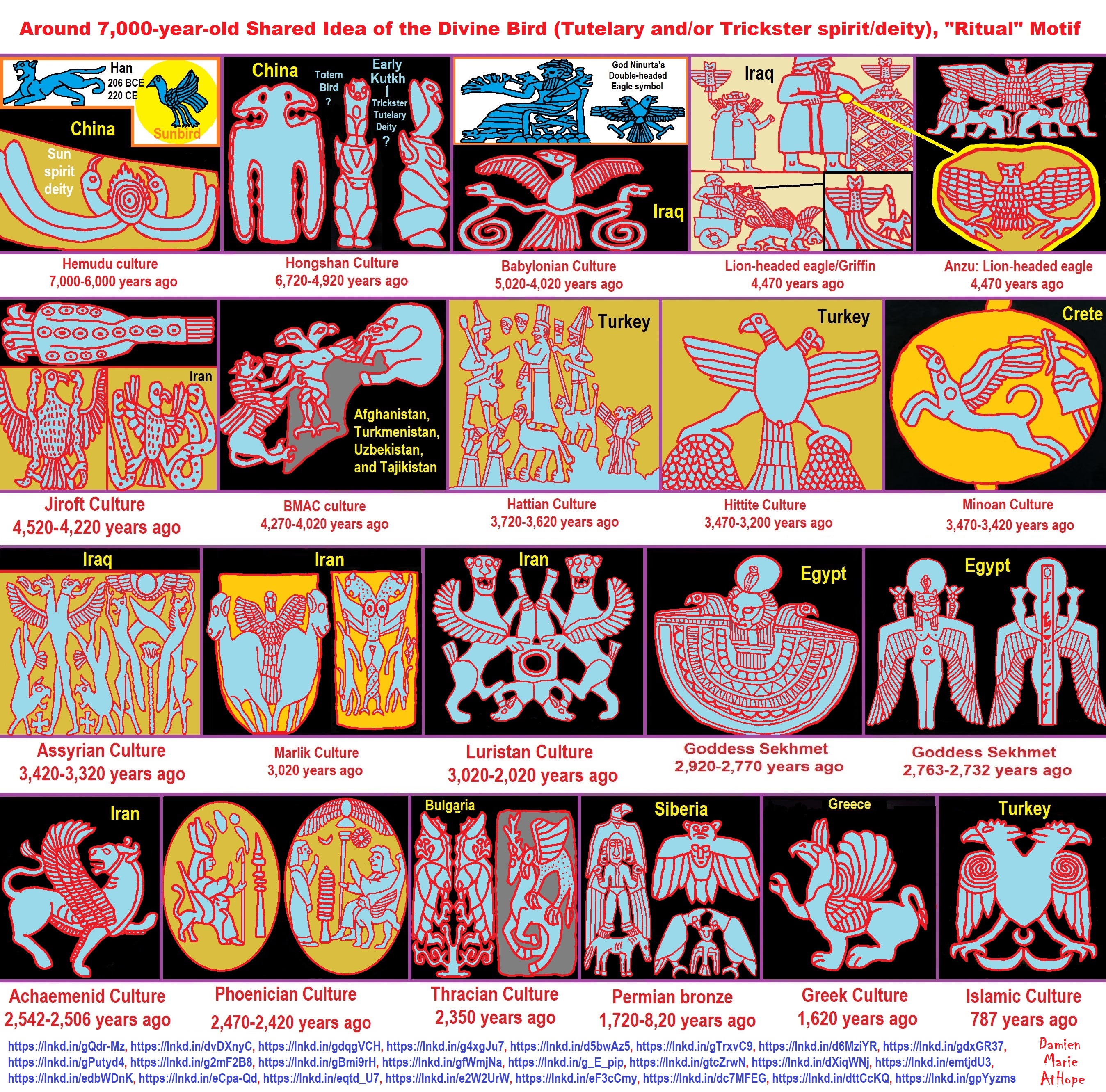
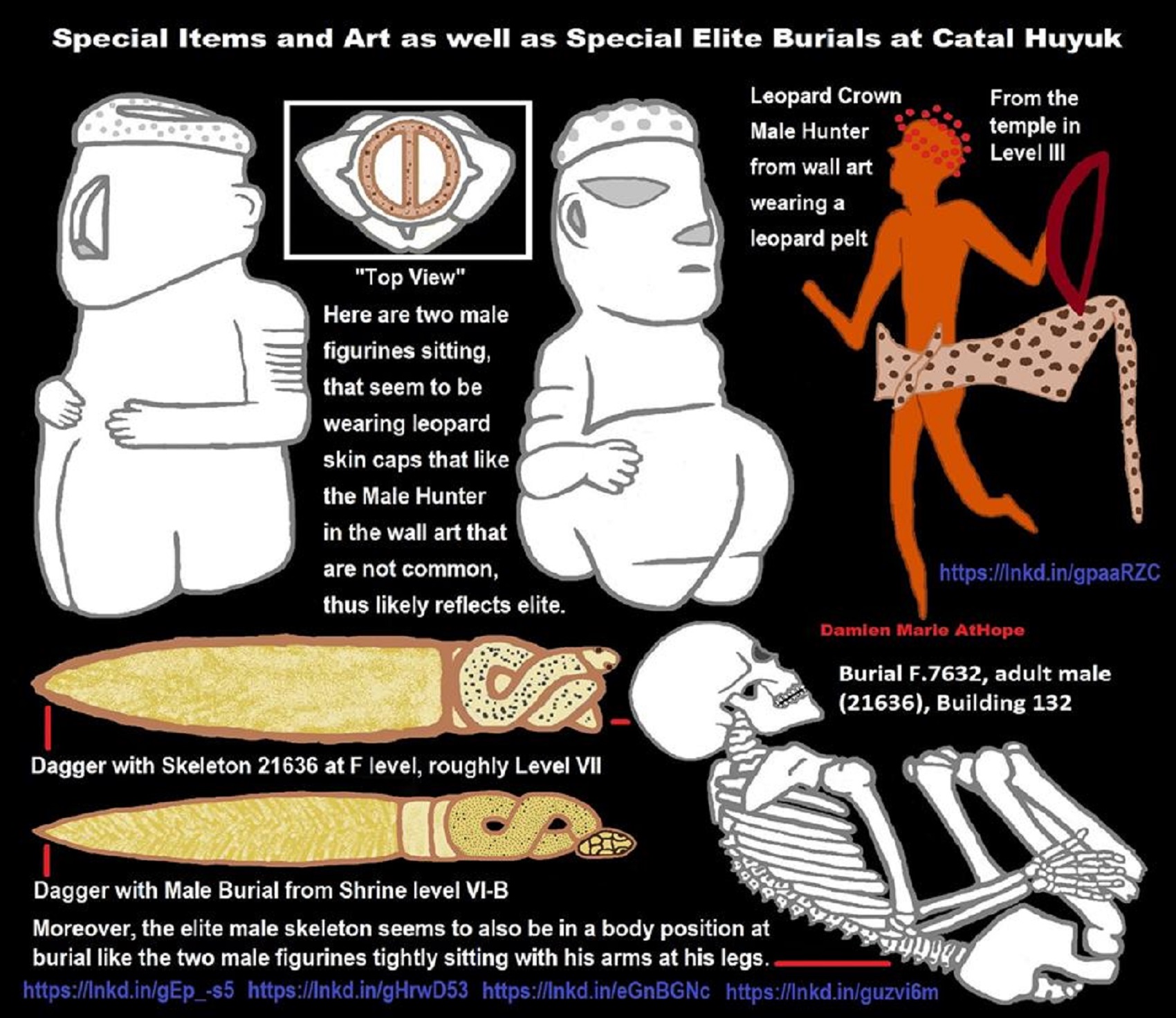
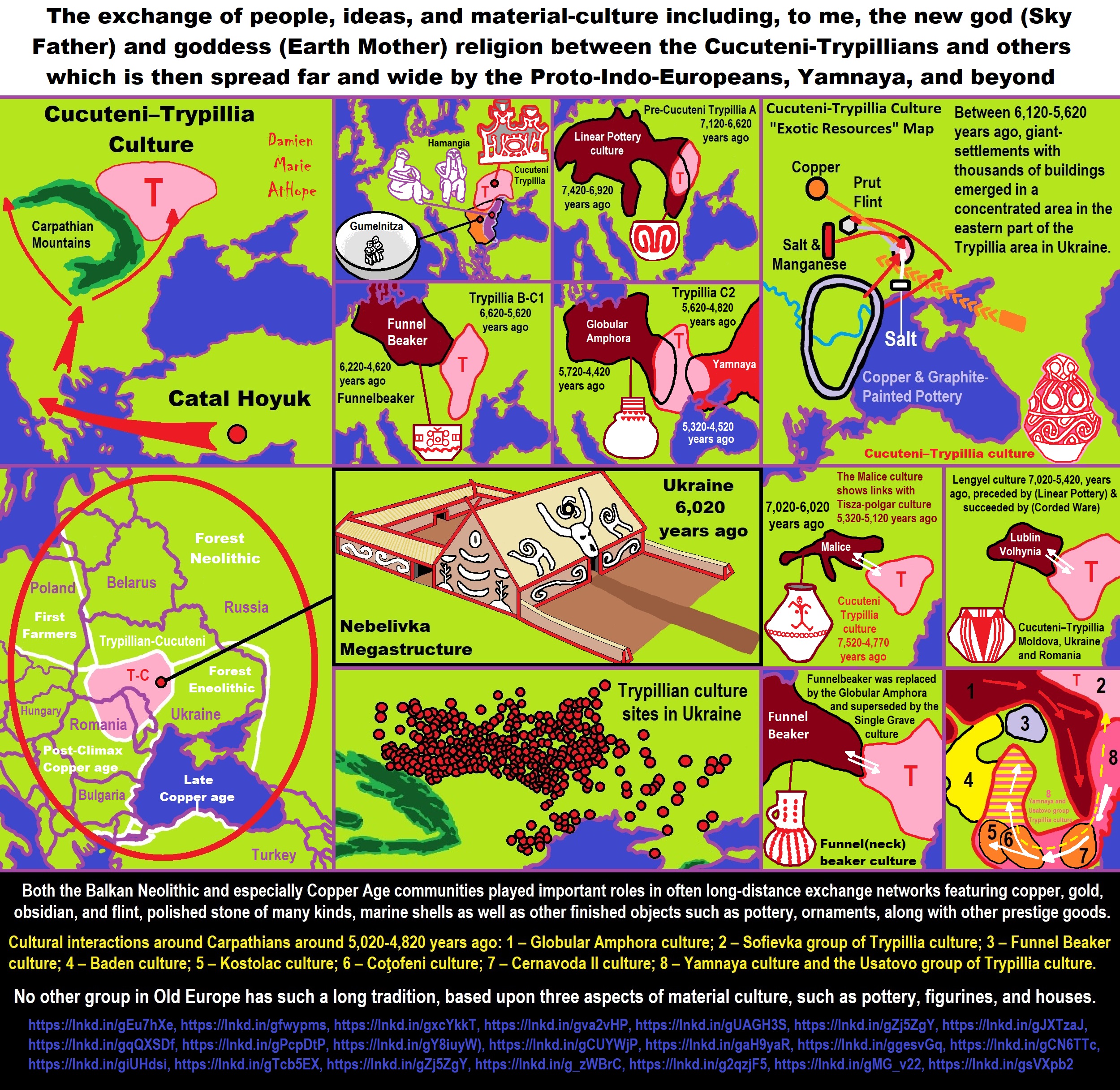
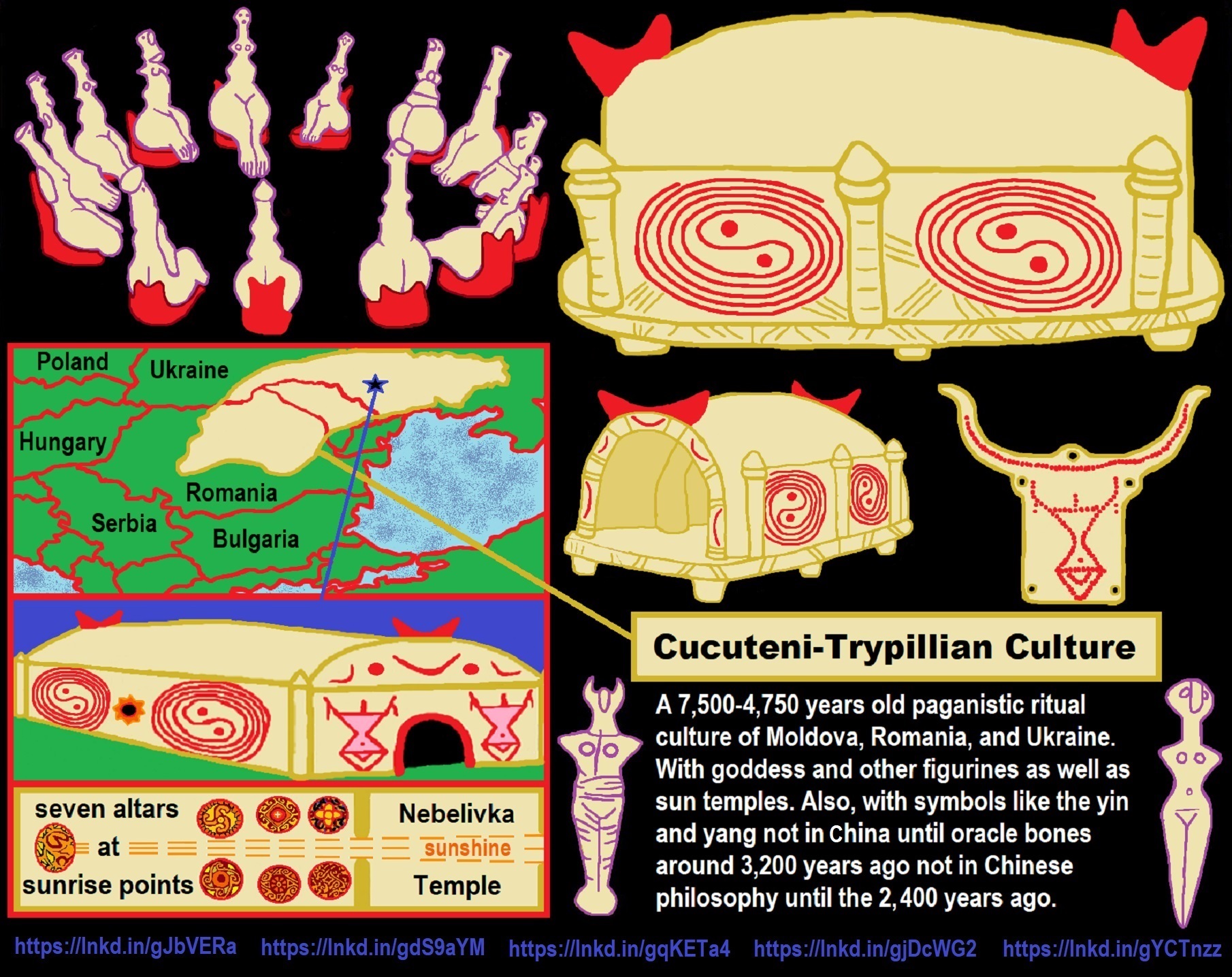


ref, ref, ref, ref, ref, ref, ref, ref, ref, ref, ref, ref, ref, ref, ref, ref, ref
“These ideas are my speculations from the evidence.”
I am still researching the “god‘s origins” all over the world. So you know, it is very complicated but I am smart and willing to look, DEEP, if necessary, which going very deep does seem to be needed here, when trying to actually understand the evolution of gods and goddesses. I am sure of a few things and less sure of others, but even in stuff I am not fully grasping I still am slowly figuring it out, to explain it to others. But as I research more I am understanding things a little better, though I am still working on understanding it all or something close and thus always figuring out more.
Sky Father/Sky God?
“Egyptian: (Nut) Sky Mother and (Geb) Earth Father” (Egypt is different but similar)
Turkic/Mongolic: (Tengri/Tenger Etseg) Sky Father and (Eje/Gazar Eej) Earth Mother *Transeurasian*
Hawaiian: (Wākea) Sky Father and (Papahānaumoku) Earth Mother *Austronesian*
New Zealand/ Māori: (Ranginui) Sky Father and (Papatūānuku) Earth Mother *Austronesian*
Proto-Indo-European: (Dyḗus/Dyḗus ph₂tḗr) Sky Father and (Dʰéǵʰōm/Pleth₂wih₁) Earth Mother
Indo-Aryan: (Dyaus Pita) Sky Father and (Prithvi Mata) Earth Mother *Indo-European*
Italic: (Jupiter) Sky Father and (Juno) Sky Mother *Indo-European*
Etruscan: (Tinia) Sky Father and (Uni) Sky Mother *Tyrsenian/Italy Pre–Indo-European*
Hellenic/Greek: (Zeus) Sky Father and (Hera) Sky Mother who started as an “Earth Goddess” *Indo-European*
Nordic: (Dagr) Sky Father and (Nótt) Sky Mother *Indo-European*
Slavic: (Perun) Sky Father and (Mokosh) Earth Mother *Indo-European*
Illyrian: (Deipaturos) Sky Father and (Messapic Damatura’s “earth-mother” maybe) Earth Mother *Indo-European*
Albanian: (Zojz) Sky Father and (?) *Indo-European*
Baltic: (Perkūnas) Sky Father and (Saulė) Sky Mother *Indo-European*
Germanic: (Týr) Sky Father and (?) *Indo-European*
Colombian-Muisca: (Bochica) Sky Father and (Huythaca) Sky Mother *Chibchan*
Aztec: (Quetzalcoatl) Sky Father and (Xochiquetzal) Sky Mother *Uto-Aztecan*
Incan: (Viracocha) Sky Father and (Mama Runtucaya) Sky Mother *Quechuan*
China: (Tian/Shangdi) Sky Father and (Dì) Earth Mother *Sino-Tibetan*
Sumerian, Assyrian and Babylonian: (An/Anu) Sky Father and (Ki) Earth Mother
Finnish: (Ukko) Sky Father and (Akka) Earth Mother *Finno-Ugric*
Sami: (Horagalles) Sky Father and (Ravdna) Earth Mother *Finno-Ugric*
Puebloan-Zuni: (Ápoyan Ta’chu) Sky Father and (Áwitelin Tsíta) Earth Mother
Puebloan-Hopi: (Tawa) Sky Father and (Kokyangwuti/Spider Woman/Grandmother) Earth Mother *Uto-Aztecan*
Puebloan-Navajo: (Tsohanoai) Sky Father and (Estsanatlehi) Earth Mother *Na-Dene*
ref, ref, ref, ref, ref, ref, ref, ref, ref, ref, ref, ref, ref, ref, ref, ref, ref, ref, ref, ref, ref, ref, ref, ref, ref, ref, ref
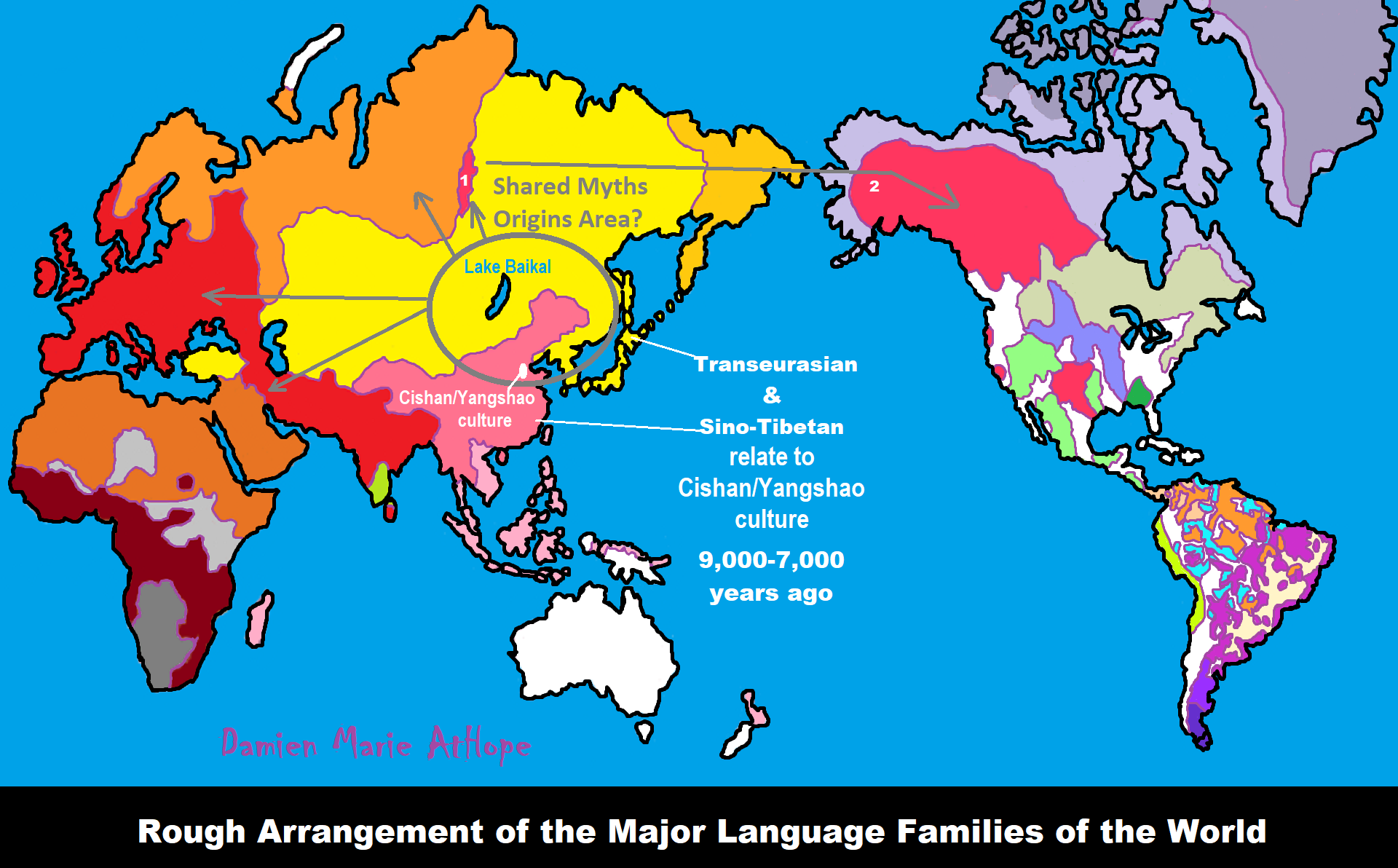
“These ideas are my speculations from the evidence.”
“1 central Eurasian Neolithic individual from Tajikistan (around 8,000 years ago) and approximately 8,200 years ago Yuzhniy Oleniy Ostrov group from Karelia in western Russia formed by 19 genomes affinity to Villabruna ancestry than all the other Eastern Hunter-Gatherer groups” https://www.nature.com/articles/s41586-023-05726-0

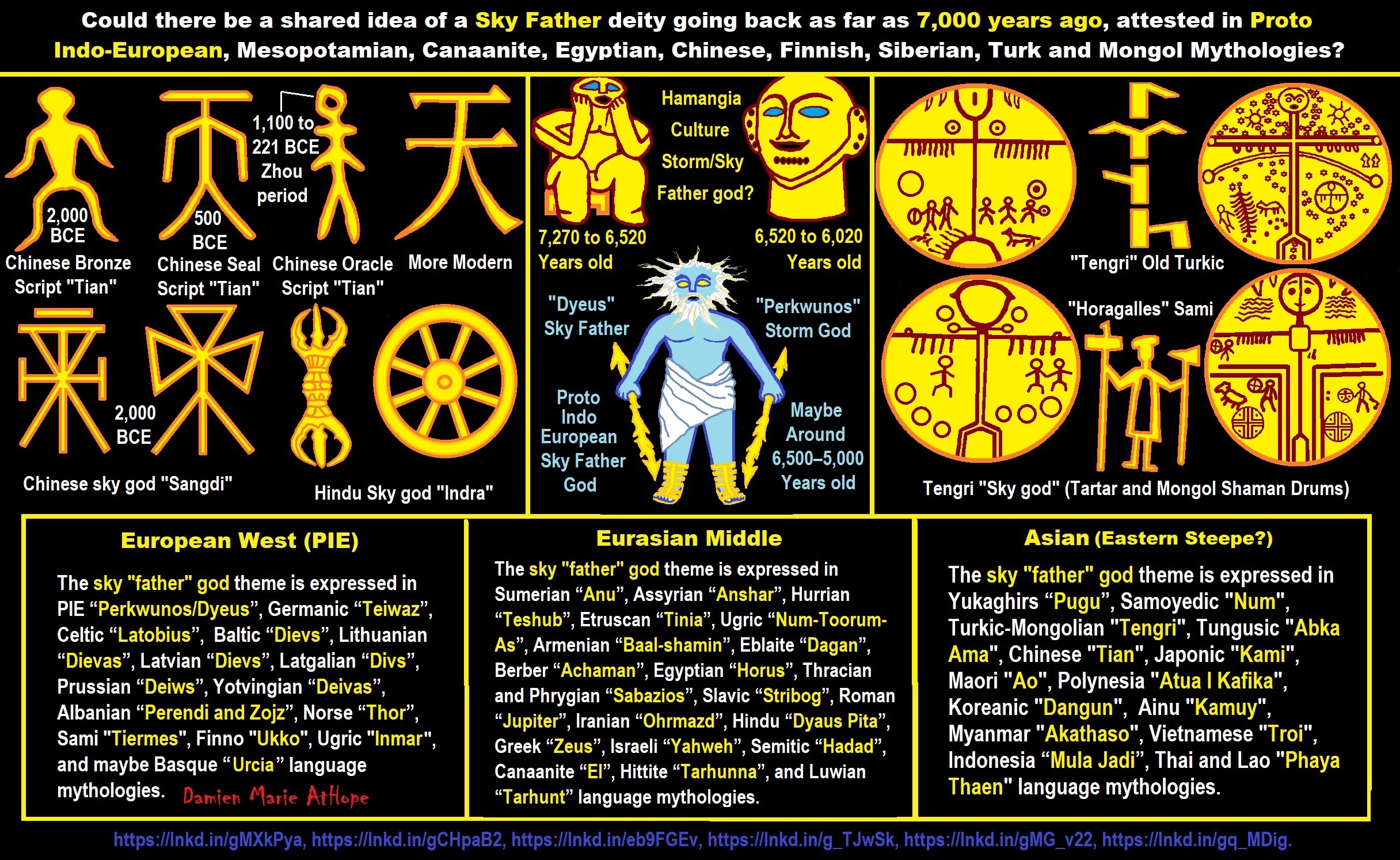
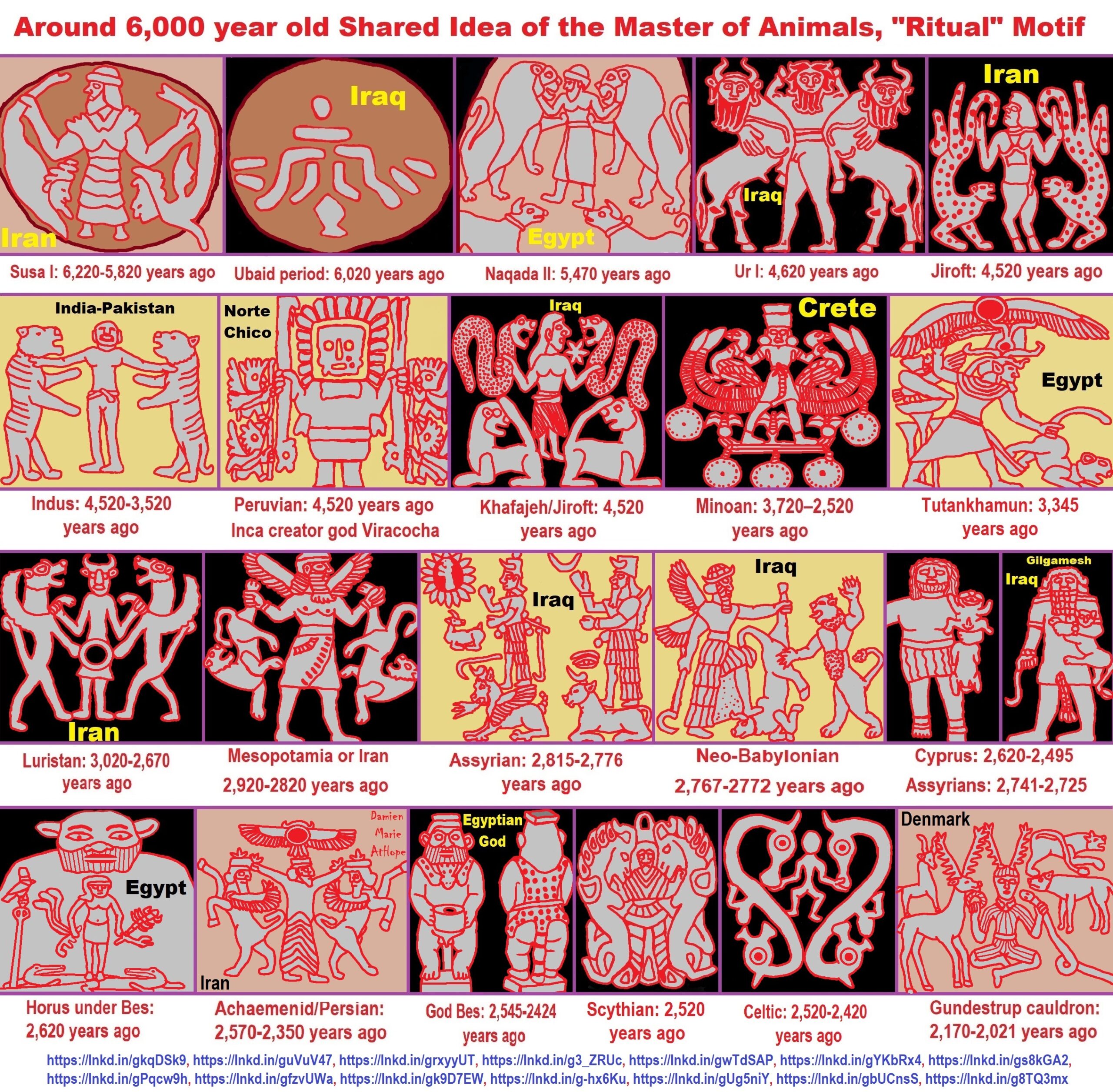
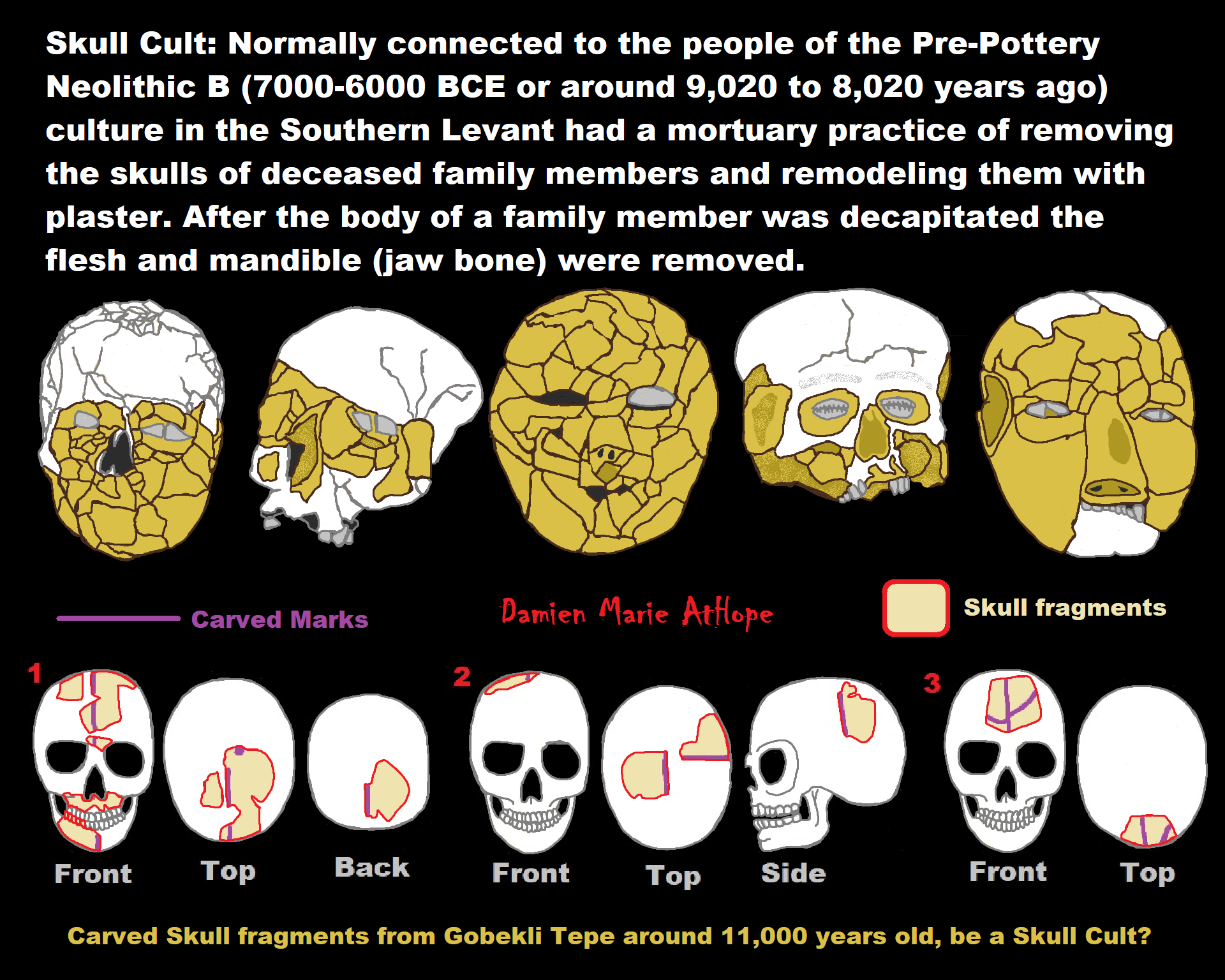
ref, ref, ref, ref, ref, ref, ref
“Most of the skulls belonged to older adults (which by the era’s standards meant around 40 years old). Both men and women could be selected to have their remains plastered, Khalaily adds, noting that at least one of the skulls at Yiftahel belonged to a female. According to Hamoudi Khalaily – an archaeologist with the Israel Antiquities Authority who excavated three plastered skulls at Yiftahel, a Neolithic site in the Galilee – most of these artifacts are found either in central public places or in “secondary burials”, that is, reburied separately from their body after many years of use. This fits the idea of an ancestor cult, Khalaily explains. As long as the ancestors were known and remembered, the artifacts were prominently displayed. But when their memory faded, they were reburied with honor and possibly replaced with the portraits of other elders.” ref
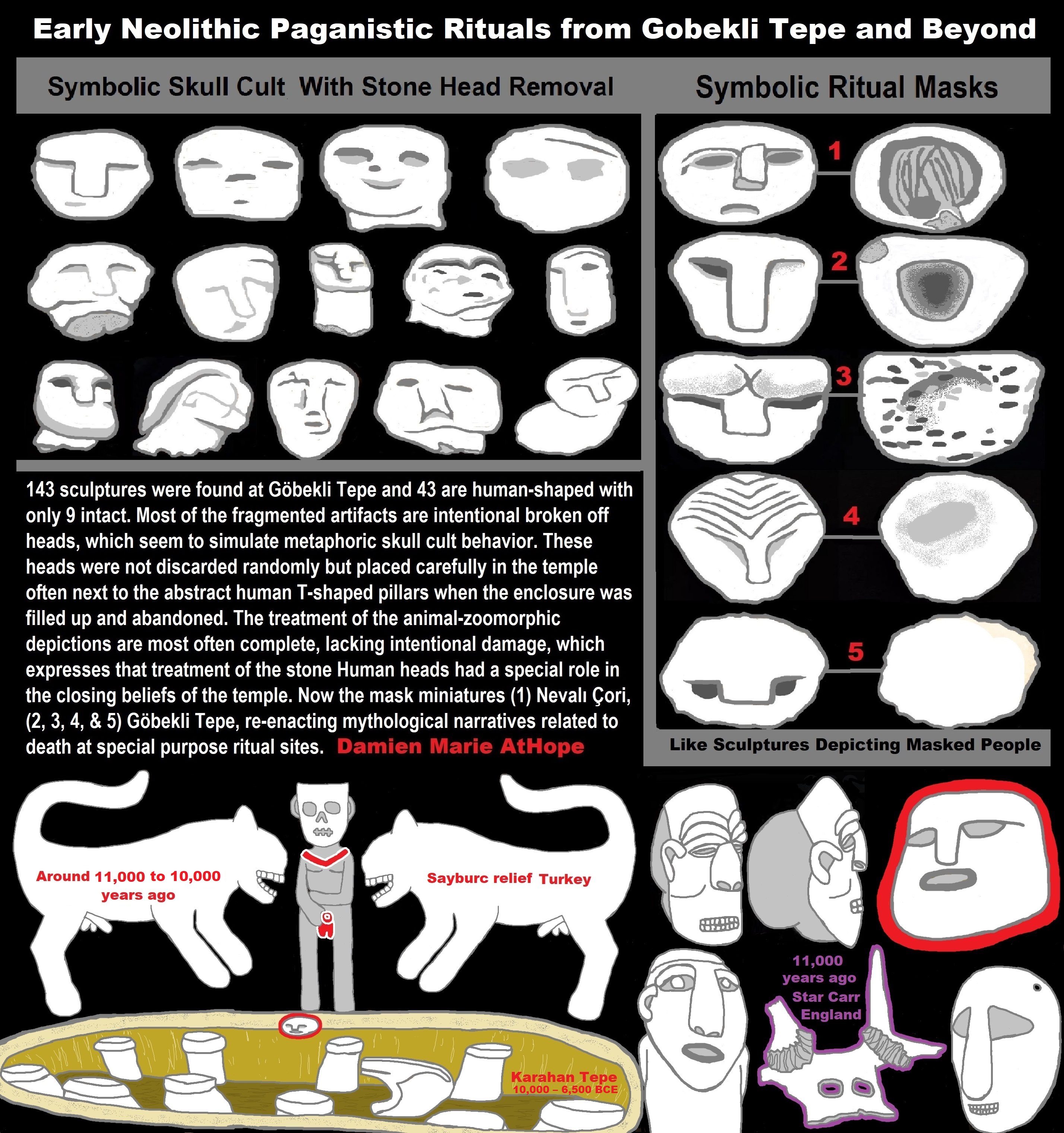
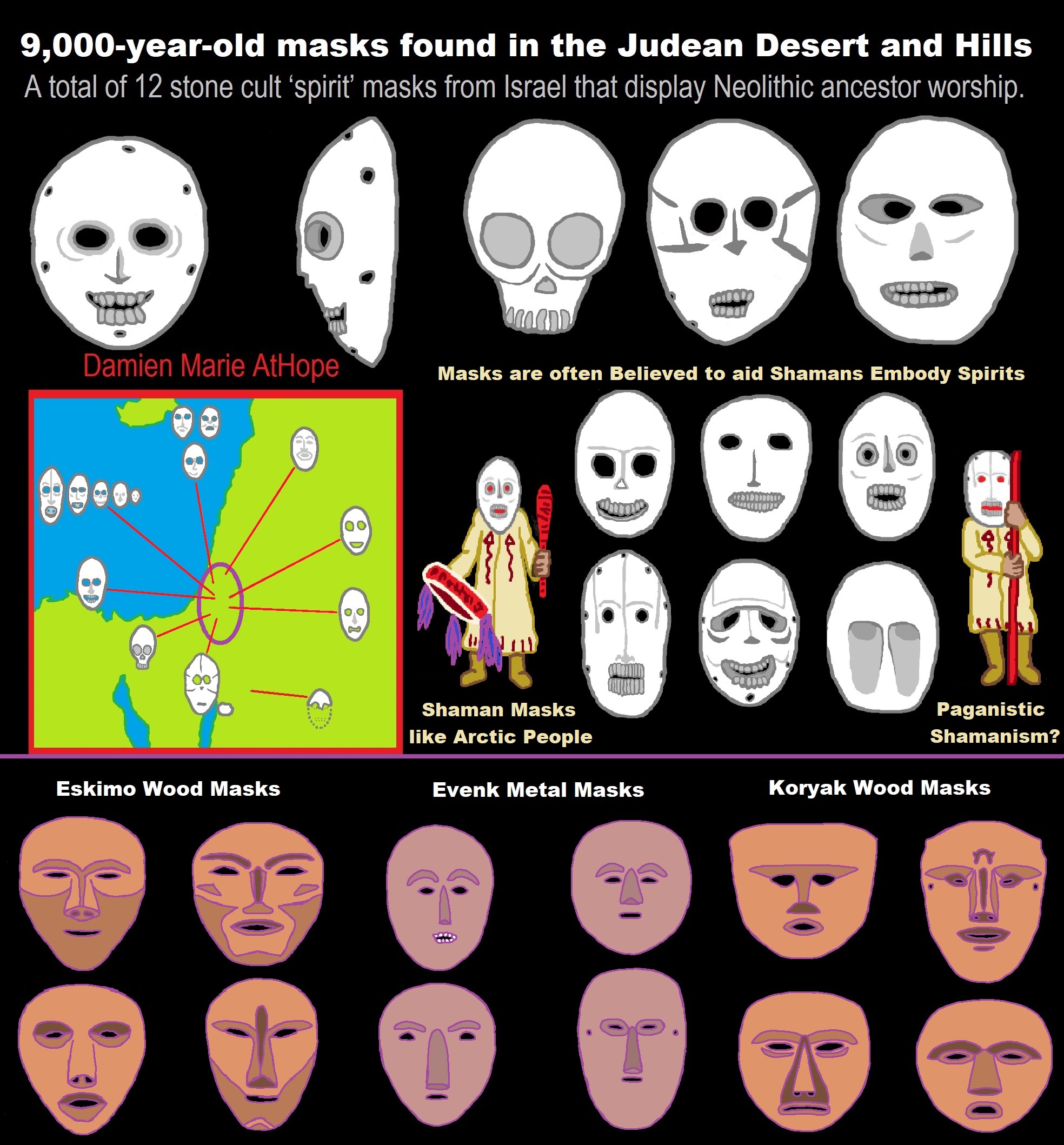


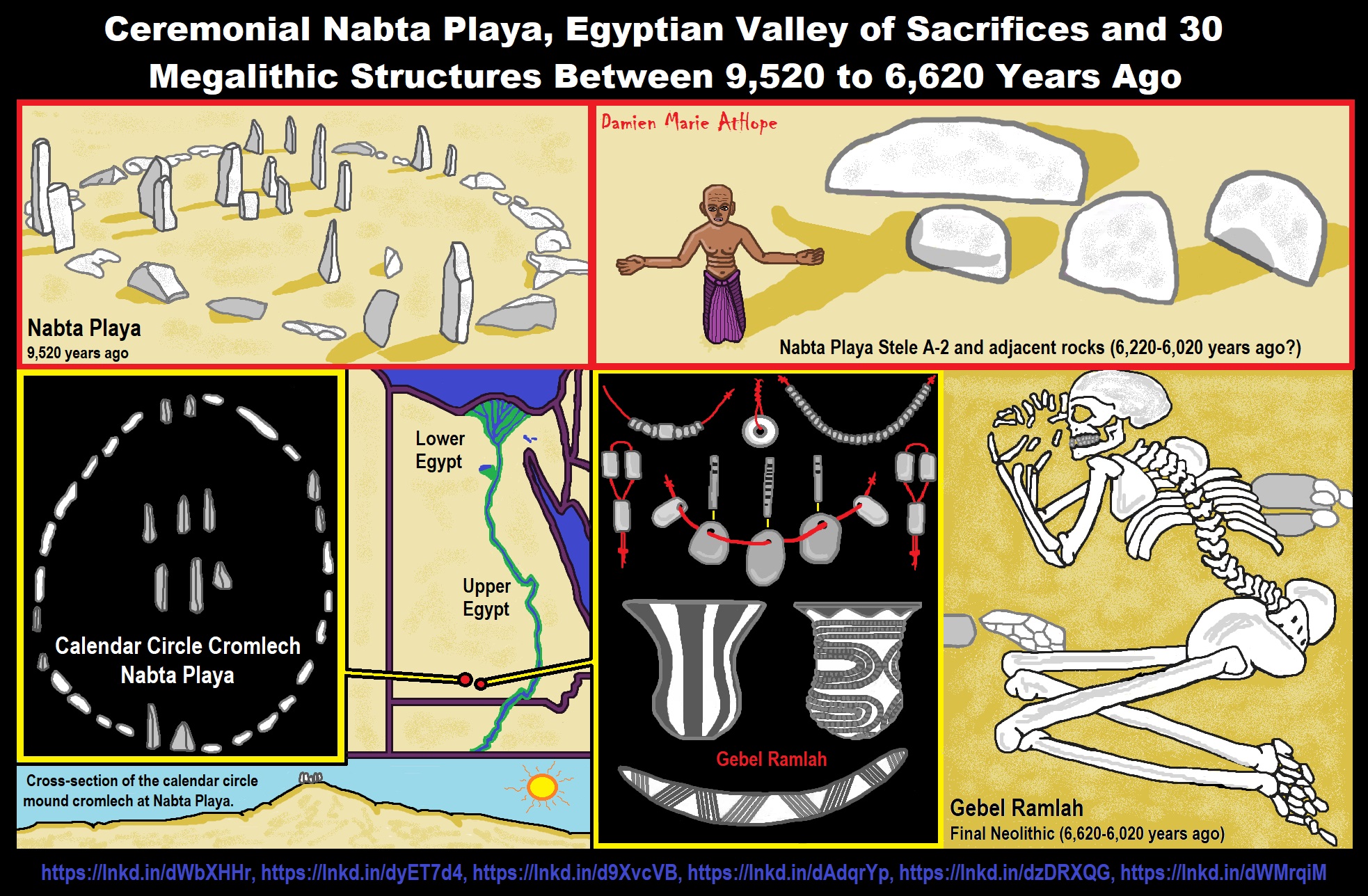
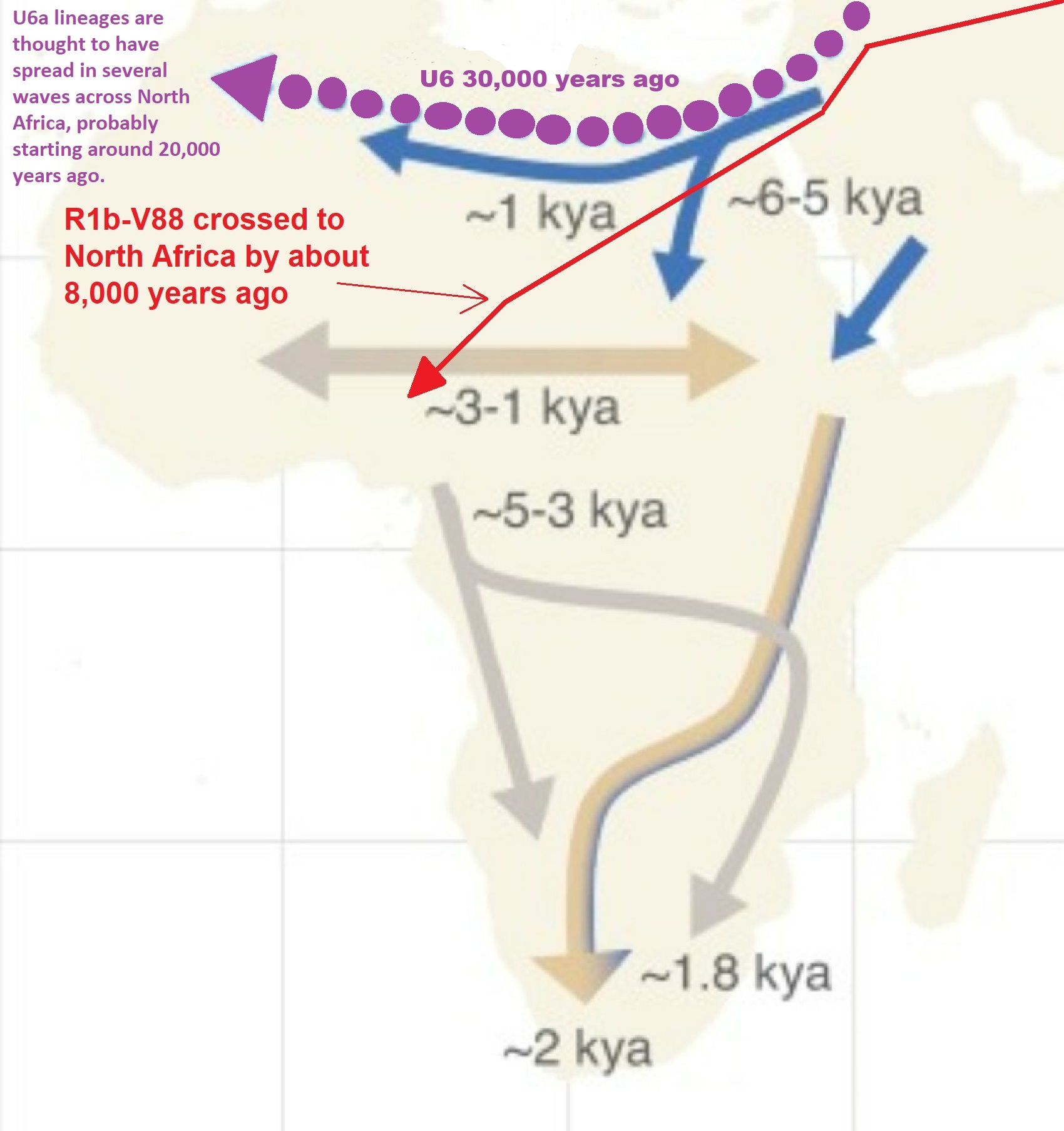
U6 back migration to Africa
“Although now found primarily in western, northern and north-eastern Africa, haplogroup U6 descends from the western Eurasian haplogroup U, and therefore represents a back migration to Africa. Secher et al. (2014) estimated that U6 arose very approximately 35,000 years ago (±11 ky), during the Early Upper Paleolithic, and prior to the Last Glacial Maximum (LGM).” ref
“The oldest and largest subclade, U6a, would have appeared around the LGM. U6a lineages are thought to have spread in several waves across North Africa, probably starting around 20,000 years ago, following the northern coastline of Africa. Several U6a branches (U6a1, U6a3, U6a6, U6a6b, U6a7, and U6a7b) appear to have expanded within the Maghreb from 20,000 years ago, with some spreading to the Iberian Peninsula (U6a1, U6a1b).” ref
“Marieke van de Loosdrecht et al. (2018) tested the DNA of seven 15,000-year-old modern humans from Taforalt Cave in northeastern Morocco, and six out of seven of them belonged to haplogroup U6a (clades U6a1b, U6a6b, U6a7 and U6a7b) – the last one belonging to M1b.” ref
U6 Neolithic expansion
“U6a and U6b lineages underwent the most spectacular expansion since the Neolithic period, spreading from the Maghreb to West Africa (U6a3c, U6a3f, U6a5, U6b) and the Canary Islands (U6b1a), and crossing the Sahara all the way to the Sudan to Arabia (U6a3d). This expansion might have been carried by the arrival of domesticated cattle from the Middle East by men belonging to Y-haplogroup R1b-V88 as U6b is typically found in herding populations in which both R1b-V88 and U6b are present, including the Berbers of the Maghreb, the Fulani people of the Sahel and the Hausa people of Sudan.” ref
“R1b-V88 cattle herders are believed to have started advancing into northern Africa during the Neolithic Subpluvial (c. 7250 BCE to 3250 BCE), when the Sahara was considerably wetter and greener than today, and would have reached the Maghreb by 4,500 BCE. Consequently, the expansion of R1b-V88 with the assimilated Maghreban lineages of that period (mostly H1, H3, U6 and HV0/V) would have taken place from c. 6,000 years ago, and may have continued until fairly recently in some regions.” ref
“Haplogroup U descends from the haplogroup R mtDNA branch of the phylogenetic tree. The defining mutations (A11467G, A12308G, G12372A) are estimated to have arisen between 43,000 and 50,000 years ago, in the early Upper Paleolithic (around 46,530 ± 3,290 years before present, with a 95% confidence interval per Behar et al., 2012).” ref
“Ancient DNA classified as belonging to the U* mitochondrial haplogroup has been recovered from human skeletal remains found in Western Siberia, which have been dated to c. 45,000 years ago. The mitogenome (33-fold coverage) of the Peştera Muierii 1 individual (PM1) from Romania (35 ky cal BP) has been identified as the basal haplogroup U6* not previously found in any ancient or present-day humans. Basal U was found in the 26,000 years old remains of Ancient North Eurasian, Mal’ta boy (MA1).” ref
“Haplogroup U has been found among Iberomaurusian specimens dating from the Epipaleolithic at the Taforalt and Afalou prehistoric sites. Among the Taforalt individuals, around 13% of the observed haplotypes belonged to various U subclades, including U4a2b (1/24; 4%), U4c1 (1/24; 4%), and U6d3 (1/24; 4%). A further 41% of the analysed haplotypes could be assigned to either haplogroup U or haplogroup H. Among the Afalou individuals, 44% of the analysed haplotypes could be assigned to either haplogroup U or haplogroup H (3/9; 33%). Haplogroup U has also been observed among ancient Egyptian mummies excavated at the Abusir el-Meleq archaeological site in Middle Egypt, dated to the 1st millennium BCE.” ref
“The age of Haplogroup U5 is estimated at between 25,000 and 35,000 years old, roughly corresponding to the Gravettian culture. Approximately 11% of Europeans (10% of European-Americans) have some variant of haplogroup U5. U5 was the predominant mtDNA of mesolithic Western Hunter Gatherers (WHG). Haplogroup U5 and its subclades U5a and U5b today form the highest population concentrations in the far north, among Sami, Finns, and Estonians. However, it is spread widely at lower levels throughout Europe. U5b arose between 19,000 and 26,000 years ago and has polymorphisms in 150 7768 14182 ( + U5 polymorphisms). Found among Siwa Berbers of the Siwa Oasis. U5b1 arose between 11,000 and 20,000 years ago. U5b1b: has been found in Saami of Scandinavia, Finnish and the Berbers of North Africa, which were found to share an extremely young branch, aged merely ~9,000 years. U5b1b was also found in Fulbe and Papel people in Guinea-Bissau and Yakuts people of northeastern Siberia. It arose aroun11,000 years ago.” ref
“Haplogroup U6 was dated to between 31,000 and 43,000 years ago by Behar et al. (2012). Basal U6* was found in a Romanian specimen of ancient DNA (Peștera Muierilor) dated to 35,000 years ago. Hervella et al. (2016) take this find as evidence for Paleolithic back-migration of Homo sapiens from Eurasia into Africa. The discovery of basal U6* in ancient DNA contributed to setting back the estimated age of U6 to around 46,000 years ago.” ref
“Usually U6 genetic history is envisioned as a migration from southwest Asia through North Africa. This hypothesis is based on the general origin of haplogroup U sub-clades in Southwest Asia, which is also the center of the geographical distribution of U sub-clades: Europe, India, Central Asia, East Africa and North Africa. Two possible scenarios for the first U6 haplotype (bearing mutations 3348 and 16172) can be advanced: i) these mutations aroused in the founder region but did not leave any genetic legacy in current human populations there; ii) they originated probably somewhere in North Africa, after the arrival of the U6 founder haplotype. Within North Africa U6 is only significantly frequent at its western edge (as well as in South-western Europe). More importantly, all the most basal branches are virtually restricted to that region (U6b, U6c and U6d), what could indicate its western origin. Nevertheless, it cannot be excluded the major sub-clade U6a, which shows a richness of sub-clades in Northwest Africa although a few of derivative branches also include sequences from East African and the Middle Eastern populations (e.g. U6a2).” ref
“Haplogroup U6 is common (with a prevalence of around 10%) in Northwest Africa (with a maximum of 29% in an Algerian Mozabites) and the Canary Islands (18% on average with a peak frequency of 50.1% in La Gomera). It is also found in the Iberian peninsula, where it has the highest diversity (10 out of 19 sublineages are only found in this region and not in Africa), Northeast Africa and occasionally in other locations. U6 is also found at low frequencies in the Chad Basin, including the rare Canarian branch. This suggests that the ancient U6 clade bearers may have inhabited or passed through the Chad Basin on their way westward toward the Canary Islands.” ref
“U6 is thought to have entered North Africa from the Near East around 30,000 years ago. It has been found among Iberomaurusian specimens dating from the Epipaleolithic at the Taforalt prehistoric site.[59] In spite of the highest diversity of Iberian U6, Maca-Meyer argues for a Near East origin of this clade based on the highest diversity of subclade U6a in that region, where it would have arrived from West Asia, with the Iberian incidence primarily representing migration from the Maghreb and not persistence of a European root population. According to Hernández et al. 2015 “the estimated entrance of the North African U6 lineages into Iberia at 10 ky correlates well with other L African clades, indicating that U6 and some L lineages moved together from Africa to Iberia in the Early Holocene.” ref
“U6 branches with different coalescence ages were tentatively correlated with different North African lithic cultures, such as the Aterian, Dabban, Iberomaurusian or Capsian; and perhaps more speculatively, with the spread of the Afroasiatic language family. African expansion of U6a from out of Africa into the Maghreb occurred in Morocco around 26 kya ruling out the earlier Aterian, and suggested the Iberomaurusian as the most probable archaeological and anthropological correlate of this spread in the Maghreb. U5 correlates closely with the spread of Aurignac culture in Europe and, from an archaeological perspective, it has been argued that Central Asia, not the Levant, was the most probable origin of this migration.” ref
“After the first spread out of Africa, one of the most important modern human movements was a Paleolithic back-flow to Africa. Clear signals of this return were deduced from the phylogeny and phylogeography of the mtDNA haplogroups U6 and M1, which show major North and East African distributions. The genealogy and geographic distribution of at least two African branches of the West-Eurasian Y-chromosome haplogroups R and T (R-V88 and T-M70, respectively), gave additional evidence for this back migration from a paternal perspective.” ref
“Primary and secondary radiations of U6 branches with different coalescence ages were tentatively correlated with different North African lithic cultures, such as the Aterian, Dabban, Iberomaurusian or Capsian; and perhaps more speculatively, with the spread of the Afroasiatic language family. The Aterian was thought to have existed between 40–20 kya but recent archaeological age determinations, based on thermal luminescence, have pushed back this period, to 90–40 kya [14–16]. As the estimated age for the whole of haplogroup U6 is around 35 kya, this removes the Aterian from consideration for association with the genetic signal for dispersal in North Africa.” ref
“However, as U6 persists in modern day African populations we can assume a maternal continuity since around 35 kya, the age of this haplogroup. This continuity has received some support from ancient DNA studies on Iberomaurusian remains, with an age around 12 kya, exhumed from the archaeological site of Taforalt in Morocco. In this analysis, haplotypes tentatively assignable to haplogroups H, JT, U6 and V were identified, pointing to a local evolution of this population and a genetic continuity in North Africa. On the other hand, only one haplotype harbored the 16223 mutation, which if assigned to an L haplogroup would represent a sub-Saharan African influence of about 4%. This would equate to a frequency five times lower than that found in current Moroccan populations (20%) and would support the proposal that the penetration of sub-Saharan mtDNA lineages to North Africa mainly occurred since the beginning of the Holocene onwards.” ref
“Homo sapiens left Africa about 70-50,000 years ago, and between 30,000-15,000 years ago migrated back into Northern Africa. The people migrating back to Africa were closely related to the Neolithic farmers who had brought agriculture from the Near East to Europe about 7,000 years ago. This population is also closely related to present-day Sardinians.[1] A study from 2020 inferred two sources for the spread of Eurasian admixture in Northeastern Africa, with one associated with pastoralism. The initial phase was 6-5 kya, involving groups originating from the Levant and North Africa that gave rise to the Pastoral Neolithic. Further studies have shown that the back-migration into the region was a complex process, identifying multiple origins for the Eurasian component in Northeast African groups today. ” ref
“African populations such as M1 supports the scenario that M1 and U6 were part of the same population expansion from Asia to Africa. M is the most common mtDNA haplogroup in Asia, super-haplogroup M is distributed all over Asia, where it represents 60% of all maternal lineages. One of the basal lineages of M1 lineages has been found in Northwest Africa and in the Near East but is absent in East Africa.” ref
“M1 is not restricted to Africa. It is relatively common in the Mediterranean, peaking in Iberia. M1 also enjoys a well-established presence in the Middle East, from the South of the Arabian Peninsula to Anatolia and from the Levant to Iran. In addition, M1 haplotypes have occasionally been observed in the Caucasus and the Trans Caucasus, and without any accompanying L lineages. M1 has also been detected in Central Asia, seemingly reaching as far as Tibet.” ref
“The fact that the M1 sub-clade of macrohaplogroup M has a coalescence age which overlaps with that of haplogroup U6 (a Eurasian haplogroup whose presence in Africa is due to a back-migration from West Asia) and the distribution of U6 in Africa is also restricted to the same North African and Horn African populations as M1 supports the scenario that M1 and U6 were part of the same population expansion from Asia to Africa.” ref
“The timing of the proposed migration of M1 and U6-carrying peoples from West Asia to Africa (between 40,000 to 45,000 ybp) is also supported by the fact that it coincides with changes in climatic conditions that reduced the desert areas of North Africa, thereby rendering the region more accessible to entry from the Levant. This climatic change also temporally overlaps with the peopling of Europe by populations bearing haplogroup U5, the European sister clade of haplogroup U6.” ref
“Haplogroup U is a human mitochondrial DNA haplogroup (mtDNA). The clade arose from haplogroup R, likely during the early Upper Paleolithic. Basal U was found in the 26,000 years old remains of Ancient North Eurasian, Mal’ta boy (MA1 24,000 years old). Its various subclades (labelled U1–U9, diverging over the course of the Upper Paleolithic) are found widely distributed across Northern and Eastern Europe, Central, Western and South Asia, as well as North Africa, the Horn of Africa, and the Canary Islands. In a 2013 study, all but one of the ancient modern human sequences from Europe belonged to maternal haplogroup U, thus confirming previous findings that haplogroup U was the dominant type of Mitochondrial DNA (mtDNA) in Europe before the spread of agriculture into Europe and the presence and the spread of the Indo-Europeans in Western Europe. The age of U5 is estimated at between 25,000 and 35,000 years old, roughly corresponding to the Gravettian culture. Approximately 11% of Europeans (10% of European-Americans) have some variant of haplogroup U5. U5 was the predominant mtDNA of mesolithic Western Hunter Gatherers (WHG).” ref
“U5 has been found in human remains dating from the Mesolithic in England, Germany, Lithuania, Poland, Portugal, Russia, Sweden, France and Spain. Neolithic skeletons (around 7,000 years old or so) that were excavated from the Avellaner cave in Catalonia, northeastern Spain included a specimen carrying haplogroup U5. Haplogroup U5 and its subclades U5a and U5b today form the highest population concentrations in the far north, among Sami, Finns, and Estonians. However, it is spread widely at lower levels throughout Europe. This distribution, and the age of the haplogroup, indicate individuals belonging to this clade were part of the initial expansion tracking the retreat of ice sheets from Europe around 10,000 years ago. U5b1b: has been found in Saami of Scandinavia, Finnish and the Berbers of North Africa, which were found to share an extremely young branch, aged merely around 9,000 years old or so. U5b1b was also found in Fulbe and Papel people in Guinea-Bissau and Yakuts people of northeastern Siberia. It arose around 11,000 years ago.” ref
Gravettian Culture “last European culture many consider unified” (33/35,000–24/20,000 years ago). Which Damien thinks expresses the first earliest shamanism. https://en.wikipedia.org/wiki/Gravettian
Pavlovian Culture “variant of the Gravettian” as seen in Czech Republic, Austria, and Poland (29,000–25,000 years ago). Which Damien thinks expresses the earliest burial of a shaman. https://en.wikipedia.org/wiki/Pavlovian_culture
Epigravettian Culture (Greek: epi “above, on top of”, and Gravettian, because they likely continued a lot of the Gravettian Culture) as seen in Southern and Eastern Europe (20,000–10,000 years ago) Which Damien thinks may have brought/influenced the people in the Middle East/Turkey to add belief in goddesses and female art/figurine themes to their early paganism emerging out or older shamanism 11,000/10,000 years ago. https://en.wikipedia.org/wiki/Epigravettian
Magdalenian Culture as seen in Western Europe: “The earliest Magdalenian sites are in France and the Epigravettian is a similar culture appearing around the same time” (17,000–12,000 years ago) Which Damien thinks started to evolve Western Eurasian shamanism. https://en.wikipedia.org/wiki/Magdalenian
“The Magdalenian constitutes a civilization in the full meaning of the term, with its unique metaphysics, social rules, exchanges codified with nature via its art and weaponry. Before any climatic improvement then, daring was enough to both distinguish these populations from those that disappeared on a European scale and to invent facultative weapons, a conquering mythology, appropriate displacements, episodic ruptures, long-distance relays, flexibility in control over all kinds of environments, ritual delegation by shamanism, the “descent” of mythical decoration of rock walls in favor of mobile supports, such as modern crucifixes or portable altars.” https://www.sciencedirect.com/science/article/abs/pii/S1040618212001450
The Evidence of Shamanism Rituals in Early Prehistoric Periods of Europe and Anatolia
“Shamanism Rituals in Palaeolithic Siberian shamans (Eastern Eurasian Shamanism) believe that shamanism emerged in the period when hunting and gathering was the main means to support. Ethnographic evidence suggests that hunter-gatherer groups would have seen the environment as giving and reciprocating, and that their spirit worlds would have consisted largely of animals and natural features with which shaman-like figures may have mediated. From this point of view, it is best to begin investigating prehistoric shamanism in Palaeolithic rituals and related cave paintings of Europe. The shamanic hypothesis that cave art is based on a fusion of direct evidence from the caves themselves with observations of more recent hunter-gatherer societies that still produce rock art. However, not all cultures have specific shamanic ritual locations, and even when they are present, shamans will perform some rituals away from them. Ritual areas are typically viewed as the literal doorway between the spiritual and physical worlds, and are often an opening into the earth, like caves or springs, or elevated spaces such as mountains and even caves in mountains.” ref

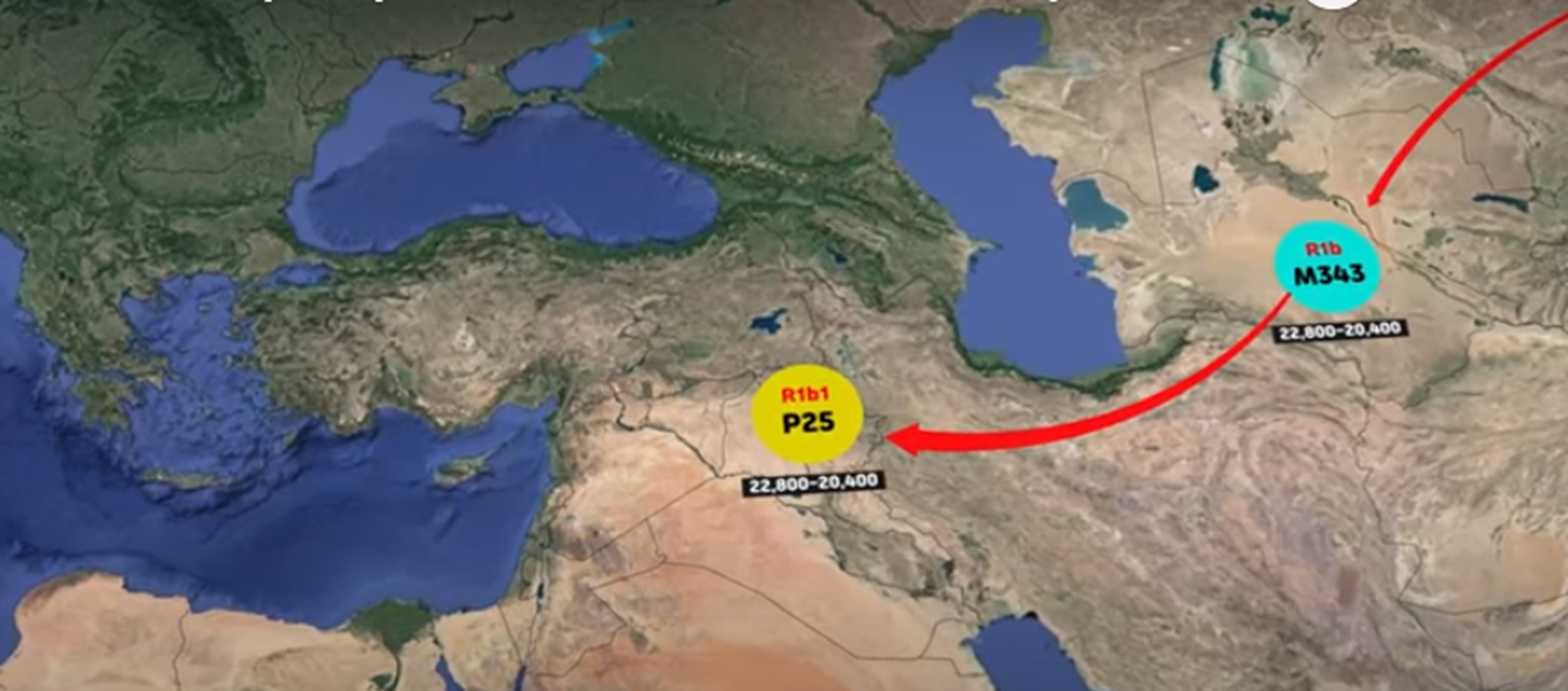
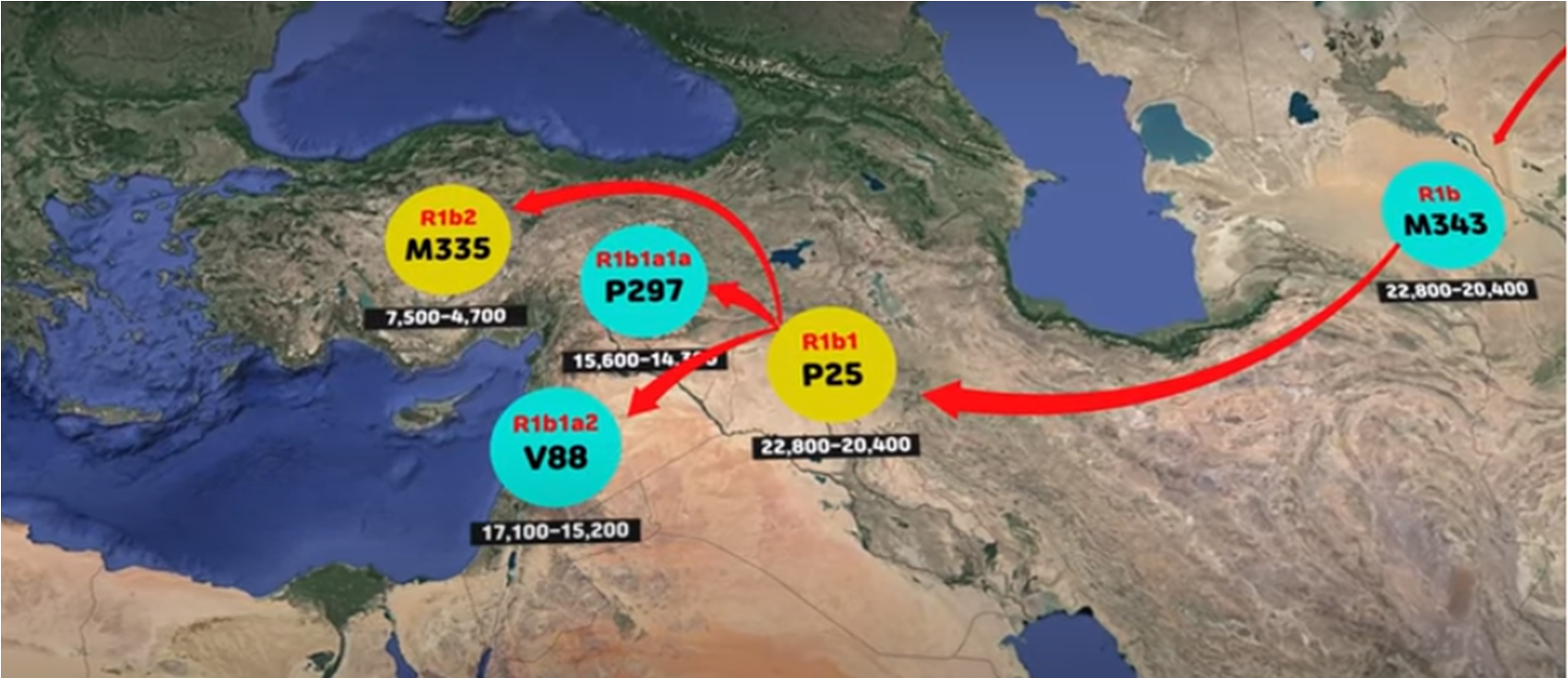
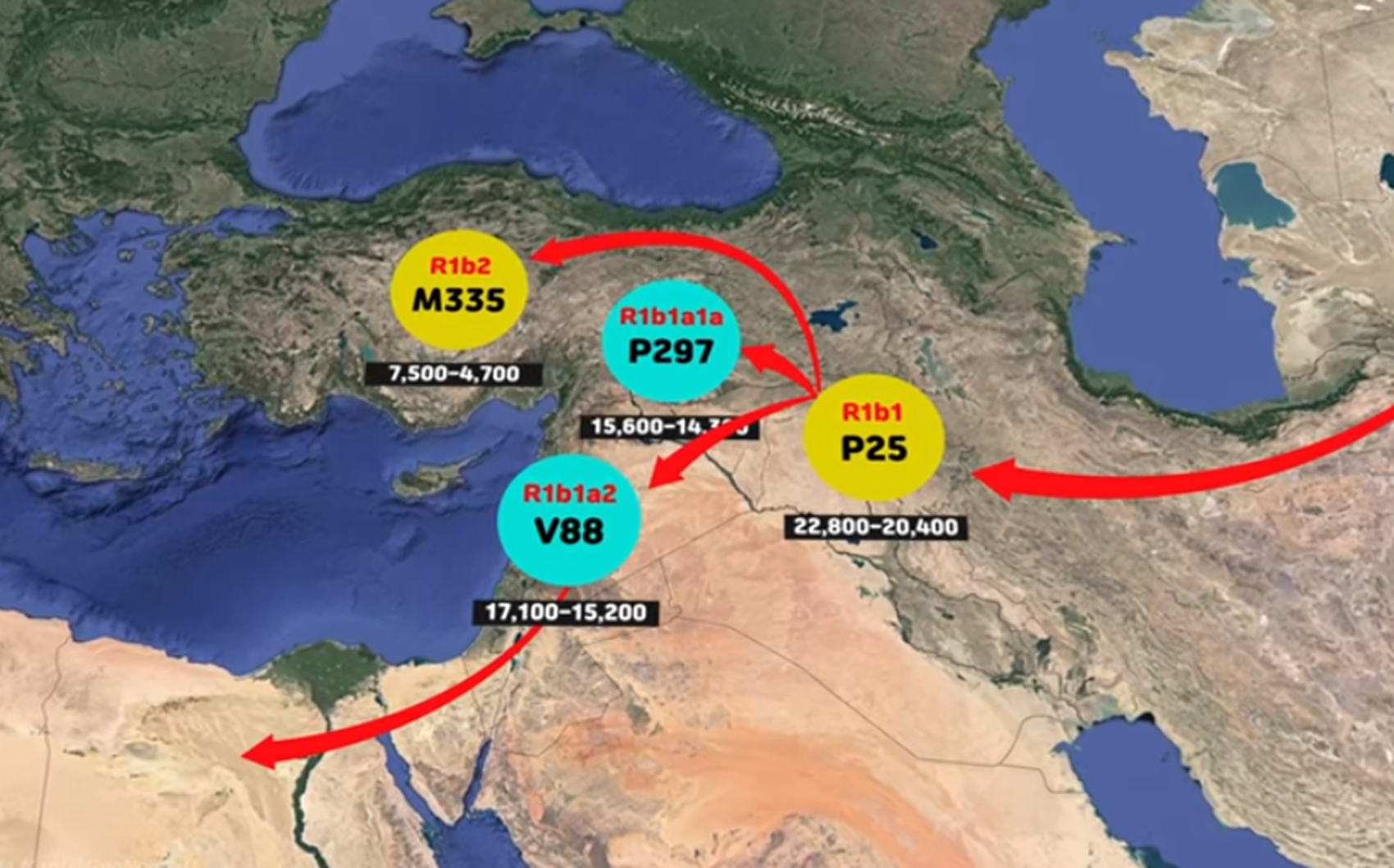
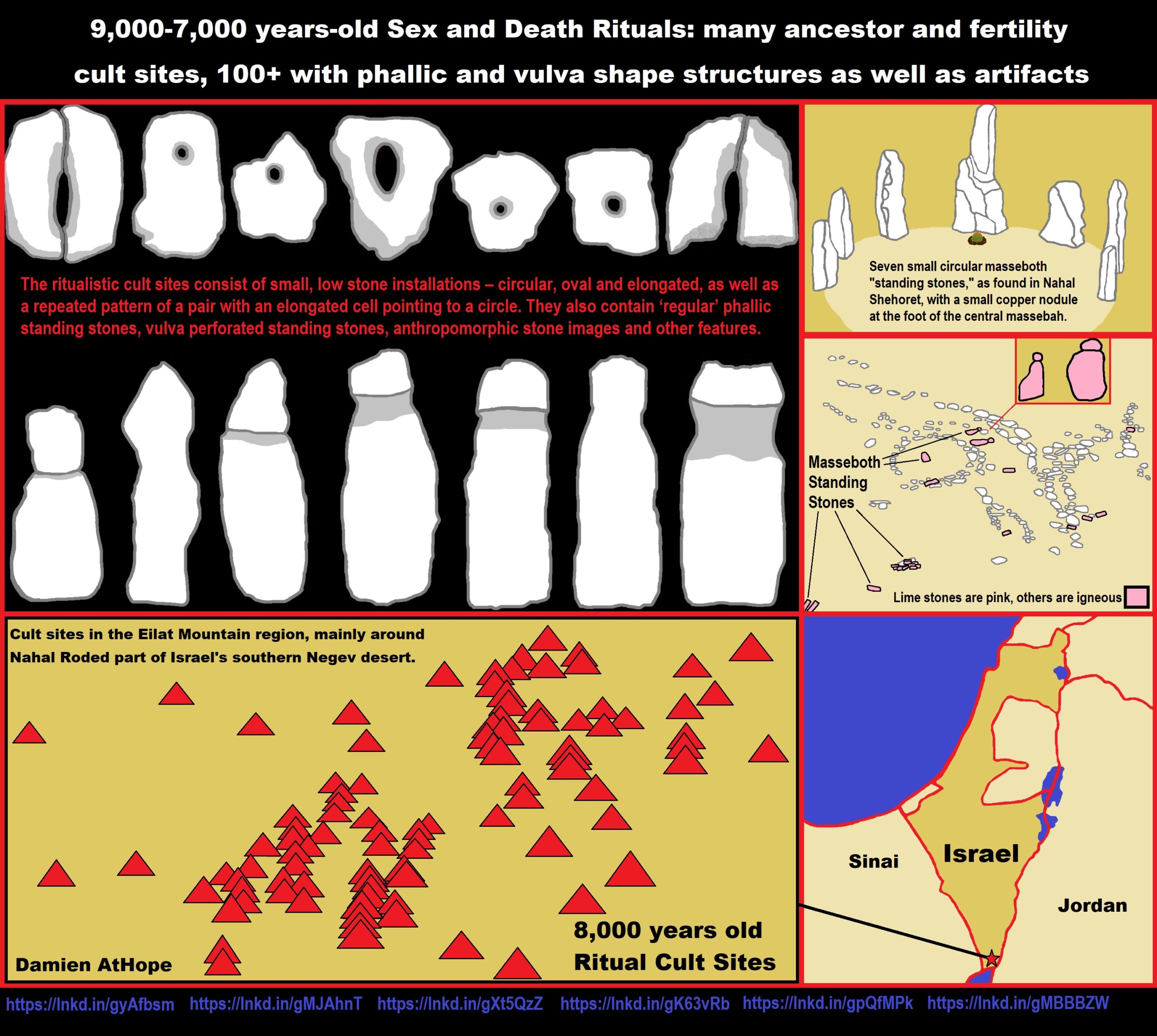

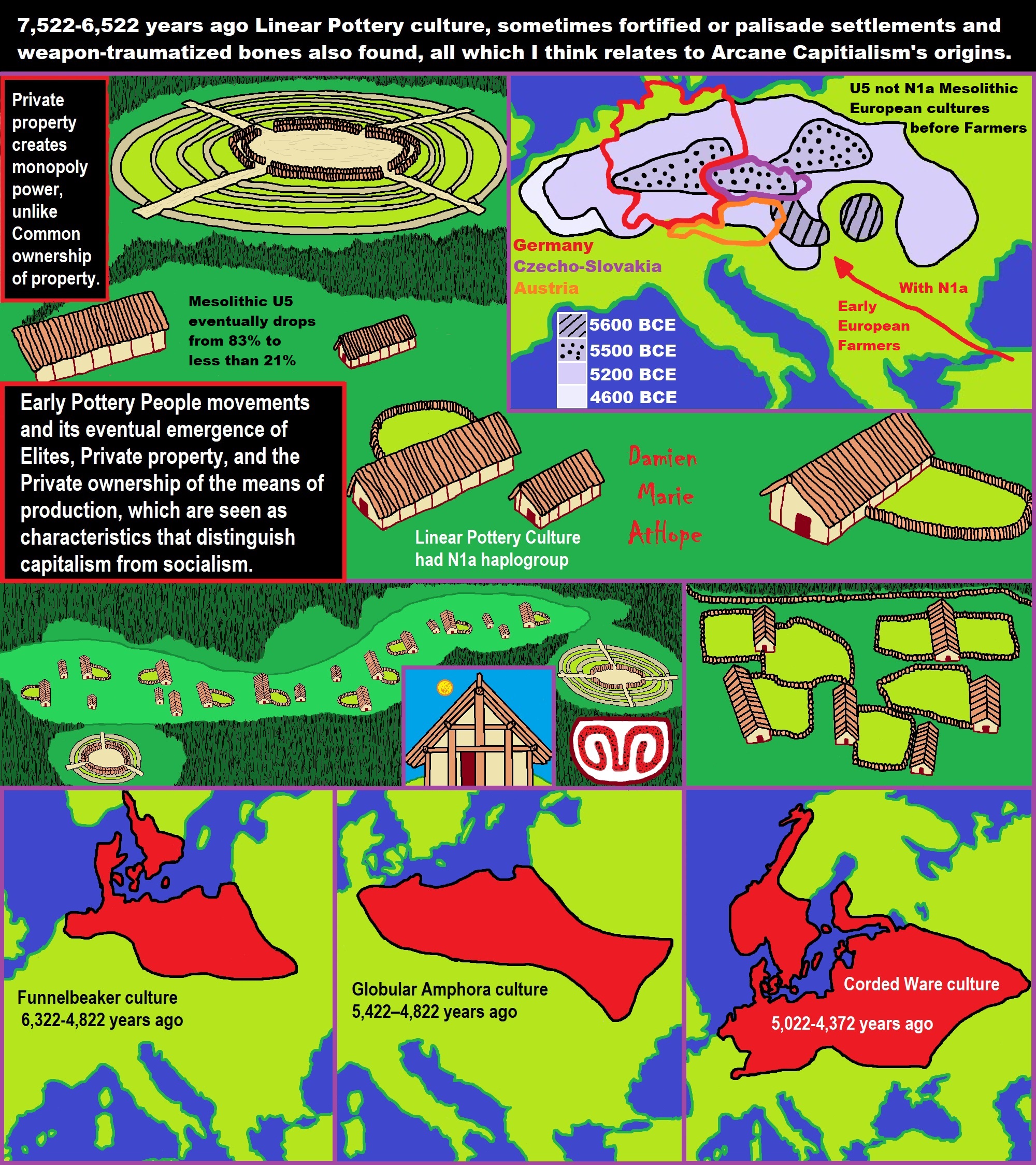
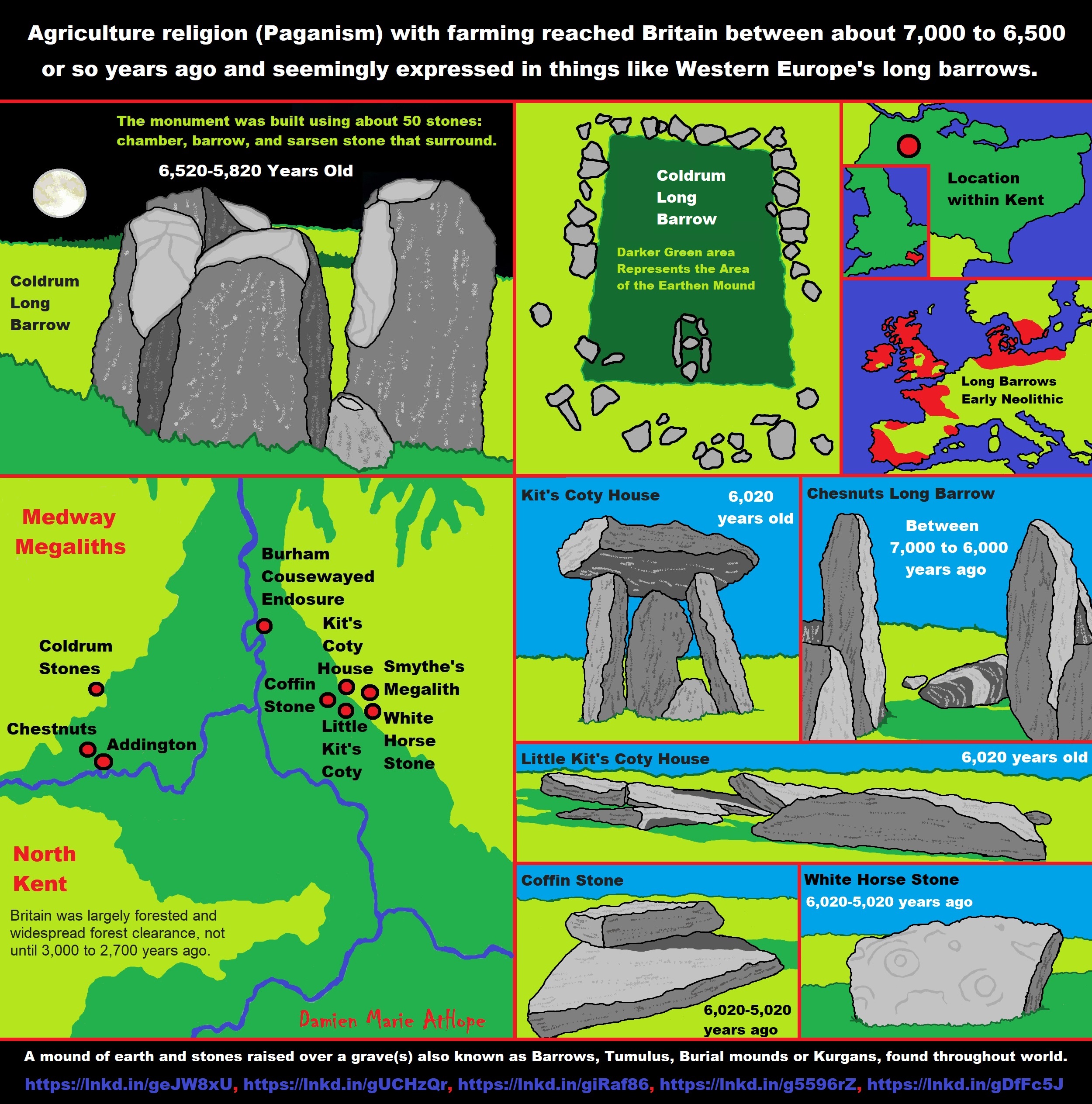
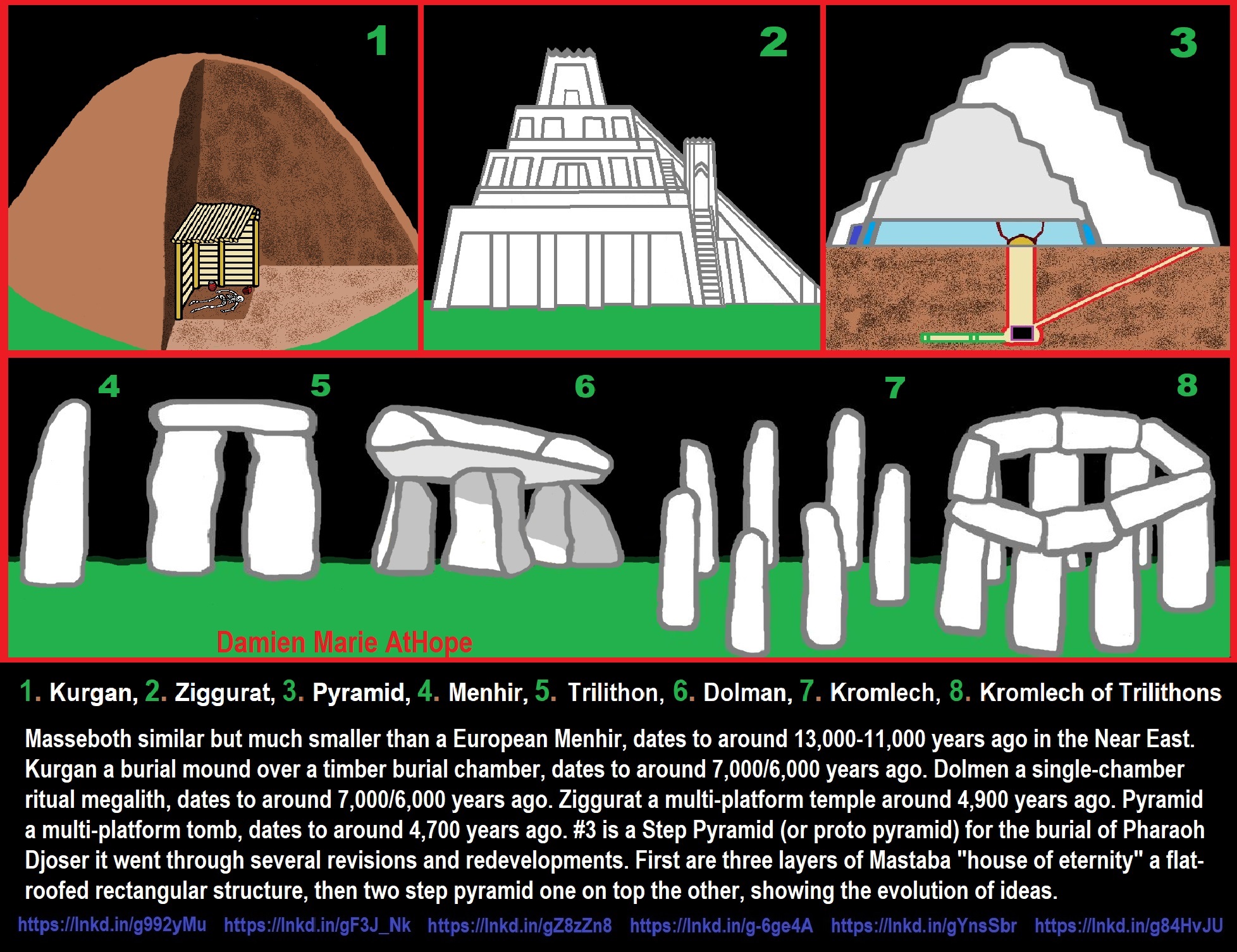

ref, ref, ref, ref, ref, ref, ref
Stonehenge: Paganistic Burial and Astrological Ritual Complex, England (5,100-3,600 years ago)
*Around 5,000 years ago Stonehenge (Britain):
Stonehenge: Paganistic Burial and Astrological Ritual Complex, England.
Stonehenge evolved in several construction phases, 1 (5,100 years ago), 2 (5,000 years ago), 3 I (4,600 years ago), 3 II (4,600-4,400 years ago), 3 III (2400-4,280 years ago), 3 IV (4,280-3,930 years ago), & 3 V (3,930-3,600 years ago). Anatolian/Turkish-farmers built Britain’s famous Stonehenge, as well as current males of Britain, 60-65% have Turkish genetics. Almost as the same as in Ireland where 85 percent of Irish men are descended from farming people that arrived 6,000 years ago. At or around Stonehenge 5,000-4,400 years ago, there were two separate burial rites, either letting the birds feed on bodies or cremation. And a 4,000-year-old burial pit for elite contains 14 females and only 9 males, as well as a chieftain’s grave, held several items including the depicted 4,000-year-old dagger. And a 4,000-year-old child’s grave held the depicted Folkton drums. As well as items from 4,600-3,600 involved gold beads, necklaces, earrings, pendants, and other jewelry show sophisticated burial culture. ref, ref, ref, ref, ref, ref, & ref
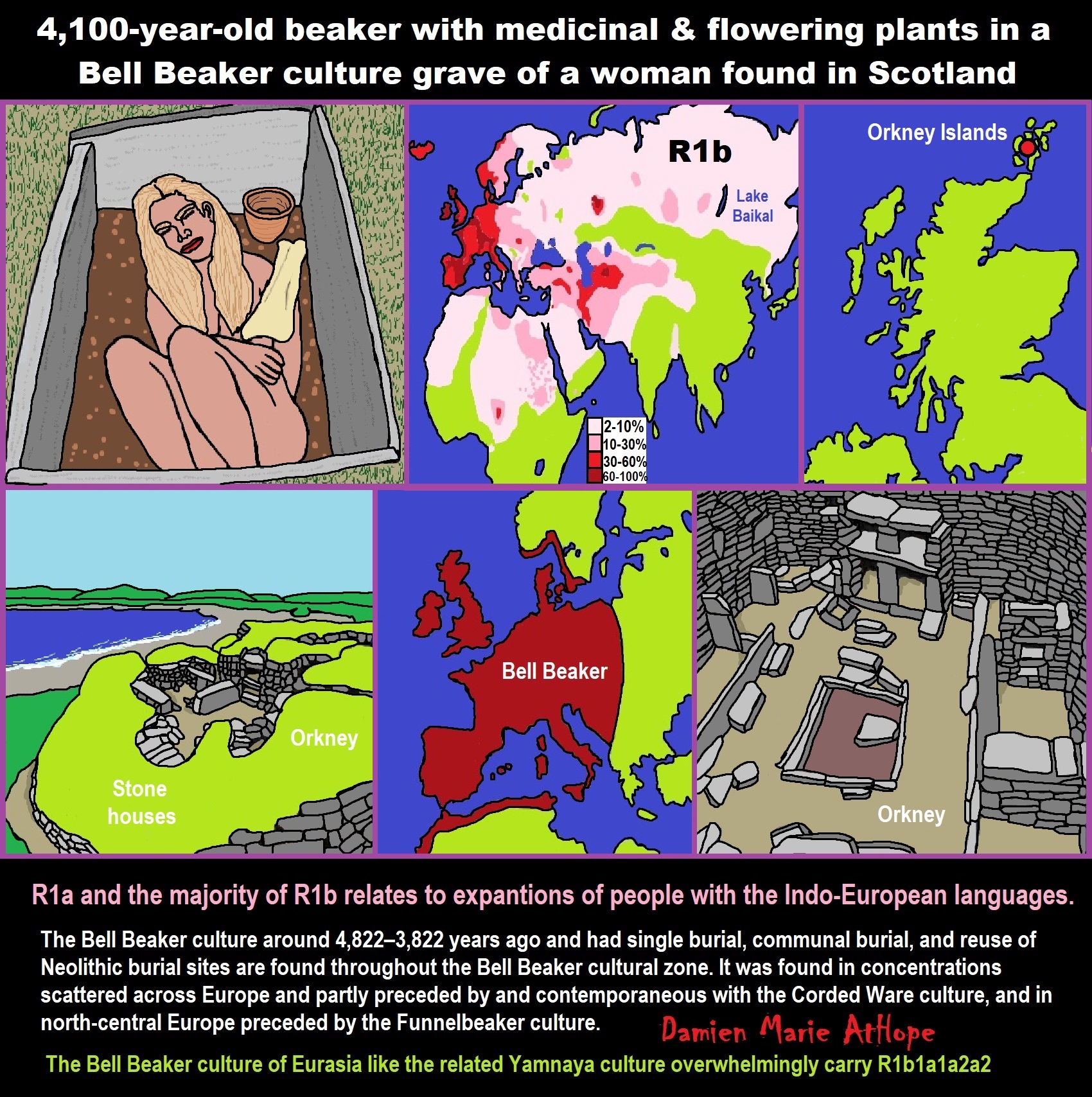
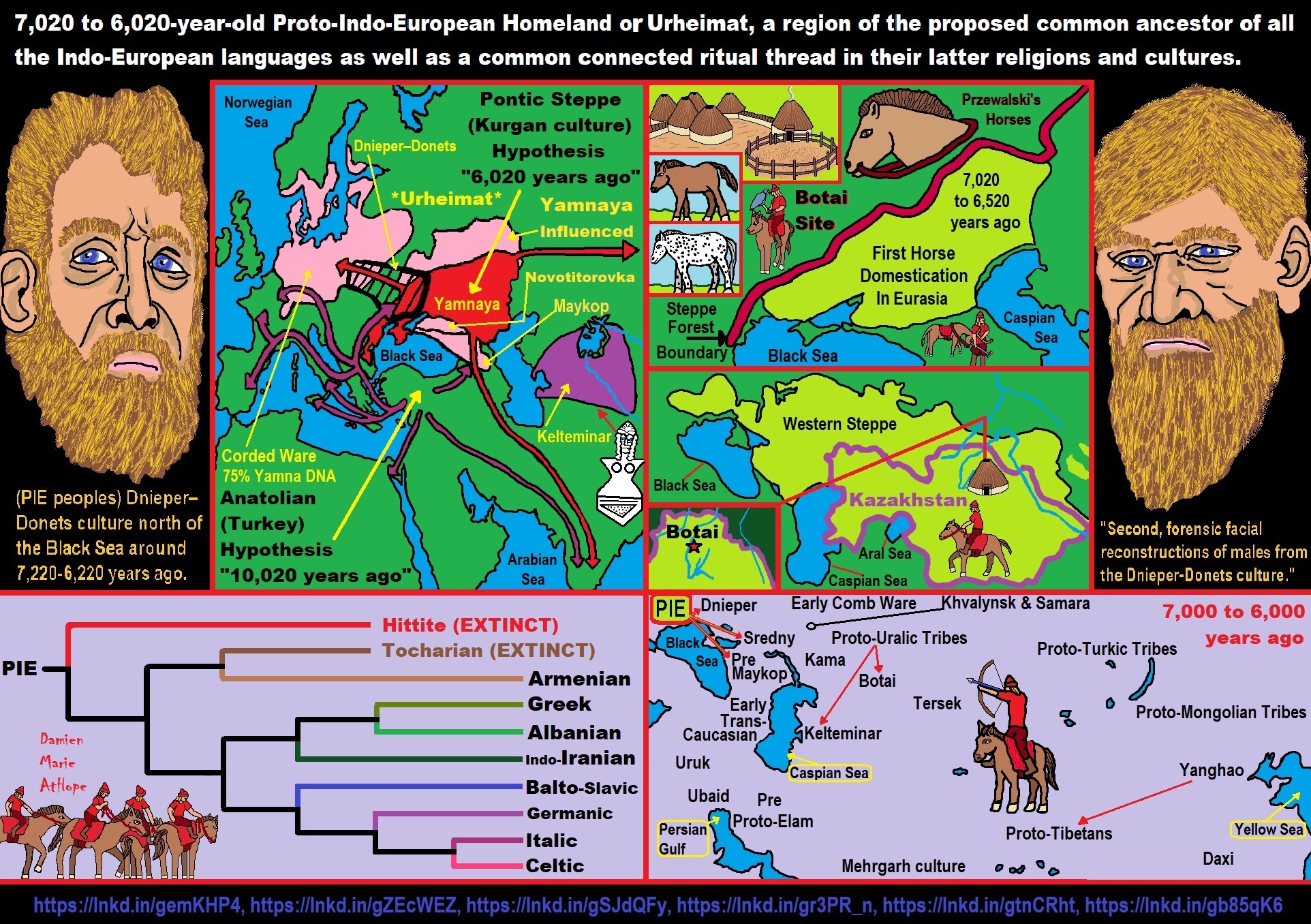

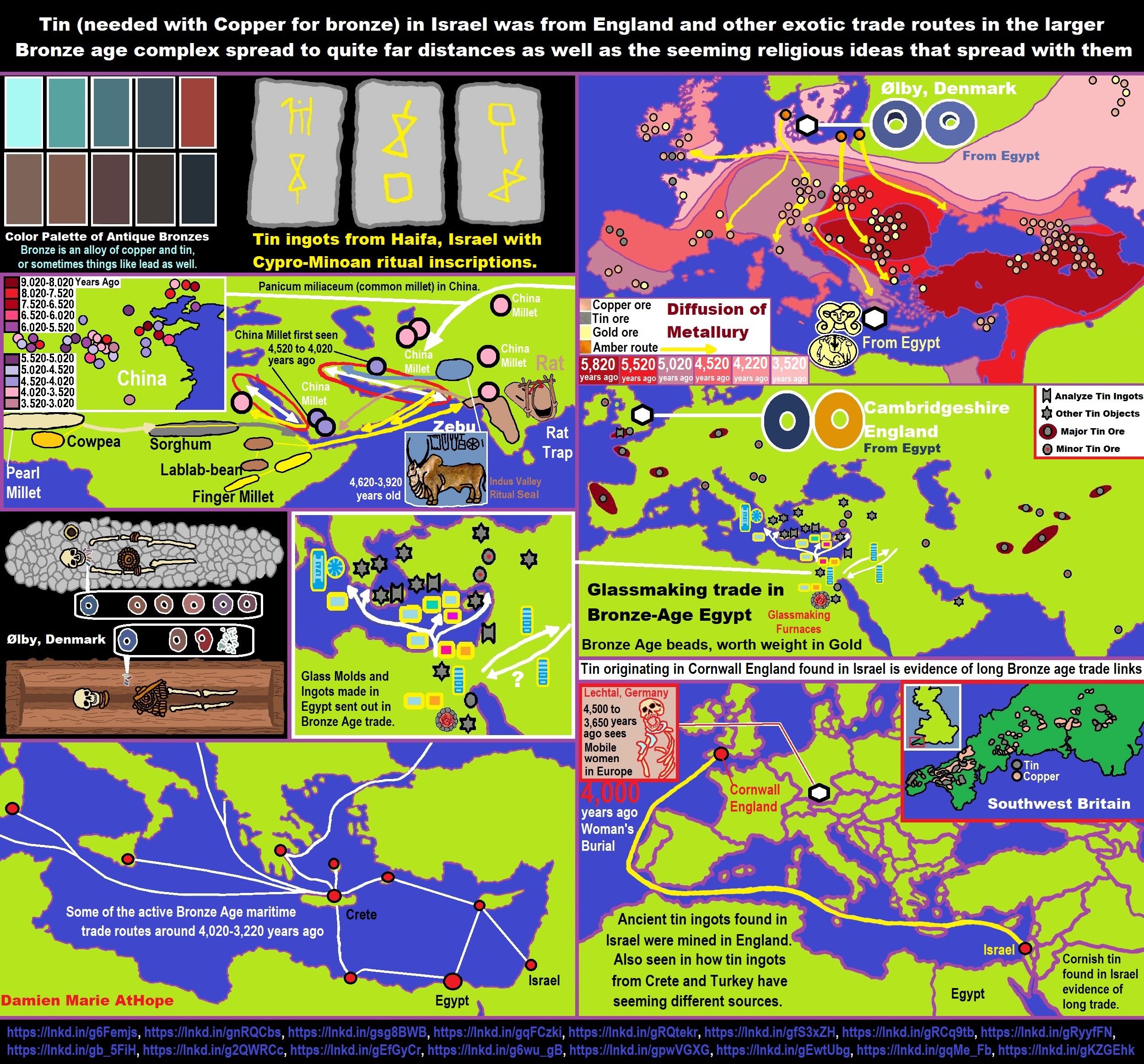
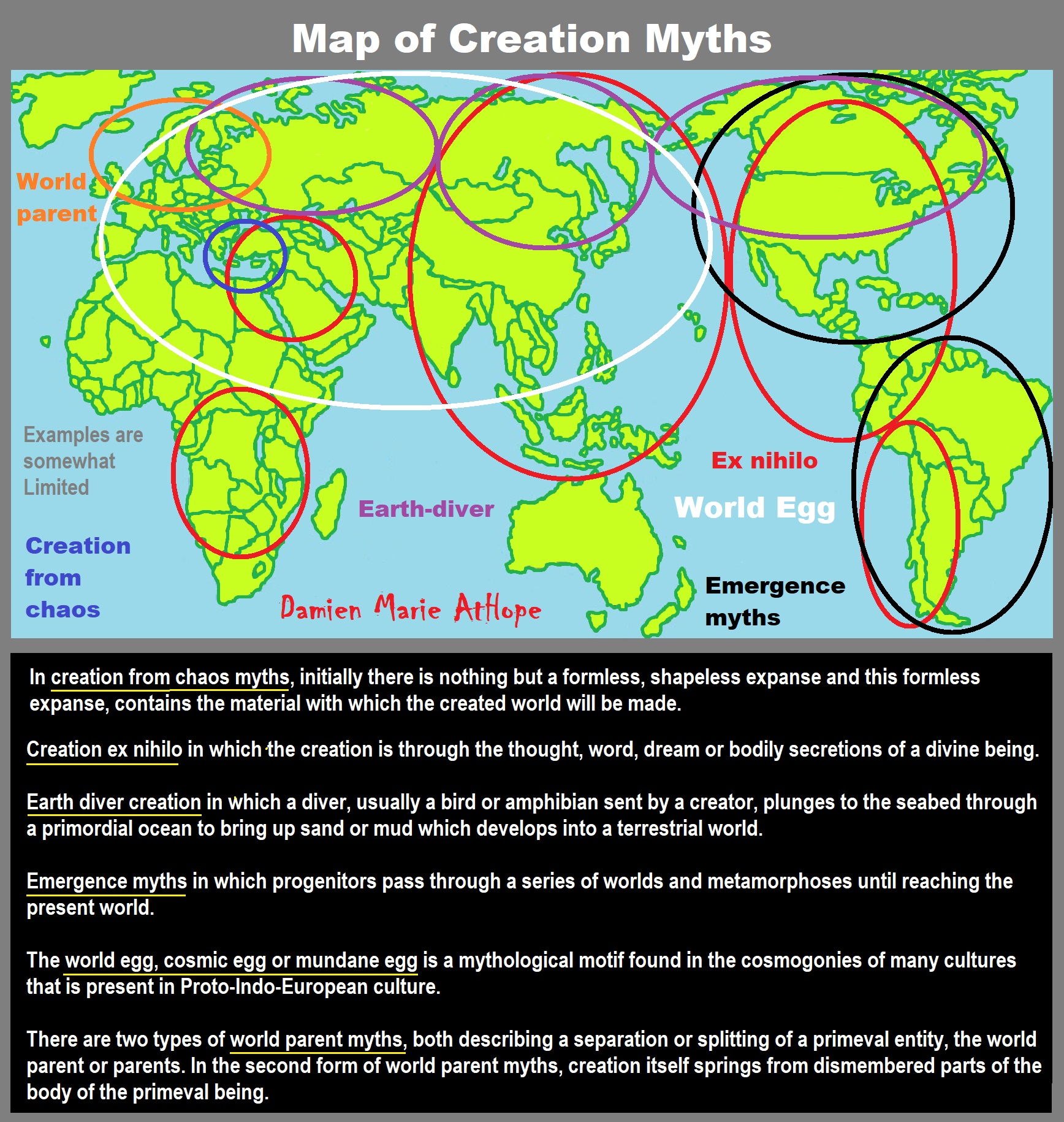
Creation myths: From chaos, Ex nihilo, Earth-diver, Emergence, World egg, and World parent
“A creation myth (or cosmogonic myth) is a symbolic narrative of how the world began and how people first came to inhabit it. While in popular usage the term myth often refers to false or fanciful stories, members of cultures often ascribe varying degrees of truth to their creation myths. In the society in which it is told, a creation myth is usually regarded as conveying profound truths – metaphorically, symbolically, historically, or literally. They are commonly, although not always, considered cosmogonical myths – that is, they describe the ordering of the cosmos from a state of chaos or amorphousness.” ref
“Creation myths often share a number of features. They often are considered sacred accounts and can be found in nearly all known religious traditions. They are all stories with a plot and characters who are either deities, human-like figures, or animals, who often speak and transform easily. They are often set in a dim and nonspecific past that historian of religion Mircea Eliade termed in illo tempore (‘at that time’). Creation myths address questions deeply meaningful to the society that shares them, revealing their central worldview and the framework for the self-identity of the culture and individual in a universal context. Creation myths develop in oral traditions and therefore typically have multiple versions; found throughout human culture, they are the most common form of myth.” ref
Creation myth definitions from modern references:
- “A “symbolic narrative of the beginning of the world as understood in a particular tradition and community. Creation myths are of central importance for the valuation of the world, for the orientation of humans in the universe, and for the basic patterns of life and culture.”
- “Creation myths tell us how things began. All cultures have creation myths; they are our primary myths, the first stage in what might be called the psychic life of the species. As cultures, we identify ourselves through the collective dreams we call creation myths, or cosmogonies. … Creation myths explain in metaphorical terms our sense of who we are in the context of the world, and in so doing they reveal our real priorities, as well as our real prejudices. Our images of creation say a great deal about who we are.”
- A “philosophical and theological elaboration of the primal myth of creation within a religious community. The term myth here refers to the imaginative expression in narrative form of what is experienced or apprehended as basic reality … The term creation refers to the beginning of things, whether by the will and act of a transcendent being, by emanation from some ultimate source, or in any other way.” ref
Religion professor Mircea Eliade defined the word myth in terms of creation:
“Myth narrates a sacred history; it relates an event that took place in primordial Time, the fabled time of the “beginnings.” In other words, myth tells how, through the deeds of Supernatural Beings, a reality came into existence, be it the whole of reality, the Cosmos, or only a fragment of reality – an island, a species of plant, a particular kind of human behavior, an institution.” ref
“All creation myths are in one sense etiological because they attempt to explain how the world formed and where humanity came from. Myths attempt to explain the unknown and sometimes teach a lesson.” ref
“Some Ethnologists and anthropologists who study origin myths say that in the modern context theologians try to discern humanity’s meaning from revealed truths and scientists investigate cosmology with the tools of empiricism and rationality, but creation myths define human reality in very different terms. In the past, historians of religion and other students of myth thought of such stories as forms of primitive or early-stage science or religion and analyzed them in a literal or logical sense. Today, however, they are seen as symbolic narratives which must be understood in terms of their own cultural context. Charles Long writes: “The beings referred to in the myth – gods, animals, plants – are forms of power grasped existentially. The myths should not be understood as attempts to work out a rational explanation of deity.” ref
“While creation myths are not literal explications, they do serve to define an orientation of humanity in the world in terms of a birth story. They provide the basis of a worldview that reaffirms and guides how people relate to the natural world, to any assumed spiritual world, and to each other. A creation myth acts as a cornerstone for distinguishing primary reality from relative reality, the origin and nature of being from non-being. In this sense, cosmogonic myths serve as a philosophy of life – but one expressed and conveyed through symbol rather than through systematic reason. And in this sense, they go beyond etiological myths (which explain specific features in religious rites, natural phenomena, or cultural life). Creation myths also help to orient human beings in the world, giving them a sense of their place in the world and the regard that they must have for humans and nature.” ref
Historian David Christian has summarised issues common to multiple creation myths:
“Each beginning seems to presuppose an earlier beginning. … Instead of meeting a single starting point, we encounter an infinity of them, each of which poses the same problem. … There are no entirely satisfactory solutions to this dilemma. What we have to find is not a solution but some way of dealing with the mystery …. And we have to do so using words. The words we reach for, from God to gravity, are inadequate to the task. So we have to use language poetically or symbolically; and such language, whether used by a scientist, a poet, or a shaman, can easily be misunderstood.” ref
“Mythologists have applied various schemes to classify creation myths found throughout human cultures. Eliade and his colleague Charles Long developed a classification based on some common motifs that reappear in stories the world over. The classification identifies five basic types: Brahmā, the Hindu deva of creation, emerges from a lotus risen from the navel of Viṣņu, who lies with Lakshmi on the serpent Ananta Shesha.” ref
- “Creation ex nihilo in which the creation is through the thought, word, dream, or bodily secretions of a divine being.
- Earth diver creation in which a diver, usually a bird or amphibian sent by a creator, plunges to the seabed through a primordial ocean to bring up sand or mud which develops into a terrestrial world.
- Emergence myths in which progenitors pass through a series of worlds and metamorphoses until reaching the present world.
- Creation by the dismemberment of a primordial being.
- Creation by the splitting or ordering of a primordial unity such as the cracking of a cosmic egg or a bringing order from chaos.” ref
“Marta Weigle further developed and refined this typology to highlight nine themes, adding elements such as deus faber, a creation crafted by a deity, creation from the work of two creators working together or against each other, creation from sacrifice, and creation from division/conjugation, accretion/conjunction, or secretion.” ref
An alternative system based on six recurring narrative themes was designed by Raymond Van Over:
- “Primeval abyss, an infinite expanse of waters or space.
- Originator deity which is awakened or an eternal entity within the abyss.
- Originator deity poised above the abyss.
- Cosmic egg or embryo.
- Originator deity creating life through sound or word.
- Life generating from the corpse or dismembered parts of an originator deity.” ref

People don’t commonly teach religious history, even that of their own claimed religion. No, rather they teach a limited “pro their religion” history of their religion from a religious perspective favorable to the religion of choice.

Do you truly think “Religious Belief” is only a matter of some personal choice?
Do you not see how coercive one’s world of choice is limited to the obvious hereditary belief, in most religious choices available to the child of religious parents or caregivers? Religion is more commonly like a family, culture, society, etc. available belief that limits the belief choices of the child and that is when “Religious Belief” is not only a matter of some personal choice and when it becomes hereditary faith, not because of the quality of its alleged facts or proposed truths but because everyone else important to the child believes similarly so they do as well simply mimicking authority beliefs handed to them. Because children are raised in religion rather than being presented all possible choices but rather one limited dogmatic brand of “Religious Belief” where children only have a choice of following the belief as instructed, and then personally claim the faith hereditary belief seen in the confirming to the belief they have held themselves all their lives. This is obvious in statements asked and answered by children claiming a faith they barely understand but they do understand that their family believes “this or that” faith, so they feel obligated to believe it too. While I do agree that “Religious Belief” should only be a matter of some personal choice, it rarely is… End Hereditary Religion!

Animism: Respecting the Living World by Graham Harvey
“How have human cultures engaged with and thought about animals, plants, rocks, clouds, and other elements in their natural surroundings? Do animals and other natural objects have a spirit or soul? What is their relationship to humans? In this new study, Graham Harvey explores current and past animistic beliefs and practices of Native Americans, Maori, Aboriginal Australians, and eco-pagans. He considers the varieties of animism found in these cultures as well as their shared desire to live respectfully within larger natural communities. Drawing on his extensive casework, Harvey also considers the linguistic, performative, ecological, and activist implications of these different animisms.” ref

We are like believing machines we vacuum up ideas, like Velcro sticks to almost everything. We accumulate beliefs that we allow to negatively influence our lives, often without realizing it. Our willingness must be to alter skewed beliefs that impend our balance or reason, which allows us to achieve new positive thinking and accurate outcomes.

My thoughts on Religion Evolution with external links for more info:
- (Pre-Animism Africa mainly, but also Europe, and Asia at least 300,000 years ago), (Pre-Animism – Oxford Dictionaries)
- (Animism Africa around 100,000 years ago), (Animism – Britannica.com)
- (Totemism Europe around 50,000 years ago), (Totemism – Anthropology)
- (Shamanism Siberia around 30,000 years ago), (Shamanism – Britannica.com)
- (Paganism Turkey around 12,000 years ago), (Paganism – BBC Religion)
- (Progressed Organized Religion “Institutional Religion” Egypt around 5,000 years ago), (Ancient Egyptian Religion – Britannica.com)
- (CURRENT “World” RELIGIONS after 4,000 years ago) (Origin of Major Religions – Sacred Texts)
- (Early Atheistic Doubting at least by 2,600 years ago) (History of Atheism – Wikipedia)
“Religion is an Evolved Product” and Yes, Religion is Like Fear Given Wings…
Atheists talk about gods and religions for the same reason doctors talk about cancer, they are looking for a cure, or a firefighter talks about fires because they burn people and they care to stop them. We atheists too often feel a need to help the victims of mental slavery, held in the bondage that is the false beliefs of gods and the conspiracy theories of reality found in religions.
Understanding Religion Evolution:
- Pre-Animism (at least 300,000 years ago)
- Animism (Africa: 100,000 years ago)
- Totemism (Europe: 50,000 years ago)
- Shamanism (Siberia: 30,000 years ago)
- Paganism (Turkey: 12,000 years ago)
- Progressed organized religion (Egypt: 5,000 years ago), (Egypt, the First Dynasty 5,150 years ago)
- CURRENT “World” RELIGIONS (after 4,000 years ago)
- Early Atheistic Doubting (at least by 2,600 years ago)
“An Archaeological/Anthropological Understanding of Religion Evolution”
It seems ancient peoples had to survived amazing threats in a “dangerous universe (by superstition perceived as good and evil),” and human “immorality or imperfection of the soul” which was thought to affect the still living, leading to ancestor worship. This ancestor worship presumably led to the belief in supernatural beings, and then some of these were turned into the belief in gods. This feeble myth called gods were just a human conceived “made from nothing into something over and over, changing, again and again, taking on more as they evolve, all the while they are thought to be special,” but it is just supernatural animistic spirit-belief perceived as sacred.
Quick Evolution of Religion?
Pre-Animism (at least 300,000 years ago) pre-religion is a beginning that evolves into later Animism. So, Religion as we think of it, to me, all starts in a general way with Animism (Africa: 100,000 years ago) (theoretical belief in supernatural powers/spirits), then this is physically expressed in or with Totemism (Europe: 50,000 years ago) (theoretical belief in mythical relationship with powers/spirits through a totem item), which then enlists a full-time specific person to do this worship and believed interacting Shamanism (Siberia/Russia: 30,000 years ago) (theoretical belief in access and influence with spirits through ritual), and then there is the further employment of myths and gods added to all the above giving you Paganism (Turkey: 12,000 years ago) (often a lot more nature-based than most current top world religions, thus hinting to their close link to more ancient religious thinking it stems from). My hypothesis is expressed with an explanation of the building of a theatrical house (modern religions development). Progressed organized religion (Egypt: 5,000 years ago) with CURRENT “World” RELIGIONS (after 4,000 years ago).
Historically, in large city-state societies (such as Egypt or Iraq) starting around 5,000 years ago culminated to make religion something kind of new, a sociocultural-governmental-religious monarchy, where all or at least many of the people of such large city-state societies seem familiar with and committed to the existence of “religion” as the integrated life identity package of control dynamics with a fixed closed magical doctrine, but this juggernaut integrated religion identity package of Dogmatic-Propaganda certainly did not exist or if developed to an extent it was highly limited in most smaller prehistoric societies as they seem to lack most of the strong control dynamics with a fixed closed magical doctrine (magical beliefs could be at times be added or removed). Many people just want to see developed religious dynamics everywhere even if it is not. Instead, all that is found is largely fragments until the domestication of religion.
Religions, as we think of them today, are a new fad, even if they go back to around 6,000 years in the timeline of human existence, this amounts to almost nothing when seen in the long slow evolution of religion at least around 70,000 years ago with one of the oldest ritual worship. Stone Snake of South Africa: “first human worship” 70,000 years ago. This message of how religion and gods among them are clearly a man-made thing that was developed slowly as it was invented and then implemented peace by peace discrediting them all. Which seems to be a simple point some are just not grasping how devastating to any claims of truth when we can see the lie clearly in the archeological sites.
I wish people fought as hard for the actual values as they fight for the group/clan names political or otherwise they think support values. Every amount spent on war is theft to children in need of food or the homeless kept from shelter.
Here are several of my blog posts on history:
- To Find Truth You Must First Look
- (Magdalenian/Iberomaurusian) Connections to the First Paganists of the early Neolithic Near East Dating from around 17,000 to 12,000 Years Ago
- Natufians: an Ancient People at the Origins of Agriculture and Sedentary Life
- Possible Clan Leader/Special “MALE” Ancestor Totem Poles At Least 13,500 years ago?
- Jewish People with DNA at least 13,200 years old, Judaism, and the Origins of Some of its Ideas
- Baltic Reindeer Hunters: Swiderian, Lyngby, Ahrensburgian, and Krasnosillya cultures 12,020 to 11,020 years ago are evidence of powerful migratory waves during the last 13,000 years and a genetic link to Saami and the Finno-Ugric peoples.
- The Rise of Inequality: patriarchy and state hierarchy inequality
- Fertile Crescent 12,500 – 9,500 Years Ago: fertility and death cult belief system?
- 12,400 – 11,700 Years Ago – Kortik Tepe (Turkey) Pre/early-Agriculture Cultic Ritualism
- Ritualistic Bird Symbolism at Gobekli Tepe and its “Ancestor Cult”
- Male-Homosexual (female-like) / Trans-woman (female) Seated Figurine from Gobekli Tepe
- Could a 12,000-year-old Bull Geoglyph at Göbekli Tepe relate to older Bull and Female Art 25,000 years ago and Later Goddess and the Bull cults like Catal Huyuk?
- Sedentism and the Creation of goddesses around 12,000 years ago as well as male gods after 7,000 years ago.
- Alcohol, where Agriculture and Religion Become one? Such as Gobekli Tepe’s Ritualistic use of Grain as Food and Ritual Drink
- Neolithic Ritual Sites with T-Pillars and other Cultic Pillars
- Paganism: Goddesses around 12,000 years ago then Male Gods after 7,000 years ago
- First Patriarchy: Split of Women’s Status around 12,000 years ago & First Hierarchy: fall of Women’s Status around 5,000 years ago.
- Natufians: an Ancient People at the Origins of Agriculture and Sedentary Life
- J DNA and the Spread of Agricultural Religion (paganism)
- Paganism: an approximately 12,000-year-old belief system
- Paganism 12,000 years old: related to “Anarchism and Socialism” (Pre-Capitalism)
- Shaman burial in Israel 12,000 years ago and the Shamanism Phenomena
- Need to Mythicized: gods and goddesses
- 12,000 – 7,000 Years Ago – Paleo-Indian Culture (The Americas)
- 12,000 – 2,000 Years Ago – Indigenous-Scandinavians (Nordic)
- Norse did not wear helmets with horns?
- Pre-Pottery Neolithic Skull Cult around 11,500 to 8,400 Years Ago?
- 10,400 – 10,100 Years Ago, in Turkey the Nevail Cori Religious Settlement
- 9,000-6,500 Years Old Submerged Pre-Pottery/Pottery Neolithic Ritual Settlements off Israel’s Coast
- Catal Huyuk “first religious designed city” around 9,500 to 7,700 years ago (Turkey)
- Cultic Hunting at Catal Huyuk “first religious designed city”
- Special Items and Art as well as Special Elite Burials at Catal Huyuk
- New Rituals and Violence with the appearance of Pottery and People?
- Haplogroup N and its related Uralic Languages and Cultures
- Ainu people, Sámi people, Native Americans, the Ancient North Eurasians, and Paganistic-Shamanism with Totemism
- Ideas, Technology and People from Turkey, Europe, to China and Back again 9,000 to 5,000 years ago?
- First Pottery of Europe and the Related Cultures
- 9,000 years old Neolithic Artifacts Judean Desert and Hills Israel
- 9,000-7,000 years-old Sex and Death Rituals: Cult Sites in Israel, Jordan, and the Sinai
- 9,000-8500 year old Horned Female shaman Bad Dürrenberg Germany
- Neolithic Jewelry and the Spread of Farming in Europe Emerging out of West Turkey
- 8,600-year-old Tortoise Shells in Neolithic graves in central China have Early Writing and Shamanism
- Swing of the Mace: the rise of Elite, Forced Authority, and Inequality begin to Emerge 8,500 years ago?
- Migrations and Changing Europeans Beginning around 8,000 Years Ago
- My “Steppe-Anatolian-Kurgan hypothesis” 8,000/7,000 years ago
- Around 8,000-year-old Shared Idea of the Mistress of Animals, “Ritual” Motif
- Pre-Columbian Red-Paint (red ochre) Maritime Archaic Culture 8,000-3,000 years ago
- 7,522-6,522 years ago Linear Pottery culture which I think relates to Arcane Capitalism’s origins
- Arcane Capitalism: Primitive socialism, Primitive capital, Private ownership, Means of production, Market capitalism, Class discrimination, and Petite bourgeoisie (smaller capitalists)
- 7,500-4,750 years old Ritualistic Cucuteni-Trypillian culture of Moldova, Romania, and Ukraine
- Roots of a changing early society 7,200-6,700 years ago Jordan and Israel
- Agriculture religion (Paganism) with farming reached Britain between about 7,000 to 6,500 or so years ago and seemingly expressed in things like Western Europe’s Long Barrows
- My Thoughts on Possible Migrations of “R” DNA and Proto-Indo-European?
- “Millet” Spreading from China 7,022 years ago to Europe and related Language may have Spread with it leading to Proto-Indo-European
- Proto-Indo-European (PIE), ancestor of Indo-European languages: DNA, Society, Language, and Mythology
- The Dnieper–Donets culture and Asian varieties of Millet from China to the Black Sea region of Europe by 7,022 years ago
- Kurgan 6,000 years ago/dolmens 7,000 years ago: funeral, ritual, and other?
- 7,020 to 6,020-year-old Proto-Indo-European Homeland of Urheimat or proposed home of their Language and Religion
- Ancient Megaliths: Kurgan, Ziggurat, Pyramid, Menhir, Trilithon, Dolman, Kromlech, and Kromlech of Trilithons
- The Mytheme of Ancient North Eurasian Sacred-Dog belief and similar motifs are found in Indo-European, Native American, and Siberian comparative mythology
- Elite Power Accumulation: Ancient Trade, Tokens, Writing, Wealth, Merchants, and Priest-Kings
- Sacred Mounds, Mountains, Kurgans, and Pyramids may hold deep connections?
- Between 7,000-5,000 Years ago, rise of unequal hierarchy elite, leading to a “birth of the State” or worship of power, strong new sexism, oppression of non-elites, and the fall of Women’s equal status
- Paganism 7,000-5,000 years old: related to “Anarchism and Socialism” (Capitalism) (World War 0) Elite & their slaves
- Hell and Underworld mythologies starting maybe as far back as 7,000 to 5,000 years ago with the Proto-Indo-Europeans?
- The First Expression of the Male God around 7,000 years ago?
- White (light complexion skin) Bigotry and Sexism started 7,000 years ago?
- Around 7,000-year-old Shared Idea of the Divine Bird (Tutelary and/or Trickster spirit/deity), “Ritual” Motif
- Nekhbet an Ancient Egyptian Vulture Goddess and Tutelary Deity
- 6,720 to 4,920 years old Ritualistic Hongshan Culture of Inner Mongolia with 5,000-year-old Pyramid Mounds and Temples
- First proto-king in the Balkans, Varna culture around 6,500 years ago?
- 6,500–5,800 years ago in Israel Late Chalcolithic (Copper Age) Period in the Southern Levant Seems to Express Northern Levant Migrations, Cultural and Religious Transfer
- KING OF BEASTS: Master of Animals “Ritual” Motif, around 6,000 years old or older…
- Around 6000-year-old Shared Idea of the Solid Wheel & the Spoked Wheel-Shaped Ritual Motif
- “The Ghassulian Star,” a mysterious 6,000-year-old mural from Jordan; a Proto-Star of Ishtar, Star of Inanna or Star of Venus?
- Religious/Ritual Ideas, including goddesses and gods as well as ritual mounds or pyramids from Northeastern Asia at least 6,000 years old, seemingly filtering to Iran, Iraq, the Mediterranean, Europe, Egypt, and the Americas?
- Maykop (5,720–5,020 years ago) Caucasus region Bronze Age culture-related to Copper Age farmers from the south, influenced by the Ubaid period and Leyla-Tepe culture, as well as influencing the Kura-Araxes culture
- 5-600-year-old Tomb, Mummy, and First Bearded Male Figurine in a Grave
- Kura-Araxes Cultural 5,520 to 4,470 years old DNA traces to the Canaanites, Arabs, and Jews
- Minoan/Cretan (Keftiu) Civilization and Religion around 5,520 to 3,120 years ago
- Evolution Of Science at least by 5,500 years ago
- 5,500 Years old birth of the State, the rise of Hierarchy, and the fall of Women’s status
- “Jiroft culture” 5,100 – 4,200 years ago and the History of Iran
- Stonehenge: Paganistic Burial and Astrological Ritual Complex, England (5,100-3,600 years ago)
- Around 5,000-year-old Shared Idea of the “Tree of Life” Ritual Motif
- Complex rituals for elite, seen from China to Egypt, at least by 5,000 years ago
- Around 5,000 years ago: “Birth of the State” where Religion gets Military Power and Influence
- The Center of the World “Axis Mundi” and/or “Sacred Mountains” Mythology Could Relate to the Altai Mountains, Heart of the Steppe
- Progressed organized religion starts, an approximately 5,000-year-old belief system
- China’s Civilization between 5,000-3,000 years ago, was a time of war and class struggle, violent transition from free clans to a Slave or Elite society
- Origin of Logics is Naturalistic Observation at least by around 5,000 years ago.
- Paganism 5,000 years old: progressed organized religion and the state: related to “Anarchism and Socialism” (Kings and the Rise of the State)
- Ziggurats (multi-platform temples: 4,900 years old) to Pyramids (multi-platform tombs: 4,700 years old)
- Did a 4,520–4,420-year-old Volcano In Turkey Inspire the Bible God?
- Finland’s Horned Shaman and Pre-Horned-God at least 4,500 years ago?
- 4,000-year-Old Dolmens in Israel: A Connected Dolmen Religious Phenomenon?
- Creation myths: From chaos, Ex nihilo, Earth-diver, Emergence, World egg, and World parent
- Bronze Age “Ritual” connections of the Bell Beaker culture with the Corded Ware/Single Grave culture, which were related to the Yamnaya culture and Proto-Indo-European Languages/Religions
- Low Gods (Earth/ Tutelary deity), High Gods (Sky/Supreme deity), and Moralistic Gods (Deity enforcement/divine order)
- The exchange of people, ideas, and material-culture including, to me, the new god (Sky Father) and goddess (Earth Mother) religion between the Cucuteni-Trypillians and others which is then spread far and wide
- Koryaks: Indigenous People of the Russian Far East and Big Raven myths also found in Tlingit, Haida, Tsimshian, and other Indigenous People of North America
- 42 Principles Of Maat (Egyptian Goddess of the justice) around 4,400 years ago, 2000 Years Before Ten Commandments
- “Happy Easter” Well Happy Eostre/Ishter
- 4,320-3,820 years old “Shimao” (North China) site with Totemistic-Shamanistic Paganism and a Stepped Pyramid
- 4,250 to 3,400 Year old Stonehenge from Russia: Arkaim?
- 4,100-year-old beaker with medicinal & flowering plants in a grave of a woman in Scotland
- Early European Farmer ancestry, Kelif el Boroud people with the Cardial Ware culture, and the Bell Beaker culture Paganists too, spread into North Africa, then to the Canary Islands off West Africa
- Flood Accounts: Gilgamesh epic (4,100 years ago) Noah in Genesis (2,600 years ago)
- Paganism 4,000 years old: related to “Anarchism and Socialism” (First Moralistic gods, then the Origin time of Monotheism)
- When was the beginning: TIMELINE OF CURRENT RELIGIONS, which start around 4,000 years ago.
- Early Religions Thought to Express Proto-Monotheistic Systems around 4,000 years ago
- Kultepe? An archaeological site with a 4,000 years old women’s rights document.
- Single God Religions (Monotheism) = “Man-o-theism” started around 4,000 years ago with the Great Sky Spirit/God Tiān (天)?
- Confucianism’s Tiān (Shangdi god 4,000 years old): Supernaturalism, Pantheism or Theism?
- Yes, Your Male God is Ridiculous
- Mythology, a Lunar Deity is a Goddess or God of the Moon
- Sacred Land, Hills, and Mountains: Sami Mythology (Paganistic Shamanism)
- Horse Worship/Sacrifice: mythical union of Ruling Elite/Kingship and the Horse
- The Amorite/Amurru people’s God Amurru “Lord of the Steppe”, relates to the Origins of the Bible God?
- Bronze Age Exotic Trade Routes Spread Quite Far as well as Spread Religious Ideas with Them
- Sami and the Northern Indigenous Peoples Landscape, Language, and its Connection to Religion
- Prototype of Ancient Analemmatic Sundials around 3,900-3,150 years ago and a Possible Solar Connection to gods?
- Judaism is around 3,450 or 3,250 years old. (“Paleo-Hebrew” 3,000 years ago and Torah 2,500 years ago)
- The Weakening of Ancient Trade and the Strengthening of Religions around 3000 years ago?
- Are you aware that there are religions that worship women gods, explain now religion tears women down?
- Animistic, Totemistic, and Paganistic Superstition Origins of bible god and the bible’s Religion.
- Myths and Folklore: “Trickster gods and goddesses”
- Jews, Judaism, and the Origins of Some of its Ideas
- An Old Branch of Religion Still Giving Fruit: Sacred Trees
- Dating the BIBLE: naming names and telling times (written less than 3,000 years ago, provable to 2,200 years ago)
- Did a Volcano Inspire the bible god?
- Dené–Yeniseian language, Old Copper Complex, and Pre-Columbian Mound Builders?
- No “dinosaurs and humans didn’t exist together just because some think they are in the bible itself”
- Sacred Shit and Sacred Animals?
- Everyone Killed in the Bible Flood? “Nephilim” (giants)?
- Hey, Damien dude, I have a question for you regarding “the bible” Exodus.
- Archaeology Disproves the Bible
- Bible Battle, Just More, Bible Babble
- The Jericho Conquest lie?
- Canaanites and Israelites?
- Accurate Account on how did Christianity Began?
- Let’s talk about Christianity.
- So the 10 commandments isn’t anything to go by either right?
- Misinformed christian
- Debunking Jesus?
- Paulism vs Jesus
- Ok, you seem confused so let’s talk about Buddhism.
- Unacknowledged Buddhism: Gods, Savior, Demons, Rebirth, Heavens, Hells, and Terrorism
- His Foolishness The Dalai Lama
- Yin and Yang is sexist with an ORIGIN around 2,300 years ago?
- I Believe Archaeology, not Myths & Why Not, as the Religious Myths Already Violate Reason!
- Archaeological, Scientific, & Philosophic evidence shows the god myth is man-made nonsense.
- Aquatic Ape Theory/Hypothesis? As Always, Just Pseudoscience.
- Ancient Aliens Conspiracy Theorists are Pseudohistorians
- The Pseudohistoric and Pseudoscientific claims about “Bakoni Ruins” of South Africa
- Why do people think Religion is much more than supernaturalism and superstitionism?
- Religion is an Evolved Product
- Was the Value of Ancient Women Different?
- 1000 to 1100 CE, human sacrifice Cahokia Mounds a pre-Columbian Native American site
- Feminist atheists as far back as the 1800s?
- Promoting Religion as Real is Mentally Harmful to a Flourishing Humanity
- Screw All Religions and Their Toxic lies, they are all fraud
- Forget Religions’ Unfounded Myths, I Have Substantiated “Archaeology Facts.”
- Religion Dispersal throughout the World
- I Hate Religion Just as I Hate all Pseudoscience
- Exposing Scientology, Eckankar, Wicca and Other Nonsense?
- Main deity or religious belief systems
- Quit Trying to Invent Your God From the Scraps of Science.
- Archaeological, Scientific, & Philosophic evidence shows the god myth is man-made nonsense.
- Ancient Alien Conspiracy Theorists: Misunderstanding, Rhetoric, Misinformation, Fabrications, and Lies
- Misinformation, Distortion, and Pseudoscience in Talking with a Christian Creationist
- Judging the Lack of Goodness in Gods, Even the Norse God Odin
- Challenging the Belief in God-like Aliens and Gods in General
- A Challenge to Christian use of Torture Devices?
- Yes, Hinduism is a Religion
- Trump is One of the Most Reactionary Forces of Far-right Christian Extremism
- Was the Bull Head a Symbol of God? Yes!
- Primate Death Rituals
- Christian – “God and Christianity are objectively true”
- Australopithecus afarensis Death Ritual?
- You Claim Global Warming is a Hoax?
- Doubter of Science and Defamer of Atheists?
- I think that sounds like the Bible?
- History of the Antifa (“anti-fascist”) Movements
- Indianapolis Anti-Blasphemy Laws #Free Soheil Rally
- Damien, you repeat the golden rule in so many forms then you say religion is dogmatic?
- Science is a Trustable Methodology whereas Faith is not Trustable at all!
- Was I ever a believer, before I was an atheist?
- Atheists rise in reason
- Mistrust of science?
- Open to Talking About the Definition of ‘God’? But first, we address Faith.
- ‘United Monarchy’ full of splendor and power – Saul, David, and Solomon? Most likely not.
- Is there EXODUS ARCHAEOLOGY? The short answer is “no.”
- Lacking Proof of Bigfoots, Unicorns, and Gods is Just a Lack of Research?
- Religion and Politics: Faith Beliefs vs. Rational Thinking
- Hammer of Truth that lying pig RELIGION: challenged by an archaeologist
- “The Hammer of Truth” -ontology question- What do You Mean by That?
- Navigation of a bad argument: Ad Hominem vs. Attack
- Why is it Often Claimed that Gods have a Gender?
- Why are basically all monotheistic religions ones that have a male god?
- Shifting through the Claims in support of Faith
- Dear Mr. AtHope, The 20th Century is an Indictment of Secularism and a Failed Atheist Century
- An Understanding of the Worldwide Statistics and Dynamics of Terrorist Incidents and Suicide Attacks
- Intoxication and Evolution? Addressing and Assessing the “Stoned Ape” or “Drunken Monkey” Theories as Catalysts in Human Evolution
- Sacred Menstrual cloth? Inanna’s knot, Isis knot, and maybe Ma’at’s feather?
- Damien, why don’t the Hebrews accept the bible stories?
- Dealing with a Troll and Arguing Over Word Meaning
- Knowledge without Belief? Justified beliefs or disbeliefs worthy of Knowledge?
- Afrocentrism and African Religions
- Crecganford @crecganford offers history & stories of the people, places, gods, & culture
- Empiricism-Denier?
I am not an academic. I am a revolutionary that teaches in public, in places like social media, and in the streets. I am not a leader by some title given but from my commanding leadership style of simply to start teaching everywhere to everyone, all manner of positive education.



To me, Animism starts in Southern Africa, then to West Europe, and becomes Totemism. Another split goes near the Russia and Siberia border becoming Shamanism, which heads into Central Europe meeting up with Totemism, which also had moved there, mixing the two which then heads to Lake Baikal in Siberia. From there this Shamanism-Totemism heads to Turkey where it becomes Paganism.





Not all “Religions” or “Religious Persuasions” have a god(s) but
All can be said to believe in some imaginary beings or imaginary things like spirits, afterlives, etc.


ref, ref, ref, ref, ref, ref, ref, ref, ref, ref, ref, ref, ref, ref, ref, ref, ref, ref, ref, ref, ref
Low Gods “Earth” or Tutelary deity and High Gods “Sky” or Supreme deity
“An Earth goddess is a deification of the Earth. Earth goddesses are often associated with the “chthonic” deities of the underworld. Ki and Ninhursag are Mesopotamian earth goddesses. In Greek mythology, the Earth is personified as Gaia, corresponding to Roman Terra, Indic Prithvi/Bhūmi, etc. traced to an “Earth Mother” complementary to the “Sky Father” in Proto-Indo-European religion. Egyptian mythology exceptionally has a sky goddess and an Earth god.” ref
“A mother goddess is a goddess who represents or is a personification of nature, motherhood, fertility, creation, destruction or who embodies the bounty of the Earth. When equated with the Earth or the natural world, such goddesses are sometimes referred to as Mother Earth or as the Earth Mother. In some religious traditions or movements, Heavenly Mother (also referred to as Mother in Heaven or Sky Mother) is the wife or feminine counterpart of the Sky father or God the Father.” ref
“Any masculine sky god is often also king of the gods, taking the position of patriarch within a pantheon. Such king gods are collectively categorized as “sky father” deities, with a polarity between sky and earth often being expressed by pairing a “sky father” god with an “earth mother” goddess (pairings of a sky mother with an earth father are less frequent). A main sky goddess is often the queen of the gods and may be an air/sky goddess in her own right, though she usually has other functions as well with “sky” not being her main. In antiquity, several sky goddesses in ancient Egypt, Mesopotamia, and the Near East were called Queen of Heaven. Neopagans often apply it with impunity to sky goddesses from other regions who were never associated with the term historically. The sky often has important religious significance. Many religions, both polytheistic and monotheistic, have deities associated with the sky.” ref
“In comparative mythology, sky father is a term for a recurring concept in polytheistic religions of a sky god who is addressed as a “father”, often the father of a pantheon and is often either a reigning or former King of the Gods. The concept of “sky father” may also be taken to include Sun gods with similar characteristics, such as Ra. The concept is complementary to an “earth mother“. “Sky Father” is a direct translation of the Vedic Dyaus Pita, etymologically descended from the same Proto-Indo-European deity name as the Greek Zeûs Pater and Roman Jupiter and Germanic Týr, Tir or Tiwaz, all of which are reflexes of the same Proto-Indo-European deity’s name, *Dyēus Ph₂tḗr. While there are numerous parallels adduced from outside of Indo-European mythology, there are exceptions (e.g. In Egyptian mythology, Nut is the sky mother and Geb is the earth father).” ref
Tutelary deity
“A tutelary (also tutelar) is a deity or spirit who is a guardian, patron, or protector of a particular place, geographic feature, person, lineage, nation, culture, or occupation. The etymology of “tutelary” expresses the concept of safety and thus of guardianship. In late Greek and Roman religion, one type of tutelary deity, the genius, functions as the personal deity or daimon of an individual from birth to death. Another form of personal tutelary spirit is the familiar spirit of European folklore.” ref
“A tutelary (also tutelar) in Korean shamanism, jangseung and sotdae were placed at the edge of villages to frighten off demons. They were also worshiped as deities. Seonangshin is the patron deity of the village in Korean tradition and was believed to embody the Seonangdang. In Philippine animism, Diwata or Lambana are deities or spirits that inhabit sacred places like mountains and mounds and serve as guardians. Such as: Maria Makiling is the deity who guards Mt. Makiling and Maria Cacao and Maria Sinukuan. In Shinto, the spirits, or kami, which give life to human bodies come from nature and return to it after death. Ancestors are therefore themselves tutelaries to be worshiped. And similarly, Native American beliefs such as Tonás, tutelary animal spirit among the Zapotec and Totems, familial or clan spirits among the Ojibwe, can be animals.” ref
“A tutelary (also tutelar) in Austronesian beliefs such as: Atua (gods and spirits of the Polynesian peoples such as the Māori or the Hawaiians), Hanitu (Bunun of Taiwan‘s term for spirit), Hyang (Kawi, Sundanese, Javanese, and Balinese Supreme Being, in ancient Java and Bali mythology and this spiritual entity, can be either divine or ancestral), Kaitiaki (New Zealand Māori term used for the concept of guardianship, for the sky, the sea, and the land), Kawas (mythology) (divided into 6 groups: gods, ancestors, souls of the living, spirits of living things, spirits of lifeless objects, and ghosts), Tiki (Māori mythology, Tiki is the first man created by either Tūmatauenga or Tāne and represents deified ancestors found in most Polynesian cultures). ” ref, ref, ref, ref, ref, ref, ref
Mesopotamian Tutelary Deities can be seen as ones related to City-States
“Historical city-states included Sumerian cities such as Uruk and Ur; Ancient Egyptian city-states, such as Thebes and Memphis; the Phoenician cities (such as Tyre and Sidon); the five Philistine city-states; the Berber city-states of the Garamantes; the city-states of ancient Greece (the poleis such as Athens, Sparta, Thebes, and Corinth); the Roman Republic (which grew from a city-state into a vast empire); the Italian city-states from the Middle Ages to the early modern period, such as Florence, Siena, Ferrara, Milan (which as they grew in power began to dominate neighboring cities) and Genoa and Venice, which became powerful thalassocracies; the Mayan and other cultures of pre-Columbian Mesoamerica (including cities such as Chichen Itza, Tikal, Copán and Monte Albán); the central Asian cities along the Silk Road; the city-states of the Swahili coast; Ragusa; states of the medieval Russian lands such as Novgorod and Pskov; and many others.” ref
“The Uruk period (ca. 4000 to 3100 BCE; also known as Protoliterate period) of Mesopotamia, named after the Sumerian city of Uruk, this period saw the emergence of urban life in Mesopotamia and the Sumerian civilization. City-States like Uruk and others had a patron tutelary City Deity along with a Priest-King.” ref
“Chinese folk religion, both past, and present, includes myriad tutelary deities. Exceptional individuals, highly cultivated sages, and prominent ancestors can be deified and honored after death. Lord Guan is the patron of military personnel and police, while Mazu is the patron of fishermen and sailors. Such as Tu Di Gong (Earth Deity) is the tutelary deity of a locality, and each individual locality has its own Earth Deity and Cheng Huang Gong (City God) is the guardian deity of an individual city, worshipped by local officials and locals since imperial times.” ref
“A tutelary (also tutelar) in Hinduism, personal tutelary deities are known as ishta-devata, while family tutelary deities are known as Kuladevata. Gramadevata are guardian deities of villages. Devas can also be seen as tutelary. Shiva is the patron of yogis and renunciants. City goddesses include: Mumbadevi (Mumbai), Sachchika (Osian); Kuladevis include: Ambika (Porwad), and Mahalakshmi. In NorthEast India Meitei mythology and religion (Sanamahism) of Manipur, there are various types of tutelary deities, among which Lam Lais are the most predominant ones. Tibetan Buddhism has Yidam as a tutelary deity. Dakini is the patron of those who seek knowledge.” ref
“A tutelary (also tutelar) The Greeks also thought deities guarded specific places: for instance, Athena was the patron goddess of the city of Athens. Socrates spoke of hearing the voice of his personal spirit or daimonion:
You have often heard me speak of an oracle or sign which comes to me … . This sign I have had ever since I was a child. The sign is a voice which comes to me and always forbids me to do something which I am going to do, but never commands me to do anything, and this is what stands in the way of my being a politician.” ref
“Tutelary deities who guard and preserve a place or a person are fundamental to ancient Roman religion. The tutelary deity of a man was his Genius, that of a woman her Juno. In the Imperial era, the Genius of the Emperor was a focus of Imperial cult. An emperor might also adopt a major deity as his personal patron or tutelary, as Augustus did Apollo. Precedents for claiming the personal protection of a deity were established in the Republican era, when for instance the Roman dictator Sulla advertised the goddess Victory as his tutelary by holding public games (ludi) in her honor.” ref
“Each town or city had one or more tutelary deities, whose protection was considered particularly vital in time of war and siege. Rome itself was protected by a goddess whose name was to be kept ritually secret on pain of death (for a supposed case, see Quintus Valerius Soranus). The Capitoline Triad of Juno, Jupiter, and Minerva were also tutelaries of Rome. The Italic towns had their own tutelary deities. Juno often had this function, as at the Latin town of Lanuvium and the Etruscan city of Veii, and was often housed in an especially grand temple on the arx (citadel) or other prominent or central location. The tutelary deity of Praeneste was Fortuna, whose oracle was renowned.” ref
“The Roman ritual of evocatio was premised on the belief that a town could be made vulnerable to military defeat if the power of its tutelary deity were diverted outside the city, perhaps by the offer of superior cult at Rome. The depiction of some goddesses such as the Magna Mater (Great Mother, or Cybele) as “tower-crowned” represents their capacity to preserve the city. A town in the provinces might adopt a deity from within the Roman religious sphere to serve as its guardian, or syncretize its own tutelary with such; for instance, a community within the civitas of the Remi in Gaul adopted Apollo as its tutelary, and at the capital of the Remi (present-day Rheims), the tutelary was Mars Camulus.” ref
Household deity (a kind of or related to a Tutelary deity)
“A household deity is a deity or spirit that protects the home, looking after the entire household or certain key members. It has been a common belief in paganism as well as in folklore across many parts of the world. Household deities fit into two types; firstly, a specific deity – typically a goddess – often referred to as a hearth goddess or domestic goddess who is associated with the home and hearth, such as the ancient Greek Hestia.” ref
“The second type of household deities are those that are not one singular deity, but a type, or species of animistic deity, who usually have lesser powers than major deities. This type was common in the religions of antiquity, such as the Lares of ancient Roman religion, the Gashin of Korean shamanism, and Cofgodas of Anglo-Saxon paganism. These survived Christianisation as fairy-like creatures existing in folklore, such as the Anglo-Scottish Brownie and Slavic Domovoy.” ref
“Household deities were usually worshipped not in temples but in the home, where they would be represented by small idols (such as the teraphim of the Bible, often translated as “household gods” in Genesis 31:19 for example), amulets, paintings, or reliefs. They could also be found on domestic objects, such as cosmetic articles in the case of Tawaret. The more prosperous houses might have a small shrine to the household god(s); the lararium served this purpose in the case of the Romans. The gods would be treated as members of the family and invited to join in meals, or be given offerings of food and drink.” ref
“In many religions, both ancient and modern, a god would preside over the home. Certain species, or types, of household deities, existed. An example of this was the Roman Lares. Many European cultures retained house spirits into the modern period. Some examples of these include:
- Brownie (Scotland and England) or Hob (England) / Kobold (Germany) / Goblin / Hobgoblin
- Domovoy (Slavic)
- Nisse (Norwegian or Danish) / Tomte (Swedish) / Tonttu (Finnish)
- Húsvættir (Norse)” ref
“Although the cosmic status of household deities was not as lofty as that of the Twelve Olympians or the Aesir, they were also jealous of their dignity and also had to be appeased with shrines and offerings, however humble. Because of their immediacy they had arguably more influence on the day-to-day affairs of men than the remote gods did. Vestiges of their worship persisted long after Christianity and other major religions extirpated nearly every trace of the major pagan pantheons. Elements of the practice can be seen even today, with Christian accretions, where statues to various saints (such as St. Francis) protect gardens and grottos. Even the gargoyles found on older churches, could be viewed as guardians partitioning a sacred space.” ref
“For centuries, Christianity fought a mop-up war against these lingering minor pagan deities, but they proved tenacious. For example, Martin Luther‘s Tischreden have numerous – quite serious – references to dealing with kobolds. Eventually, rationalism and the Industrial Revolution threatened to erase most of these minor deities, until the advent of romantic nationalism rehabilitated them and embellished them into objects of literary curiosity in the 19th century. Since the 20th century this literature has been mined for characters for role-playing games, video games, and other fantasy personae, not infrequently invested with invented traits and hierarchies somewhat different from their mythological and folkloric roots.” ref
“In contradistinction to both Herbert Spencer and Edward Burnett Tylor, who defended theories of animistic origins of ancestor worship, Émile Durkheim saw its origin in totemism. In reality, this distinction is somewhat academic, since totemism may be regarded as a particularized manifestation of animism, and something of a synthesis of the two positions was attempted by Sigmund Freud. In Freud’s Totem and Taboo, both totem and taboo are outward expressions or manifestations of the same psychological tendency, a concept which is complementary to, or which rather reconciles, the apparent conflict. Freud preferred to emphasize the psychoanalytic implications of the reification of metaphysical forces, but with particular emphasis on its familial nature. This emphasis underscores, rather than weakens, the ancestral component.” ref
“William Edward Hearn, a noted classicist, and jurist, traced the origin of domestic deities from the earliest stages as an expression of animism, a belief system thought to have existed also in the neolithic, and the forerunner of Indo-European religion. In his analysis of the Indo-European household, in Chapter II “The House Spirit”, Section 1, he states:
The belief which guided the conduct of our forefathers was … the spirit rule of dead ancestors.” ref
“In Section 2 he proceeds to elaborate:
It is thus certain that the worship of deceased ancestors is a vera causa, and not a mere hypothesis. …
In the other European nations, the Slavs, the Teutons, and the Kelts, the House Spirit appears with no less distinctness. … [T]he existence of that worship does not admit of doubt. … The House Spirits had a multitude of other names which it is needless here to enumerate, but all of which are more or less expressive of their friendly relations with man. … In [England] … [h]e is the Brownie. … In Scotland this same Brownie is well known. He is usually described as attached to particular families, with whom he has been known to reside for centuries, threshing the corn, cleaning the house, and performing similar household tasks. His favorite gratification was milk and honey.” ref

ref, ref, ref, ref, ref, ref, ref, ref, ref, ref, ref, ref, ref, ref, ref, ref, ref
“These ideas are my speculations from the evidence.”
I am still researching the “god‘s origins” all over the world. So you know, it is very complicated but I am smart and willing to look, DEEP, if necessary, which going very deep does seem to be needed here, when trying to actually understand the evolution of gods and goddesses. I am sure of a few things and less sure of others, but even in stuff I am not fully grasping I still am slowly figuring it out, to explain it to others. But as I research more I am understanding things a little better, though I am still working on understanding it all or something close and thus always figuring out more.
Sky Father/Sky God?
“Egyptian: (Nut) Sky Mother and (Geb) Earth Father” (Egypt is different but similar)
Turkic/Mongolic: (Tengri/Tenger Etseg) Sky Father and (Eje/Gazar Eej) Earth Mother *Transeurasian*
Hawaiian: (Wākea) Sky Father and (Papahānaumoku) Earth Mother *Austronesian*
New Zealand/ Māori: (Ranginui) Sky Father and (Papatūānuku) Earth Mother *Austronesian*
Proto-Indo-European: (Dyḗus/Dyḗus ph₂tḗr) Sky Father and (Dʰéǵʰōm/Pleth₂wih₁) Earth Mother
Indo-Aryan: (Dyaus Pita) Sky Father and (Prithvi Mata) Earth Mother *Indo-European*
Italic: (Jupiter) Sky Father and (Juno) Sky Mother *Indo-European*
Etruscan: (Tinia) Sky Father and (Uni) Sky Mother *Tyrsenian/Italy Pre–Indo-European*
Hellenic/Greek: (Zeus) Sky Father and (Hera) Sky Mother who started as an “Earth Goddess” *Indo-European*
Nordic: (Dagr) Sky Father and (Nótt) Sky Mother *Indo-European*
Slavic: (Perun) Sky Father and (Mokosh) Earth Mother *Indo-European*
Illyrian: (Deipaturos) Sky Father and (Messapic Damatura’s “earth-mother” maybe) Earth Mother *Indo-European*
Albanian: (Zojz) Sky Father and (?) *Indo-European*
Baltic: (Perkūnas) Sky Father and (Saulė) Sky Mother *Indo-European*
Germanic: (Týr) Sky Father and (?) *Indo-European*
Colombian-Muisca: (Bochica) Sky Father and (Huythaca) Sky Mother *Chibchan*
Aztec: (Quetzalcoatl) Sky Father and (Xochiquetzal) Sky Mother *Uto-Aztecan*
Incan: (Viracocha) Sky Father and (Mama Runtucaya) Sky Mother *Quechuan*
China: (Tian/Shangdi) Sky Father and (Dì) Earth Mother *Sino-Tibetan*
Sumerian, Assyrian and Babylonian: (An/Anu) Sky Father and (Ki) Earth Mother
Finnish: (Ukko) Sky Father and (Akka) Earth Mother *Finno-Ugric*
Sami: (Horagalles) Sky Father and (Ravdna) Earth Mother *Finno-Ugric*
Puebloan-Zuni: (Ápoyan Ta’chu) Sky Father and (Áwitelin Tsíta) Earth Mother
Puebloan-Hopi: (Tawa) Sky Father and (Kokyangwuti/Spider Woman/Grandmother) Earth Mother *Uto-Aztecan*
Puebloan-Navajo: (Tsohanoai) Sky Father and (Estsanatlehi) Earth Mother *Na-Dene*
ref, ref, ref, ref, ref, ref, ref, ref, ref, ref, ref, ref, ref, ref, ref, ref, ref, ref, ref, ref, ref, ref, ref, ref, ref, ref, ref

Hinduism around 3,700 to 3,500 years old. ref
Judaism around 3,450 or 3,250 years old. (The first writing in the bible was “Paleo-Hebrew” dated to around 3,000 years ago Khirbet Qeiyafa is the site of an ancient fortress city overlooking the Elah Valley. And many believe the religious Jewish texts were completed around 2,500) ref, ref
Judaism is around 3,450 or 3,250 years old. (“Paleo-Hebrew” 3,000 years ago and Torah 2,500 years ago)
“Judaism is an Abrahamic, its roots as an organized religion in the Middle East during the Bronze Age. Some scholars argue that modern Judaism evolved from Yahwism, the religion of ancient Israel and Judah, by the late 6th century BCE, and is thus considered to be one of the oldest monotheistic religions.” ref
“Yahwism is the name given by modern scholars to the religion of ancient Israel, essentially polytheistic, with a plethora of gods and goddesses. Heading the pantheon was Yahweh, the national god of the Israelite kingdoms of Israel and Judah, with his consort, the goddess Asherah; below them were second-tier gods and goddesses such as Baal, Shamash, Yarikh, Mot, and Astarte, all of whom had their own priests and prophets and numbered royalty among their devotees, and a third and fourth tier of minor divine beings, including the mal’ak, the messengers of the higher gods, who in later times became the angels of Judaism, Christianity and Islam. Yahweh, however, was not the ‘original’ god of Israel “Isra-El”; it is El, the head of the Canaanite pantheon, whose name forms the basis of the name “Israel”, and none of the Old Testament patriarchs, the tribes of Israel, the Judges, or the earliest monarchs, have a Yahwistic theophoric name (i.e., one incorporating the name of Yahweh).” ref
“El is a Northwest Semitic word meaning “god” or “deity“, or referring (as a proper name) to any one of multiple major ancient Near Eastern deities. A rarer form, ‘ila, represents the predicate form in Old Akkadian and in Amorite. The word is derived from the Proto-Semitic *ʔil-, meaning “god”. Specific deities known as ‘El or ‘Il include the supreme god of the ancient Canaanite religion and the supreme god of East Semitic speakers in Mesopotamia’s Early Dynastic Period. ʼĒl is listed at the head of many pantheons. In some Canaanite and Ugaritic sources, ʼĒl played a role as father of the gods, of creation, or both. For example, in the Ugaritic texts, ʾil mlk is understood to mean “ʼĒl the King” but ʾil hd as “the god Hadad“. The Semitic root ʾlh (Arabic ʾilāh, Aramaic ʾAlāh, ʾElāh, Hebrew ʾelōah) may be ʾl with a parasitic h, and ʾl may be an abbreviated form of ʾlh. In Ugaritic the plural form meaning “gods” is ʾilhm, equivalent to Hebrew ʾelōhîm “powers”. In the Hebrew texts this word is interpreted as being semantically singular for “god” by biblical commentators. However the documentary hypothesis for the Old Testament (corresponds to the Jewish Torah) developed originally in the 1870s, identifies these that different authors – the Jahwist, Elohist, Deuteronomist, and the Priestly source – were responsible for editing stories from a polytheistic religion into those of a monotheistic religion. Inconsistencies that arise between monotheism and polytheism in the texts are reflective of this hypothesis.” ref
Jainism around 2,599 – 2,527 years old. ref
Confucianism around 2,600 – 2,551 years old. ref
Buddhism around 2,563/2,480 – 2,483/2,400 years old. ref
Christianity around 2,o00 years old. ref
Shinto around 1,305 years old. ref
Islam around 1407–1385 years old. ref

Knowledge to Ponder:
Stars/Astrology:
- Possibly, around 30,000 years ago (in simpler form) to 6,000 years ago, Stars/Astrology are connected to Ancestors, Spirit Animals, and Deities.
- The star also seems to be a possible proto-star for Star of Ishtar, Star of Inanna, or Star of Venus.
- Around 7,000 to 6,000 years ago, Star Constellations/Astrology have connections to the “Kurgan phenomenon” of below-ground “mound” stone/wood burial structures and “Dolmen phenomenon” of above-ground stone burial structures.
- Around 6,500–5,800 years ago, The Northern Levant migrations into Jordon and Israel in the Southern Levant brought new cultural and religious transfer from Turkey and Iran.
- “The Ghassulian Star,” a mysterious 6,000-year-old mural from Jordan may have connections to the European paganstic kurgan/dolmens phenomenon.
“Astrology is a range of divinatory practices, recognized as pseudoscientific since the 18th century, that claim to discern information about human affairs and terrestrial events by studying the apparent positions of celestial objects. Different cultures have employed forms of astrology since at least the 2nd millennium BCE, these practices having originated in calendrical systems used to predict seasonal shifts and to interpret celestial cycles as signs of divine communications. Most, if not all, cultures have attached importance to what they observed in the sky, and some—such as the Hindus, Chinese, and the Maya—developed elaborate systems for predicting terrestrial events from celestial observations. Western astrology, one of the oldest astrological systems still in use, can trace its roots to 19th–17th century BCE Mesopotamia, from where it spread to Ancient Greece, Rome, the Islamicate world and eventually Central and Western Europe. Contemporary Western astrology is often associated with systems of horoscopes that purport to explain aspects of a person’s personality and predict significant events in their lives based on the positions of celestial objects; the majority of professional astrologers rely on such systems.” ref
Around 5,500 years ago, Science evolves, The first evidence of science was 5,500 years ago and was demonstrated by a body of empirical, theoretical, and practical knowledge about the natural world. ref
Around 5,000 years ago, Origin of Logics is a Naturalistic Observation (principles of valid reasoning, inference, & demonstration) ref
Around 4,150 to 4,000 years ago: The earliest surviving versions of the Sumerian Epic of Gilgamesh, which was originally titled “He who Saw the Deep” (Sha naqba īmuru) or “Surpassing All Other Kings” (Shūtur eli sharrī) were written. ref
Hinduism:
- 3,700 years ago or so, the oldest of the Hindu Vedas (scriptures), the Rig Veda was composed.
- 3,500 years ago or so, the Vedic Age began in India after the collapse of the Indus Valley Civilization.
Judaism:
- around 3,000 years ago, the first writing in the bible was “Paleo-Hebrew”
- around 2,500 years ago, many believe the religious Jewish texts were completed
Myths: The bible inspired religion is not just one religion or one myth but a grouping of several religions and myths
- Around 3,450 or 3,250 years ago, according to legend, is the traditionally accepted period in which the Israelite lawgiver, Moses, provided the Ten Commandments.
- Around 2,500 to 2,400 years ago, a collection of ancient religious writings by the Israelites based primarily upon the Hebrew Bible, Tanakh, or Old Testament is the first part of Christianity’s bible.
- Around 2,400 years ago, the most accepted hypothesis is that the canon was formed in stages, first the Pentateuch (Torah).
- Around 2,140 to 2,116 years ago, the Prophets was written during the Hasmonean dynasty, and finally the remaining books.
- Christians traditionally divide the Old Testament into four sections:
- The first five books or Pentateuch (Torah).
- The proposed history books telling the history of the Israelites from their conquest of Canaan to their defeat and exile in Babylon.
- The poetic and proposed “Wisdom books” dealing, in various forms, with questions of good and evil in the world.
- The books of the biblical prophets, warning of the consequences of turning away from God:
- Henotheism:
- Exodus 20:23 “You shall not make other gods besides Me (not saying there are no other gods just not to worship them); gods of silver or gods of gold, you shall not make for yourselves.”
- Polytheism:
- Judges 10:6 “Then the sons of Israel again did evil in the sight of the LORD, served the Baals and the Ashtaroth, the gods of Aram, the gods of Sidon, the gods of Moab, the gods of the sons of Ammon, and the gods of the Philistines; thus they forsook the LORD and did not serve Him.”
- 1 Corinthians 8:5 “For even if there are so-called gods whether in heaven or on earth, as indeed there are many gods and many lords.”
- Monotheism:
- Isaiah 43:10 “You are my witnesses,” declares the LORD, “and my servant whom I have chosen, so that you may know and believe me and understand that I am he. Before me no god was formed, nor will there be one after me.
Around 2,570 to 2,270 Years Ago, there is a confirmation of atheistic doubting as well as atheistic thinking, mainly by Greek philosophers. However, doubting gods is likely as old as the invention of gods and should destroy the thinking that belief in god(s) is the “default belief”. The Greek word is apistos (a “not” and pistos “faithful,”), thus not faithful or faithless because one is unpersuaded and unconvinced by a god(s) claim. Short Definition: unbelieving, unbeliever, or unbelief.

Expressions of Atheistic Thinking:
- Around 2,600 years ago, Ajita Kesakambali, ancient Indian philosopher, who is the first known proponent of Indian materialism. ref
- Around 2,535 to 2,475 years ago, Heraclitus, Greek pre-Socratic philosopher, a native of the Greek city Ephesus, Ionia, on the coast of Anatolia, also known as Asia Minor or modern Turkey. ref
- Around 2,500 to 2,400 years ago, according to The Story of Civilization book series certain African pygmy tribes have no identifiable gods, spirits, or religious beliefs or rituals, and even what burials accrue are without ceremony. ref
- Around 2,490 to 2,430 years ago, Empedocles, Greek pre-Socratic philosopher and a citizen of Agrigentum, a Greek city in Sicily. ref
- Around 2,460 to 2,370 years ago, Democritus, Greek pre-Socratic philosopher considered to be the “father of modern science” possibly had some disbelief amounting to atheism. ref
- Around 2,399 years ago or so, Socrates, a famous Greek philosopher was tried for sinfulness by teaching doubt of state gods. ref
- Around 2,341 to 2,270 years ago, Epicurus, a Greek philosopher known for composing atheistic critics and famously stated, “Is God willing to prevent evil, but not able? Then he is not omnipotent. Is he able, but not willing? Then he is malevolent. Is he both able and willing? Then whence cometh evil? Is he neither able nor willing? Then why call him god?” ref
This last expression by Epicurus, seems to be an expression of Axiological Atheism. To understand and utilize value or actually possess “Value Conscious/Consciousness” to both give a strong moral “axiological” argument (the problem of evil) as well as use it to fortify humanism and positive ethical persuasion of human helping and care responsibilities. Because value-blindness gives rise to sociopathic/psychopathic evil.

“Theists, there has to be a god, as something can not come from nothing.”
Well, thus something (unknown) happened and then there was something. This does not tell us what the something that may have been involved with something coming from nothing. A supposed first cause, thus something (unknown) happened and then there was something is not an open invitation to claim it as known, neither is it justified to call or label such an unknown as anything, especially an unsubstantiated magical thinking belief born of mythology and religious storytelling.


While hallucinogens are associated with shamanism, it is alcohol that is associated with paganism.
The Atheist-Humanist-Leftist Revolutionaries Shows in the prehistory series:
Show two: Pre-animism 300,000 years old and animism 100,000 years old: related to “Anarchism and Socialism”
Show tree: Totemism 50,000 years old: related to “Anarchism and Socialism”
Show four: Shamanism 30,000 years old: related to “Anarchism and Socialism”
Show five: Paganism 12,000 years old: related to “Anarchism and Socialism”
Show six: Emergence of hierarchy, sexism, slavery, and the new male god dominance: Paganism 7,000-5,000 years old: related to “Anarchism and Socialism” (Capitalism) (World War 0) Elite and their slaves!
Prehistory: related to “Anarchism and Socialism” the division of labor, power, rights, and recourses: VIDEO
Pre-animism 300,000 years old and animism 100,000 years old: related to “Anarchism and Socialism”: VIDEO
Totemism 50,000 years old: related to “Anarchism and Socialism”: VIDEO
Shamanism 30,000 years old: related to “Anarchism and Socialism”: VIDEO
Paganism 12,000 years old: related to “Anarchism and Socialism” (Pre-Capitalism): VIDEO
Paganism 7,000-5,000 years old: related to “Anarchism and Socialism” (Capitalism) (World War 0) Elite and their slaves: VIEDO
Paganism 5,000 years old: progressed organized religion and the state: related to “Anarchism and Socialism” (Kings and the Rise of the State): VIEDO
Paganism 4,000 years old: related to “Anarchism and Socialism” (First Moralistic gods, then the Origin time of Monotheism): VIEDO
I do not hate simply because I challenge and expose myths or lies any more than others being thought of as loving simply because of the protection and hiding from challenge their favored myths or lies.
The truth is best championed in the sunlight of challenge.
An archaeologist once said to me “Damien religion and culture are very different”
My response, So are you saying that was always that way, such as would you say Native Americans’ cultures are separate from their religions? And do you think it always was the way you believe?
I had said that religion was a cultural product. That is still how I see it and there are other archaeologists that think close to me as well. Gods too are the myths of cultures that did not understand science or the world around them, seeing magic/supernatural everywhere.
I personally think there is a goddess and not enough evidence to support a male god at Çatalhöyük but if there was both a male and female god and goddess then I know the kind of gods they were like Proto-Indo-European mythology.
This series idea was addressed in, Anarchist Teaching as Free Public Education or Free Education in the Public: VIDEO
Our 12 video series: Organized Oppression: Mesopotamian State Force and the Politics of power (9,000-4,000 years ago), is adapted from: The Complete and Concise History of the Sumerians and Early Bronze Age Mesopotamia (7000-2000 BC): https://www.youtube.com/watch?v=szFjxmY7jQA by “History with Cy“
Show #1: Mesopotamian State Force and the Politics of Power (Samarra, Halaf, Ubaid)
Show #2: Mesopotamian State Force and the Politics of Power
Show #3: Mesopotamian State Force and the Politics of Power (Uruk and the First Cities)
Show #4: Mesopotamian State Force and the Politics of Power (First Kings)
Show #5: Mesopotamian State Force and the Politics of Power (Early Dynastic Period)
Show #6: Mesopotamian State Force and the Politics of Power
Show #7: Mesopotamian State Force and the Politics of Power (Sargon and Akkadian Rule)
Show #9: Mesopotamian State Force and the Politics of Power (Gudea of Lagash and Utu-hegal)
Show #12: Mesopotamian State Force and the Politics of Power (Aftermath and Legacy of Sumer)

The “Atheist-Humanist-Leftist Revolutionaries”
Cory Johnston ☭ Ⓐ Atheist Leftist @Skepticallefty & I (Damien Marie AtHope) @AthopeMarie (my YouTube & related blog) are working jointly in atheist, antitheist, antireligionist, antifascist, anarchist, socialist, and humanist endeavors in our videos together, generally, every other Saturday.
Why Does Power Bring Responsibility?
Think, how often is it the powerless that start wars, oppress others, or commit genocide? So, I guess the question is to us all, to ask, how can power not carry responsibility in a humanity concept? I know I see the deep ethical responsibility that if there is power their must be a humanistic responsibility of ethical and empathic stewardship of that power. Will I be brave enough to be kind? Will I possess enough courage to be compassionate? Will my valor reach its height of empathy? I as everyone, earns our justified respect by our actions, that are good, ethical, just, protecting, and kind. Do I have enough self-respect to put my love for humanity’s flushing, over being brought down by some of its bad actors? May we all be the ones doing good actions in the world, to help human flourishing.
I create the world I want to live in, striving for flourishing. Which is not a place but a positive potential involvement and promotion; a life of humanist goal precision. To master oneself, also means mastering positive prosocial behaviors needed for human flourishing. I may have lost a god myth as an atheist, but I am happy to tell you, my friend, it is exactly because of that, leaving the mental terrorizer, god belief, that I truly regained my connected ethical as well as kind humanity.
Cory and I will talk about prehistory and theism, addressing the relevance to atheism, anarchism, and socialism.
At the same time as the rise of the male god, 7,000 years ago, there was also the very time there was the rise of violence, war, and clans to kingdoms, then empires, then states. It is all connected back to 7,000 years ago, and it moved across the world.
Cory Johnston: https://damienmarieathope.com/2021/04/cory-johnston-mind-of-a-skeptical-leftist/?v=32aec8db952d
The Mind of a Skeptical Leftist (YouTube)
Cory Johnston: Mind of a Skeptical Leftist @Skepticallefty
The Mind of a Skeptical Leftist By Cory Johnston: “Promoting critical thinking, social justice, and left-wing politics by covering current events and talking to a variety of people. Cory Johnston has been thoughtfully talking to people and attempting to promote critical thinking, social justice, and left-wing politics.” http://anchor.fm/skepticalleft
Cory needs our support. We rise by helping each other.
Cory Johnston ☭ Ⓐ @Skepticallefty Evidence-based atheist leftist (he/him) Producer, host, and co-host of 4 podcasts @skeptarchy @skpoliticspod and @AthopeMarie
Damien Marie AtHope (“At Hope”) Axiological Atheist, Anti-theist, Anti-religionist, Secular Humanist. Rationalist, Writer, Artist, Poet, Philosopher, Advocate, Activist, Psychology, and Armchair Archaeology/Anthropology/Historian.
Damien is interested in: Freedom, Liberty, Justice, Equality, Ethics, Humanism, Science, Atheism, Antiteism, Antireligionism, Ignosticism, Left-Libertarianism, Anarchism, Socialism, Mutualism, Axiology, Metaphysics, LGBTQI, Philosophy, Advocacy, Activism, Mental Health, Psychology, Archaeology, Social Work, Sexual Rights, Marriage Rights, Woman’s Rights, Gender Rights, Child Rights, Secular Rights, Race Equality, Ageism/Disability Equality, Etc. And a far-leftist, “Anarcho-Humanist.”
I am not a good fit in the atheist movement that is mostly pro-capitalist, I am anti-capitalist. Mostly pro-skeptic, I am a rationalist not valuing skepticism. Mostly pro-agnostic, I am anti-agnostic. Mostly limited to anti-Abrahamic religions, I am an anti-religionist.
To me, the “male god” seems to have either emerged or become prominent around 7,000 years ago, whereas the now favored monotheism “male god” is more like 4,000 years ago or so. To me, the “female goddess” seems to have either emerged or become prominent around 11,000-10,000 years ago or so, losing the majority of its once prominence around 2,000 years ago due largely to the now favored monotheism “male god” that grow in prominence after 4,000 years ago or so.
My Thought on the Evolution of Gods?
Animal protector deities from old totems/spirit animal beliefs come first to me, 13,000/12,000 years ago, then women as deities 11,000/10,000 years ago, then male gods around 7,000/8,000 years ago. Moralistic gods around 5,000/4,000 years ago, and monotheistic gods around 4,000/3,000 years ago.
To me, animal gods were likely first related to totemism animals around 13,000 to 12,000 years ago or older. Female as goddesses was next to me, 11,000 to 10,000 years ago or so with the emergence of agriculture. Then male gods come about 8,000 to 7,000 years ago with clan wars. Many monotheism-themed religions started in henotheism, emerging out of polytheism/paganism.


Damien Marie AtHope (Said as “At” “Hope”)/(Autodidact Polymath but not good at math):
Axiological Atheist, Anti-theist, Anti-religionist, Secular Humanist, Rationalist, Writer, Artist, Jeweler, Poet, “autodidact” Philosopher, schooled in Psychology, and “autodidact” Armchair Archaeology/Anthropology/Pre-Historian (Knowledgeable in the range of: 1 million to 5,000/4,000 years ago). I am an anarchist socialist politically. Reasons for or Types of Atheism
My Website, My Blog, & Short-writing or Quotes, My YouTube, Twitter: @AthopeMarie, and My Email: damien.marie.athope@gmail.com
